Mission for Aatmanirbharta in Pulses (2025–31)
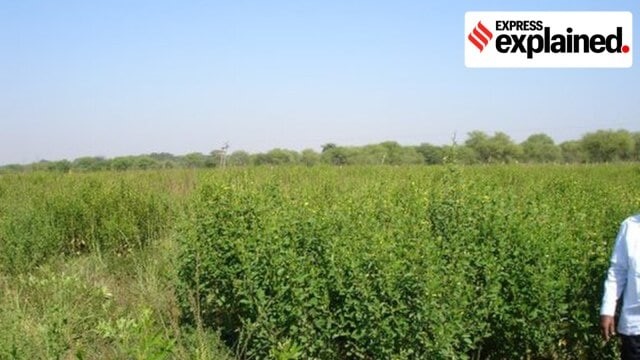
- 31 Oct 2025
In News:
- India, the world’s largest producer and consumer of pulses, continues to face a structural gap between domestic production and rising demand. Lower productivity levels, yield gaps, and increasing import dependence have highlighted the need for a targeted national strategy.
- To address these concerns, the Government of India has launched the Mission for Aatmanirbharta in Pulses (2025–31)—a six-year initiative aimed at transforming India into a self-reliant pulses-producing nation through scientific, institutional, and market reforms.
Overview of the Mission
Formally launched by the Prime Minister on 11 October 2025, the Mission for Aatmanirbharta in Pulses was first announced in the Union Budget 2024–25. The programme is implemented by the Ministry of Agriculture and Farmers’ Welfare, with collaborative support from NAFED, NCCF, and state governments.
Mission Duration and Financial Outlay
- Implementation period: 2025–26 to 2030–31
- Total outlay: ?11,440 crore
- Targets:
- Raise production by 45%—from 242 lakh MT (2023–24) to 350 lakh MT (2030–31)
- Expand cultivated area by 13%—from 275 lakh ha to 310 lakh ha
- Improve average yield by 28%—from 881 kg/ha to 1,130 kg/ha
Rationale: Current Status and Challenges
India cultivates a wide variety of pulses across agro-climatic zones. Major pulse-growing states include:
- Area (2023–24): Rajasthan (54.67 lakh ha), Madhya Pradesh (51 lakh ha), Maharashtra (44 lakh ha), Uttar Pradesh (30 lakh ha)
- Production (2023–24): Madhya Pradesh (59.74 lakh MT), Maharashtra (40 lakh MT), Rajasthan (33 lakh MT), Uttar Pradesh (31 lakh MT)
Gram dominates both area and output, followed by moong, tur (arhar), urad, and masoor. Over 60% of pulses production occurs during the rabi season.
Despite being the largest pulses producer, India remains dependent on imports from Myanmar, Tanzania, Mozambique, Canada, Australia, among others. Demand is projected to reach 268 lakh MT by 2030 and 293 lakh MT by 2047 (NITI Aayog), far exceeding current production levels. Productivity remains significantly lower than global benchmarks—Canada (2200 kg/ha) and China (1815 kg/ha).
Why Focus on Tur, Urad, and Masoor?
These three pulses account for 34% of total pulses area and contribute significantly to national output. They also exhibit high yield gaps and are crucial for nutritional security. The Mission plans:
- 9 lakh ha expansion in tur—across Karnataka, Maharashtra, Uttar Pradesh, Gujarat, Jharkhand and non-traditional areas like the Northeast.
- Utilisation of rice fallows for expanding urad in Uttar Pradesh, Andhra Pradesh, and Maharashtra.
- Promotion of masoor in rice fallow areas of West Bengal, Bihar, Chhattisgarh.
Key Components and Features of the Mission
1. Development of Climate-Resilient Seeds: Focus on high-yielding, drought-tolerant, pest-resistant, and protein-enriched varieties.
2. Higher Productivity through Technological Adoption
- Enhanced support of ?10,000/ha for Front Line Demonstrations (FLDs) of improved technologies (higher than ?9,000 under NFSM).
- Strengthening post-harvest storage, grading, and processing infrastructure.
3. 100% Assured Procurement
A major innovation in the mission framework:
- NAFED and NCCF will undertake 100% procurement of tur, urad and masoor for four years under PM-AASHA’s Price Support Scheme (PSS).
- Aadhaar-enabled biometric/facial authentication will ensure transparency and eliminate leakages.
4. Cluster-Based Approach
Each cluster will include minimum 10 ha (2 ha in hilly/Northeast region). Cluster selection based on:
- Four-fold district classification: HA-HY, HA-LY, LA-HY, LA-LY
- Rice fallow, rainfed, and watershed areas
- Aspirational districts, border/LWE districts
- Regions under PM Dhan-Dhaanya Krishi Yojana, Adarsh Gram Yojana, and Northeast/Himalayan areas
5. Value-Chain Strengthening: Interventions span input supply, extension, mechanisation, processing, market linkages and digital traceability.
Comparative Advantage over Previous Schemes
The Mission subsumes the pulses component of National Food Security and Nutrition Mission (NFSNM) but provides:
- Higher financial support
- Wider geographical coverage
- Expanded interventions (seed hubs, storage, procurement)
- Stronger digital governance
- Guaranteed procurement for three major pulses
National Significance
- Food and Nutritional Security: Pulses are key protein sources in Indian diets.
- Import Substitution: Reduces dependency on global markets and price volatility.
- Farmer Income Stability: Guaranteed procurement and improved yields boost profitability.
- Climate Resilience: Promotes drought-friendly crops, diversifies cropping patterns, and utilises rice fallows.
- Balanced Regional Development: Targets backward, rainfed, aspirational and border districts.
Electronics Components Manufacturing Scheme (ECMS)

- 31 Oct 2025
In News:
The Government of India has cleared the first batch of seven projects worth ?5,532 crore under the Electronics Components Manufacturing Scheme (ECMS), marking a critical milestone in India’s transition from assembling finished electronic products to building a strong component-level manufacturing base. These approved projects are expected to generate ?36,559 crore in production, create over 5,100 direct jobs, and significantly reduce India’s import dependence in high-value electronic components.
Overview of the ECMS
The Electronics Components Manufacturing Scheme (ECMS) is a flagship initiative under the Ministry of Electronics and Information Technology (MeitY). Approved by the Union Cabinet in 2024, its objective is to strengthen India’s backbone in the electronic components and materials ecosystem.
Key Objectives
- Promote domestic manufacturing of bare components, sub-assemblies, and specialized materials.
- Enhance domestic value addition (DVA) across the electronics supply chain.
- Integrate Indian manufacturers with Global Value Chains (GVCs), especially in semiconductors, telecom, EVs, and renewable energy.
- Support capital investments through a mix of turnover-linked, capex-based, and hybrid incentives.
Tenure and Incentive Structure
- Turnover-linked incentive: 6 years, with a 1-year gestation period.
- Capex incentive: 5-year support window.
Projects Approved Under the First Batch
The first set of projects includes manufacturing units for:
- High-Density Interconnect (HDI) PCBs
- Multi-Layer PCBs
- Copper Clad Laminates (CCL)
- Camera Modules
- Polypropylene Films
These units are spread across Tamil Nadu (5 units), Andhra Pradesh (1 unit), and Madhya Pradesh (1 unit), promoting regional dispersion of advanced electronics manufacturing.
Strategic Impact on Domestic Manufacturing
Meeting Domestic Demand
- New manufacturing units will meet 100% of India’s demand for Copper Clad Laminates.
- 20% of domestic PCB demand and 15% of camera module demand will be met locally.
- Around 60% of total production from these plants is expected to be exported, strengthening India’s global integration.
Camera modules, PCBs, and base materials form the essential components in smartphones, laptops, drones, robotics, medical devices, automotive electronics, and industrial systems — sectors critical for future economic growth.
India’s Strong Entry into Base Material Manufacturing
- A major breakthrough is the establishment of India’s first Copper Clad Laminate manufacturing unit, which serves as the foundational material for multi-layer PCBs. Previously, the entire requirement was imported, exposing India to supply chain vulnerabilities.
- Similarly, Polypropylene Films, vital for capacitor production used in consumer electronics, automotive components, telecommunications, computing equipment, and industrial systems, will now be manufactured domestically.
Economic and Industrial Impact
- Import Reduction: Key components and base materials will be produced domestically, reducing foreign dependency.
- Cost Reduction: Local production will bring down manufacturing costs and improve competitiveness.
- High-Skill Employment: Over 5,100 direct jobs from the first batch and potentially 91,600 jobs across the scheme will be created, according to scheme projections.
- R&D Strengthening: The initiative fosters technology absorption and innovation capability.
These seven approved projects form part of a much larger response — with 249 applications received representing ?1.15 lakh crore investment, potential production of ?10.34 lakh crore, and 1.42 lakh jobs, marking the highest-ever investment commitment in India’s electronics sector.
Integration with National Electronics Vision
ECMS is designed as a complementary pillar to:
- PLI Scheme for Large-Scale Electronics Manufacturing
- India Semiconductor Mission (ISM)
Together, they aim to create a seamless end-to-end manufacturing chain, covering devices, chips, components, materials, capital equipment, and innovation ecosystems.
EU–India New Strategic Agenda 2025

- 31 Oct 2025
In News:
- In September 2025, India and the European Union adopted the EU–India New Strategic Agenda 2025, a comprehensive vision document aimed at elevating their partnership into a transformative global framework for the next decade.
- Building upon the 2020 EU–India Strategic Partnership Roadmap, the new agenda broadens cooperation in sustainable development, digital governance, supply-chain resilience, connectivity, and defence.
- It is structured around five core pillars: Prosperity and Sustainability; Technology and Innovation; Security and Defence; Connectivity and Global Issues; and Enablers Across Pillars, reflecting a multidimensional partnership.
- A landmark development under this agenda is the decision to link the Indian Carbon Market (ICM)—formally India’s evolving Carbon Credit Trading Scheme (CCTS)—with the EU's Carbon Border Adjustment Mechanism (CBAM). This integration allows carbon prices paid within India to be deducted from CBAM levies at the EU border, potentially shielding Indian exporters from double taxation and incentivising early decarbonisation. If successfully implemented, the linkage would represent one of the most significant North–South climate cooperation efforts, setting a precedent for global carbon market integration.
Key Features of the New Strategic Agenda 2025
1. Prosperity & Sustainability
The agenda emphasises climate cooperation and green transition pathways:
- Joint clean energy transition initiatives including renewable energy, green hydrogen, and sustainable finance.
- Expansion of the Green Partnership, focused on technology transfer, co-investment, and carbon neutrality strategies.
- The carbon market linkage aims to align India’s carbon pricing framework with global standards and reduce trade frictions arising from CBAM enforcement.
2. Technology & Innovation
The EU and India plan deep cooperation across critical technologies:
- Collaboration in semiconductors, 5G/6G standardisation, quantum technologies, and AI ethics frameworks.
- Development of digital public infrastructure aligned with principles of privacy, transparency, and data protection.
3. Security & Defence
The agenda institutionalises a Security and Defence Partnership:
- Joint naval exercises, maritime domain awareness, and cybersecurity operations in the Indo-Pacific.
- Greater strategic alignment in the context of China’s increasing assertiveness and the need for secure maritime routes.
4. Connectivity & Global Issues
Cooperation includes:
- The EU’s Global Gateway Initiative and India’s participation in the India–Middle East–Europe Economic Corridor (IMEC).
- Infrastructure connectivity, supply-chain resilience, and sustainable transport systems.
5. Enablers Across Pillars: Enhanced mobility, education and research exchanges, and institutional dialogues strengthen long-term engagement.
Significance of Linking ICM with CBAM
The linkage is historically significant because it allows Indian carbon credits to be recognised within the EU’s border adjustment framework. This could:
- Prevent double carbon penalties on Indian exporters entering the EU market.
- Reward early decarbonisation by reducing CBAM-related costs.
- Provide a model for climate cooperation between developed and developing economies, addressing equity concerns embedded in global climate governance.
India–ASEAN Summit 2025
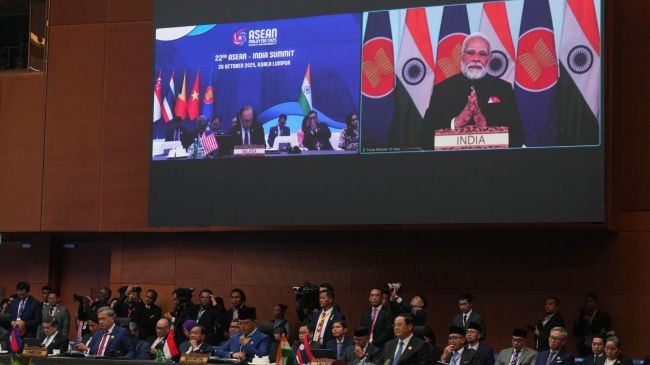
- 31 Oct 2025
In News:
- Prime Minister Narendra Modi virtually addressed the 22nd India–ASEAN Summit in Kuala Lumpur, reaffirming India’s commitment to enhancing cooperation in maritime security, digital inclusion, resilient supply chains, and economic integration.
- During the address, he announced that 2026 will be celebrated as the “ASEAN–India Year of Maritime Cooperation,” reflecting an intensified focus on the Indo-Pacific maritime domain. The remarks aligned with ASEAN’s theme under Malaysia’s chairmanship — “Inclusivity and Sustainability.”
Evolution of India–ASEAN Engagement
India’s engagement with ASEAN has evolved over more than three decades:
- 1992: Sectoral Dialogue Partnership initiated.
- 1996: Upgraded to Full Dialogue Partnership.
- 2002: India began regular participation in ASEAN Summits.
- 2009: ASEAN–India FTA in Goods (AITIGA) came into force;
- 2015: Services and Investment Agreements added.
- 2014 onwards: Transition from “Look East” to Act East Policy, increasing political, cultural and strategic connectivity.
- 2022: Partnership elevated to Comprehensive Strategic Partnership.
The partnership is grounded in shared civilisational links, especially through Buddhism, historical maritime routes, and cultural exchanges dating back to the Gupta and Srivijaya eras.
Recent Summit Highlights: Strategic Messaging
Despite PM Modi’s long-standing practice of physical participation in ASEAN summits, his virtual presence this year was noted as an unusual departure. Given the symbolic importance of leader-level diplomacy in ASEAN's consensus-driven ecosystem, some observers considered his absence a missed opportunity, especially amid strengthening bilateral ties with Malaysia after upgrading relations to a Comprehensive Strategic Partnership.
Nevertheless, PM Modi reaffirmed India’s intent to complement ASEAN’s Community Vision 2045 and India’s national vision of Viksit Bharat 2047, framing both as convergent long-term goals. He highlighted India’s role as a First Responder in regional crises, a position increasingly recognised across Southeast Asia.
Unlike previous years featuring extensive multi-point proposals, the 2025 address emphasised consolidation over expansion, centred primarily on maritime cooperation — a significant signal as the Philippines assumes ASEAN chairmanship in 2026 amid rising maritime tensions in the South China Sea.
Key Pillars of Cooperation
1. Maritime Security & Indo-Pacific Cooperation
- Joint patrols, coordinated naval exercises, and enhanced maritime domain awareness.
- Blue economy initiatives under the ASEAN–India Year of Maritime Cooperation (2026).
2. Economic Integration
- Review of the ASEAN–India Trade in Goods Agreement (AITIGA) to address market access constraints, streamline rules of origin, and reduce non-tariff barriers.
- Policymakers are urged to prioritise long-term regional integration over short-term protectionist anxieties.
3. Digital & Green Economy
- Cooperation in digital public infrastructure, cybersecurity, AI governance, renewable energy, green ports, and climate-resilient supply chains.
4. Connectivity Projects
- Acceleration of India–Myanmar–Thailand Trilateral Highway.
- Progress on the Kaladan Multi-Modal Transit Corridor, strengthening multimodal and economic connectivity.
5. Cultural Diplomacy & People-to-People Links
- ICCR scholarships, academic exchanges, tourism linkages, and the ASEAN–India Network of Think Tanks (AINTT).
- Emphasis on shared civilisational heritage and cultural exchanges.
Initiatives & Institutional Mechanisms
- ASEAN–India Plan of Action (2026–2030) focusing on trade, innovation, food security, agriculture, health, and education.
- India’s ?500 crore ASEAN–India Fund supporting capacity building, agriculture, and connectivity projects.
- Track 1.5 dialogue platforms reveal growing regional acknowledgement of India’s strategic role in Southeast Asia.
National Unity Day

- 31 Oct 2025
In News:
- National Unity Day (Rashtriya Ekta Diwas) is observed annually on 31 October to mark the birth anniversary of Sardar Vallabhbhai Patel, India’s first Deputy Prime Minister and Home Minister.
- Introduced in 2014, the day highlights Patel's pivotal role in consolidating the nation by integrating over 560 princely states into the Indian Union at the time of Independence— a task that earned him the enduring title, the “Iron Man of India.”
- The year 2025 marks the 150th birth anniversary of Sardar Patel, and the commemorative events have been organised on an unprecedented scale at the Statue of Unity in Ekta Nagar, Gujarat, led by Prime Minister Narendra Modi.
- The celebrations highlight the theme “Unity in Diversity”, underscoring India’s multicultural character and the importance of national cohesion.
Historical Significance of Sardar Vallabhbhai Patel
- Born on 31 October 1875 in Nadiad, Gujarat, Patel initially practised law before joining the national movement under Mahatma Gandhi.
- His leadership in the Kheda Satyagraha (1918) and Nagpur Flag Satyagraha (1923) marked his rise as a mass leader.
- As President of the Ahmedabad Municipal Board (1924), he reformed urban infrastructure, sanitation and civic systems.
- The Bardoli Satyagraha (1928) elevated him to national prominence, earning him the honorific “Sardar.”
- At Independence, he was entrusted with unifying the 17 British provinces and integrating the princely states—an immense administrative and diplomatic feat.
- Served as Deputy Prime Minister and Home Minister (1947–1950) and also held charge of the Information and Broadcasting Ministry.
Cloud Seeding as a Pollution-Control Measure in Delhi

- 30 Oct 2025
In News:
With Delhi’s air quality plunging to severe levels each winter, the state government has renewed its call for cloud seeding as a potential intervention to reduce pollution. However, scientific assessments and governance experts warn that this approach offers limited, temporary relief and risks diverting attention from structural reforms required to address air pollution sustainably.
Why Delhi’s Air Quality Deteriorates in Winter
Delhi’s winter pollution is driven by a combination of meteorological and anthropogenic factors:
- Temperature Inversion: During winter, colder air remains trapped near the surface while warmer air lies above. This temperature inversion acts as a lid, preventing pollutants from rising and dispersing vertically.
- Low Wind Speeds: Weak winds limit horizontal movement of pollutants, causing particulate matter to accumulate in the lower atmosphere.
- Crop Residue Burning: Post-harvest stubble burning in Punjab, Haryana, and western Uttar Pradesh releases large quantities of smoke and suspended particles, which are carried to Delhi via prevailing winds.
- Dust and Urban Emissions: Vehicular emissions, construction dust, industrial exhaust, and waste burning remain trapped within the low boundary layer height, intensifying pollution.
- Post-Monsoon Stagnation: Stable high-pressure systems reduce atmospheric mixing, compounding North India’s chronic winter air quality problem.
What is Cloud Seeding?
Cloud seeding is a form of weather modification intended to enhance rainfall using chemical agents.
- Origin: First demonstrated in 1946 by Vincent J. Schaefer.
- Seeding Agents: Silver iodide, potassium iodide, sodium chloride, and dry ice are commonly used.
- Mechanism: The agents act as nuclei for condensation or ice-crystal formation, encouraging droplet growth. Once droplets become heavy, they fall as precipitation.
- Delivery Methods: Aircraft, rockets, or ground-based generators disperse particles into suitable moisture-laden clouds.
However, cloud seeding requires the presence of natural clouds with adequate moisture and cannot generate clouds on its own.
Scientific and Environmental Limitations
- Reliance on Existing Clouds: Delhi often lacks suitable cloud systems during peak pollution periods. Cloud seeding has no impact in the absence of adequate moisture.
- Weak Evidence of Effectiveness: Global scientific studies show inconsistent results. Even when rainfall occurs after seeding, establishing causality is difficult.
- Only Temporary Pollution Relief: Rain may wash away PM2.5 and PM10 temporarily, but pollution typically rebounds within 1–2 days. Secondary pollutants like ozone and sulphur dioxide remain unaffected.
- Environmental and Health Concerns: The use of silver iodide raises concerns regarding long-term ecological and health impacts due to chemical deposition. Evidence on safety is limited and inconclusive.
- Governance and Accountability Issues
- Unpredictable outcomes may lead to public criticism.
- Accountability becomes unclear if cloud seeding coincides with flooding or adverse weather events.
Ethical and Policy Concerns
- Misallocation of Resources: Investing in cloud seeding may divert funds from proven interventions.
- Distracting Public Attention: Temporary fixes risk undermining public trust and shifting focus away from systemic issues.
- Potential Misuse: Short-term optics may overshadow long-term environmental governance.
Real Solutions for Air Pollution Control
Experts emphasise that lasting improvement requires sustained structural action:
- Cleaner Transportation
- Strengthening public transport
- Transition to electric mobility
- Enforcing emission norms
- Sustainable Energy Transition
- Phasing down coal-based power
- Scaling up renewables
- Promoting clean industrial technologies
- Improved Waste Management
- Curbing open waste burning
- Efficient municipal systems
- Construction and Dust Control
- Enforcement of dust mitigation norms
- Use of green barriers and mechanised sweeping
- Agricultural Reforms
- Subsidising sustainable stubble management
- Promoting crop diversification in Punjab and Haryana
- Urban Planning Reforms
- Increasing green cover
- Reducing congestion through better mobility planning
Makhananomics
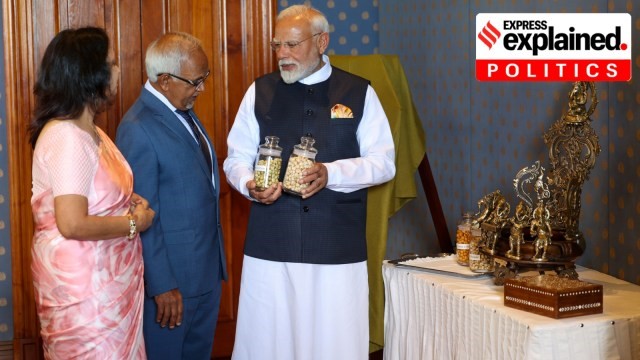
- 30 Oct 2025
In News:
- Prime Minister Narendra Modi has termed the establishment of the National Makhana Board as a transformative step and a “revolution” for the makhana sector.
- The initiative aims to unlock the commercial potential of Makhana (foxnut)—the dried edible seed of Euryale ferox, a prickly water lily that grows in freshwater ponds across South and East Asia—and address long-standing structural gaps in India’s leading production region, Bihar.
Makhana: Botanical, Nutritional and Cultural Features
- Makhana is derived from the seeds of the gorgon plant, recognised by its large prickly leaves and violet-white flowers. Traditionally used in ritual offerings, it has gained global traction as a nutrient-dense, low-fat “superfood”, expanding its market appeal among health-conscious consumers.
- The global makhana market, valued at USD 43.56 million in 2023, is projected to surpass USD 100 million by 2033, signalling strong export potential for India.
Production Profile: Bihar’s Dominance
- Bihar accounts for 90% of India’s makhana production, with cultivation concentrated in nine districts of the Mithilanchal region—particularly Darbhanga, Madhubani, Purnea, and Katihar, which together contribute 80% of the state’s output. Roughly 15,000 hectares under cultivation yield around 10,000 tonnes of popped makhana annually.
- Over 10 lakh families, mainly from the Mallah (fishermen) community, are involved in its cultivation, harvesting, and processing—making the crop socio-economically significant for Bihar’s rural economy.
Challenges: Low Productivity, Labour-Intensive Processes and Market Limitations
Despite being the largest producer, Bihar faces multiple structural constraints:
1. Weak Food Processing and Export Infrastructure
- Punjab and Assam dominate makhana exports despite minimal or no production.
- Bihar sells raw foxnuts cheaply to external food processing units (FPUs), which add value through flavouring, packaging, and branding—capturing higher profits.
2. Poor Market Organisation
- A long chain of intermediaries suppresses farmer earnings.
- Limited organised market systems hinder transparent pricing and revenue growth.
3. Labour-Intensive and Low-Productivity Cultivation
- Harvesting requires diving into water bodies and manually collecting seeds.
- Cleaning, sun drying, roasting, and popping are entirely manual processes.
- Adoption of high-yield varieties (HYVs) like Swarna Vaidehi and Sabour Makhana-1 remains low, keeping output at 1.7–1.9 tonnes/hectare, far below the HYV potential of 3–3.5 tonnes/hectare.
- Mechanisation attempts have been unsuccessful due to technological inefficiencies.
4. Institutional Weakness
- The ICAR National Research Centre for Makhana, established in 2002, has suffered understaffing, lack of administrative support, and underutilisation.
Government Efforts: Policy Push and Institutional Strengthening
The government is working to commercialise makhana through:
- Creation of the National Makhana Board with an initial budget of ?100 crore to address production, processing, value addition, and marketing.
- Promotion of makhana as a commercial crop with improved processing linkages.
- Expansion of industrial infrastructure, including cargo facilities at airports in Patna, Darbhanga, and Purnea, aimed at facilitating exports.
- Training, capacity-building, and linkage of farmers to government schemes.
- Awarding the GI tag to Mithila Makhana in 2022, recognising its unique geographical identity and boosting brand value.
Political Significance: Makhananomics in an Election Year
The push for makhana development carries strong electoral implications:
- With elections approaching, makhana has emerged as a key narrative in Bihar’s economic agenda.
- The sector directly impacts the Mallah community, which constitutes just 2.6% of the state population but commands significant influence in North Bihar owing to their 6% regional vote share.
- Success of “makhananomics” could bolster the ruling coalition’s political appeal by promising employment generation, economic upliftment, and rural prosperity.
CRYODIL
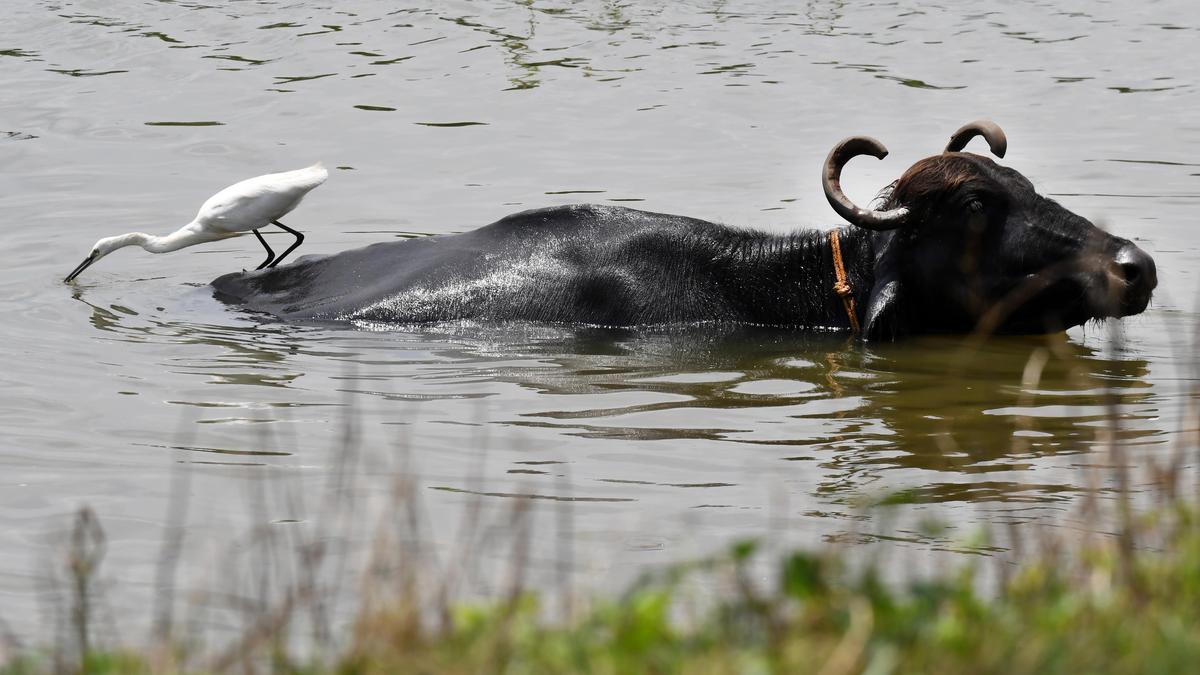
- 30 Oct 2025
In News:
- In a major breakthrough for India’s dairy and livestock sector, scientists at the ICAR–National Institute of Animal Nutrition and Physiology (NIANP), Bengaluru, have developed CRYODIL, the country’s first egg yolk-free, ready-to-use semen preservation solution for buffalo breeding.
- Designed to revolutionise artificial insemination practices, CRYODIL enables long-term storage and improved semen quality during cryopreservation, offering significant benefits to dairy productivity and livestock management.
What is CRYODIL?
CRYODIL is an innovative semen extender developed specifically for buffaloes. Unlike conventional extenders that rely on egg yolk for preservation, CRYODIL employs a purified whey-protein–based formulation to maintain semen motility and fertility. This eliminates the variability and contamination risk associated with egg-yolk-based solutions.
Key Features and Advantages
- Egg Yolk-Free Composition: Eliminates microbial contamination risks often linked to raw biological materials like egg yolk.
- Extended Shelf Life: Can preserve buffalo semen for up to 18 months, making long-distance transport and storage more efficient.
- Stable and Consistent Quality: Whey proteins ensure chemical uniformity, improving post-thaw sperm survival and movement.
- Field-Tested Innovation: Demonstrated successful results in trials conducted on 24 buffalo bulls, showing superior post-thaw semen motility and higher fertility potential.
- Cost-Effective Alternative: Indigenous development reduces reliance on imported commercial extenders, making it affordable for rural breeding programmes.
- Ready-to-Use Formulation: Simplifies the insemination process and enhances field applicability without requiring complex lab preparations.
Significance for India’s Dairy and Livestock Sector
- Boosts Buffalo Breeding Efficiency: India is home to the world’s largest population of buffaloes and relies heavily on them for dairy output. CRYODIL strengthens artificial insemination efforts by enhancing semen viability and improving conception rates.
- Advances Atmanirbhar Bharat: The indigenous formulation supports self-reliance, reducing dependence on imported extenders and promoting innovation under ICAR research initiatives.
- Improves Dairy Sector Economics: Higher fertility rates and improved breeding efficiency translate to increased milk yield, benefiting farmers and strengthening India’s dairy economy.
- Enhances Biosecurity and Hygiene: Removal of egg yolk minimises microbial load and contamination risks, making the solution safer for large-scale use in breeding centres.
VandeMataram – 150 Years Celebration

- 30 Oct 2025
In News:
Prime Minister Narendra Modi, in his October 2025 Mann Ki Baat address, called upon citizens to mark the 150th anniversary of VandeMataram.
Historical Origins and Evolution
- VandeMataram—meaning “I bow to thee, Mother”—was composed by Bankim Chandra Chattopadhyay in the 1870s in Sanskritised Bengali.
- It was later published in his novel Anandamath (1882), where the motherland was depicted symbolically as a divine, nurturing force.
- The song gained prominence during the freedom struggle. Its first public rendition was by Rabindranath Tagore at the 1896 Indian National Congress session, marking its transition from literary creation to a nationalistic anthem.
- Despite British censorship, it echoed across protest marches, swadeshi gatherings, and revolutionary movements, becoming an enduring symbol of defiance.
Role in National Movement and Political Debates
- During the early 20th century, the song became deeply embedded in anti-colonial resistance, especially during the Swadeshi Movement (1905) and later the Quit India Movement (1942). However, its later stanzas, portraying the motherland as a Hindu goddess, drew objections from the All-India Muslim League and some Muslim leaders.
- To maintain inclusivity, the Indian National Congress in 1937 officially adopted only the first two stanzas, which do not include religious imagery. This selective adoption reflected efforts to preserve unity in a diverse society.
- On 24 January 1950, the Constituent Assembly accorded equal honour to VandeMataram and Jana Gana Mana, defining the former as the national song and the latter as the national anthem.
Cultural, Symbolic and Constitutional Status
Today, VandeMataram holds a unique constitutional and cultural position:
- National Song Status: It enjoys the same respect as the national anthem as per Constituent Assembly resolutions.
- Parliamentary Tradition: An instrumental version is played at the end of every Parliament session.
- Cultural Identity: It continues to symbolise unity, patriotism, and emotional attachment to the motherland.
- Secular Projection: Emphasis remains on the first two stanzas to ensure inclusivity across religious communities.
- Judicial Affirmation: In 2022, the Delhi High Court reaffirmed that citizens should show equal respect to both the national anthem and national song.
Cyclone Montha
- 30 Oct 2025
In News:
- Cyclone Montha, a tropical cyclonic system that formed over the southeast Bay of Bengal in late October 2025, has emerged as one of the most significant weather events of the year for India’s eastern coastal states.
- The India Meteorological Department (IMD) has issued high-level warnings for Andhra Pradesh, Odisha, Tamil Nadu, and coastal Telangana as the system intensifies and advances toward landfall.
Formation and Meteorological Characteristics
- Cyclone Montha originated from a well-marked low-pressure area over the southeast Bay of Bengal around 24 October 2025.
- Under favourable atmospheric and oceanic conditions—warm sea surface temperatures above 28°C, high moisture availability, and low vertical wind shear—the system progressed from a depression to a deep depression by 26 October and further strengthened into a cyclonic storm. The IMD projected that it could intensify into a Severe Cyclonic Storm (SCS) before landfall.
- As of 27 October 2025, the storm was positioned approximately 350 km southeast of Kakinada, moving in a north-northwest direction at nearly 14 km/h.
- The IMD forecast predicted landfall between Machilipatnam and Kalingapatnam, near Kakinada, on the evening or night of 28 October. Wind speed estimates indicated gusts reaching 110 km/h, accompanied by “very rough to high” sea conditions and potential storm surge up to 1 metre.
Naming Mechanism and Regional Cyclone Governance
- “Montha” is a name contributed by Thailand to the World Meteorological Organization (WMO)/ESCAP Panel on Tropical Cyclones.
- Cyclone naming in the North Indian Ocean is overseen by a 13-member regional committee comprising India, Bangladesh, Pakistan, Sri Lanka, Myanmar, Maldives, Oman, Yemen, Qatar, Iran, UAE, Saudi Arabia, and Thailand.
- Each country submits suggested names, which are then assigned sequentially to future cyclones. This system enhances communication, public awareness, and clarity during simultaneous storm events.
Geographical Spread and Affected Regions
- While Andhra Pradesh remains the primary zone of impact—especially districts such as Kakinada, Konaseema, West Godavari, Krishna, Bapatla, Prakasam and Nellore—its effects range wider. Odisha has alerted 30 districts, Tamil Nadu has issued orange and yellow alerts for coastal belts, and Telangana is preparing for secondary rainfall impacts.
- Rayalaseema is also vulnerable due to the forecast of extremely heavy rainfall (>210 mm in 24 hours), increasing the risk of flash floods and landslides. Fisherfolk in all three major maritime states—Tamil Nadu, Andhra Pradesh, and Odisha—have been advised against venturing into the sea due to high waves and strong winds.
Expected Impacts
- Heavy to Extremely Heavy Rainfall: Isolated areas in coastal Andhra Pradesh and south Odisha may witness rainfall ≥21 cm in 24 hours, leading to flooding of rivers, drains, and agricultural fields.
- Strong Winds: Sustained winds of 90–100 km/h and gusts up to 110 km/h can uproot trees, damage kutcha houses, and disrupt electricity and telecom infrastructure.
- Storm Surge: Low-lying coastal pockets face inundation risks due to a possible storm surge of around 1 metre above the astronomical tide.
- Marine Hazards: Fishing vessels have been anchored, with over 900 boats already guided ashore. High swell waves and turbulent sea conditions threaten coastal ecosystems and livelihoods.
- Extended Weather Effects: Secondary effects may be felt in Telangana, Chhattisgarh, and even parts of West Bengal through rainfall, thunderstorms, and transportation disruptions.
Government Response and Preparedness Measures
State and central agencies have activated a coordinated disaster-response framework. Key measures include:
- Activation of emergency control rooms and pre-deployment of NDRF, SDRF, Coast Guard, and Army teams.
- Closure of schools in high-risk districts until 31 October.
- Stockpiling of essential commodities and readying PDS distribution systems.
- Evacuation of vulnerable populations including pregnant women and residents of low-lying areas.
- Temporary shelters being prepared with sanitation and food facilities.
- Suspension of fishing activities along the entire east coast stretch under threat.
- Continuous IMD bulletins issued for public safety instructions.
Inter-state cooperation has been emphasised, particularly between Odisha, Andhra Pradesh, and Tamil Nadu, to strengthen response logistics.
Children’s Booker Prize

- 29 Oct 2025
In News:
- The Booker Prize Foundation has announced the establishment of the Children’s Booker Prize, a landmark global award dedicated to fiction written for children aged 8 to 12 years.
- Scheduled to debut in 2027, this prize represents the first major expansion of the Booker brand into children’s literature and carries a purse of £50,000, matching the award value of its established sister prizes.
What the Prize Represents
- The Children’s Booker Prize aims to celebrate and elevate fiction for middle-grade readers, acknowledging the importance of early reading habits in shaping future generations of informed, imaginative, and engaged adults. Books originally written in English or translated into English will be eligible, making the award internationally inclusive.
- The Booker Prize Foundation, in partnership with the AKO Foundation, which supports arts, education, and environmental initiatives, seeks to nurture a global culture of reading and inspire literary excellence in children’s storytelling.
Eligibility and Key Features
- Age Category: Fiction aimed at 8–12-year-old readers.
- Geographic Scope: Open to books published in the UK or Ireland, regardless of the author’s nationality.
- Languages: Both original English works and translated works can be submitted.
- Prize Value: £50,000 (same as the adult Booker and International Booker), funded by the AKO Foundation.
- Selection Process: The first award in 2027 will be decided by a jury of children and adults, chaired by acclaimed British children’s author Frank Cottrell-Boyce, the current children’s laureate.
The submission process begins in early 2026, and the prize hopes to build enthusiasm and visibility around high-quality children’s literature.
Purpose and Vision
- According to Booker Prize Foundation Chief Executive Gaby Wood, the award aims to cultivate an enduring love for reading among younger audiences and to serve as a catalyst for literary engagement across generations. The initiative builds on the Booker’s legacy of recognising works that shape global literary culture.
Position Within the Booker Ecosystem
The Children’s Booker Prize joins two established awards under the Booker umbrella:
1. Booker Prize
- Founded: 1969
- Eligibility: Original novels written in English and published in the UK or Ireland.
- Prize Distribution: Award solely to the author.
- Objective: Celebrates outstanding English-language fiction.
- Indian Winners:
- Salman Rushdie – Midnight’s Children (1981)
- Arundhati Roy – The God of Small Things (1997)
- Kiran Desai – The Inheritance of Loss (2006)
- Aravind Adiga – The White Tiger (2008)
2. International Booker Prize
- Established: 2005; restructured in 2016.
- Eligibility: Translated fiction published in the UK or Ireland.
- Prize Distribution: Shared equally between author and translator.
- Objective: Promotes cross-cultural literary exchange and honours translation.
- Indian-Linked Winners:
- Geetanjali Shree – Tomb of Sand (2022) (Hindi, translated by Daisy Rockwell)
- Banu Mushtaq – Heart Lamp (2025) (Kannada, translated by Deepa Bhasthi)
Forex Reserves
- 29 Oct 2025
In News:
India’s foreign exchange reserves recorded a strong rise, increasing by $4.496 billion and reaching an all-time high of $702.28 billion, according to RBI data. This marks the second consecutive week of expansion, following a $2.176 billion rise in the previous reporting week. The jump was primarily driven by a steep increase in the value of gold reserves, even as foreign currency assets registered a decline.
Component-wise Movement of Reserves
1. Foreign Currency Assets (FCA)
- FCAs, which form the largest component of India’s forex reserves, fell by $1.692 billion to $570.411 billion.
- The changes reflect valuation effects due to fluctuations in currencies such as the euro, pound, and yen against the US dollar.
2. Gold Reserves
- Gold holdings rose sharply by $6.181 billion, taking their total value to $108.546 billion.
- The increase is attributed to RBI’s gold purchases and the global surge in gold prices.
3. Special Drawing Rights (SDRs)
- SDR holdings increased slightly by $38 million, reaching $18.722 billion.
4. Reserve Position in the IMF
- India’s reserve position with the IMF declined by $30 million to $4.602 billion.
Overall, the rise in gold assets offset the fall in foreign currency assets, helping the total reserves cross the historic $702-billion mark.
Understanding India’s Forex Reserves
Foreign exchange reserves represent external assets held by the RBI in the form of:
- Foreign currency assets
- Gold reserves
- Special Drawing Rights (SDRs)
- Reserve position in the IMF
These reserves act as a protective financial buffer for the economy.
Objectives and Functions
- Monetary Stability: Helps maintain stability of the Indian Rupee during volatility.
- Crisis Management: Provides liquidity support during balance of payments pressure or external shocks.
- Investor Confidence: Strengthens India’s credibility and ensures macroeconomic stability.
- Trade and Debt Support: Enables smooth settlement of import bills and external debt servicing obligations.
Key Features
- India’s forex reserves are valued on a weekly basis, factoring in global gold prices and New York closing exchange rates.
- The RBI manages these reserves following IMF data dissemination standards, maintaining international transparency.
- Foreign currency assets remain the largest component, followed by gold, SDRs, and India’s IMF reserve position.
Economic Significance
- Economic Security: Acts as an insurance mechanism against currency crises, capital outflows, or external market shocks.
- Policy Flexibility: Allows RBI to intervene in the forex market to curb excessive rupee volatility.
- Global Standing: Reinforces India’s global financial strength, supporting favourable sovereign credit ratings and greater investor trust.
KotadaBhadli
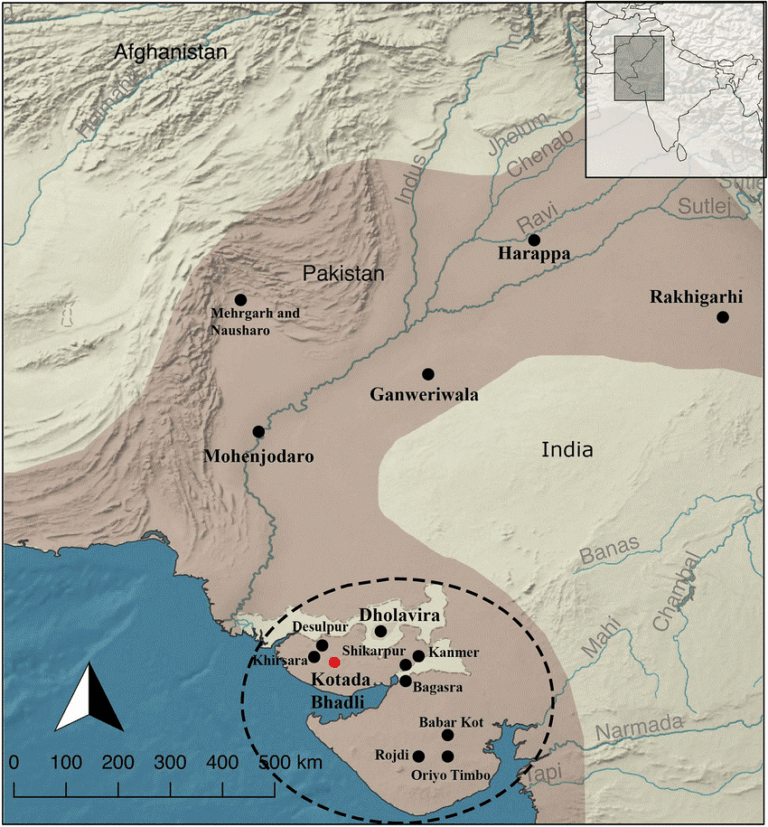
- 29 Oct 2025
In News:
- A recent multidisciplinary research study by Deccan College, Symbiosis School for Liberal Arts, and the Archaeological Survey of India (ASI) has reinterpreted the Harappan settlement of KotadaBhadli in Kutch, Gujarat, as the earliest known caravanserai, dating to the Mature Harappan phase (2300–1900 BCE).
- The study, published in L’Anthropologie (2025), pushes back the origins of organised trade infrastructure in South Asia by nearly 2,000 years, long before the rise of the Silk Route.
Location and Strategic Significance
- KotadaBhadli lies in the Kutch district of Gujarat, positioned along inland trade corridors linking prominent Harappan centres such as Dholavira, Lothal, and Shikarpur.
- Its placement reveals a purposeful design—serving as a rural logistical stopover facilitating long-distance trade between urban and coastal settlements.
Nature and Function of the Settlement
- Researchers have identified KotadaBhadli as a fortified rural halt, intended not for permanent habitation but for short-term stops by traders and their caravans.
- Its function aligns closely with caravanserai-style establishments known from later historical periods—providing shelter, security, food, and space for pack animals during overland journeys.
- The study clarifies a previously missing link in Harappan commerce: while trade with Mesopotamia and inland India was well documented, the operational mechanism—how traders and goods moved safely across long distances—was not fully understood. KotadaBhadli provides the first archaeological evidence to support this model.
Archaeological and Scientific Evidence
Excavations conducted between 2010 and 2013 and re-analysed through advanced techniques have revealed:
- A multi-roomed central complex, likely functioning as administrative or resting quarters.
- Fortified walls with bastions, confirming its role as a protected stopover.
- Large open courtyards, interpreted as holding areas for animals and storage of goods.
- Remains of food waste and imported material, suggesting active trade activity.
Cutting-edge scientific methods—including ground-penetrating radar, satellite mapping, magnetic surveys, isotopic and lipid analysis, and multiple dating techniques—have improved understanding of the site’s functional layout and confirm its zoning for logistical purposes.
Implications for Harappan Trade Networks
The findings demonstrate that the Harappan economy had a structured overland trade system, supported by a network of small fortified checkpoints rather than solely urban market centres. This reveals an advanced level of planning and coordination within Harappan economic systems.
Key implications include:
- Chronological significance: Organised trade infrastructure existed in South Asia more than two millennia before the Silk Route.
- Economic insight: Harappans displayed sophisticated logistics and administrative planning.
- Civilizational understanding: The Harappan world was not merely dependent on ports like Lothal or trade with Mesopotamia—it also relied on inland support systems that sustained commerce.
Amoebic meningoencephalitis
- 29 Oct 2025
In News:
Kerala has reported yet another fatal case of amoebic meningoencephalitis in 2025, deepening public health concerns in the state. With this incident, Kerala’s cases linked to amoebic meningoencephalitis in 2025 have risen to 27, highlighting an emerging disease surveillance challenge. Health authorities are still investigating the exact source of infection in the latest case, as environmental exposure remains the primary risk factor.
Understanding Amoebic Meningoencephalitis
- Nature of the Disease: Amoebic meningoencephalitis, or Primary Amebic Meningoencephalitis (PAM), is a rare but rapidly progressing and typically fatal brain infection. It occurs when a free-living amoeba invades the central nervous system, causing severe inflammation and extensive brain tissue damage.
- Causative Organism: The infection is caused by Naegleria fowleri, often referred to as the “brain-eating amoeba.” This thermophilic organism is naturally present in warm freshwater bodies and moist soil.
Transmission and Environmental Factors
- The disease is not transmitted person-to-person.
- Infection occurs when contaminated water enters the nasal cavity, allowing the amoeba to migrate through the olfactory nerve into the brain.
- Naegleria fowleri proliferates in warm freshwater, particularly during summer months, in environments such as:
- Lakes
- Ponds
- Hot springs
- Poorly chlorinated swimming pools
- Warm freshwater streams and rivers
Kerala’s warm and humid climate, combined with widespread freshwater sources, may create favourable conditions for the organism, necessitating stronger environmental monitoring and public awareness.
Clinical Presentation
Early Symptoms (1–9 days after exposure):
- Fever
- Headache
- Nausea
- Vomiting
Advanced Symptoms:
- Stiff neck
- Seizures
- Confusion
- Loss of balance
- Hallucinations
- Progressive neurological deterioration
The disease often leads to coma and death within days, making it one of the deadliest infections of the central nervous system.
Treatment and Mortality
Treatment remains highly challenging, with over 95% mortality. Some survival cases have been associated with:
- Early diagnosis
- Rapid initiation of drugs like amphotericin B and miltefosine
- Aggressive supportive care in intensive settings
However, the overall prognosis remains extremely poor due to the fast progression of the infection.
Preventive Measures
Given the absence of person-to-person transmission, prevention focuses on reducing environmental exposure:
- Avoid swimming or diving in untreated freshwater bodies, especially during warmer months.
- Use nose clips while entering freshwater.
- Ensure proper chlorination and maintenance of swimming pools.
- Avoid stirring mud or sediment in shallow freshwater areas where amoebae thrive.
PM- Ayushman Bharat Health Infrastructure Mission (PM-ABHIM)
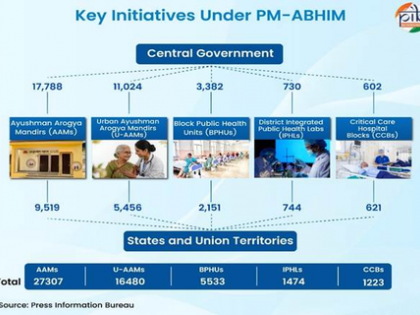
- 29 Oct 2025
In News:
The Pradhan Mantri–Ayushman Bharat Health Infrastructure Mission (PM-ABHIM), launched in October 2021, represents one of India’s most ambitious national health-system strengthening initiatives. Conceived in the aftermath of COVID-19, the Mission aims to build a resilient, modern, and self-reliant public health infrastructure capable of responding effectively to future pandemics and health emergencies.
Mission Structure and Financial Outlay
- PM-ABHIM is implemented as a Centrally Sponsored Scheme (CSS) with select Central Sector components, with a total allocation of ?64,180 crore for the period 2021-22 to 2025-26.
- This multi-layered programme focuses on fortifying health infrastructure from the village level to the district level, while simultaneously creating a national network for disease surveillance and laboratory capacity.
Key Components of PM-ABHIM
1. Primary and Secondary Healthcare Strengthening
The Mission envisions comprehensive infrastructure development through:
- Ayushman Arogya Mandirs (AAMs) replacing and upgrading Sub-Centres and Primary Health Centres.
- Urban Health and Wellness Centres established in slum and underserved urban areas.
- Block Public Health Units (BPHUs) to enhance diagnostic, surveillance, and public health management capacity at the block level.
These interventions aim to fill service delivery gaps and ensure equitable access to quality healthcare, especially in rural and vulnerable regions.
2. District-Level Critical Health Infrastructure
- Establishment of Critical Care Hospital Blocks (CCHBs) in every district to provide advanced and emergency care.
- Creation and upgradation of Integrated District Public Health Labs (IDPHLs) for comprehensive testing and epidemiological support.
These facilities are intended to strengthen district-level readiness for public health emergencies and mass-casualty situations.
3. Strengthened Disease Surveillance and Pandemic Preparedness
A significant feature of PM-ABHIM is the creation of an IT-enabled, real-time disease surveillance system. This network links:
- Block-level labs
- District surveillance units
- Regional surveillance centres
- National institutions
The government has highlighted that PM-ABHIM has substantially enhanced India’s health surveillance capabilities, enabling faster detection, notification, and response during outbreaks. The integration of digital tools allows seamless data sharing and analytics—essential for early warning and rapid containment strategies.
4. Research, Innovation, and One Health Approach
The Mission supports:
- Advanced research on COVID-19, emerging infectious diseases, and health emergencies.
- Laboratories and platforms promoting scientific innovation.
- Adoption of the One Health approach, recognising the linkages between human, animal, and environmental health to prevent zoonotic diseases.
Policy Significance
PM-ABHIM marks a paradigm shift from reactive health crisis management to proactive preparedness. Its multi-tiered infrastructure plan, focus on training, surveillance networks, and integration of modern technologies positions India to handle:
- Emerging infectious diseases
- Climate-linked health threats
- Biosecurity risks
- Mass public health emergencies
The Mission also contributes to the broader goals of Ayushman Bharat, Universal Health Coverage (UHC), and Sustainable Development Goals (SDGs), by bridging regional disparities and strengthening healthcare accessibility.
Rashtriya Vigyan Puraskar

- 28 Oct 2025
In News:
- The Government of India has announced the Rashtriya Vigyan Puraskar (RVP) 2025, the nation’s premier recognition for exceptional achievements in science, technology, and innovation.
- The awards acknowledge landmark contributions by scientists, technologists, young researchers, and collaborative teams working across diverse domains that drive India’s S&T leadership and national development goals.
About the Rashtriya Vigyan Puraskar
Instituted by the Government of India, the RVP honours outstanding scientific excellence and impactful innovation. The awards are conferred in four categories:
- Vigyan Ratna (VR): Recogniseslifetime achievements in any field of science and technology.
- Vigyan Shri (VS): Honoursdistinguished contributions by individuals in any scientific discipline.
- Vigyan Yuva– Shanti Swarup Bhatnagar (VY-SSB): Celebrates exceptional contributions by young scientists up to 45 years of age.
- Vigyan Team (VT): Awarded to a team of 3 or more researchers for exceptional collaborative work.
The awards span 13 scientific domains, including Physics, Chemistry, Biological Sciences, Engineering, Agriculture, Environmental Science, Earth Science, Atomic Energy, Space Science and Technology, Medicine, Mathematics & Computer Science, Technology & Innovation, and allied interdisciplinary fields.
Selection Process
- Nominations for the 2025 edition were accepted through the government portal (awards.gov.in) between October 4 and November 17, 2024.
- An expert committee comprising the Principal Scientific Advisor, secretaries of leading science departments, heads of national academies, and domain specialists rigorously evaluated the submissions.
- The final decisions were coordinated by the Rashtriya Vigyan Puraskar Secretariat.
Significance of the Awards
The Rashtriya Vigyan Puraskar:
- Strengthens India’s scientific ecosystem
- Motivates emerging researchers and innovators
- Recognises pathbreaking discoveries and technological advancements
- Reinforces India’s strategic vision of becoming a global S&T leader
- Encourages collaborative, interdisciplinary research
The award ceremony will be organised separately, with formal notifications issued to the awardees.
Subansiri Lower Hydroelectric Project
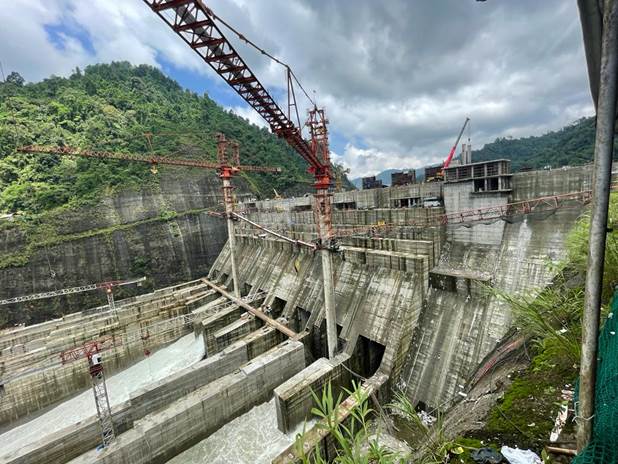
- 28 Oct 2025
In News:
India’s largest hydroelectric venture, the 2000 MW Subansiri Lower Hydroelectric Project, has officially entered its commissioning phase after years of delays, protests, and structural overhauls. Located at Gerukamukh on the Arunachal Pradesh–Assam border, the project marks a crucial milestone in India’s renewable energy expansion, especially in the Northeast.
Overview of the Project
- Type: Run-of-the-river hydroelectric project
- Capacity: 2000 MW (8 × 250 MW units)
- River:Subansiri River, a major tributary of the Brahmaputra
- Developer: National Hydroelectric Power Corporation (NHPC)
- Location:Gerukamukh, in the foothills of the Himalayas
- Construction Timeline: Work began in 2005; commissioning initiated in 2025
- Financing Structure: 70% equity and 30% debt; Central government provided budgetary support as equity
When fully operational, it will be India’s single largest hydroelectric power plant, providing a major boost to national energy security and clean energy capacity.
Engineering Features
- Concrete Gravity Dam:
- Height: 116 m from riverbed; 130 m from foundation
- Length: 284 m
- Reservoir Storage Capacity: 1.37 km³
- Power Generation System:
- Eight Francis-type turbines, each generating 250 MW
- Eight headrace tunnels, eight surge tunnels, and eight circular penstocks
- A 35 m-long, 206 m-wide tailrace channel to release water back into the river
Recent Developments – Commissioning Phase
On the first mechanical run, Unit-I generated 250 MW, marking the start of wet commissioning and its synchronization with the national grid. NHPC described this achievement as a “landmark moment for India’s hydropower landscape,” signalling steady progress toward bringing the remaining units online.
- Three additional units are expected to be commissioned within the year, adding 1,000 MW of clean energy to the grid.
- Once all 8 × 250 MW units become operational, the project will light millions of households and reinforce India’s push toward sustainable, reliable, and carbon-free energy.
Historical Delays and Controversies
The project’s trajectory has been far from smooth:
- Original commissioning target: December 2012
- Sanctioned: 2003
- Work halted: 2011–2019 due to widespread protests
Concerns raised by local communities and civil society groups:
- High seismic vulnerability of the region
- Potential ecological disruption
- Fear of downstream flooding
- Impact on riverine ecosystems and local livelihoods
Organisations such as the All Assam Students’ Union (AASU) demanded a complete reassessment of safety and environmental impacts.
Expert Review and Redesign
During the eight-year suspension:
- Expert committees from IIT Guwahati and the National Dam Safety Authority (NDSA) evaluated structural integrity and proposed design modifications.
- Recommended changes led to:
- Enhanced seismic reinforcements
- Additional grouting
- Redesign of spillways
- Strengthened safety protocols
The redesign ensured compliance with updated safety, hydrological, and structural norms before work resumed in October 2019.
Cost Escalation
The prolonged delays and modifications caused a substantial budget escalation:
- Initial Estimate: ?6,285 crore
- Revised Estimate: ?26,075 crore
- Cost Increase Drivers:
- Inflation
- Monsoon-induced damage
- Prolonged suspension of civil works
- Safety overhaul and redesign
Strategic Importance
- A cornerstone of India’s renewable energy strategy in the Northeast
- Strengthens national energy security with clean, baseload hydro capacity
- Supports grid stability and contributes to India’s climate goals
- Symbol of engineering resilience and India’s capability in executing large-scale infrastructure projects
NHPC leadership hailed the achievement as an emblem of “India’s unstoppable march towards a cleaner and self-reliant energy future.”
East Timor Joins ASEAN
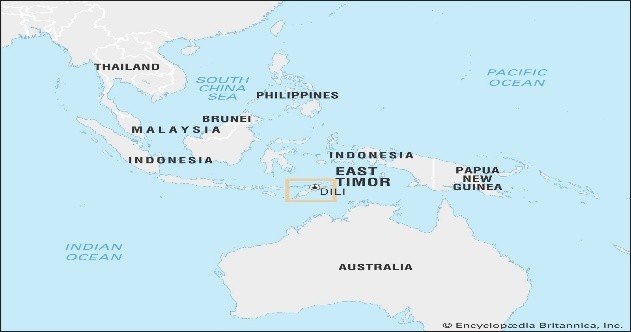
- 28 Oct 2025
In News:
East Timor (Timor-Leste) was formally admitted as the 11th member of the Association of Southeast Asian Nations (ASEAN) at the 47th ASEAN Summit in Kuala Lumpur, marking the organisation’s first expansion since the late 1990s.
Historical Milestone for East Timor
- Prime Minister Xanana Gusmão declared the moment “historic,” noting that ASEAN membership reflects both the aspirations and resilience of the Timorese people. President José Ramos-Horta, a Nobel Peace Prize laureate, and Gusmão—both icons of the independence movement—lead the nation as it navigates socio-economic challenges such as high unemployment, persistent malnutrition, and widespread poverty (with 42% of the population living below the national poverty line).
- East Timor’s journey to statehood has been arduous. A former Portuguese colony for over four centuries, it declared independence in 1975, only to face a 24-year occupation by Indonesia that claimed tens of thousands of lives. AUN-supervised referendum in 1999 paved the way to sovereignty, which was finally restored in 2002, making it one of the world’s youngest nations.
Why East Timor’s ASEAN Membership Matters
Malaysian Prime Minister Anwar Ibrahim, chairing the summit, emphasised that East Timor’s entry “completes the ASEAN family,” reflecting shared regional identity and a commitment to equitable growth. Analysts view the expansion as a declaration of ASEAN’s inclusivity and adaptability, especially amid global geopolitical volatility and rising protectionism.
Membership grants East Timor greater access to:
- ASEAN’s free trade arrangements
- Regional investment opportunities
- Broader markets and labour mobility
- Platforms for cooperation in education, technology, and digital economy
For a small, resource-dependent nation with a youthful demographic—nearly two-thirds of its people are under 30—ASEAN integration offers new possibilities for job creation, capacity building, and economic diversification. With oil and gas reserves declining, the government seeks fresh pathways for economic resilience.
East Timor: Key Facts
- Official Name: Democratic Republic of Timor-Leste
- Location: Eastern half of Timor Island in the Malay Archipelago; bordered by Indonesia and the Timor Sea
- Capital: Dili
- Geography: Mountainous terrain; highest peak Mount Tatamailau (2,963 m); tropical climate; rich biodiversity
- Population: ~1.4 million
- Economy: Predominantly dependent on hydrocarbons
East Timor applied for ASEAN membership in 2011 and was granted observer status in 2022, culminating in full accession in 2025.
About ASEAN and Its Relevance
- The Association of Southeast Asian Nations (ASEAN) is a regional intergovernmental organisation established in 1967 with the signing of the Bangkok Declaration by Indonesia, Malaysia, the Philippines, Singapore, and Thailand. Its headquarters is located in Jakarta, Indonesia.
- Current Membership (11 Countries):Indonesia, Malaysia, Philippines, Singapore, Thailand, Brunei, Vietnam, Laos, Myanmar, Cambodia, and East Timor.
- Core Goals:
- Promote political stability through dialogue and diplomacy
- Advance economic integration via AFTA and RCEP
- Strengthen cooperation on climate change, disaster response, and transnational threats
- Foster socio-cultural exchange and people-to-people connectivity
- Engage global powers through mechanisms like ASEAN+3 and East Asia Summit (EAS)
Significance for Regional Dynamics
East Timor’s accession:
- Reinforces ASEAN’s commitment to regionalism and openness, countering trends of protectionism
- Expands the bloc’s political influence and strengthens its collective strategic posture
- Enhances ASEAN’s identity as a community representing diverse political and economic systems
- Encourages equitable development within the region’s smallest and youngest member state
Operation Fire Trail
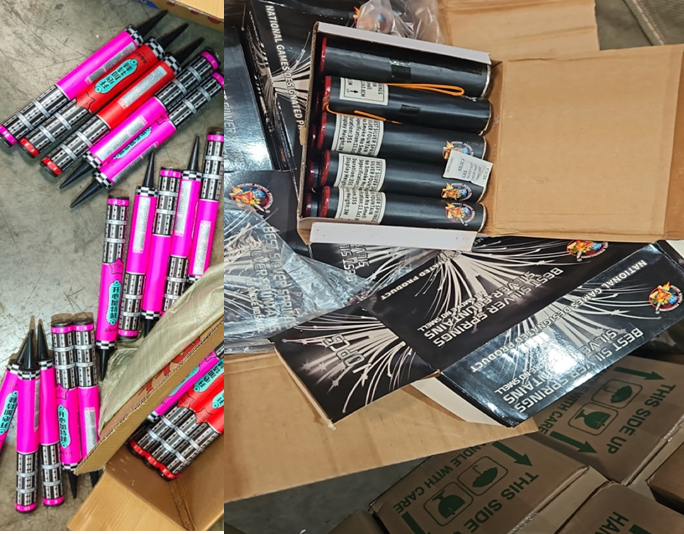
- 28 Oct 2025
In News:
The Directorate of Revenue Intelligence (DRI), under the Ministry of Finance, continues its nationwide anti-smuggling campaign titled “Operation Fire Trail”, aimed at curbing the illegal import of hazardous foreign-origin firecrackers into India. The operation focuses on intercepting smuggling networks that violate India’s trade regulations, safety norms, and environmental standards.
About Operation Fire Trail
- Nature of Operation:Operation Fire Trail is an intelligence-driven enforcement initiative designed to detect and prevent the illegal entry of non-compliant Chinese firecrackers into India. These pyrotechnic materials often contain harmful chemicals, posing severe risks to public health, safety, and the environment.
- Implementing Agency:The operation is carried out by the Directorate of Revenue Intelligence (DRI)—India’s apex anti-smuggling agency.
- Objectives:
- To dismantle organised smuggling syndicates involved in routing foreign firecrackers into India using false declarations.
- To enforce compliance with licensing norms mandated by the Directorate General of Foreign Trade (DGFT) and Petroleum and Explosives Safety Organisation (PESO) under the Explosives Rules, 2008.
- To strengthen India’s customs surveillance and safeguard national security.
Recent Seizure at Nhava Sheva Port
In one of the largest seizures during the ongoing operation, DRI intercepted a 40-foot container at Nhava Sheva port that had originated from China. The consignment, falsely declared as containing "leggings," was destined for ICD Ankleshwar.
A detailed examination revealed:
- 46,640 pieces of smuggled Chinese-origin firecrackers.
- Total estimated value: ?4.82 crore.
- Firecrackers were concealed behind a thin layer of garments to evade detection.
Subsequent raids led to the confiscation of incriminating documents exposing the smuggling syndicate’s modus operandi. A key suspect from Veraval, Gujarat, was arrested, marking a major breakthrough in the case.
Legal and Regulatory Framework
- Import of firecrackers into India is classified as “Restricted” under the ITC (HS) classification of the Foreign Trade Policy.
- Legitimate imports require:
- Valid DGFT licence, and
- Approval from PESO under the Explosives Rules, 2008.
- Smuggling of non-compliant fireworks bypasses these safeguards and introduces hazardous substances into the domestic market.
Significance of the Crackdown
- Protection of Public Safety: Smuggled firecrackers are often made using unsafe chemical compositions. Their uncontrolled entry poses serious risks of fire, explosions, and injury.
- Safeguarding Port and Supply Chain Infrastructure: Hazardous consignments threaten critical port infrastructure, warehouse safety, and logistics operations.
- Strengthening Enforcement Capacity: Operation Fire Trail enhances India’s intelligence-led enforcement, boosts customs vigilance, and disrupts transnational smuggling networks.
- Environmental Protection: Many imported Chinese firecrackers release toxic pollutants, violating environmental norms. Curtailing their inflow supports India’s pollution-control efforts.
- Supporting Domestic Manufacturing: The operation discourages cheap illegal imports and promotes domestic, compliant firecracker production aligned with safety and environmental regulations.
Global Multidimensional Poverty Index (MPI) 2025
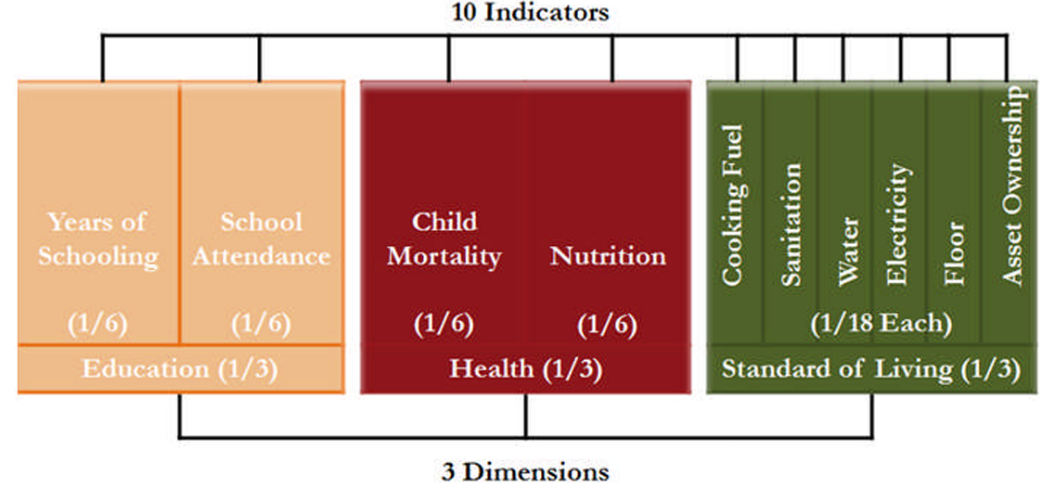
- 28 Oct 2025
In News:
- The United Nations Development Programme (UNDP) and the Oxford Poverty and Human Development Initiative (OPHI) released the Global Multidimensional Poverty Index (MPI) 2025 Report, titled “Overlapping Hardships: Poverty and Climate Hazards”.
- The report provides an evidence-based assessment of poverty that goes beyond income measures, highlighting how climate vulnerability and multidimensional deprivation reinforce each other.
About the Global MPI
- Nature of Index: The MPI is a global composite measure of acute poverty, capturing simultaneous deprivations in health, education, and standard of living through 10 indicators.
- Introduced: First featured in the 2010 Human Development Report.
- Published by: Jointly by UNDP Human Development Report Office and OPHI, annually since 2010.
- Objective: To assess:
- Who is poor
- How they are poor
- How deprivations overlap across households
- Enabling policymakers to align development strategies with SDG-1 (No Poverty).
- Methodology Highlights:
- 3 Dimensions: Health, Education, Living Standards.
- 10 Indicators: Nutrition, child mortality, years of schooling, school attendance, cooking fuel, sanitation, drinking water, electricity, housing, assets.
Global Trends in the MPI 2025
Poverty Headcount & Severity
- Out of 6.3 billion people assessed across 109 countries, 1.1 billion (18.3%) live in acute multidimensional poverty.
- 43.6% of the poor (≈501 million) experience severe poverty—being deprived in half or more indicators.
Regional Distribution of Poverty
- Sub-Saharan Africa (565 million) and South Asia (390 million) account for 83% of global poverty.
- Sub-Saharan Africa alone contains 49.2% of the world’s multidimensionally poor.
Children Disproportionately Affected
- Children form 33.6% of the global population but 51% of those living in multidimensional poverty.
- Malnutrition and disruption in schooling are primary drivers of child deprivation.
Middle-Income Countries as Core Contributors
- Nearly 740 million of the global poor live in middle-income countries, highlighting inadequacies of income-based poverty classifications.
Rural Concentration
- 83.5% of all multidimensionally poor live in rural areas, despite these areas comprising only 55% of total population.
Climate Hazard Exposure
- Nearly 80% of poor populations live in climate-vulnerable areas.
- Climate hazards include droughts, floods, extreme heat, and erratic precipitation patterns.
- South Asia has the highest number of poor people living in climate hazard zones.
Poverty & Climate Vulnerability in SIDS
- 22 Small Island Developing States (SIDS) show a combined poverty rate of 23.5%, higher than the developing world average.
- Rising sea levels (projected up to 70 cm by 2080–2099) threaten livelihoods in nations such as Belize, Comoros, and Samoa.
Post-Pandemic Stagnation
- Poverty reduction has slowed, with many countries witnessing stagnation or reversal due to:
- Inflation
- Conflict
- Climate shocks
- Post-pandemic economic disruptions
India in Global MPI 2025
Significant Poverty Reduction
- India reduced multidimensional poverty from 55.1% (2005–06) to 16.4% (2019–21).
- Over 414 million people moved out of multidimensional poverty.
- India's progress is among the fastest globally.
Persistent Child Poverty
- Children continue to face high deprivation, particularly in:
- Nutrition
- Sanitation
- Housing
- Cooking fuel
Climate Vulnerability and Poverty Link
- Nearly 99% of India’s poor live in climate-exposed regions.
- Heatwaves, floods, droughts, and air pollution intensify hardship and threaten livelihood security.
Drivers of MPI Improvement
India’s poverty reduction correlates with large-scale welfare and infrastructure missions:
- Swachh Bharat Mission – sanitation improvement
- PM Ujjwala Yojana – access to clean cooking fuel
- PM-Awas Yojana – housing for rural and urban poor
- Jal Jeevan Mission – access to clean drinking water
- Universal electrification initiatives
Key Challenges
- Rural–Urban Divide: 83% of the multidimensionally poor live in rural regions.
- Climate shocks: Frequent floods and droughts reverse development gains.
- Data Gaps: Lack of updated household-level data limits monitoring and policy targeting.
- Gender disparities: Women face inequalities in nutrition, education, healthcare, and asset ownership.
- Financial constraints: Several states struggle with fiscal capacity, affecting social protection and climate adaptation.
Policy Recommendations
- Integrate Climate & Poverty Policy: Adopt climate-resilient strategies combining:
- Green infrastructure
- Social protection
- Disaster risk reduction
- Localised Poverty Tracking: Develop district-level MPI dashboards for real-time, granular monitoring.
- Promote Green Livelihoods: Expand employment in:
- Renewable energy
- Organic farming
- Circular economy sectors
- Enhance Global Support: Strengthen access to:
- Climate finance
-
- Concessional aid
- Technology transfers
- Gender and Child-Focused Interventions: Reinforce programs for:
- Nutrition
- Maternal health
- Education
- Clean cooking energy
MAHA MedTech Mission
- 27 Oct 2025
In News:
The Anusandhan National Research Foundation (ANRF), in collaboration with the Indian Council of Medical Research (ICMR) and the Bill & Melinda Gates Foundation, has launched the Mission for Advancement in High-Impact Areas (MAHA)–Medical Technology (MedTech).This landmark initiative seeks to accelerate innovation in India’s medical technology ecosystem, reduce dependence on costly imports, and ensure affordable, high-quality healthcare technologies for all.
About the MAHA MedTech Mission
- Launched by: ANRF, in partnership with ICMR and Gates Foundation
- Mission Duration: 5 years
- Deadline for Concept Note Submission: 7 November 2025
- Implemented through: ANRF online portal – www.anrfonline.in
The mission represents a strategic push under the government’s Aatmanirbhar Bharat vision to strengthen India’s domestic MedTech sector, which is currently import-heavy and fragmented.
Objectives of the MAHA MedTech Mission
- Public Health Impact:
- Promote technologies addressing priority disease areas such as tuberculosis, cancer, neonatal and maternal care, and primary healthcare.
- Expand access to safe, high-quality medical care across India.
- Affordability and Accessibility:
- Support innovative solutions that reduce healthcare costs while maintaining quality standards.
- Promote equitable access to advanced medical devices, especially in rural and underserved regions.
- Self-Reliance and Competitiveness:
- Catalyze indigenous research, manufacturing, and commercialization in MedTech.
- Foster industry–academia collaboration and boost India’s global competitiveness in medical innovation.
Scope of the Mission
The MAHA MedTech Mission will support a wide range of medical technologies and innovations, including:
- Medical devices and equipment
- In-vitro diagnostics (IVDs) and subcomponents
- Implants and surgical instruments
- Assistive and wearable devices
- Consumables and disposables
- AI/ML-driven software-based medical platforms
- Robotics, imaging, and minimally invasive technologies
- Point-of-care and molecular diagnostics
These innovations will target priority national health areas, promoting early disease detection, efficient treatment delivery, and improved healthcare infrastructure.
Funding Mechanism
- Milestone-linked funding:
- ?5–25 crore per project
- Up to ?50 crore for exceptional projects with transformative potential.
- Eligible Applicants:
- Academic and R&D institutions
- Hospitals and clinical research centers
- Startups and MSMEs
- Established MedTech industries
- Interdisciplinary collaborations between public and private entities
The funding structure encourages translational research, product prototyping, clinical validation, and commercialization of indigenous medical technologies.
Enabling Support Framework
The Mission also provides institutional and regulatory facilitation through several national support programs:
- Patent Mitra:Facilitates intellectual property protection, patent filing, and technology transfer.
- MedTech Mitra:Provides regulatory guidance, helps in obtaining clinical and market approvals, and supports compliance with national and international standards.
- Clinical Trial Network:Offers access to a national network of hospitals and research centers for clinical validation and evidence generation.
- Mentorship and Industry Linkages:Access to industry mentors, market experts, and commercialization partners to support end-to-end product development.
Notice to Airmen (NOTAM)

- 27 Oct 2025
In News:
India has recently issued a Notice to Airmen (NOTAM) for a large-scale tri-services military exercise, “Ex Trishul,” scheduled along the Pakistan border. The announcement highlights India’s focus on joint operational preparedness, self-reliance, and technological innovation in defence.
About Notice to Airmen (NOTAM)
- Notice to Airmen (NOTAM), also known as Notice to Air Missions, is an official notification issued by national aviation authorities to inform airspace users about temporary or permanent changes that may affect flight operations.
- Purpose: NOTAMs ensure flight safety by providing timely information about:
- Changes in aeronautical facilities or services
- Temporary airspace restrictions
- Hazards or obstacles along flight paths
- Military activities, such as exercises or missile tests
They are critical for pilots, air traffic controllers, and flight planners, allowing them to modify flight paths or schedules to ensure operational safety.
Common Reasons for Issuing NOTAMs
- Airshows, parachute jumps, or glider operations
- VIP movements (e.g., heads of state)
- Runway or taxiway closures
- Unserviceable navigational aids or airport lighting
- Construction activities or temporary obstacles near airfields
- Military exercises involving restricted or closed airspace
NOTAMs are disseminated rapidly via aeronautical communication systems, online aviation portals, and electronic flight planning tools, enabling real-time updates for all stakeholders.
India’s Recent NOTAM: Context and Significance
The recent NOTAM covers a large segment of India’s western frontier, extending up to 28,000 feet, indicating one of the largest joint operational drills in recent years. Satellite imagery has highlighted the vast scale of the restricted airspace, reflecting India’s intent to conduct multi-domain, tri-service coordination along the Pakistan border.
This development follows Operation Sindoor (May 2025)—a precision air campaign against Pakistan’s terror infrastructure launched in response to the Pahalgam terror attack (April 2025). The operation neutralized over 100 terrorists, marking one of the most intense India–Pakistan military confrontations in decades.
About Exercise Trishul
Exercise Trishul (Ex Trishul) is a tri-services military exercise involving the Indian Army, Navy, and Air Force. It aims to strengthen jointness, operational integration, and technological innovation, aligning with the government’s JAI Vision—Jointness, Aatmanirbharta, and Innovation.
Objectives
- To enhance inter-service coordination in high-tempo, multi-domain operations.
- To test indigenous systems and weapons platforms developed under the Aatmanirbhar Bharat initiative.
- To refine tactics, techniques, and procedures (TTPs) suited to emerging hybrid and asymmetric threats.
Key Operational Components
- Joint Operations:
- Coordinated manoeuvres across desert, creek, and coastal sectors, led by Southern Command.
- Amphibious operations off the Saurashtra coast, integrating Navy and Army assets.
- Air defence missions, reconnaissance, and electronic warfare (EW) exercises by the Air Force.
- Multi-Domain Integration:
- Exercises in Intelligence, Surveillance, and Reconnaissance (ISR) networks.
- Deployment of cyber warfare and space-enabled systems.
- Incorporation of Artificial Intelligence–based decision support and digital command systems.
- Indigenous Focus:
- Use of home-grown technologies in sensors, communication networks, and combat systems.
- Demonstrates the operational maturity of India’s defence manufacturing ecosystem.
Mahe- Anti-Submarine Warfare Shallow Water Craft

- 27 Oct 2025
In News:
The Indian Navy has recently received ‘Mahe’, the first of eight Anti-Submarine Warfare Shallow Water Crafts (ASW SWCs), built indigenously by Cochin Shipyard Limited (CSL), Kochi. The induction marks a major step towards bolstering India’s littoral (coastal) defence capabilities and advancing the vision of Aatmanirbhar Bharat in naval shipbuilding.
About Mahe – ASW Shallow Water Craft
- Builder: Cochin Shipyard Limited (CSL), Kochi
- Delivered to: Indian Navy
- Named after:Mahe, a historic port town in the Union Territory of Puducherry, symbolizing India’s rich maritime heritage.
- Classification: Designed and constructed under the rules of Det Norske Veritas (DNV) classification society.
- Displacement: Around 1,100 tons
- Length: Approximately 78 metres
- Indigenous Content: Over 80%, showcasing India’s growing self-reliance in naval design and shipbuilding.
Design and Features
- Advanced Warfare Capabilities
- Equipped with torpedoes and multi-functional anti-submarine rockets.
- Integrated radar and sonar systems for precise detection and engagement of underwater threats.
- Designed for Anti-Submarine Warfare (ASW) operations in shallow coastal waters.
- Operational Flexibility
- Capable of underwater surveillance, mine-laying operations, and Low Intensity Maritime Operations (LIMO).
- Suitable for coastal defence, escort missions, and search and rescue operations in littoral zones.
- Sustainability and Efficiency
- Compact yet powerful platform for quick maneuverability in shallow regions.
- Built using modern shipbuilding technologies, ensuring durability, stealth, and operational efficiency.
Strategic Significance
- Enhancing ASW Capabilities:The induction of Mahe will significantly strengthen India’s anti-submarine warfare capacity in coastal waters, enabling faster response to sub-surface threats from enemy submarines or unmanned underwater vehicles.
- Maritime Security:Strengthens surveillance and security along India’s vast 7,500 km coastline, ensuring greater control over sea lines of communication (SLOCs) and exclusive economic zones (EEZs).
- Boost to Aatmanirbhar Bharat:The vessel, with more than 80% indigenous components, reflects the Make in India initiative’s success in the defence manufacturing sector. It reinforces India’s ambition to be a net security provider in the Indian Ocean Region (IOR).
- Support to Blue Water Aspirations:While designed for shallow waters, the ASW SWC fleet complements India’s blue-water naval capability by securing coastal zones — the first line of maritime defence.
About Cochin Shipyard Limited (CSL)
- Established: 1972
- Location: Kochi, Kerala
- Ownership: Under the Ministry of Ports, Shipping, and Waterways
- CSL has emerged as one of India’s premier shipbuilding and repair facilities, with successful projects like:
- INS Vikrant (India’s first indigenous aircraft carrier)
- ASW Shallow Water Craft series
Project Arunank
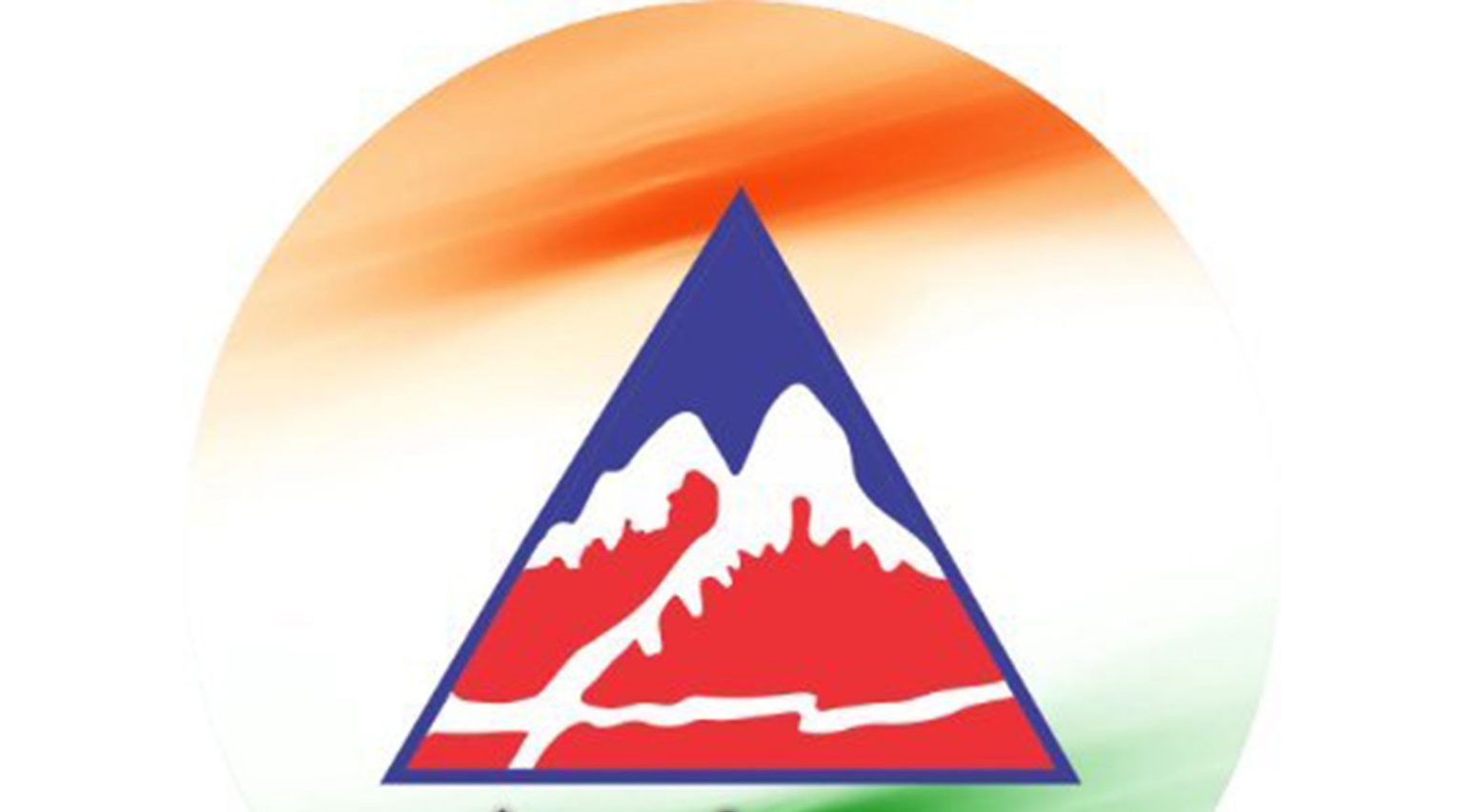
- 27 Oct 2025
In News:
Project Arunank of the Border Roads Organisation (BRO) recently celebrated its 18th Raising Day at Naharlagun, marking over 17 years of sustained infrastructure development in Arunachal Pradesh’s remote and strategic regions.
About Project Arunank
- Launched: 2008
- Implementing Agency: Border Roads Organisation (BRO), under the Ministry of Defence.
- Name Origin: Derived from the state’s name — Arunachal Pradesh.
- Objective:To enhance road connectivity in remote valleys and forward areas of Arunachal Pradesh, supporting both civilian access and the operational needs of the Indian Armed Forces.
Key Achievements
- Strategic Road Development
- Constructed and maintained over 696 km of roads and 1.18 km of major bridges across the state.
- Completed the 278 km Hapoli–Sarli–Huri Road, which was blacktopped for the first time since Independence, connecting the remote KurungKumey district — a major milestone in post-Independence connectivity.
- Technological Innovations
- Adopted modern and sustainable construction technologies, including:
- Steel Slag and GGBFS Concrete for durability.
- Cut-and-Cover Tunnels and Geo Cells for terrain stability.
- Plastic Sheets, Gabion Walls, and Slope Stabilisation Systems to prevent landslides and improve road resilience.
- These innovations promote eco-friendly and climate-resilient infrastructure in fragile Himalayan terrain.
- Adopted modern and sustainable construction technologies, including:
- Green and Welfare Initiatives
- Under the ‘Ek Ped MaaKe Naam’ campaign, over 23,850 trees were planted across Arunachal Pradesh to promote environmental conservation.
- Welfare measures for Casual Paid Labourers (CPLs) included better shelters, protective gear, and regular health camps—acknowledging their crucial contribution to BRO’s success.
- Community and Awareness Programs: Conducted a motorable expedition along the Naharlagun–Joram Top–Sangram–Ziro–Naharlagun route to promote road safety and connectivity awareness among locals and officials.
Future Plans
- Focus on road widening, construction of new bridges and tunnels, and improving all-weather, high-altitude connectivity for both civilian and defence use.
- Integration of digital monitoring tools, geotextiles, and eco-friendly materials to enhance infrastructure sustainability while reducing maintenance costs.
About the Border Roads Organisation (BRO)
- Established: 7 May 1960
- Parent Ministry: Ministry of Defence
- Mandate:To construct and maintain road networks in border areas of India and in friendly neighbouring countries to ensure defence preparedness and socio-economic development.
- The BRO has been pivotal in strategic connectivity across northern and northeastern India, including projects like Arunank (Arunachal Pradesh), Vartak (Assam & Arunachal), Himank (Ladakh), and Sampark (Jammu & Kashmir).
Duty-Free Tariff Preference (DFTP) Scheme

- 27 Oct 2025
In News:
The World Trade Organization (WTO) has recently credited India’s Duty-Free Tariff Preference (DFTP) Scheme for significantly boosting exports from Least Developed Countries (LDCs). India has surpassed China and the European Union (EU) in providing duty-free market access to the world’s poorest economies, strengthening South-South trade cooperation.
About the DFTP Scheme
- Launched: 2008
- Implementing Agency: Ministry of Commerce and Industry, Government of India
- Framework: In line with the WTO’s Hong Kong Ministerial Declaration (2005), which encouraged developed and developing members to provide duty-free and quota-free (DFQF) market access to LDCs.
- Objective:To promote trade-led economic growth of LDCs by granting preferential tariff concessions on their exports to India.
Key Features
- Comprehensive Duty-Free Access
- Provides duty-free or preferential tariff access to a large range of products exported from LDCs to India.
- Nearly 98% of India’s tariff lines are now covered under the scheme.
- Eligible Countries
- Open to all LDCs recognized by the United Nations.
- Currently, around 48 countries in Africa, Asia, and the Pacific benefit from it.
- Product Coverage
- Agricultural goods: Fruits, vegetables, grains, spices, coffee, and tea.
- Textiles & garments: Clothing, fabrics, and handwoven textiles.
- Leather & handicrafts: Bags, jewelry, and artisan products.
- Minerals & metals: Including raw materials like gold and diamonds.
- Processed foods and beverages: Key export commodities for African and Asian LDCs.
- Trade Facilitation: Simplified customs procedures and transparent rules of origin help integrate LDC exporters into global value chains (GVCs).
Recent WTO Recognition
According to the WTO, India now provides one of the widest duty-free market access schemes among developing economies—outperforming China and the EU in terms of product and tariff-line coverage.
This initiative has:
- Enhanced export diversification in LDCs.
- Strengthened India’s trade and diplomatic engagement with Africa and other developing regions.
- Supported inclusive global trade, aligning with the UN Sustainable Development Goals (SDG 17: Partnerships for the Goals).
Significance
- For LDCs: Encourages industrial growth, employment, and export competitiveness.
- For India: Reinforces its image as a responsible development partner and a leader in South-South cooperation.
- For Global Trade: Promotes equity by integrating vulnerable economies into mainstream trade flows.
Laser Interferometer Space Antenna (LISA) Mission

- 26 Oct 2025
In News:
The Laser Interferometer Space Antenna (LISA) is a joint mission of the European Space Agency (ESA) and NASA, scheduled for launch in the mid-2030s. It represents the first-ever space-based observatory designed to detect gravitational waves, offering an unprecedented opportunity to study some of the most energetic and mysterious phenomena in the universe.
Mission Objective
LISA aims to:
- Directly detect and study gravitational waves—minute ripples in spacetime caused by massive cosmic events such as black hole mergers, neutron star collisions, and possibly phenomena from the early universe.
- Explore the fundamental nature of gravity and black holes, providing insights into Einstein’s General Theory of Relativity.
- Investigate cosmic evolution by probing how galaxies and black holes have grown and interacted over time.
- Contribute to understanding the universe’s expansion rate, complementing other cosmological observations.
Design and Configuration
- The LISA system will consist of three identical spacecraft, positioned in an equilateral triangular formation.
- Each side of this triangle will span approximately 2.5 million kilometres, and the formation will trail Earth in its orbit around the Sun at a distance of about 50 million kilometres.
- This configuration will enable ultra-precise measurements of tiny variations in distance between the spacecraft caused by passing gravitational waves.
Scientific Principle
- Each spacecraft will contain two free-floating test masses (gold-platinum cubes) that serve as nearly perfect reference points in space.
- Laser beams exchanged between the spacecraft will measure the relative distance between these cubes with extraordinary accuracy using laser interferometry.
- As gravitational waves pass through, they will slightly alter the distances between the spacecraft—by as little as a fraction of the width of an atom—allowing LISA to record and analyse these distortions.
Technological Significance
- LISA extends the capabilities of ground-based detectors like LIGO and VIRGO, which can only detect higher-frequency gravitational waves.
- By operating in space, LISA can sense low-frequency gravitational waves generated by supermassive black hole binaries and other massive cosmic systems, which are beyond the reach of terrestrial observatories.
- The mission will also test cutting-edge technologies in laser stability, drag-free navigation, and precision metrology.
Scientific Impact
- Enhance understanding of black hole dynamics, galaxy formation, and cosmic structure evolution.
- Provide new data on extreme astrophysical events and test the limits of General Relativity.
- Contribute to multi-messenger astronomy, linking gravitational wave observations with electromagnetic and particle signals from the same sources.
- Offer valuable inputs for cosmology, including studies of dark matter, dark energy, and the early universe.
Japan–India Maritime Exercise (JAIMEX) 2025

- 26 Oct 2025
In News:
The Indian Naval Ship (INS) Sahyadri, an indigenously built Shivalik-class guided missile stealth frigate, participated in the Japan–India Maritime Exercise (JAIMEX-25).
About JAIMEX 2025
- Nature of Exercise: JAIMEX is a bilateral maritime exercise conducted between the Indian Navy (IN) and the Japan Maritime Self-Defense Force (JMSDF).
- Objective: It aims to enhance operational interoperability, mutual understanding, and maritime cooperation, reflecting the robust ‘Special Strategic and Global Partnership’ established between India and Japan in 2014.
- Theme: Upholding a free, open, and inclusive Indo-Pacific based on the principles of rules-based order, freedom of navigation, and shared maritime security.
Exercise Structure
JAIMEX 2025 was conducted in two distinct phases — the Sea Phase and the Harbour Phase, each designed to deepen operational synergy and people-to-people interaction between the two navies.
1. Sea Phase:
- Participating vessels included INS Sahyadri, and JMSDF ships Asahi, Oumi, and Submarine Jinryu.
- The drills focused on:
- Advanced Anti-Submarine Warfare (ASW)andmissile defence operations.
- Flying operationsandunderway replenishmentexercises.
- Maritime domain awareness and communication interoperability.
- These activities aimed to enhance tactical coordination, build mutual trust, and improve joint operational readiness between the two navies.
2. Harbour Phase (Yokosuka, Japan)
- Featured professional and cultural exchanges, including:
- Cross-deck visits,
- Collaborative operational planning,
- Sharing of best practices, and
- A combined Yoga session to promote cultural camaraderie.
- The harbour engagement served as a part of INS Sahyadri’s Long Range Deployment (LRD) to the Indo-Pacific, reflecting India’s increasing maritime outreach and strategic presence in the region.
Significance of JAIMEX
- Strengthens Maritime Cooperation: Enhances India–Japan naval interoperability, crucial for coordinated responses to maritime security challenges such as piracy, illegal fishing, and humanitarian assistance.
- Supports the Indo-Pacific Vision: Reinforces the shared commitment to a rules-based maritime order and an inclusive Indo-Pacific, aligning with initiatives like QUAD and Indo-Pacific Oceans Initiative (IPOI).
- Boosts Defence Diplomacy: Builds mutual trust and operational understanding through regular bilateral and multilateral engagements.
- Showcases India’s Indigenous Naval Capability: INS Sahyadri’s participation underscores India’s progress under ‘Aatmanirbhar Bharat’ and its ability to deploy advanced indigenous platforms for extended missions.
INS Sahyadri: Key Facts
|
Feature |
Description |
|
Class & Type |
Shivalik-class Guided Missile Stealth Frigate |
|
Commissioned |
2012 |
|
Built by |
Mazagon Dock Shipbuilders Ltd, Mumbai |
|
Missile Systems |
Barak-1, Shtil-1 (3S90M) SAMs, BrahMos anti-ship missiles |
|
Other Armaments |
Anti-submarine rocket launchers and torpedoes |
|
Capabilities |
Multi-role stealth platform for surface, anti-air, and anti-submarine warfare |
|
Previous Deployments |
Multiple bilateral and multilateral exercises across the Indo-Pacific |
India–Japan Defence and Strategic Cooperation
The India–Japan defence partnership has become a key component of their broader Special Strategic and Global Partnership (2014), rooted in shared democratic values and converging strategic interests in the Indo-Pacific.
Major Bilateral and Multilateral Defence Engagements:
- Malabar Exercise – Multilateral naval exercise (India, Japan, USA, Australia).
- Dharma Guardian – Bilateral Army exercise.
- Veer Guardian – Bilateral Air Force exercise.
- 2+2 Ministerial Dialogue – Institutional mechanism for strategic coordination.
These engagements collectively strengthen maritime domain awareness, supply chain resilience, and defence technology cooperation between the two nations.
Strategic Context
- The JAIMEX exercise aligns with India’s Act East Policy and Japan’s Free and Open Indo-Pacific (FOIP) vision.
- It demonstrates a collective response to maritime challenges such as increasing militarization, territorial disputes, and climate-driven risks in the Indo-Pacific.
- The partnership complements India’s engagement in regional groupings such as the QUAD, ASEAN-led mechanisms, and IORA (Indian Ocean Rim Association).
UN’s Early Warnings for All (EW4All) Initiative
- 26 Oct 2025
In News:
The World Meteorological Organization (WMO), at its Extraordinary Congress in Geneva (October 2025), rallied its 193 Member States to commit to achieving universal early warning coverage by 2027 under the United Nations’ Early Warnings for All (EW4All) initiative. This global “Call to Action” seeks to ensure that no one dies for lack of warning in the face of intensifying weather, water, and climate-related disasters.
About Early Warning Systems (EWS)
An Early Warning System (EWS) is an integrated mechanism that combines:
- Hazard monitoring and forecasting,
- Disaster risk assessment,
- Communication of alerts, and
- Preparednessmeasures,to enable timely action that saves lives, livelihoods, and assets.
According to the WMO, a 24-hour advance warning can reduce disaster-related damage by up to 30%, underscoring the importance of predictive and community-based alert systems.
UN’s Early Warnings for All (EW4All) Initiative
- Launched: 2022 by UN Secretary-General António Guterres.
- Lead Agencies:
- World Meteorological Organization (WMO)
- UN Office for Disaster Risk Reduction (UNDRR)
- International Telecommunication Union (ITU)
- International Federation of Red Cross and Red Crescent Societies (IFRC)
- Goal: To ensure that every person on Earth is protected by life-saving early warnings for hazards such as cyclones, floods, droughts, and heatwaves by 2027.
- Philosophy: “Every dollar invested in early warnings saves up to fifteen dollars in avoided losses.”
The Early Warning “Value Chain”
The EW4All initiative emphasizes strengthening each link of the early warning value chain:
- Monitoring and Forecasting: Building accurate, real-time climate and hazard observation networks.
- Risk Assessment: Identifying vulnerable populations and areas through integrated risk mapping.
- Alert Dissemination: Delivering clear, trusted, and accessible alerts using multi-platform communication (digital, radio, community-based).
- Preparedness and Response: Ensuring communities understand warnings and act effectively.
Global Need and Rationale
- Over the past 50 years, climate, weather, and water-related disasters have claimed over 2 million lives, with 90% of deaths occurring in developing nations.
- Since 1970, economic losses from such disasters have exceeded US$4 trillion globally.
- Countries lacking multi-hazard early warning systems experience six times higher mortality and four times greater impacts than those equipped with such systems.
Current Global Status
- As of 2024, 108 countries have some capacity for multi-hazard early warning systems, up from 52 countries in 2014.
- However, Least Developed Countries (LDCs), Small Island Developing States (SIDS), and conflict-affected regions remain severely underprotected.
- A WMO assessment across 62 countries revealed:
- 50% have only basic hazard monitoring capacity.
- 16% have less than basic capacity.
- Technical barriers include:
- Weak observation networks,
- Limited data sharing,
- Inadequate financing, and
- Lack of community trust and awareness.
Progress Under EW4All
The WMO’s 2025 Congress marked a turning point as 193 nations endorsed a Call to Action for universal coverage by 2027.Key outcomes include:
- Country-led assessments and roadmaps for capacity building.
- Integration of EW4All targets with the Sendai Framework for Disaster Risk Reduction (2015–2030).
- Strengthened regional cooperation for hazard data sharing and early action.
- New partnerships between national meteorological services, private sector innovators, and humanitarian agencies.
Call to Action: Priority Measures
To meet the 2027 universal coverage target, WMO and the UN have urged governments to:
- Integrate EWS into national climate and disaster management policies.
- Secure long-term and predictable financing beyond short-term project aid.
- Empower National Meteorological and Hydrological Services (NMHSs) with clear mandates and authority.
- Ensure inclusivity by combining scientific data with indigenous knowledge to reach vulnerable and remote communities.
- Leverage innovation and AI to enhance the precision and speed of predictions.
- Promote open data sharing and capacity-building to close technological gaps.
Regional Implications for India
India, as one of the most climate-vulnerable nations facing monsoons, cyclones, and heatwaves, stands to benefit immensely from EW4All.
- India already operates a robust multi-hazard early warning system led by the India Meteorological Department (IMD), NDMA, and INCOIS.
- Integration under EW4All could help upgrade radar networks, enhance last-mile connectivity, and strengthen community-based disaster response.
- The initiative aligns with India’s National Disaster Management Plan (NDMP) and Sendai Framework priorities, reinforcing the “Zero Casualty” approach in disaster management.
Deendayal Antyodaya Yojana – National Rural Livelihoods Mission (DAY-NRLM)
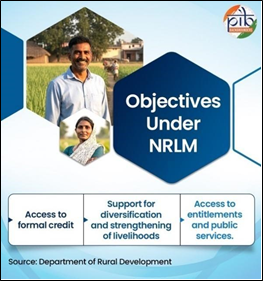
- 26 Oct 2025
In News:
The Deendayal Antyodaya Yojana – National Rural Livelihoods Mission (DAY-NRLM), implemented by the Ministry of Rural Development (MoRD), stands as one of the world’s largest poverty alleviation and women-centric livelihood programmes. It has successfully mobilized millions of rural households into community institutions and significantly advanced the agenda of women’s empowerment, financial inclusion, and sustainable rural livelihoods.
Genesis and Evolution
- Launch: Initially introduced in 2010 as the National Rural Livelihoods Mission (NRLM) by restructuring the Swarnajayanti Gram Swarozgar Yojana (SGSY).
- Renaming: In 2016, it was renamed Deendayal Antyodaya Yojana – National Rural Livelihoods Mission (DAY-NRLM) to honour the philosophy of Antyodaya—uplifting the poorest of the poor.
- Funding Pattern: It is a Centrally Sponsored Scheme, jointly funded by the Central and State Governments.
- Objective: To reduce rural poverty by enabling poor households to access self-employment and skilled wage employment opportunities, ensuring diversified and sustainable livelihoods.
Core Objectives
The mission seeks to empower rural communities by investing in four key pillars:
- Social Mobilisation& Institution Building: Organizing rural poor, especially women, into Self-Help Groups (SHGs) and federations for mutual support and long-term empowerment.
- Financial Inclusion: Ensuring access to formal credit and financial services through community-based intermediaries like Bank Sakhis and Banking Correspondent Sakhis.
- Sustainable Livelihoods: Promoting both farm and non-farm livelihoods including agriculture, livestock, handicrafts, and microenterprises.
- Social Development & Convergence: Addressing gender, nutrition, health, sanitation, and social justice through convergence with other government programmes.
Women-Centric Model
Women are at the heart of DAY-NRLM. The mission focuses on collectivizing women into SHGs, enhancing their entrepreneurial capacity, and connecting them to markets, technology, and credit networks.
- Scale: As of June 2025, the mission has mobilized 10.05 crore rural households into 90.9 lakh SHGs across 28 States and 6 UTs.
- Financial Empowerment: Over ?11 lakh crore has been disbursed to SHGs through formal banking systems, backed by collateral-free loans and interest subvention, with a 98% repayment rate — a testament to the model’s sustainability.
- Community Cadres: SHG women are trained as Community Resource Persons (CRPs) such as
- Krishi Sakhis – agricultural extension support,
- PashuSakhis – animal health and livestock management,
- Bank Sakhis – financial inclusion facilitators,
- BimaSakhis – insurance and welfare access agents.
- Over 3.5 lakh Krishi and PashuSakhis and 47,952 Bank Sakhis have been deployed to deliver last-mile services.
Entrepreneurship and Microenterprise Development
To promote local entrepreneurship, the Mission runs the Start-up Village Entrepreneurship Programme (SVEP), supporting 3.74 lakh rural enterprises across 282 blocks.
These enterprises cover diverse sectors like handicrafts, food processing, agro-based units, and rural services — encouraging self-reliance and community-led growth.
A remarkable example is of Heinidamanki Kanai from Meghalaya, who turned her SHG training into a successful handmade soap business with bank support under NRLM — a model of grassroots entrepreneurship.
Skill Development and Employment Initiatives
DAY-NRLM implements two major Centrally Sponsored Schemes to boost rural employability and entrepreneurship:
- DeenDayal Upadhyaya Grameen Kaushalya Yojana (DDU-GKY)
- Provides placement-linked skill training for rural youth aged 15–35 years.
- 17.50 lakh trained and 11.48 lakh placed as of June 2025.
- Top-performing states: Uttar Pradesh, Odisha, and Andhra Pradesh.
- Rural Self Employment Training Institutes (RSETIs)
- Bank-sponsored centres for youth aged 18–50 years, providing entrepreneurship training and promoting both self- and wage-employment.
- 56.69 lakh candidates trained,40.99 lakh settled in gainful employment.
- Leading states: Uttar Pradesh, Rajasthan, Madhya Pradesh, and Karnataka.
Achievements and Outcomes
High-Performing States:
- Bihar, Uttar Pradesh, Andhra Pradesh (SHG formation and financial inclusion).
- Maharashtra, Uttar Pradesh, Andhra Pradesh (agro-ecological initiatives under MahilaKisanprogrammes).
- Assam, Kerala, and West Bengal (microenterprise promotion under SVEP).
Capacity Building and Marketing Initiatives
To strengthen entrepreneurship and market readiness:
- SARAS Aajeevika Melas (National & State-level fairs) are organized annually to showcase SHG products and build marketing skills.
- The National Institute of Rural Development and Panchayati Raj (NIRD&PR) conducts Training of Trainers (ToT)programmes on marketing, having trained over 44 batches in the past three years.
- These initiatives bridge rural producers with urban consumers and e-commerce platforms, enhancing rural incomes.
Impact on Rural Transformation
- Economic Empowerment: Enhanced access to credit and markets has diversified income sources for millions of women.
- Social Transformation: SHG networks now play a role in local governance, social awareness, and addressing gender issues such as domestic violence, health, and education.
- Financial Inclusion: The presence of SHG-led financial intermediaries ensures doorstep access to savings, credit, and insurance.
- Sustainable Livelihoods:Agro-ecological practices, livestock management, and non-farm enterprises are reducing ecological stress and enhancing resilience.
Challenges Ahead
- Uneven implementation across states and regions.
- Need for stronger digital monitoring and credit tracking.
- Enhancing market linkages for SHG products.
- Integrating livelihood programmes with emerging green and climate-resilient models.
Conclusion
The Deendayal Antyodaya Yojana – National Rural Livelihoods Mission (DAY-NRLM) exemplifies inclusive, women-led rural development. By mobilizing millions of women into strong community institutions, linking them with finance and skills, and promoting sustainable livelihoods, it has transformed the socio-economic fabric of rural India.
As a global model of community-driven development, the Mission continues to advance India’s vision of “Atmanirbhar Bharat” by empowering its most vulnerable citizens to become entrepreneurs, leaders, and change-makers in their own right.
Forest Rights Act (FRA), 2006
- 26 Oct 2025
In News:
The Central Government has strongly defended the Forest Rights Act (FRA), 2006 before the Supreme Court, asserting that the law plays a transformative role in restoring the dignity, livelihoods, and cultural identity of India’s forest-dependent communities. The Ministry of Tribal Affairs (MoTA), in its affidavit, has rebutted allegations that the FRA or its 2012 Rules conflict with existing wildlife and forest protection laws.
Background
- The Forest Rights Act was enacted in 2006 to correct historical injustices faced by Scheduled Tribes (STs) and Other Traditional Forest Dwellers (OTFDs), whose rights over forest lands were never formally recorded.
- The Act’s constitutional validity was challenged in 2008 by the NGO Wildlife First, which sought eviction of people whose claims were rejected under the Act.
- In February 2019, the Supreme Court directed states to evict rejected claimants, triggering widespread protests from tribal groups and civil society.
- The MoTA intervened, pointing to procedural lapses in claim verification, leading the Court to stay the eviction order and call for fresh data and review of rejected claims.
Government’s Stand Before the Supreme Court
- The MoTA has upheld both the legal validity and spirit of the Act, clarifying that FRA is not merely about land ownership but about restoring dignity, livelihoods, and cultural identity.
- The Ministry has rebutted claims that FRA undermines wildlife or forest conservation, arguing that the coexistence model has long been practiced by indigenous groups such as the Baiga and Santhal communities.
- The Centre has emphasized that the absence of a sunset clause in the Act is intentional to ensure equity and prevent arbitrary timelines for claim submissions.
- It also highlighted that the Gram Sabha is the final authority in determining forest rights, as reaffirmed by the 2013 Niyamgiri judgment, which upheld the community and cultural rights of the DongriaKondh tribe in Odisha.
Key Provisions of the FRA, 2006
The Act recognises two broad categories of rights:
- Individual Forest Rights (IFR): Ownership and habitation rights for forest land cultivated or occupied by individuals or families.
- Community Forest Rights (CFR): Rights of communities over forest resources, including grazing, fishing, and collection of Minor Forest Produce (MFP) like bamboo, tendu leaves, honey, lac, and wax.
Empowerment of Gram Sabha:
- To identify, verify, and recommend claims for forest rights.
- To manage and protect community forest resources sustainably.
- To regulate access to and trade of MFP, ensuring benefits reach local communities directly.
Government Initiatives Supporting FRA Implementation
- The Minimum Support Price (MSP) scheme for Minor Forest Produce ensures fair value for tribal collectors.
- The Tribal Cooperative Marketing Development Federation (TRIFED) and Van DhanKendras assist tribal communities in value addition and marketing of forest products.
- These mechanisms prevent the monopolisation of forest produce by contractors and enhance economic self-reliance among tribal communities.
Key Issues and Challenges
- Implementation Delays: Many claims remain pending due to administrative inefficiencies and lack of trained personnel at local levels.
- Conflict with Conservation Laws: Overlaps with the Wildlife Protection Act (1972) and Forest Conservation Act (1980) often lead to confusion and litigation.
- Commercialization Risks: Concerns exist over unsupervised extraction of MFP if monitoring is weak.
- Data and Monitoring Gaps: Lack of digitized and transparent claim records has led to disputes and wrongful rejections.
- Integration with Conservation Goals: Balancing livelihood rights with ecological preservation remains a challenge.
Significance of FRA
- Empowers tribal and forest communities by recognizing their traditional rights and promoting participatory forest governance.
- Strengthens decentralized decision-making through Gram Sabhas.
- Promotes poverty reduction and sustainable livelihoods.
- Reinforces constitutional principles, notably:
- Article 21 – Right to Life with dignity.
- Article 46 – Promotion of educational and economic interests of Scheduled Tribes.
- Advances the philosophy of “Conservation through Coexistence”, integrating ecological and social sustainability.
FAO’s Global Forest Resources Assessment 2025
- 25 Oct 2025
In News:
India has moved up to the 9th position globally in total forest area, according to the Global Forest Resources Assessment (GFRA) 2025, released by the Food and Agriculture Organization (FAO) in Bali. The report reflects India’s steady progress in forest conservation, afforestation, and sustainable land management.
About the Global Forest Resources Assessment (GFRA)
- Published by: Food and Agriculture Organization (FAO) of the United Nations
- Frequency: Every five years
- Objective: To provide comprehensive data on the world’s forests, covering their extent, condition, management, and use.
- 2025 Theme: Strengthening forest resilience for sustainable development.
Global Findings (GFRA 2025)
- Total global forest cover:4.14 billion hectares, accounting for 32% of the Earth’s land area, equivalent to 0.5 hectares per person.
- Top 10 countries by forest area:Russia, Brazil, Canada, USA, China, Democratic Republic of the Congo, Australia, Indonesia, India, and Peru.
- Deforestation trends:Global deforestation has slowed in the past decade, but the world continues to lose about 10.9 million hectares of forest annually (2015–2025)—a rate still considered alarming.
India’s Forest Status and Achievements
- Total forest cover:72.7 million hectares, accounting for about 2% of global forest area.
- Global ranking:
- 9th in total forest area (up from 10th position in the previous assessment).
- 3rd in annual forest area gain, after China and Russia, highlighting successful afforestation initiatives.
- Agroforestry Leadership:India and Indonesia together contribute over 70% of the world’s agroforestry areas, reflecting strong integration of trees in farmlands.
Significance of India’s Achievement
- Climate Change Mitigation:Expanding forest area enhances carbon sequestration, supporting India’s Nationally Determined Contributions (NDCs) under the Paris Agreement.
- Biodiversity Conservation:Forests serve as habitats for India’s rich flora and fauna, aiding ecosystem balance and wildlife protection.
- Livelihood and Socioeconomic Support:Around 275 million people in India depend on forests for subsistence, employment, and traditional livelihoods.
- Land and Water Security:Forests play a crucial role in soil conservation, groundwater recharge, and regulating hydrological cycles, particularly in fragile ecosystems.
- Global Commitments:Aligns with India’s obligations under the UN Decade on Ecosystem Restoration (2021–2030) and Sustainable Development Goal 15 (Life on Land).
Government Initiatives Driving Forest Growth
- Ek Ped MaaKe Naam Campaign:A nationwide movement encouraging citizens to plant trees in honor of their mothers, fostering personal and cultural ties to environmental conservation.
- National Mission for a Green India (GIM):A key component of the National Action Plan on Climate Change (NAPCC), targeting increased forest cover and improved forest quality to enhance carbon sinks.
- Compensatory Afforestation Fund Act, 2016 (CAMPA):Mandates compensatory levies for diversion of forest land for non-forest purposes and channels these funds into afforestation and eco-restoration activities.
- Eco-Sensitive Zones (ESZs):Buffer zones around Protected Areas, National Parks, and Wildlife Sanctuaries to limit harmful anthropogenic activities and protect ecological integrity.
- Joint Forest Management (JFM):Promotes community participation in forest conservation and regeneration by forming partnerships between local communities and forest departments.
OpenAI Launches AI Browser ‘Atlas’
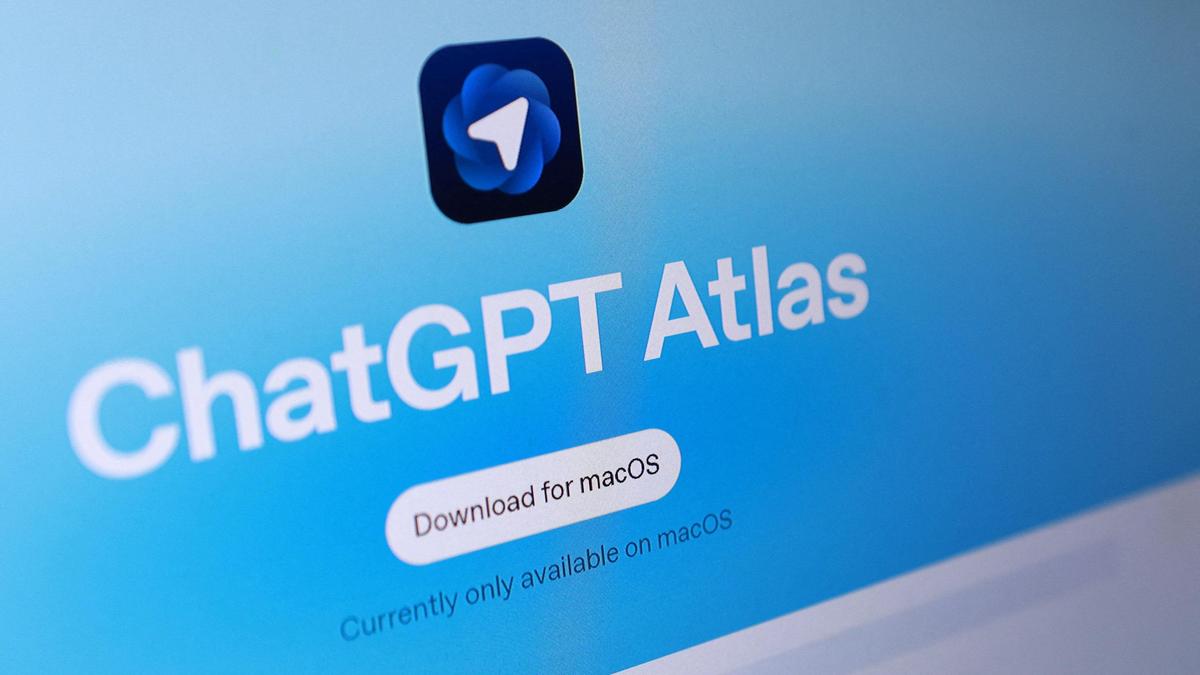
- 25 Oct 2025
In News:
OpenAI has unveiled ‘Atlas’, its new AI-powered web browser built around ChatGPT, marking a significant step in the evolving generative AI competition and posing a direct challenge to Google Chrome’s dominance. The move comes soon after Perplexity AI introduced its own AI-integrated browser, Comet, underscoring a major transformation in how users interact with the internet.
About Atlas
- Developer:OpenAI
- Nature: AI-integrated web browser built around ChatGPT
- Availability: Currently in preview mode for ChatGPT Plus, Pro, and Business users.
- Design: Atlas removes the traditional address bar, replacing it with a conversational AI interface.
- Key Feature – Agent Mode:
- Enables the browser to autonomously perform searches, analyze sources, and synthesize information into concise summaries.
- Allows users to ask questions in natural language instead of typing web addresses or search keywords.
The browser seamlessly combines web navigation and AI interaction, positioning itself as the next step in AI-mediated online browsing.
Why AI Companies Are Building Browsers
- Control Over User Interface and Data:Browsers act as the gateway to most online activities—search, shopping, finance, entertainment, and social media. Controlling this entry point enables AI companies to own user intent, data, and engagement patterns.
- Monetization Potential:Like Google’s ad-based model, AI browsers can monetize user activity and queries by integrating AI-generated recommendations and sponsored content.
- Integrated AI Experience:AI browsers embed conversational AI tools directly into familiar interfaces, bridging the gap between chatbots and traditional search engines.
- Strategic Advantage:By embedding AI assistants within browsers, companies like OpenAI and Perplexity can reduce dependence on traditional search engines (notably Google), reshaping the competitive dynamics of the internet ecosystem.
How AI Browsers Are Transforming Search
- Traditional Search Model:Relies on keyword-based queries returning multiple hyperlinks for users to navigate.
- AI-Powered Search Model (Atlas & Comet):
- Delivers direct, synthesized, and contextually relevant answers instead of a list of links.
- Suggests related prompts for deeper exploration and learning.
- Adapts to individual user preferences, creating personalized information journeys.
This shift reduces dependence on link-based navigation, potentially disrupting traditional search traffic and publisher visibility models.
Broader Implications
- For Users:
- Offers faster, personalized, and conversational search experiences.
- Transforms passive browsing into interactive discovery.
- For the Digital Ecosystem:
- Challenges Google’s dominance in search and browser markets.
- Raises new debates on data privacy, content attribution, and information accuracy.
- Could reshape digital advertising, as traffic shifts from web pages to AI-generated summaries.
- For the AI Industry:
- Signals a new phase of competition between leading AI firms like OpenAI, Google, and Perplexity.
- Marks a trend towards AI-integrated ecosystems where chatbots, browsers, and search engines converge.
Sevilla Forum on Debt
- 25 Oct 2025
In News:
At the 16th United Nations Conference on Trade and Development (UNCTAD16) held in Geneva, the Sevilla Forum on Debt was officially launched — marking a major international step towards tackling the global sovereign debt crisis and promoting fair, sustainable debt solutions for developing economies.
About the Sevilla Forum on Debt
- Launched by: The Government of Spain, with support from UNCTAD and the UN Department of Economic and Social Affairs (UN DESA).
- Event: Announced at UNCTAD16 (October 2025) in Geneva.
- Part of: The Sevilla Platform for Action, building upon commitments made during the Fourth International Conference on Financing for Development (FfD4).
Aim and Objectives
- To create an open, inclusive, and action-oriented space for dialogue on sovereign debt reform.
- To connect all stakeholders—creditors, borrowers, multilateral institutions, civil society, and academia—towards developing innovative, fair, and sustainable debt management frameworks.
- To track and implement the debt-related initiatives agreed upon in the Sevilla Commitment, ensuring political pledges are translated into institutional mechanisms.
Context: The Global Debt Challenge
- Public debt worldwide reached $102 trillion in 2024, with developing countries accounting for $31 trillion of that burden.
- Developing nations paid around $921 billion in interest payments — surpassing their combined public spending on health and education.
- According to UNCTAD, over 3.4 billion people now live in countries where debt servicing outweighs essential social expenditure, underscoring the need for systemic reform of the global debt architecture.
Key Features of the Sevilla Forum
- Bridge Between Borrowers and Creditors:
- Acts as a neutral hub facilitating candid discussions between debtor nations and lenders.
- Encourages transparency, responsible borrowing, and fair lending practices.
- Catalyst for Global Action:
- Sustains political attention on debt-related agreements under the Sevilla Commitment.
- Supports coordinated multilateral action to ensure predictable and equitable debt governance.
- Knowledge Exchange Platform:Brings together policymakers, economists, and institutions to develop and share innovative debt management solutions, including debt-for-climate and debt-for-development swaps.
- Linked Initiatives by Spain:
- Debt Pause Clause Alliance: Promotes temporary suspension of debt payments for nations in crisis.
- Global Hub for Debt Swaps: Facilitates conversion of debt obligations into sustainable development investments.
Significance
- For Developing Countries: Offers a collective voice and platform to advocate for debt justice and reform of the global financial architecture.
- For Global Governance: Reinforces multilateralism through UN-led cooperation between creditors and borrowers.
- For Sustainable Development: Aligns with Agenda 2030 by linking debt relief with social and climate investments, particularly SDG 8 (Decent Work & Economic Growth) and SDG 17 (Partnerships for the Goals).
About UNCTAD
- Full Form: United Nations Conference on Trade and Development
- Established: 1964 by the UN General Assembly
- Headquarters: Geneva, Switzerland
- Mandate: To help developing countries leverage trade, finance, and technology for inclusive and sustainable development.
- Core Functions:
- Economic and trade analysis
- Consensus-building among nations
- Technical assistance for policy and institutional strengthening
- Major Reports:
- Trade and Development Report
- World Investment Report
- The Least Developed Countries Report
Intrusion Detection System
- 25 Oct 2025
In News:
The Northeast Frontier Railway (NFR) has successfully completed trial works of the Intrusion Detection System (IDS) across four key railway sections in Assam and West Bengal to prevent elephant fatalities due to train collisions.
About the Intrusion Detection System (IDS)
The Intrusion Detection System (IDS) is a cutting-edge initiative of the Northeast Frontier Railway (NFR) under the Ministry of Railways, aimed at protecting wildlife—particularly elephants—while ensuring smooth and efficient railway operations through forested and ecologically sensitive zones.
Objective
- To minimize elephant deaths caused by train collisions along railway lines intersecting elephant corridors.
- To balance operational efficiency with ecological conservation, aligning with India’s broader goals of sustainable infrastructure and biodiversity protection.
Technology and Working
- Technology Used: IDS employsadvanced optical fibre sensing technology installed parallel to railway tracks at a distance of around 10 metres.
- Functioning:
- The system detects vibrations generated by elephant movement near railway tracks.
- These vibrations are captured by sensor cables, which relay the data to a central control room.
- The system then generates real-time alerts for train drivers and control rooms, enabling them to take immediate preventive actions, such as slowing down or halting trains.
This real-time detection mechanism ensures timely intervention and minimizes human-wildlife conflict along railway routes.
Implementation by NFR
The Intrusion Detection System has been successfully implemented in the following pilot sections:
- Madarihat–Nagrakata section (Alipurduar Division)
- Habaipur–Lamsakhang–Patharkhola–Lumding section (Lumding Division)
- Kamakhya–Azara–Mirza section (Rangiya Division)
- Titabar–Mariani–Nakachari section (Tinsukia Division)
- Coverage:The pilot installations collectively span 64.03 km of elephant corridors and 141 km of block sections, marking a significant step in NFR’s ongoing wildlife protection efforts.
Significance
- Wildlife Protection: Helps prevent accidental elephant deaths, promoting coexistence between rail infrastructure and biodiversity.
- Operational Efficiency: Enhances train safety by providing advance alerts, reducing service disruptions.
- Technological Advancement: Demonstrates the integration of AI and fibre-optic sensing in railway operations.
- Environmental Responsibility: Reflects the government’s commitment to sustainable development goals (SDGs), particularly those related to life on land (SDG-15) and industry, innovation and infrastructure (SDG-9).
Hyunmoo-5 Missile
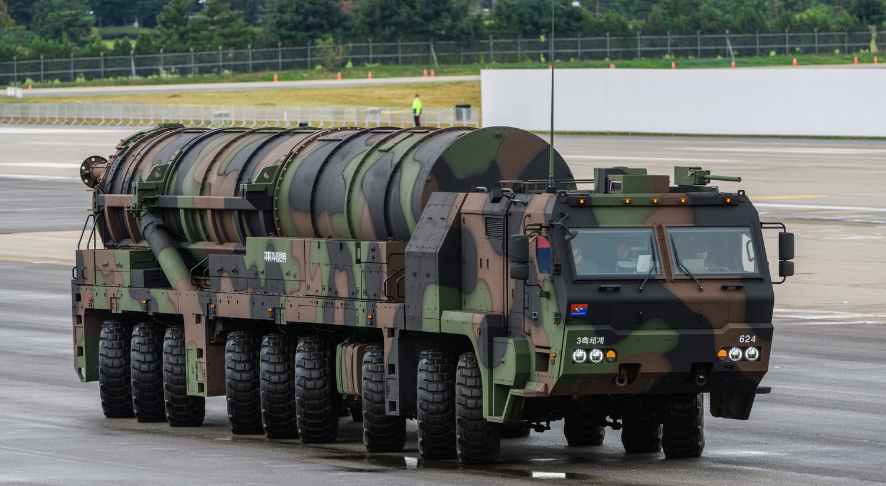
- 25 Oct 2025
In News:
South Korea is set to deploy its most powerful conventional ballistic missile, the Hyunmoo-5, by the end of this year. The move signifies a major step in Seoul’s efforts to enhance its deterrence capabilities amid escalating tensions with nuclear-armed North Korea.
Background and Development
- The Hyunmoo missile series forms the backbone of South Korea’s indigenous missile program, designed for strategic self-reliance under the constraints of the Nuclear Non-Proliferation Treaty (NPT).
- The concept of Hyunmoo-5 emerged after North Korea’s series of provocations in the early 2010s, including deadly border attacks. However, progress was limited by a bilateral missile agreement with the United States, which imposed payload and range restrictions to maintain stability on the Korean Peninsula.
- In 2017, following North Korea’s hydrogen bomb test, the Trump administration lifted these restrictions, enabling South Korea to pursue the development of high-payload, long-range conventional missiles such as Hyunmoo-5.
Technical Features of Hyunmoo-5
- Type: Ground-to-ground ballistic missile
- Weight: Approximately 36 tonnes
- Length: Around 16 metres
- Warhead Capacity: Can carry up to 8 tonnes of conventional explosive payload, including bunker-buster warheads capable of penetrating underground fortifications.
- Range: Estimated between 600 km and 5,000 km, depending on payload configuration.
- Purpose: Designed to neutralize hardened and deeply buried North Korean missile silos, command centres, and nuclear facilities.
Because South Korea does not possess nuclear weapons, the Hyunmoo-5 represents an attempt to achieve a “conventional balance of terror”—a deterrent parity based on precision and power rather than nuclear arms.
Ningol Chakouba Festival

- 24 Oct 2025
In News:
- Manipur recently celebrated the Ningol Chakouba Festival, a unique cultural tradition that reinforces the bond of love between married women and their paternal families.
- As part of the annual celebrations, the Department of Fisheries, Manipur organized the Annual Fish Fair-cum-Fish Crop Competition at Hapta Kangjeibung in Imphal, a day before the festival.
- The event aims to make fish available to the public at affordable prices, as fish curry is an essential part of the festive feast.
About Ningol Chakouba Festival
- Meaning:
- Ningol – married woman (sister or daughter)
- Chakouba – feast or communal meal
Thus, Ningol Chakouba translates to “feast of married women”.
- When Celebrated:Observed annually on the second day of Hiyangei month (October–November) of the Meitei lunar calendar.
- Main Ritual:Married women and their children visit their maternal homes for a grand feast and reunion with their brothers and parents.
- The sons of the family formally invite their married sisters about a week in advance.
- Women arrive in traditional attire, bringing fruits, vegetables, and local delicacies as offerings.
- After a shared meal, brothers present gifts to their sisters as a token of love and respect.
Cultural Essence and Significance
- The festival serves as a symbol of familial unity, respect for women, and continuity of social ties even after marriage.
- It highlights the importance of kinship in Manipuri society and reinforces the bond between daughters and their parental homes.
- Beyond Manipur, the festival is now celebrated by Manipuri communities across India and abroad, preserving cultural identity among the diaspora.
Historical Background
- Origin: Traced back to the reign of King Nongda Lairen Pakhangba, one of Manipur’s earliest rulers.
- At that time, Queen Laisana used to invite her brother Poireiton to the royal palace annually for a feast—originally called “Piba Chakouba” (Piba meaning brother/son).
- Transformation:
The tradition evolved during the reign of King Chandrakirti Singh (1831–1886), who invited his sisters instead of brothers due to logistical challenges in visiting them.- Since then, the celebration became known as “Ningol Chakouba”, centered on the affection between sisters and brothers.
Associated Event: Fish Fair-cum-Fish Crop Competition
- Organized by the Department of Fisheries, Government of Manipur, every year a day before Ningol Chakouba.
- Purpose:
- Ensure easy availability of fresh fish at affordable prices for the festival.
- Promote local fish farmers and aquaculture in the state.
- Venue: Hapta Kangjeibung, Imphal.
- Cultural Link: Fish dishes, especially fish curry, are a mandatory part of the feast, symbolizing prosperity and togetherness.
Storm Shadow Missile

- 24 Oct 2025
In News:
- Ukraine has reportedly carried out a long-range missile strike on a Russian chemical plant in Bryansk using UK-made Storm Shadow cruise missiles, marking one of the most significant deep-penetration attacks into Russian territory since the beginning of the war.
- The strike, which reportedly bypassed Moscow’s air defence systems, triggered retaliatory drone and missile attacks by Russia on Ukrainian cities, including Kyiv and Dnipropetrovsk, leading to civilian casualties and power outages.
- The episode underscores the escalation in the Ukraine–Russia conflict and highlights the growing strategic role of Western-supplied precision weaponry in modern warfare.
About the Storm Shadow Missile
- Type: Long-range, air-launched stealth cruise missile
- Developed by:United Kingdom and France (known as SCALP EG in France)
- Manufacturer:MBDA Systems
- Operational Since: Early 2000s
- Primary Role: Designed to destroy high-value, well-protected targets such as:
- Airbases
- Radar installations
- Command and control centres
- Port and fuel storage facilities
The missile’s combination of low observability, precision guidance, and deep-penetration warhead makes it one of the most advanced conventional strike weapons in the world.
Technical Specifications and Features
|
Feature |
Details |
|
Length |
~5.1 metres |
|
Wingspan |
~3 metres |
|
Weight |
~1,300 kg |
|
Warhead |
450 kg BROACH (Bomb Royal Ordnance Augmented Charge) — capable of penetrating hardened bunkers |
|
Propulsion |
Turbojet engine |
|
Speed |
Subsonic (~Mach 0.8) |
|
Range |
Over 550 km |
|
Guidance System |
Combination of GPS, Inertial Navigation (INS), Terrain-following radar, and infrared terminal seeker for pinpoint accuracy |
|
Flight Profile |
Low-altitude, terrain-hugging trajectory to evade radar detection |
Stealth and Precision Capabilities
- Designed for “fire and forget” operations, requiring minimal pilot input after launch.
- Terrain-following capability allows the missile to fly under radar coverage, reducing detection probability.
- The infrared imaging seeker enables precise terminal guidance even in adverse weather conditions.
- Known for its “deep-strike capability”, allowing it to destroy hardened and strategic installations from a safe stand-off distance.
Global Operators
The Storm Shadow/SCALP EG is in service with several countries, including:United Kingdom, France, Italy, Greece, Egypt, Saudi Arabia, Qatar, United Arab Emirates and India – where it is integrated with the Rafale fighter jets operated by the Indian Air Force (IAF), enhancing India’s precision-strike capabilities.
Central Asian Mammals Initiative
- 24 Oct 2025
In News:
- Representatives from several Central Asian countries — including India — have endorsed a six-year work programme (2021–2026) under the Central Asian Mammals Initiative (CAMI) to identify and conserve priority transboundary regions crucial for the survival of 17 iconic mammal species across the region.
- The meeting was hosted by Uzbekistan, under its presidency of the 14th Conference of the Parties (COP14) to the Convention on the Conservation of Migratory Species of Wild Animals (CMS).
About the Central Asian Mammals Initiative (CAMI)
- Launched: 2014, during CMS COP11 (Quito, Ecuador).
- Objective: To halt and reverse the population decline of migratory mammals across 14 Central Asian countries, through coordinated conservation action.
- Framework: Provides a regional platform for cooperation among Range States to address shared threats such as habitat loss, poaching, migration barriers, and climate change.
Key Features
- Species Covered (17 total):Argali sheep, Asiatic cheetah, Asiatic wild ass, Bukhara deer, Eurasian lynx, Gobi bear, Goitered gazelle, Kiang, Mongolian gazelle, Pallas’s cat, Persian leopard, Przewalski’s horse, Saiga antelope, Snow leopard, Urial, Wild camel, and Wild yak.
- Range States Involved:Bhutan, China, India, Kazakhstan, Kyrgyzstan, Mongolia, Nepal, Pakistan, Tajikistan, Turkmenistan, and Uzbekistan; with Iran and the Russian Federation participating online.
- Collaborating Organizations: Over 15 conservation institutions, including IUCN, government agencies, and NGOs, are supporting the work programme’s implementation.
- Current Programme of Work: Adopted for 2021–2026, focuses on ecosystem-based conservation, improved connectivity, and data-sharing between range states.
Recent Meeting Outcomes
- Countries reaffirmed commitment to joint action for migratory mammal conservation, emphasizing that species conservation transcends national borders.
- Success stories shared included recovery trends in Saiga antelope, Bukhara deer, and Persian leopard populations.
- Delegates discussed persistent challenges such as fragmented habitats, climate change impacts, illegal hunting, and limited cross-border coordination.
- Uzbekistan’s Minister of Ecology Aziz Abdukhakimov highlighted the importance of a unified regional approach, stating that “these species know no borders, and neither should our conservation efforts.”
About the Convention on the Conservation of Migratory Species (CMS)
- Also known as: Bonn Convention.
- Established: 1979 in Bonn, Germany.
- Under the Aegis of: United Nations Environment Programme (UNEP).
- Mandate: To promote the conservation and sustainable use of migratory animals and their habitats worldwide.
- Nature: The only global and UN-based intergovernmental treaty exclusively focused on migratory species conservation.
- Instruments:
- Legally binding Agreements
- Non-binding Memoranda of Understanding (MoUs)
- Decision-making Body:Conference of the Parties (COP).
- Next Milestone:CMS COP15 will be held in Brazil (March 23–29, 2026), where the CAMI resolution will be reviewed and updated.
Sabarimala Temple
- 24 Oct 2025
In News:
President Droupadi Murmu recently made a historic visit to the Sabarimala Sree Dharma Sastha Temple in Kerala, becoming the first woman head of state to offer prayers at the sacred hill shrine dedicated to Lord Ayyappa.
She is only the second President of India to visit the temple, after V. V. Giri in the 1970s. The visit holds deep symbolic and constitutional significance, coming in the backdrop of the 2018 Supreme Court judgment on women’s entry to the shrine.
About Sabarimala Temple
- Location: Situated in the Western Ghats, Pathanamthitta District, Kerala.
- Deity: Dedicated to Lord Ayyappa (also known as Dharma Shasta), the son of Lord Shiva and Mohini (the female incarnation of Vishnu).
- Altitude: Located atop a hill at 4,134 ft above sea level, surrounded by dense forests forming part of the Periyar Tiger Reserve.
- Access: Pilgrims undertake a challenging trek through forests and hills to reach the sanctum.
- Pilgrimage: Open to devotees mainly during the Mandalam-Makaravilakku season (November–January).
- Scale: Among the largest annual pilgrimages in the world, attracting 40–50 million devotees annually.
Rituals and Traditions
- Vratham (Austerity): Pilgrims observe a 41-day penance before visiting the shrine, maintaining celibacy, vegetarianism, and spiritual discipline.
- Inclusivity: Sabarimala is one of the few Hindu temples that welcomes devotees of all faiths.
- Religious Harmony: Near the temple lies Vavaru Nada, dedicated to Vavar, a Muslim saint believed to be Lord Ayyappa’s companion—symbolizing interfaith harmony.
Architecture
- The temple blends traditional Kerala and Dravidian architectural styles.
- Built on a 40-foot-high plateau, it features:
- A sanctum sanctorum (Sreekovil) with a copper-plated roof and four golden finials (kalasams).
- Two mandapams (halls) for rituals and gatherings.
- A flagstaff symbolizing devotion.
- The iconic 18 sacred steps (Pathinettam Padi), each representing a spiritual or philosophical stage to liberation.
Sabarimala Case: The Women’s Entry Controversy
- Traditional Practice: Women of menstruating age (10–50 years) were historically barred from entering the temple, as the deity is considered a Naishtika Brahmachari (eternal celibate).
- Judicial Intervention:
- In 2018, the Supreme Court of India (in Indian Young Lawyers Association v. State of Kerala) declared the ban unconstitutional, citing gender equality and freedom of religion under Articles14, 15, 25, and 26 of the Constitution.
- The verdict led to widespread protests across Kerala.
- The issue remains under review by a larger constitutional bench, reflecting the ongoing debate between faith and fundamental rights.
Skilling for AI Readiness (SOAR) Programme
- 23 Oct 2025
In News:
India has launched the Skilling for AI Readiness (SOAR) programme to prepare a new generation equipped with artificial intelligence (AI) skills, aligning education and skilling systems with the demands of a rapidly digitalising global economy. The initiative reflects the government’s commitment to fostering an AI-driven workforce, supporting the vision of “Viksit Bharat @2047.”
About the SOAR Programme
- The Skilling for AI Readiness (SOAR) programme was launched in July 2025 by the Ministry of Skill Development and Entrepreneurship (MSDE) as part of the Skill India Mission’s 10-year milestone.
- It aims to integrate artificial intelligence learning into school education and teacher training, enabling India’s youth to adapt to the future of work shaped by automation, data science, and emerging technologies.
- SOAR aligns with the objectives of the National Education Policy (NEP) 2020, which emphasises digital literacy and inclusion of emerging technologies like AI in school curricula.
Objectives
- AI Literacy: To introduce students to foundational concepts of artificial intelligence, machine learning, and data ethics.
- Capacity Building: To equip educators with the skills to integrate AI modules effectively into classroom teaching.
- Future Workforce Readiness: To develop AI competencies that align with industry demand and global technological trends.
- Promoting Atmanirbhar Bharat: To support economic self-reliance by preparing youth for jobs and entrepreneurship in AI-driven sectors.
Key Features of SOAR
- Targets school students (Classes 6–12) and educators across India.
- Offers three 15-hour modules for students and a 45-hour module for teachers, focusing on:
- Fundamentals of AI and machine learning
- Data literacy and responsible AI use
- Ethical, inclusive, and sustainable AI practices
- The Union Budget 2025–26 has allocated ?500 crore to establish a Centre of Excellence in Artificial Intelligence for Education, which will:
- Develop AI-based learning tools and multilingual AI resources in Indian languages.
- Promote AI curriculum design and teacher capacity building.
- Foster innovation in classrooms and strengthen AI integration across schools and technical institutions.
- As of June 2025, over 1,480 apprentices have been trained in AI-related roles such as AI Data Engineer and Machine Learning Engineer under the National Apprenticeship Promotion Scheme (NAPS-2).
Integration with Skill India Mission
The SOAR initiative is an extension of the Skill India Mission (SIM) and complements schemes like:
- Pradhan Mantri Kaushal Vikas Yojana (PMKVY) 4.0, which focuses on skilling for futuristic domains such as AI, robotics, and data analytics.
- National Apprenticeship Promotion Scheme (NAPS-2), supporting apprenticeship opportunities in emerging tech roles.
- Skill India Digital Hub (SIDH), providing online AI learning resources and digital inclusion for rural learners.
- National Skill Training Institutes (NSTIs) and Industrial Training Institutes (ITIs), which are incorporating AI-related modules for vocational training.
AI and Education Reform
Artificial Intelligence is reshaping India’s education system in line with NEP 2020 recommendations:
- The Central Board of Secondary Education (CBSE) introduced AI as a subject for Class IX in 2019–20 and extended it to Class XI in 2020–21.
- The Centre of Excellence for AI in Education will promote advanced learning tools, digital assessment systems, and “chalkboards to chipsets” transformation in classrooms.
- The All India Council for Technical Education (AICTE) and Indian Institutes of Technology (IITs) are already offering specialised courses in Machine Learning, Deep Learning, and Predictive Analytics, strengthening the higher education pipeline for AI careers.
Strategic Importance and Expected Outcomes
- Strengthens Skill India Mission: Creates a structured AI learning ecosystem for school and vocational education.
- Bridges Digital Divide: Extends AI training to rural and government schools through digital platforms, promoting inclusivity.
- Empowers Educators: Builds AI literacy among teachers to ensure effective curriculum delivery.
- Drives Economic Growth: Develops a skilled workforce ready for AI-driven sectors like healthcare, manufacturing, education, and finance.
- Enhances Global Competitiveness: Positions India as a hub for AI innovation and responsible AI deployment.
Doctrine of Lis Pendens

- 23 Oct 2025
In News:
The Delhi High Court has recently ruled that courts possess the discretion to exempt a property from the application of the doctrine of lis pendens under certain circumstances. The decision aims to protect genuine property owners from vexatious or frivolous litigation that seeks to unjustly restrict the transfer or enjoyment of property rights.
About the Doctrine of Lis Pendens
- The term Lis Pendens is derived from Latin, meaning “pending litigation.”
- In India, the doctrine is codified under Section 52 of the Transfer of Property Act (TPA), 1882.
- The principle holds that any transfer of immovable property during the pendency of a legal dispute concerning that property will be subject to the outcome of the litigation.
- The doctrine does not invalidate the transfer but makes it subordinate to the result of the pending case.
- Its primary objective is to prevent one party from defeating the rights of another through the transfer of the disputed property while the court proceedings are ongoing.
Essence and Legal Rationale
- The doctrine seeks to maintain the status quo of property ownership during litigation, ensuring that the final judgment of a competent court remains effective despite any transactions made during the pendency of the case.
- It prevents the multiplicity of proceedings and protects the interests of the rightful claimant, as the transferee of such property is bound by the court’s decree.
Key Conditions for Applicability
- A suit or proceeding must be pending before a court of competent jurisdiction.
- The dispute must directly relate to the title or rights of an immovable property.
- The property must be specifically identifiable and properly described in the suit.
- The transfer of the property must occur during the pendency of the litigation.
- The suit must be bona fide, i.e., not collusive or fraudulent in nature.
If these conditions are met, any transfer made during the lawsuit will not override the court’s final decision.
Non-Applicability of the Doctrine
The doctrine does not apply in certain cases, including:
- When the mortgagor transfers property under a power explicitly granted in the mortgage deed.
- When the transfer affects only the transferor’s interest and not the other party’s rights.
- In collusive suits—where the proceedings are staged to defraud others.
- When the property is not properly described, making its identification impossible.
- Where the right to the property is not directly in dispute and alienation has been permitted.
Recent Delhi High Court Ruling
- A Division Bench of the Delhi High Court, led by Justice Anil Kshetarpal, clarified that the doctrine of lis pendens is not absolute and can be relaxed by judicial discretion.
- The Court held that in cases where litigation is filed with mala fide intent or used as a tool to harass legitimate owners, the court may exempt the concerned property from the operation of the doctrine to protect bona fide ownership and prevent misuse of legal processes.
- This interpretation strengthens the judiciary’s power to distinguish genuine disputes from vexatious claims, thereby ensuring fairness and efficiency in property litigation.
Significance of the Judgment
- Protects Genuine Owners: Shields rightful property holders from baseless legal actions aimed at stalling legitimate transactions.
- Prevents Misuse of Law: Discourages abuse of the doctrine for fraudulent or extortionate purposes.
- Balances Rights and Justice: Ensures that while the doctrine maintains judicial control over disputed properties, it does not become a weapon against bona fide parties.
- Clarifies Judicial Discretion: Affirms that courts have the inherent authority to exclude specific cases from the doctrine’s ambit when equity demands.
Tetrataeniummanilalianum
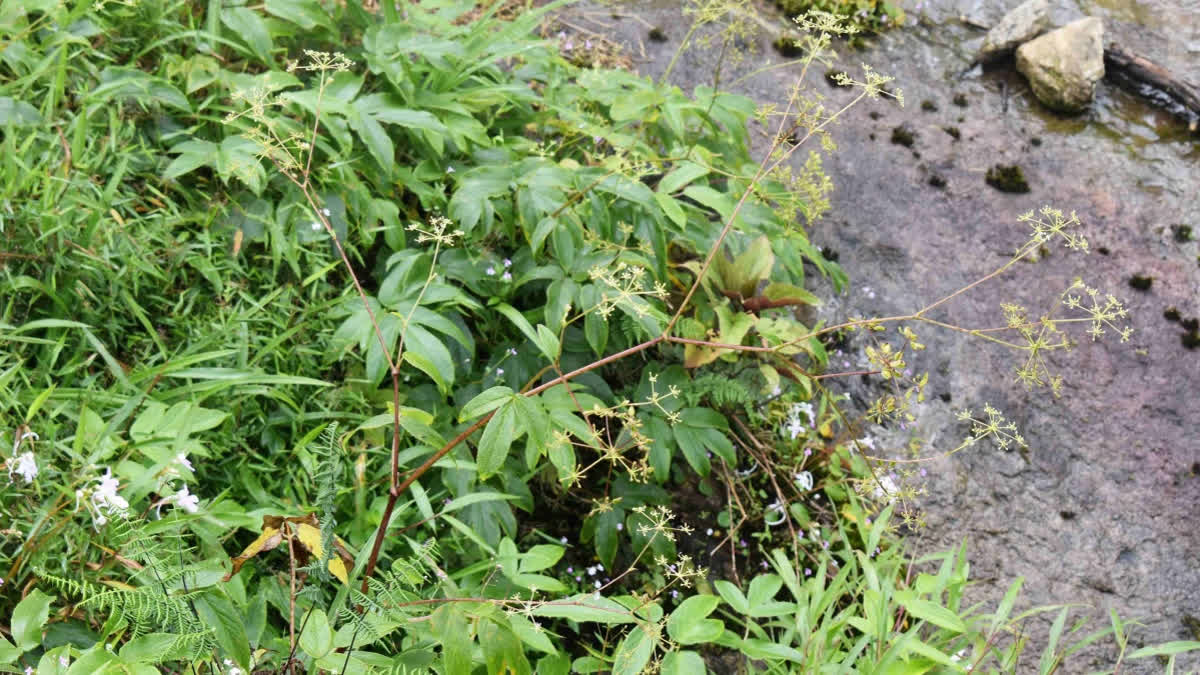
- 23 Oct 2025
In News:
Researchers have recently discovered a new plant species named Tetrataeniummanilalianum in the Eravikulam National Park, Kerala, adding to the extraordinary biodiversity of the Western Ghats, one of the eight “hottest biodiversity hotspots” in the world. The finding has been published in the Nordic Journal of Botany (Sweden), underscoring India’s growing contributions to global botanical research.
About Tetrataeniummanilalianum
- The newly identified plant belongs to the carrot family (Apiaceae/Umbelliferae), which also includes species such as carrot, coriander, cumin, fennel, and ajwain.
- It was discovered in the high-altitude grasslands bordering the shola forests of the Eravikulam National Park in Idukki district, Kerala.
- The plant bears white flowers and possesses underground rhizomes. It sprouts and blooms only during the monsoon season, adapting to the region’s moist climatic conditions.
- This discovery marks the 48th identified species within the Tetrataenium genus and is the first of its kind recorded globally.
- The species has been named in honour of Prof. K.S. Manilal, a distinguished botanist, founder president of the Indian Association for Angiosperm Taxonomy (IAAT), and former Head of the Department of Botany at the University of Calicut.=
Ecological Context – Eravikulam National Park
- Location: Situated in the Idukki district of Kerala, the park spans 97 sq. km along the summit of the Western Ghats.
- Topography: Encompasses rolling grasslands interspersed with shola forests in the upper valleys.
- Climate: Receives heavy rainfall during both the southwest (June–July) and northeast (October–November) monsoons, making it one of the wettest regions in the world.
- Flora: Rich in endemic species such as Actinodaphnebourdilloni, Microtropisramiflora, Pittosporum tetraspermium, and the once-thought-extinct orchid Brachycorythiswightii.
- Fauna: Home to the endangered NilgiriTahr, with nearly half the world’s population residing here. Other species include the Gaur, Sloth Bear, Nilgiri Langur, Tiger, Leopard, Giant Squirrel, and Wild Dog.
- The park also hosts the Anamudi Peak (2,695 m), the highest mountain in South India, and is famous for the Neelakurinji flowers that bloom once every twelve years.
Authorized Economic Operator (AEO) Programme

- 23 Oct 2025
In News:
- The World Trade Organization (WTO) has commended India’s liberalisedAuthorised Economic Operator (AEO) Programme for significantly enhancing the participation of micro, small, and medium enterprises (MSMEs) in global trade and for improving customs facilitation measures.
- The initiative, implemented by the Central Board of Indirect Taxes and Customs (CBIC), is increasingly being seen as a model for balancing trade facilitation with supply chain security.
About the AEO Programme
- Origin:The AEO Programme operates under the World Customs Organization’s (WCO) SAFE Framework of Standards to Secure and Facilitate Global Trade (SAFE FoS), adopted in June 2005 to strengthen global supply chain security.AEO constitutes one of the three key pillars of this framework.
- Implementation in India:
- Introduced by CBIC as a pilot project in 2011 and revamped through Circular No. 33/2016-Customs (July 22, 2016).
- Managed by the Directorate of International Customs (CBIC).
- Aligns with Article 7.7 of the WTO Trade Facilitation Agreement (TFA), which promotes the recognition of “trusted traders.”
Objectives
- To enhance international supply chain security and ease of doing business.
- To foster trusted partnerships between Customs and compliant business entities.
- To reduce transaction costs and clearance times for legitimate traders.
- To increase MSME participation in international trade through simplified customs procedures.
Key Features
- Voluntary and Trust-Based:AEO is a voluntary compliance programme that certifies entities—such as importers, exporters, logistics providers, customs brokers, custodians, and warehouse operators—who meet security and legal standards.
- Three-Tier Certification:
- AEO-T1, AEO-T2, and AEO-T3 for importers/exporters (in ascending order of benefits).
- AEO-LO for logistics operators, custodians, and other intermediaries.
- Simplified Customs Procedures:
- Reduced documentation requirements.
- Decentralised approvals at the Customs Zonal level.
- Segmented risk management—allowing Customs to focus on higher-risk consignments.
- Global Integration:
- Mutual Recognition Arrangements (MRAs) with countries such as South Korea and Hong Kong.
- Negotiations underway with the USA, UAE, and Taiwan for reciprocal recognition.
- Ensures international credibility and cross-border facilitation for Indian traders.
- Targeted Expansion:The CBIC aims to accredit over 3,500 AEO-certified entities across India to build a more secure and efficient trade environment.
Benefits to Traders
|
Benefit |
Description |
|
Faster Customs Clearance |
Direct Port Delivery/Entry for AEO-certified cargo |
|
Deferred Duty Payment |
Flexibility in duty payments for AEO-T2 and T3 holders |
|
Reduced Inspections |
Lower frequency of physical and documentary checks |
|
Self-Declaration for SION |
Simplified export-import documentation |
|
Priority Processing |
Expedited refunds, grievance redressal, and port clearances |
|
Global Recognition |
Reciprocal benefits under MRAs with partner countries |
|
Financial Efficiency |
Time and cost savings for compliant MSMEs |
Significance for India
- Supports MSMEs: Encourages smaller exporters and manufacturers to integrate with global value chains.
- Trade Facilitation: Reduces bureaucratic delays and improves India’s ranking in Ease of Doing Business and Logistics Performance Index.
- Customs Efficiency: Allows authorities to focus resources on non-compliant and high-risk traders.
- Global Credibility: Strengthens India’s image as a trusted trading partner under the WCO framework.
- Policy Alignment: Advances India’s commitments under the WTO Trade Facilitation Agreement.
Sinapic Acid

- 23 Oct 2025
In News:
Researchers from Nagaland University have identified Sinapic acid, a naturally occurring plant compound, as a potential therapeutic agent for accelerating wound healing in diabetic patients. The study — the first globally to demonstrate its oral efficacy — has been published in Nature Scientific Reports (Springer Nature).
About Sinapic Acid
- Chemical Nature:Sinapic acid is a natural phenolic acid and a derivative of cinnamic acid.
- Occurrence:Found widely in spices, citrus and berry fruits, vegetables, cereals, and oilseed crops.
- Properties:Possesses antioxidant, anti-inflammatory, antitumor, antibacterial, and neuroprotective activities.
- Mechanism of Action:The compound promotes wound repair by activating the SIRT1 pathway, which regulates tissue regeneration, angiogenesis, and inflammation control.
Key Research Findings
- First-of-its-kind Study:Demonstrated that oral administration of Sinapic acid accelerates wound healing in preclinical diabetic models.
- Optimal Dosage:The study observed an “inverted dose–response” — a lower dose (20 mg/kg) proved more effective than a higher one (40 mg/kg).
- Clinical Significance:
- Accelerates recovery from diabetic foot ulcers
- Reduces the risk of infection and amputation
- Offers a safe, plant-based, and affordable alternative to synthetic drugs
- Could enhance healthcare accessibility, especially in rural and resource-limited regions
About Diabetes Mellitus
- A metabolic disorder characterized by chronically elevated blood glucose levels.
- One of the world’s leading chronic diseases, affecting hundreds of millions globally.
- Complications:Include delayed wound healing, neuropathy, poor blood circulation, and diabetic foot ulcers, often resulting in amputation if untreated.
Significance of the Discovery
- Represents an indigenous scientific advancement with global healthcare potential.
- Supports the Make-in-India and One Health approach by integrating biotechnology and natural product research for sustainable medical solutions.
- Marks a major milestone in developing natural, safe, and cost-effective treatments for diabetic wound management.
Carabid Beetle
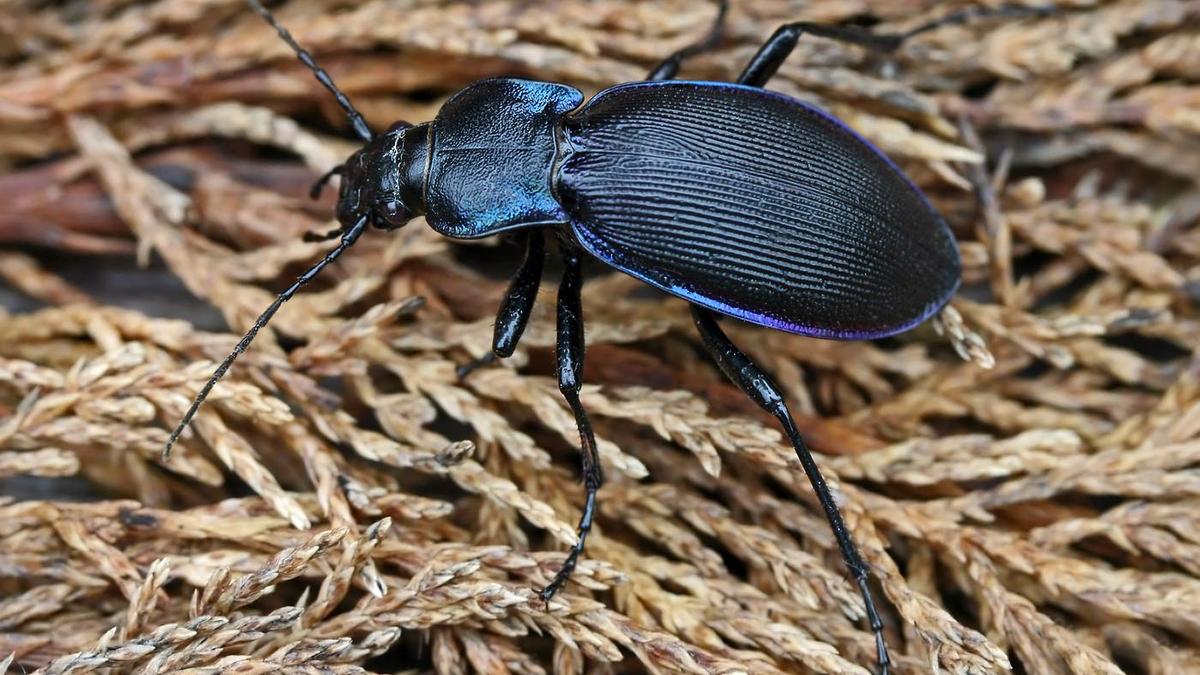
- 22 Oct 2025
In News:
- Recent research has identified Carabid ground beetles (family: Carabidae) as potential bioindicators for tracking microplastic contamination in soil ecosystems.
- Given the increasing global concern over microplastic pollution, especially in terrestrial environments, this finding highlights the ecological significance of these beetles in environmental monitoring and sustainable agriculture.
About Carabid Beetles
- Taxonomy: Belong to the family Carabidae, a large and diverse group of insects commonly known as ground beetles.
- Distribution: Found globally across a range of habitats — from forests, grasslands, and wetlands to agricultural fields and urban landscapes.
- Adaptability: Thrive in temperate and tropical climates, indicating high ecological resilience.
Physical and Biological Features
- Appearance:Typically, dark, shiny, and robust-bodied insects with long legs and strong mandibles, enabling them to be agile hunters.
- Defence Mechanism: When threatened, they emit a pungent odour to deter predators.
- Diet: Predatory in nature; they feed on pests such as caterpillars, slugs, snails, and other small invertebrates, making them beneficial for biological pest control.
- Life Cycle: Undergo complete metamorphosis — progressing through four stages: egg, larva, pupa, and adult.
- Reproduction:Typically,sexual with internal fertilization.
Ecological Role and Importance
- Natural Pest Regulators: Their predatory behavior helps control pest populations, reducing dependence on chemical pesticides in agriculture.
- Key Role in Soil Ecology:
- Contribute to nutrient cycling by preying on decomposers and pest species.
- Influence soil food web structure, functioning both as predators and prey for higher trophic levels.
- Indicator Species: Their abundance and diversity reflect the overall health and fertility of soil ecosystems.
- Bioindicator Concept:Bioindicators are species or groups whose presence, absence, or physiological condition reflects the quality of the environment and ecological changes.
- In Agriculture:In India and other agrarian regions, farmers have traditionally used bioindicators—such as insects, birds, and soil invertebrates—to predict rainfall, assess soil fertility, and evaluate pest management success.
- Microplastic Tracking Role:
- Researchers have found that Carabid beetles accumulate microplastic particles in their bodies, particularly within their digestive tracts, after feeding in contaminated soil.
- Their wide distribution and soil-dwelling nature make them ideal sentinels for studying microplastic pollution in terrestrial habitats.
- By analysing beetle tissues and microplastic residues, scientists can map the extent and distribution of soil microplastics with greater accuracy.
Why Carabid Beetles Are Effective Bioindicators
- Widespread Occurrence: Present in nearly all terrestrial ecosystems, ensuring broad geographic monitoring coverage.
- Ecological Sensitivity: Rapidly respond to changes in soil composition, contamination, and habitat quality.
- Trophic Position: As mid-level predators, they integrate pollutants and environmental stresses from lower trophic levels.
- Ease of Sampling: Readily captured and monitored through standard ecological methods like pitfall traps.
- Non-destructive Monitoring: Studying beetle populations allows long-term soil health assessments without altering ecosystems.
Impact of a Coronal Mass Ejection on the Lunar Exosphere
- 22 Oct 2025
In News:
- In a landmark discovery, the Indian Space Research Organisation (ISRO) announced that Chandrayaan-2’s orbiter has, for the first time, recorded the impact of a Coronal Mass Ejection (CME) from the Sun on theMoon’s exosphere — the thin, outermost layer of its atmosphere.
- The finding, made using the CHACE-2 (Chandra’s Atmospheric Composition Explorer-2) payload, marks a significant step in understanding how solar activity influences airless celestial bodies like the Moon.
About the Observation
- The CHACE-2 instrument, aboard Chandrayaan-2’s orbiter, detected a sharp rise in total pressure and molecular density in the Moon’s sunlit exosphere during a CME event on 10 May 2024.
- This observation confirmed, for the first time, theoretical predictions about how high-energy solar emissions affect the Moon’s extremely tenuous atmosphere.
- The findings were published in the journal Geophysical Research Letters (August 2025) under the title “Impact of a Coronal Mass Ejection on the Lunar Exosphere as Observed by CHACE-2 on the Chandrayaan-2 Orbiter.”
Understanding Coronal Mass Ejections (CMEs)
- CMEs are massive bursts of charged particles — primarily ionized hydrogen and helium — ejected from the Sun’s corona.
- When directed toward planetary bodies, these particles can interact with their atmospheres or surfaces, causing chemical and physical changes.
- On Earth, CMEs are often linked with geomagnetic storms and auroras, but their influence on airless bodies like the Moon had remained largely unobserved until this study.
The Lunar Exosphere: Nature and Composition
- The Moon’s atmosphere is so thin that it is classified as an exosphere — a region where individual gas atoms and molecules rarely collide.
- The boundary of the lunar exosphere directly touches the Moon’s surface, making it a “surface-boundary exosphere.”
- It is primarily composed of trace elements such as helium, argon, sodium, and potassium, released through processes like:
- Solar wind interactions (bombardment by charged particles),
- Photon-stimulated desorption (solar radiation freeing surface atoms), and
- Micrometeorite impacts (which vaporize surface material).
- Since the Moon lacks a global magnetic field, its exosphere is directly exposed to solar wind and CMEs, making it a natural laboratory for studying space-weather effects.
Chandrayaan-2 Mission Overview
- Launch Date: 22 July 2019, by GSLV-Mk III-M1 from Sriharikota.
- Components: Orbiter, Lander (Vikram), and Rover (Pragyan).
- Although communication with the lander was lost during descent on 7 September 2019, the orbiter remains fully operational in a 100 km × 100 km lunar orbit.
- Objective of CHACE-2: To analyse the composition, distribution, and temporal variability of the Moon’s neutral exosphere.
Key Findings of the Observation
- During the May 2024 CME event, CHACE-2 recorded a ten-fold increase in the number density of neutral atoms and molecules in the Moon’s dayside exosphere.
- The total pressure in the exosphere rose sharply, indicating enhanced release of surface atoms due to direct CME particle bombardment.
- The results provided empirical validation for long-held theoretical models on solar-lunar interactions.
- This was the first direct evidence of how the Moon’s atmospheric conditions respond dynamically to solar events.
Significance of the Discovery
- Scientific Advancement:
- Deepens understanding of space weather phenomena and their effects on airless celestial bodies.
- Offers valuable insights into Sun–Moon interactions and how charged solar particles shape planetary exospheres.
- Operational Relevance:
- Enhances the ability to predict and model space-weather impacts on future lunar missions and human habitats planned by 2040.
- Helps design radiation-resistant systems for lunar surface operations.
- Strategic and Technological Implications:
- Reinforces India’s growing expertise in planetary science and space environment monitoring.
- Demonstrates the long-term operational success of the Chandrayaan-2 orbiter, even years after its launch.
- Global Collaboration Potential:The findings can inform international lunar missions, including NASA’s Artemis and JAXA’s SLIM, contributing to a shared understanding of lunar space weather dynamics.
Japan Elects First Female Prime Minister

- 22 Oct 2025
In News:
- Recently, Japan’s National Diet elected Sanae Takaichi as its new Prime Minister, making her the first woman to hold that office in the nation’s history.
- Her ascent comes amid a shifting political backdrop, as the long-governing Liberal Democratic Party (LDP) lost its outright majority and secured a coalition with the Japan Innovation Party (Ishin).
Her appointment is notable not only for the gender milestone but also for signaling a potential policy shift—especially in Japan’s defence, economy and Indo-Pacific diplomacy.
Structural & Governance-Related Aspects
- Japan is a parliamentary constitutional monarchy. The Prime Minister is the real executive authority and is accountable to the lower house (House of Representatives).
- Her government is a minority coalition: the LDP formed an alliance with the Japan Innovation Party after the LDP-Komeito coalition collapsed. Thus, the new administration lacks a comfortable majority and will face legislative challenges.
- Despite her historic election, her cabinet contains only two women, raising questions about the depth of the gender-breaking moment for Japanese politics.
Key Challenges Ahead
- Economic recovery – Japan faces slow growth, inflationary pressures and demographic headwinds. Takaichi has pledged stimulus measures along the lines of previous “Abenomics”-style policies.
- Defence & security – With rising regional tensions, she is expected to push for higher defence spending and deeper coordination with the U.S. and Quad partners. Her first face-to-face diplomatic test includes welcoming U.S. President Donald Trump.
- Gender & social policy expectations – While she broke a barrier as Japan’s first female PM, her conservative positions on issues like same-sex marriage, imperial succession and women’s representation have drawn criticism.
- Policy implementation in a fragmented parliament – With no clear majority, passing major reforms will require coalition-building or compromises with opposition parties, marking a potential shift from LDP’s dominance.
Significance for India and the Indo-Pacific
From the Indian perspective—relevant to GS Paper II on International Relations—Takaichi’s election holds importance:
- Japan remains a key partner for India in the Indo-Pacific region, including in frameworks such as the Quad and supply-chain resilience initiatives.
- Her commitment to stronger defence and security cooperation with allies resonates with India’s own strategic concerns in the Indo-Pacific maritime domain.
- A stable, assertive Japan aligns with India’s interest in sustaining a free, open and rules-based maritime order.
MAM01 Monoclonal Antibody
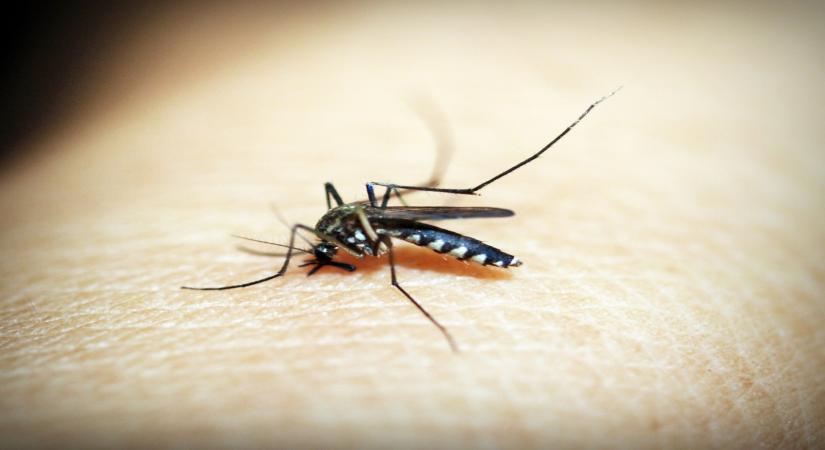
- 22 Oct 2025
In News:
- A major scientific breakthrough has emerged in the global fight against malaria, with U.S. researchers developing a novel monoclonal antibody (mAb) named MAM01, which has shown strong protection in early human trials.
- The results, published in The Lancet Infectious Diseases, mark a potential shift toward antibody-based malaria prevention, especially for vulnerable groups such as young children and pregnant women in endemic regions.
About MAM01 Monoclonal Antibody
- MAM01 is a laboratory-engineered monoclonal antibody designed to prevent malaria infection by targeting a highly conserved region of the Plasmodium falciparumcircumsporozoite protein (CSP) — a key molecule involved in the parasite’s entry into the bloodstream.
- By binding to this protein, MAM01 blocks infection at the earliest stage, preventing the parasite from reaching the liver or bloodstream.
Key Features
- Mode of Administration: A single injection of this long-acting antibody provides immediate protection lasting for several months.
- Target Groups: Especially beneficial for infants, young children, and pregnant women living in malaria-endemic regions.
- Duration of Protection: The antibody offers dose-dependent, months-long immunity with minimal side effects.
- Mechanism: MAM01 neutralizes the malaria parasite before it can infect liver cells, thus halting disease progression at the pre-erythrocytic stage.
Findings from the Clinical Trial
- Institution: Conducted by the University of Maryland School of Medicine’s Center for Vaccine Development and Global Health (CVD).
- Trial Design: A Phase 1, double-blind, placebo-controlled clinical study involving 38 healthy adult volunteers (aged 18–50) with no prior malaria exposure.
- Method: Participants were given either MAM01 or a placebo and later exposed to malaria-carrying mosquitoes in a controlled challenge study.
- Results:
- Participants receiving the highest dose of MAM01 showed complete protection from infection.
- All individuals in the placebo group developed malaria.
- No serious side effects or adverse events were reported.
- Outcome: The antibody demonstrated dose-dependent protection and a strong safety profile, providing proof-of-concept for antibody-based malaria prevention.
About Monoclonal Antibodies (mAbs)
Monoclonal antibodies are laboratory-made proteins that mimic the body’s natural immune response.
- Origin: Produced by cloning a single type of B cell to generate identical copies of an antibody.
- Specificity: Highly precise, designed to bind to a particular antigen such as a virus, bacterium, or parasite.
- Applications: Widely used in the treatment of cancer, autoimmune disorders, and infectious diseases (e.g., COVID-19, Ebola).
- Advantage: Offer targeted action with minimal side effects, and can provide immediate protection, unlike vaccines which require time for immunity to develop.
Significance of the Discovery
- A New Preventive Strategy: Unlike vaccines that may require multiple doses and boosters, MAM01 provides immediate and prolonged protection through a single dose — ideal for high-risk populations in malaria-endemic areas.
- Addressing a Global Health Burden: Malaria continues to cause over 600,000 deaths annually, predominantly among children in sub-Saharan Africa. Limited vaccine efficacy and emerging drug resistance make monoclonal antibodies a valuable addition to the malaria control toolkit.
- Technological and Health Equity Impact: This research demonstrates how cutting-edge biotechnological innovation can serve global health equity by providing affordable, scalable, and effective protection for populations in low- and middle-income countries.
- Complementary to Vaccines: MAM01 complements existing malaria vaccines like RTS,S (Mosquirix) and R21/Matrix-M, offering a dual-layered protection strategy — antibodies for immediate defence and vaccines for long-term immunity.
The New Arc of India–Australia Collaboration

- 22 Oct 2025
In News:
India and Australia have entered a new phase of strategic and defence engagement, marked by Defence Minister Rajnath Singh’s visit to Canberra and Sydney for the inaugural India–Australia Defence Ministers’ Dialogue (2025). This was the first such visit by an Indian Defence Minister in over a decade, signifying a decisive step from declaratory convergence to operational cooperation.
Evolution of the Partnership
- Strategic Convergence: India and Australia’s partnership is rooted in shared democratic values and mutual commitment to a free, open, and rules-based Indo-Pacific. Concerns over China’s assertive behaviour and the erosion of maritime norms have driven cooperation through the Quad (India, Australia, Japan, U.S.) and bilateral ministerial dialogues since the elevation of ties to a Strategic Partnership (2009) and later a Comprehensive Strategic Partnership (CSP) in 2020.
- Operational Deepening:The relationship expanded beyond political rhetoric to practical cooperation through joint exercises such as Talisman Sabre, air-to-air refuelling arrangements, and logistics support agreements. These efforts laid the groundwork for interoperability and joint operational mechanisms.
- Industrial and Logistics Convergence:Both nations are now focusing on defence industrial collaboration, joint ship repair and maintenance, and supply-chain resilience. This industrial alignment reflects a shift from episodic engagement to a sustainable, institutionalised defence ecosystem.
Key Agreements and Mechanisms (2025)
- Joint Maritime Security Collaboration Roadmap– Strengthens maritime surveillance, domain awareness, and coordinated patrols across the Indo-Pacific.
- Mutual Submarine Rescue Support Arrangement– Establishes frameworks for joint underwater rescue, enhancing naval safety and contingency response.
- Air-to-Air Refuelling Agreement (2024)– Expands tactical endurance, enabling longer joint missions and greater air interoperability.
- Annual Defence Ministers’ Dialogue & Joint Staff Talks– Institutionalises defence cooperation and ensures continuity beyond political cycles.
- Defence Industry Roundtables– Promotes co-production, joint R&D, and mutual fleet maintenance, supporting an integrated defence industrial base.
Drivers of the Deepening Partnership
- Strategic Drivers: The shifting balance of power in the Indo-Pacific and China’s coercive regional posture have encouraged both nations to close operational gaps and coordinate maritime preparedness.
- Pragmatic Considerations: Both India and Australia seek to diversify their security dependencies, reducing overreliance on single external providers. Mechanisms such as logistics sharing, submarine rescue cooperation, and industrial collaboration build self-reliance and reduce friction during crises.
Industrial and Technological Synergy
- India’s strengths: Scalable defence production under Make in India and Innovations for Defence Excellence (iDEX), achieving record output of ?1.5 lakh crore (FY 2024–25).
- Australia’s strengths: Advanced maritime platforms like P-8A Poseidon, MQ-4C Triton, and Ghost Shark autonomous submarine, supported by strong R&D.
Together, they form a complementary ecosystem combining India’s scale and cost-efficiency with Australia’s technological sophistication.
Strategic and Industrial Significance
|
Dimension |
Impact |
|
Maritime Security |
Enhances sea-lane protection, freedom of navigation, and coordinated patrols across the Indian Ocean and Western Pacific. |
|
Defence Production Linkages |
Strengthens regional supply chains through joint repair, co-production, and maintenance facilities. |
|
Technological Complementarity |
Merges India’s production base with Australia’s innovation-driven R&D for advanced systems. |
|
Institutional Strengthening |
Annual dialogues and Joint Staff Talks ensure long-term continuity of defence cooperation. |
|
Regional Balance |
Reinforces Quad’s strategic cohesion and promotes a transparent, rules-based Indo-Pacific architecture. |
Hygrocybe Pellucida
- 21 Oct 2025
In News:
In a significant biodiversity finding, Hygrocybe pellucida, a rare and recently identified fungus species, has been recorded for the first time in Telangana at the Kawal Tiger Reserve. The species, known for its vivid waxy appearance, was first described in Kerala in 2024 and belongs to the Hygrophoraceae family. This sighting expands its known range in southern India and highlights the ecological richness of the reserve.
About Hygrocybe pellucida
- Part of the Hygrocybe (waxcap) genus, containing ~350 species globally
- Distinguished by bright, translucent, waxy fruit bodies
- Prefers nutrient-poor, moss-rich forest floors and unimproved grasslands
- Indicator of undisturbed and pristine microhabitats
- Newly documented fungus species in India, reinforcing fungal diversity in tropical ecosystems
Ecological Significance
The discovery underscores the value of fungi as bioindicators of healthy ecosystems. It reflects the presence of intact microhabitats—moist, shaded forest floors with moss and low human interference—and complements ongoing biodiversity documentation in the region. Researchers have identified over 80 fungal species in Kawal, including several first records for Telangana, such as Marasmiushaematocephalus and Dacryopinaxspathularia.
Kawal Tiger Reserve: Key Facts
- Location: Telangana, along the Godavari River in the Deccan Peninsula–Central Highlands
- Declared Tiger Reserve: 2012 (originally a Wildlife Sanctuary)
- Landscape Linkages: Connects to Tadoba–Andhari (Maharashtra) and Indravati (Chhattisgarh) Tiger Reserves
- Topography: Part of the Sahyadri mountain ranges
- Rivers: Catchment area for Godavari and Kadam
- Vegetation:Southern Tropical Dry Deciduous Forests
- Flora: Teak, bamboo, Anogeissuslatifolia, Mitragyna parviflora, etc.
- Fauna: Tiger, leopard, sambar, blackbuck, nilgai, chinkara, chousingha, spotted deer
Conservation Perspective
While tiger conservation often takes center stage, this discovery emphasizes that forest floor biodiversity —including fungi and microfauna—plays a critical ecological role and requires equal attention. The finding strengthens the case for protecting microhabitats and maintaining minimal human disturbance in core forest areas.
We Rise Initiative
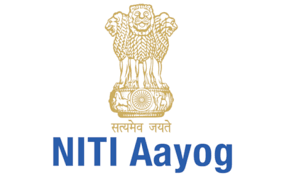
- 21 Oct 2025
In News:
India has launched a major initiative to strengthen women-led entrepreneurship and boost their participation in global trade. NITI Aayog’s Women Entrepreneurship Platform (WEP), in partnership with DP World, has introduced the ‘We Rise’ – Women Entrepreneurs Reimagining Inclusive and Sustainable Enterprisesprogramme. This initiative aligns with the Government of India’s vision of women-led development and is a part of WEP’s Award to Reward (ATR) framework.
Key Objectives and Features
- Purpose: To support women entrepreneurs in scaling their businesses globally
- Focus Areas:
- Trade facilitation
- Mentorship and business capacity-building
- Strategic partnerships and global market access
- Target Group: High-potential women-led MSMEs, particularly product-centric enterprises
- Coverage:100 women entrepreneurs will be selected for export-readiness programmes
- Global Exposure: Participants will showcase products at Bharat Mart in Dubai (Jebel Ali Free Zone), gaining access to international B2B and B2C markets
DP World will leverage its global supply chain expertise and logistics network to build export capabilities for women-led businesses, ensuring they meet international trade standards.
Strategic Significance
This initiative strengthens India’s women entrepreneurship ecosystem by providing:
- Access to finance and global markets
- Training, skill development, and compliance support
- Mentorship, networking, and business development services
It reinforces the importance of public-private collaboration in accelerating women's economic empowerment and building a more inclusive trade ecosystem.
Women Entrepreneurship Platform (WEP) Overview
- Established: 2018 by NITI Aayog; transitioned to PPP mode in 2022
- Engagement: Over 90,000 women entrepreneurs and 47 partners
- Mandate: Acts as a national aggregator and enabler to strengthen women-led businesses
- Core Functions: Addresses six ecosystem needs —
- Access to finance
- Market linkages
- Training & skilling
- Mentorship & networking
- Legal & compliance assistance
- Business development services
ATR Initiative
Launched in 2023, the Award to Reward (ATR) model institutionalises partnerships by celebrating women entrepreneurs and fostering scalable, outcome-driven collaborations.
Nafithromycin
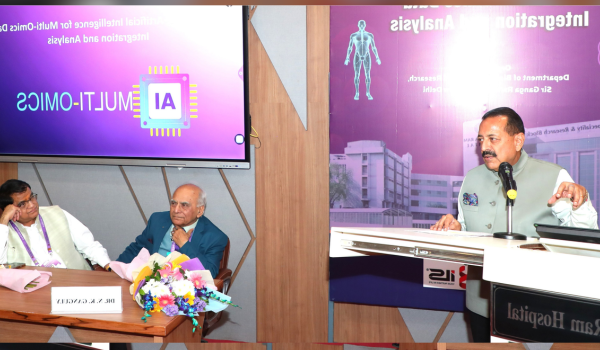
- 21 Oct 2025
In News:
India has achieved a major scientific milestone with the development of Nafithromycin, the country's first indigenously conceptualized, developed, and clinically validated antibiotic. Announced by the Union Science and Technology Minister, this breakthrough reflects India's growing self-reliance in the biotechnology and pharmaceutical sector and its commitment to addressing the global challenge of Antimicrobial Resistance (AMR).
About Nafithromycin
- Developed with support from: Biotechnology Industry Research Assistance Council (BIRAC)
- Trade Name:Miqnaf
- Target Use: Community-Acquired Bacterial Pneumonia (CABP)
- Key Beneficiaries: Cancer patients and individuals with poorly controlled diabetes
- Spectrum & Novelty: Effective against both typical and atypical respiratory pathogens; marks the first new antibiotic in its class globally in over 30 years
Nafithromycin is particularly relevant in India where respiratory infections remain a key public-health concern. The antibiotic is designed to combat drug-resistant respiratory infections, providing a potent solution amid rising antimicrobial resistance.
Why It Matters: Tackling AMR
Antimicrobial Resistance (AMR) occurs when microbes such as bacteria, viruses, fungi, or parasites develop the ability to defeat drugs designed to kill them. As a result, common infections become harder to treat, increasing the risk of severe illness, prolonged hospitalization, disability, and death. While AMR is a natural evolutionary process, misuse and overuse of antimicrobials significantly accelerate it. Nafithromycin’s development represents a strategic step in strengthening India's response to AMR.
Related Scientific Milestones Announced
The Minister also highlighted other key achievements underscoring India’s expanding biotech capabilities:
- Indigenous gene-therapy trial success for Hemophilia at Christian Medical College, Vellore — achieving 60–70% correction with zero bleeding episodes
- Human genome sequencing initiative: Over 10,000 genomes already sequenced, target set to reach 1 million
- Deployment of AI-based hybrid mobile clinics to improve healthcare access in rural and remote regions
These advancements reflect India’s push toward a self-sustainable innovation ecosystem, combining science, technology, and healthcare delivery to support the vision of a developed and technology-driven nation.
Zombie Deer Disease
- 21 Oct 2025
In News:
Florida has recently confirmed new cases of Chronic Wasting Disease (CWD), commonly referred to as “Zombie Deer Disease,” heightening concerns among wildlife authorities in the United States. This marks the second confirmed case in wild deer in the state since the first detection in June 2023, triggering an emergency response and surveillance measures in affected regions.
What is Chronic Wasting Disease (CWD)?
CWD is a progressive, fatal neurodegenerative disease affecting deer, elk, moose, and reindeer. It damages the central nervous system, causing:
- Severe weight loss
- Disorientation and loss of awareness
- Abnormal behavior, including reduced fear of humans
- Excessive salivation, increased drinking and urination
- Progressive debilitation and death
The incubation period ranges from 18–24 months, during which animals may appear healthy before showing symptoms.
Cause
- CWD is caused by prions — infectious misfolded proteins that trigger abnormal protein folding in the brain.
- Unlike bacteria or viruses, prions contain no DNA or RNA.
- Prions create spongy holes in brain tissue, leading to neurological failure.
Transmission
CWD spreads through:
- Direct contact among animals
- Contaminated saliva, urine, blood, and feces
- Environmental persistence — prions survive for years in soil, plants, and water
- Movement of infected animals
- Scavengers dispersing prion material
- Use of natural deer urine lures by hunters
Prions are extremely resilient, making eradication difficult.
Threat to Humans
- No confirmed human cases have been reported so far.
- However, health experts advise caution due to similarities with Bovine Spongiform Encephalopathy (mad cow disease), a prion disorder linked to human deaths in the past.
- There is no cure or vaccine for CWD.
Tuvalu Island
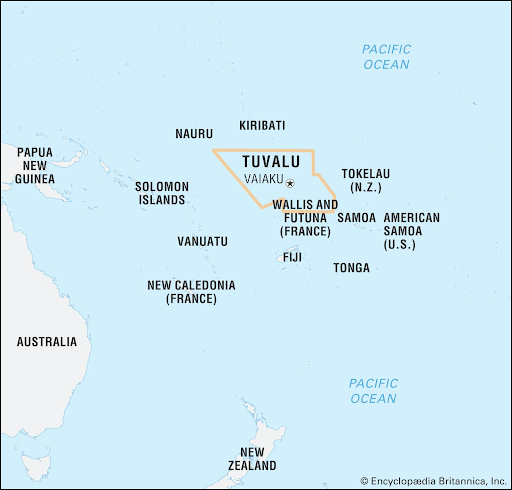
- 21 Oct 2025
In News:
Tuvalu has formally become the 90th State Member of the International Union for Conservation of Nature (IUCN), marking a major step in strengthening its global environmental engagement. This development aligns with the nation’s growing efforts to protect its fragile ecosystems and advocate for climate-vulnerable island states.
About Tuvalu
- Located in the west-central Pacific Ocean between Australia and Hawaii, Tuvalu (formerly the Ellice Islands) comprises nine low-lying atolls and coral islands spanning just 26 sq km—making it the fourth-smallest country in the world.
- With no point higher than 4.5 m above sea level, the country faces existential threats from sea-level rise, coastal erosion and climate change.
- It has an Exclusive Economic Zone (EEZ) of around 900,000 sq km, rich in marine biodiversity, coral reefs, fisheries and migratory seabirds.
- Tuvalu operates as a parliamentary democracy under a constitutional monarchy within the Commonwealth, recognizing King Charles III as head of state. Funafuti is the capital, and Tuvaluan and English are widely spoken. Its economy relies on subsistence activities, remittances, limited copra production, sale of postage stamps, and fisheries licensing revenues.
Significance of IUCN Membership
By joining IUCN, Tuvalu gains access to a global network of conservation experts, funding avenues and policy platforms. This membership strengthens its capacity to pursue:
- Climate change adaptation and resilience strategies
- Sustainable fisheries and marine resource management
- Community-driven conservation initiatives
- Partnerships with bodies such as the Green Climate Fund and Global Environment Facility
The move comes at a time when Pacific Island nations are pushing for stronger global action on climate change, adaptation financing and protection of ocean ecosystems.
Why It Matters
Tuvalu’s participation in IUCN brings heightened international focus on the plight of small island developing states (SIDS) facing climate-induced challenges. It enhances the country's voice in shaping global environmental governance and reinforces the need to safeguard vulnerable ecosystems and cultures deeply connected to the ocean.
Chiron

- 18 Oct 2025
In News:
Astronomers have, for the first time, observed the formation and evolution of a ring system around Chiron—an icy small body in the outer Solar System. This marks a significant development in planetary science, offering rare insight into ring-formation processes beyond giant planets.
About Chiron
- Discovery: Identified in 1977 by astronomer Charles Kowal.
- Classification: Belongs to the centaur class—objects orbiting between Jupiter and Neptune that exhibit traits of both asteroids and comets.
- Orbit: Completes one revolution around the Sun in ~50 years.
- Size: Approx. 200 km in diameter.
- Composition: Predominantly rock, water ice, and complex organic compounds.
- Behaviour: Shows comet-like activity, sometimes ejecting gas and dust.
Ring System Around Chiron
- First confirmed ring formation observed around a small icy body.
- Comprises four rings, with three inner rings embedded in a dust-disk and an outer ring located unusually far from the body.
- Rings likely contain water-ice particles mixed with rocky material, similar to Saturn’s rings.
- Observations from 2011 to 2023 indicate dynamic evolution of the ring system.
Distances of Rings From Chiron's Center (Approx.):
- Inner Rings: ~273 km, ~325 km, ~438 km
- Outer Ring: ~1,400 km (requires further stability confirmation)
Significance of the Discovery
- Provides a real-time snapshot of ring evolution, offering clues to:
- Formation mechanisms of rings around small bodies
- Dynamics of dust-disk systems in space
- Broader processes that form moons and debris structures
- Enhances understanding of small-body systems, complementing prior ring discoveries around:
- Chariklo(centaur)
- Haumea
- Quaoar
How Was It Observed?
Researchers used stellar occultation—studying changes in starlight as Chiron passed in front of a distant star. Data from Brazil, France, and Spain enabled high-precision observations.
Possible Origins of the Rings
Hypotheses include:
- Remnants of a destroyed moon
- Collisional debris from impacts with space material
- Material ejected by Chiron itself
- Or a combination of these processes
Water-ice plays a key stabilizing role by preventing particles from clumping into a moon.
Scheme for Innovation and Technology Association with Aadhaar

- 18 Oct 2025
In News:
- The Unique Identification Authority of India (UIDAI) has launched the Scheme for Innovation and Technology Association with Aadhaar (SITAA) to advance India's digital identity framework and safeguard Aadhaar against evolving cyber threats, particularly AI-driven deepfakes, spoofing, and biometric fraud.
- The initiative reflects India's objective to build secure, scalable, indigenous, and globally benchmarked identity solutions, aligning with the broader vision of Digital Public Infrastructure and Atmanirbhar Bharat.
Key Objectives
- Strengthen the security and reliability of Aadhaar authentication.
- Develop cutting-edge biometric and AI-based security technologies.
- Foster collaboration among startups, academia, and industry for co-development.
- Encourage indigenization of identity-tech solutions.
- Build future-ready digital identity systems capable of countering emerging threats.
Strategic Partnerships
To operationalize the programme, UIDAI has partnered with:
- MeitY Startup Hub (MSH) – for technical mentoring, incubation and accelerator support.
- NASSCOM – for industry linkages, global outreach, and entrepreneurship support.
Pilot Phase Focus Areas
The SITAA pilot has launched three innovation challenges open to eligible startups, research institutions, and industry partners (applications open till 15 November 2025):
|
Challenge |
Objective |
Key Requirements |
|
Face Liveness Detection |
Prevent spoofing in face-based authentication |
SDK for passive/active liveness; detect photos, videos, masks, morphs, deepfakes; work across devices/environments; edge + server capability |
|
Presentation Attack Detection (PAD) |
Enhance AI/ML-based face authentication resilience |
Real-time PAD for print, replay, morphs, masks, deepfakes; privacy-compliant; scalable; interoperable with Aadhaar APIs |
|
Contactless Fingerprint Authentication |
Enable mobile-based fingerprint verification |
Capture fingerprint via smartphone/low-cost devices; spoof detection; AFIS-compliant templates; demo app & QC tool required |
Why SITAA Matters
- Deepfake threat escalation: Attempts to bypass biometric security demand next-gen AI counter-measures.
- Contactless biometrics: Essential in post-pandemic authentication models and mobile-first delivery.
- Demographic and environmental variability: Aadhaar works across diverse conditions and populations, making robust tech essential.
- Strengthening trust in India’s digital public infrastructure systems like Aadhaar, UPI, DigiLocker, and ABHA.
Technological Focus Areas
- Advanced biometrics (face, fingerprint)
- AI-driven liveness and spoof detection
- Privacy-preserving authentication methods
- Secure digital identity frameworks
- Mobile-first biometric solutions
Public Trust Doctrine
- 18 Oct 2025
In News:
The Supreme Court has recently clarified that the Public Trust Doctrine (PTD) applies not only to naturally occurring water bodies such as rivers, lakes, and wetlands, but also to artificial or man-made waterbodies that perform vital environmental or ecological functions. This judgment marks a significant expansion of environmental jurisprudence in India, underscoring that ecological protection cannot hinge solely on whether a waterbody is naturally formed.
Case Background: Futala Lake, Nagpur
The ruling came in a case concerning Futala Lake in Nagpur, Maharashtra, where an NGO challenged recreational development activities around the lake, arguing that it should be treated as a wetland.
Key details:
- Futala Lake (Telangkhedi Tank) was built in 1799 by Shri Gyanoji Bhosale.
- The lake and its catchment cover ~200 hectares.
- Constructed historically for irrigation, making it man-made.
The Bombay High Court had earlier allowed non-permanent recreational structures while directing authorities to preserve the lake’s environmental integrity. The Supreme Court upheld this decision.
Supreme Court’s Key Observations
- Artificial waterbodies serving ecological functions fall within the Public Trust Doctrine.
- Such resources must be protected under the constitutional mandate of Articles 48-A and 51-A(g) (environmental protection duties of the State and citizens).
- Futala Lake, being artificially created for irrigation, does not qualify as a "wetland" under the Wetlands (Conservation and Management) Rules, 2017, which exclude human-made irrigation tanks.
- Nonetheless, the lake deserves environmental protection through PTD because it contributes to urban ecology and public welfare.
The Court emphasized that PTD imposes duties on authorities to prevent irreversible damage and ensure sustainable use, reinforcing the right to a healthy environment under Article 21.
Doctrinal Significance: Public Trust Doctrine (PTD)
Meaning: The State acts as a trustee of natural and environmental resources, which belong to the public and cannot be monopolized, degraded, or transferred for private gain.
Origins:
- Roots in Roman law (res communes)
- Developed through English common law
- Recognized in Indian jurisprudence (e.g., M.C. Mehta v. Kamal Nath, 1997)
Core Principles
- Resources of collective importance must remain available for public use and ecological balance.
- The State cannot alienate, privatize, or degrade these resources.
- Resources must be maintained for specific public and ecological purposes.
Ruling’s Broader Implications
- Expands PTD protection to man-made lakes, tanks, reservoirs that support ecology and public use.
- Strengthens legal framework for urban waterbody conservation amid fast-paced infrastructure growth.
- Reinforces sustainable development, ecological preservation, and inter-generational equity.
Taftan Volcano
- 18 Oct 2025
In News:
A recent scientific study has revealed renewed geological activity at Mount Taftan, a stratovolcano in southeastern Iran, raising concerns among volcanologists and regional authorities. The volcano, believed to have remained inactive for nearly 700,000 years, has exhibited ground uplift and increased gas emissions, suggesting possible magmatic or hydrothermal movement beneath the surface.
Key Findings from Recent Study
- Research published in Geophysical Research Letters notes that ground near Taftan’s summit rose by ~9 cm between July 2023 and May 2024.
- Persistent uplift signals buildup of gas pressure below the volcano.
- Residents reported strong sulfurous fumes, detectable up to 50 km away in the city of Khash.
- Satellite monitoring (ESA’s Sentinel-1) indicated activity in absence of ground-based GPS stations.
Scientists stress there is no immediate eruption threat, but the volcano should be reclassified from "extinct" to dormant and monitored more closely due to increasing activity.
About Taftan Volcano
- Location: Southeastern Iran, ~56 km from Pakistan border
- Elevation:3,940 m (12,927 ft)
- Type: Semi-active stratovolcano (composite volcano)
- Volcanic Arc: Only active volcano in the Makran subduction zone
- Geological Setting: Formed due to subduction of Arabian oceanic crust beneath Eurasian plate
- Key Features: Two summits — Narkuh and Matherkuh
- Activity Indicators:
- Active hydrothermal system
- Sulfur-emitting vents (fumaroles)
- No recorded eruptions in human history
What is a Stratovolcano?
- Tall, steep-sided cone-shaped volcano
- Commonly found along convergent plate boundaries
- Composed of alternating lava flows and pyroclastic deposits
- Eruptions tend to be explosive due to viscous magma (andesite/dacite)
- Examples: Mt. Fuji, Mt. St. Helens, Vesuvius, Krakatoa
Maldives Achieves Triple Elimination of Mother-to-Child Transmission (MTCT)
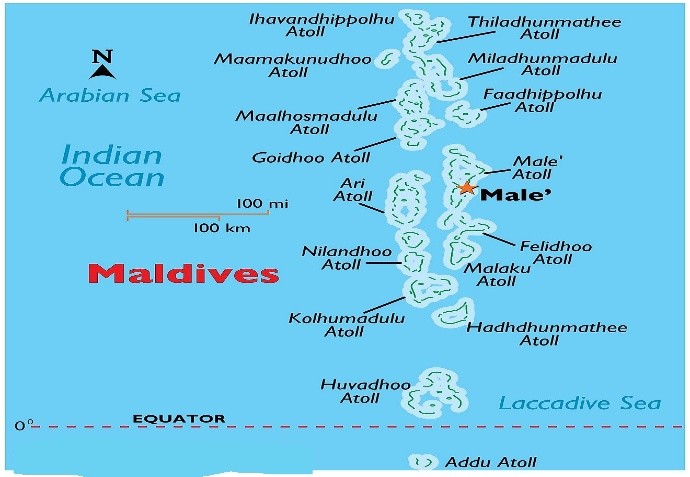
- 18 Oct 2025
In News:
In a landmark development in global public health, the Maldives has become the first country in the world to be validated by the World Health Organization (WHO) for eliminating mother-to-child transmission of HIV, syphilis, and hepatitis-B. This achievement represents a major milestone in protecting newborns from lifelong infections and advancing maternal-child health security.
Significance of the Achievement
Mother-to-child transmission (MTCT) of HIV, syphilis, and hepatitis-B remains a pressing concern worldwide, particularly in developing regions. In the WHO South-East Asia Region alone, thousands of infants are still born with congenital infections annually. Against this backdrop, Maldives’ accomplishment sets a benchmark for public health governance and disease elimination.
Key Drivers Behind Maldives’ Success
The achievement results from a comprehensive, integrated and equity-based healthcare strategy, backed by political commitment and strong health investments.
1. Universal Maternal Care and Screening
- Over 95% of pregnant women in Maldives receive antenatal care.
- Nearly all are screened for HIV, syphilis, and hepatitis-B.
- Universal access extends to migrants and remote island populations.
2. Robust ImmunisationProgramme
- Above 95% hepatitis-B birth-dose coverage within 24 hours of birth.
- Full childhood immunisation coverage consistently maintained.
3. Demonstrated Zero Transmission
- No infant HIV or syphilis cases reported since 2022.
- National survey (2023) confirmed zero hepatitis-B among school-entry children.
4. Strong Public Health Infrastructure
- Universal health coverage system offering free antenatal and diagnostic services.
- Government spends over 10% of GDP on health, among the highest in the region.
- Effective partnerships across public, private, and civil society sectors, supported by WHO technical assistance.
Strategic Measures Adopted
- Integrated maternal-child health services
- Early testing and treatment protocols
- Strong laboratory systems and surveillance
- Community outreach and migrant health inclusion
- High-quality vaccination logistics
Future Roadmap
To sustain the elimination status and deepen maternal-newborn care outcomes, Maldives plans to:
- Expand digital public-health systems
- Strengthen laboratory and monitoring quality
- Enhance services for key and migrant populations
- Increase private-sector collaboration
WHO will continue supporting Maldives to maintain momentum toward broader maternal, child, and adolescent health goals.
Maldives at a Glance
- Location: North-central Indian Ocean; southwest of India and Sri Lanka
- Capital:Malé
- Population: ~5.6 lakh (2025)
- Geography: ~1,200 coral islands across 26 atolls; ~200 inhabited
- Feature: Lowest-lying nation globally (maximum elevation ~1.8m)
- Climate: Tropical; Southwest monsoon (May–Aug), Northeast monsoon (Dec–Mar)
Military Combat Parachute System

- 17 Oct 2025
In News:
- India has achieved a major milestone in defenceindigenisation with the successful testing of the Military Combat Parachute System (MCPS) by the Defence Research and Development Organisation (DRDO).
- The system demonstrated a combat freefall jump from 32,000 feet, making it a significant advancement in India’s aerial delivery capability.
About the Military Combat Parachute System
The MCPS is an indigenous high-altitude parachute system designed to support special operations and military freefall missions in extreme altitudes and hostile environments.
- Developed by:
- Aerial Delivery Research & Development Establishment (ADRDE), Agra
- Defence Bioengineering & Electromedical Laboratory (DEBEL), Bengaluru
Key Features
- Altitude Capability: Successfully tested from 32,000 feet, and the only parachute system in operational use with the capability to be deployed above 25,000 feet by Indian forces.
- Enhanced Tactical Performance:
- Lower rate of descent
- Superior steering and maneuvering abilities
- Allows accurate navigation and landing at designated drop zones
- Navigation Support: Compatible with NavIC (Indian satellite navigation system), ensuring secure and interference-free guidance.
- Mission Capability: Enables safe aircraft exit, controlled descent, and precise landing in complex terrains—critical for special forces operations.
Strategic Significance
- Self-Reliance in Defence:
- Major step towards Aatmanirbhar Bharat in aerial delivery systems
- Reduces dependence on foreign parachute systems and maintenance support
- Operational Advantage:
- Ensures reliability in high-risk environments
- Immune to external interference/denial of service attempts
- Enhances special operations capability against any adversary
- Logistics & Lifecycle Benefits:
- Faster maintenance turnaround compared to imported systems
- Ensures availability during conflicts or war-time contingencies
SAIME Initiative
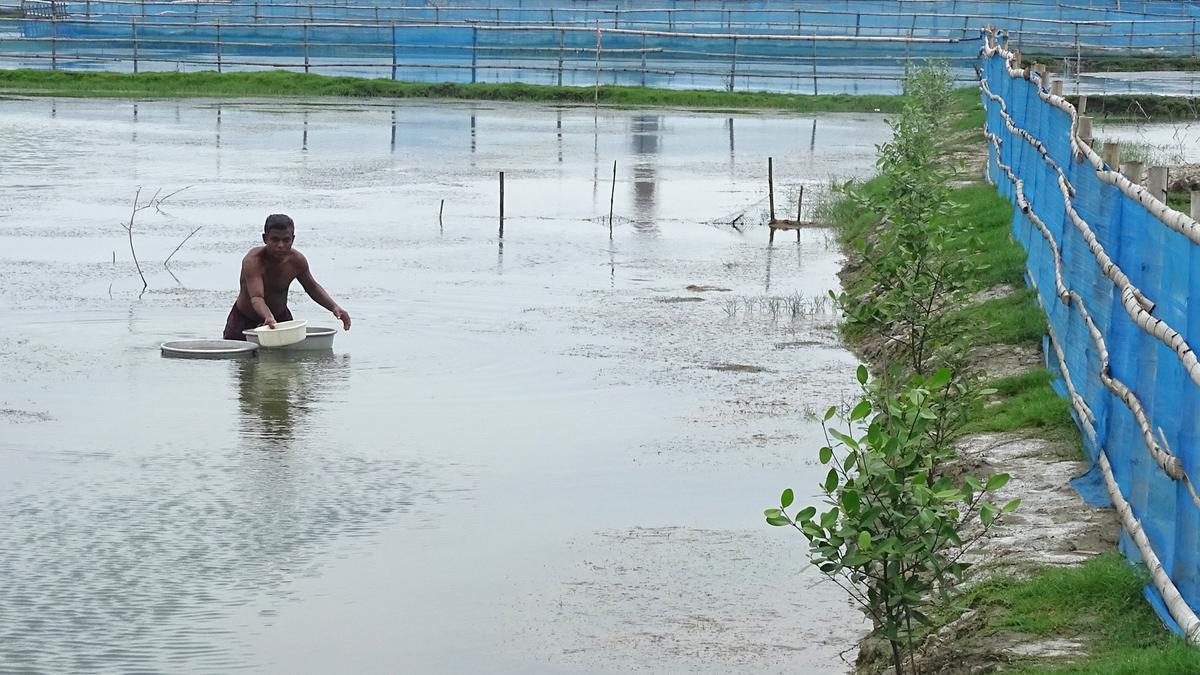
- 17 Oct 2025
In News:
A climate-adaptive aquaculture model from West Bengal’s Sundarbans — the Sustainable Aquaculture in Mangrove Ecosystems (SAIME) initiative — has recently received Global Technical Recognition from the Food and Agriculture Organization (FAO) of the United Nations. This recognition highlights a successful nature-based livelihood model that integrates aquaculture with mangrove restoration.
About the SAIME Initiative
The SAIME programme is a unique multi-stakeholder partnership aimed at promoting sustainable, mangrove-linked shrimp aquaculture while restoring fragile coastal ecosystems. By combining aquaculture practices with mangrove conservation, it seeks to build climate-resilient livelihoods in the vulnerable Sundarbans delta region.
- Focus: Climate-adaptive, ecosystem-based livelihood system
- Key Approach: Integrates brackish-water shrimp farming with mangrove plantation
- Objective:
- Protect mangrove forests
- Enhance biodiversity
- Provide sustainable income to coastal communities
- Implementation Partners:
- Nature Environment & Wildlife Society (NEWS)
- Global Nature Fund (GNF)
- Naturland (Germany-based standards organisation)
- Bangladesh Environment & Development Society (BEDS)
This model demonstrates how community-driven conservation can coexist with economic activity, reducing ecological pressure on mangrove ecosystems while supporting rural incomes.
Significance
Environmental Benefits
- Restores mangrove cover in cyclone-prone Sundarbans
- Enhances carbon sequestration, aiding climate mitigation
- Prevents coastal erosion and acts as a buffer against storm surges
- Supports rich biodiversity, including fish and crustacean populations
Socio-Economic Impact
- Offers a stable income source to local fishers and farmers
- Reduces dependency on destructive practices
- Strengthens climate resilience and livelihood security in vulnerable communities
Mangroves: Key Features
- Salt Tolerance:Specialised roots and salt-excreting mechanisms
- Aerial/Pneumatophore Roots: Enable respiration in waterlogged soils
- Prop Roots: Provide support against tides and cyclones
- Viviparous Seeds: Germinate on parent plant for survival in saline water
- Carbon Storage: Among the most carbon-rich ecosystems globally
Mangroves play a crucial role in mitigating climate change, protecting coasts, and supporting marine life — making their protection vital for ecological balance and disaster resilience.
Fare se Fursat Fixed Airfare Scheme
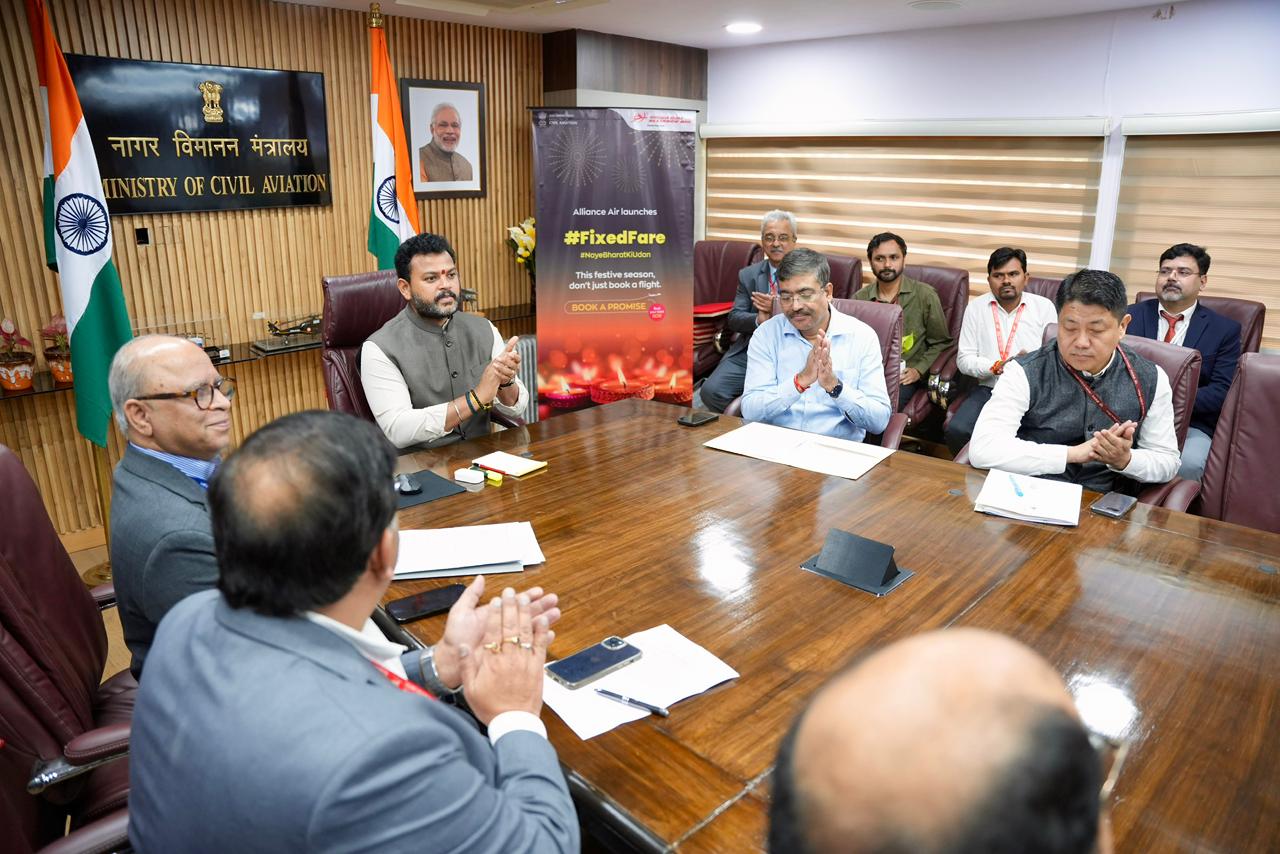
- 17 Oct 2025
In News:
The Government of India has launched the ‘Fare Se Fursat’ Fixed Airfare Scheme, a first-of-its-kind initiative aimed at providing predictable and transparent airfares on select regional routes. Introduced by the Ministry of Civil Aviation, the scheme reflects the government’s continued push to democratize air travel and enhance regional connectivity.
About the Scheme
- Launched by: Ministry of Civil Aviation & Alliance Air
- Purpose: To eliminate uncertainty associated with fluctuating airfares and promote ease of flying.
- Key Feature:Single, fixed ticket price irrespective of booking date — even for same-day travel.
- Pilot Phase:
- 13 October – 31 December 2025
- Operated on select regional routes
- Airline: Alliance Air, India's government-owned regional carrier
Objective & Rationale
- Address dynamic pricing concerns: Indian aviation typically follows dynamic pricing based on demand and seasonality, often causing high last-minute fares.
- Make air travel accessible: Inspired by the UDAN scheme, the initiative targets middle-class, lower-middle-class, and neo-middle-class passengers, especially from Tier-2 and Tier-3 cities.
- Increase first-time flyers: The scheme aims to build confidence among new travelers by offering predictable fares, reducing financial anxiety linked to last-minute price surges.
Significance
- Supports UDAN (UdeDesh ka AamNagrik) vision of affordable regional connectivity.
- Strengthens last-mile aviation by enabling easier travel from smaller towns.
- Reinforces government's push for passenger-centric aviation policies (e.g., affordable airport cafés launched earlier under UDAN Yatri services).
- Promotes air travel as an everyday mode of transportation, not a luxury.
Why It Matters
- Predictability: Removes uncertainty in ticket prices, encouraging travel planning.
- Accessibility & Inclusivity: Bridges regional air travel gaps and widens aviation access to new socio-economic groups.
- Public-service Focus: Prioritizes passenger welfare over profit maximization, aligning with the vision of “Naye Bharat ki Udaan”.
Mission Drishti
- 17 Oct 2025
In News:
India’s private space sector is set to achieve a major milestone with GalaxEye, a Bengaluru-based space-tech start-up, preparing to launch the world's first multi-sensor Earth observation (EO) satellite, Mission Drishti, in early 2026. The mission marks a significant step toward creating an advanced satellite constellation for real-time, high-precision geospatial intelligence.
About Mission Drishti
- World’s first multi-sensor EO satellite combining Synthetic Aperture Radar (SAR) and high-resolution optical imaging on a single platform.
- Built by GalaxEye — one of India’s leading private space-tech start-ups.
- India’s largest privately-built satellite and the highest-resolution satellite (1.5 m) developed in the country.
- Mass: ~160 kg.
- Underwent successful structural tests at ISRO’s U R Rao Satellite Centre, proving its ability to withstand harsh space conditions.
- Mission Drishti is the first step in deploying a constellation of 8–12 satellites by 2029 (company target: 8–10 in next four years).
Key Features & Technological Significance
- Dual Payload Technology: SAR + optical sensors enable:
- Imaging in all weather conditions
- Day and night coverage
- High-precision, multi-layered data
- High-resolution EO imagery optimized across spatial, spectral, and temporal dimensions.
- Enables actionable multisource imaging intelligence—a capability currently unexplored globally.
According to the company, Mission Drishti opens a new era in satellite imaging by fusing multiple sensing technologies to provide real-time situational awareness.
Applications
Mission Drishti aims to strengthen high-end geospatial capabilities across national and commercial sectors:
|
Sector |
Use-case |
|
Defence& Security |
Border surveillance, tactical intelligence |
|
Disaster Management |
Floods, landslides, cyclone & emergency monitoring |
|
Infrastructure & Utilities |
Structural health monitoring, urban planning |
|
Agriculture |
Crop monitoring, precision farming support |
|
Finance & Insurance |
Risk assessment, disaster claim validation |
The mission aligns with rising global demand for accurate Earth observation data, especially amid geopolitical tensions and climate-driven emergencies.
Significance for India’s Space Ecosystem
- Enhances India’s capabilities in commercial EO intelligence, traditionally dominated by the US & Europe.
- Strengthens private-sector participation under India’s space reforms and IN-SPACe framework.
- Potential to integrate AI and advanced imaging analytics, improving decision-making in governance and industry.
- Boosts India’s aspiration to become a global space-technology provider.
India’s Quantum Breakthrough in Cybersecurity

- 17 Oct 2025
In News:
India has achieved a major milestone in quantum technology and cybersecurity. Researchers at the Raman Research Institute (RRI), Bengaluru, have demonstrated and certified the generation of true random numbers using a general-purpose quantum computer.This breakthrough positions India at the forefront of quantum-secure digital infrastructure, marking a key outcome under the National Quantum Mission.
Why Randomness Matters in Digital Security
- Modern encryption — including banking, digital communication, defence networks and authentication systems — relies on random numbers.These numbers form the basis of encryption keys and secure passwords. The more unpredictable the number, the stronger the security.
Current challenge
- Most systems use pseudorandom numbers, produced through algorithms. While highly complex and secure against classical brute-force attacks, they are not fundamentally random. With the advent of quantum computers, which can process data exponentially faster, many of today’s encryption systems may become vulnerable.
The Need for True Quantum Randomness
- Quantum mechanics provides intrinsic unpredictability. In the microscopic world, particles such as photons do not have definite states until measured — creating true randomness, unlike algorithm-based outputs.
- Quantum Random Number Generators (QRNGs) tap this behaviour.However, a persistent problem has been certifying whether the randomness is genuine or manipulated by device flaws or external interference.
- Cybersecurity demands systems that are not just hard to break, but theoretically impossible to break under known physical laws — making device-independent, quantum-certified randomness essential.
India’s Scientific Breakthrough
The RRI team achieved device-independent quantum random number generation and certification, a frontier area globally.
Key Scientific Contributions
- Utilisation of quantum entanglement and temporal correlations to certify randomness
- Demonstration of violation of Leggett-Garg inequality, confirming true quantum randomness
- Execution on a commercial, general-purpose quantum computer — proving real-world applicability beyond controlled lab environments
Earlier global attempts relied on large-scale entanglement experiments requiring hundreds of metres of physical separation.India’s approach achieves equivalent validation using time-separated measurements on a single particle, making it compact and practical.
Significance of the Breakthrough
Technological Impact
- Enables hack-proof encryption and post-quantum security systems
- First globally-relevant breakthrough under India’s National Quantum Mission
- Demonstrates practical, scalable and noise-tolerant quantum technology
Strategic Implications
- Boosts India’s readiness for quantum cyber warfare and digital sovereignty
- Critical for secure defence networks, financial systems, and government communication
- Promotes indigenous capability in a domain dominated by the US, EU and China
Sudden Infant Death Syndrome
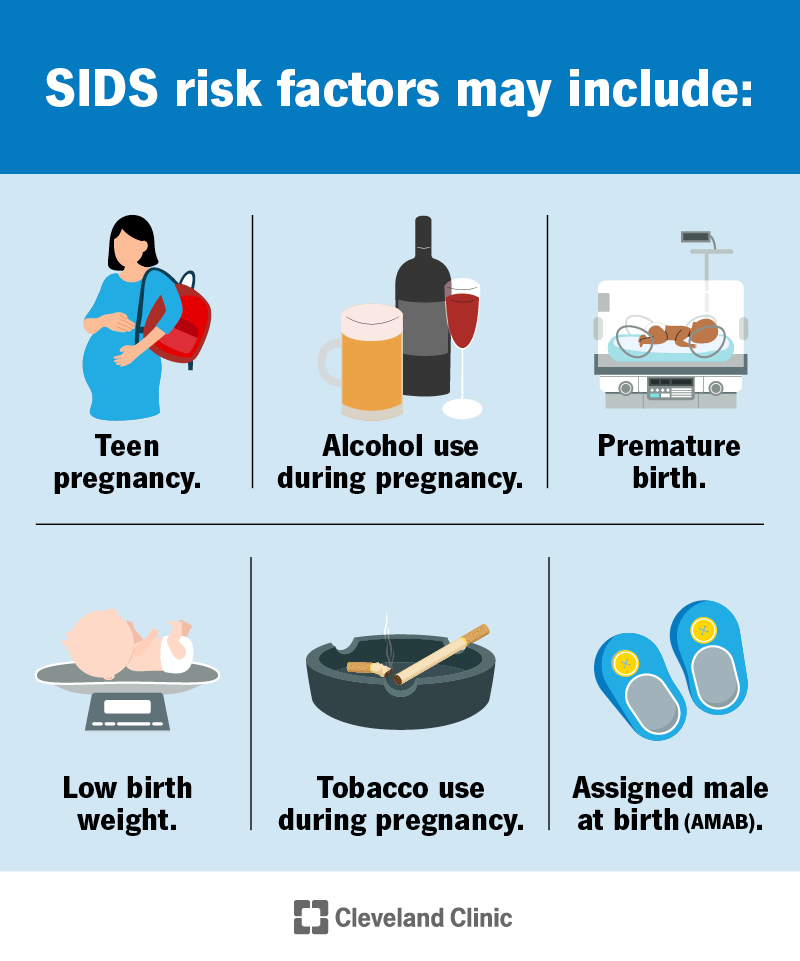
- 16 Oct 2025
In News:
- Sudden Infant Death Syndrome (SIDS) refers to the sudden, unexplained death of an infant below one year of age, even after thorough medical investigation, including autopsy, review of medical history, and examination of the death environment.
- It is a major contributor to infant mortality globally, and October is observed as SIDS Awareness Month to promote public understanding and preventive practices.
Epidemiology and Vulnerable Age Group
- Most SIDS cases occur between 2 to 4 months of age, and around 90% of incidents occur before six months. While it can happen at any time, cases most commonly occur during sleep, typically between midnight and early morning hours. Slightly more male infants are affected compared to females.
- SIDS is the leading cause of death in infants aged 1 month to 1 year in countries like the United States, with approximately 2,500 infant deaths annually.
Understanding SIDS and SUID
SIDS forms part of a broader category termed Sudden Unexpected Infant Death (SUID), which encompasses all sudden infant deaths, including those with clear causes (such as suffocation) and those without identified causes. About half of SUID cases are attributed specifically to SIDS.
Risk Factors and Possible Mechanisms
Although SIDS remains medically unexplained, research suggests a combination of biological vulnerability and environmental triggers during a critical developmental period. Proposed mechanisms include immaturity of the brain regions regulating breathing, heart rate, temperature, and arousal from sleep, as well as possible genetic predisposition.
Recognised risk factors include:
- Premature birth and low birth weight
- Exposure to tobacco smoke or alcohol during pregnancy
- Unsafe sleep environment or sleeping position
- Lack of prenatal care
- Overheating during sleep
- Teenage pregnancy
- Male sex
- Sibling history of SIDS
- Being a twin
- History of apnea episodes
Importantly, vaccines do not cause SIDS; recent studies indicate that timely vaccination may actually reduce SIDS risk by up to 50%.
Prevention and Safe-Sleep Guidelines
While SIDS cannot always be prevented, certain practices can significantly reduce risk. Key recommendations include:
- Always place infants on their backs for sleep.
- Use a firm, flat sleep surface with only a fitted sheet.
- Avoid loose bedding, pillows, toys, and crib bumpers in the sleep area.
- Have the baby sleep in the same room but not the same bed for at least the first six months.
- Avoid smoking, alcohol, and drug exposure during and after pregnancy.
- Maintain a cool sleeping environment and avoid overheating.
- Breastfeeding and the use of pacifiers are associated with reduced risk.
- Stop swaddling once the infant can roll over.
- Provide supervised tummy time while the infant is awake to promote development and prevent flat-head syndrome.
Consumer devices marketed to prevent SIDS, such as breathing monitors, have no proven benefit in preventing deaths.
Crew Escape System
- 16 Oct 2025
In News:
- India’s human spaceflight programme, Gaganyaan, places paramount emphasis on astronaut safety. To achieve this, ISRO has developed a dedicated Crew Escape System (CES) — a rapid emergency mechanism designed to protect astronauts during the most critical phase of a mission: launch and atmospheric ascent.
- Recently, ISRO also developed a cost-effective single-stage test vehicle powered by the Vikas engine specifically to validate this escape system during flight trials.
Purpose and Importance
- In human space missions, crew safety takes priority over mission success. During launch and the initial ascent through the dense atmosphere, the launch vehicle experiences extreme stresses and accelerates to hypersonic speeds. Any malfunction at this stage — especially with rockets using solid boosters that cannot be shut down once ignited — demands immediate crew evacuation.
- The CES is engineered to rapidly detach the crew module from the launch vehicle in the event of an anomaly and move it to a safe distance within seconds.
How the Crew Escape System Works
The Crew Escape System is mounted on the forward end of the rocket and consists of multiple high-burn-rate solid motors that generate more thrust than the launch vehicle, ensuring faster acceleration of the escape module. Once activated, the CES pulls the crew module away, safely distancing it from the failing rocket.
After separation:
- The escape system detaches from the crew module
- A multistage parachute system deploys
- The module gradually decelerates
- Astronauts splash down safely in the sea
Throughout this sequence, the crew remains inside the pressurised module until recovery.
Decision-Making & Safety Systems
- Activation of the CES is controlled by the Integrated Vehicle Health Management (IVHM) system. This network of sensors, software and diagnostics continuously monitors launch vehicle performance and crew module health in real time.
- It detects anomalies, filters out false alarms, and triggers the escape sequence instantly if required.
Types of Crew Escape Systems
Crew escape mechanisms follow two broad designs:
- Puller type — used in Gaganyaan, where the system pulls the crew module away using high-thrust solid motors. Similar systems were used in the U.S. Saturn V, Russia’s Soyuz, and China’s Long March missions.
- Pusher type — used in systems like SpaceX Falcon-9, where small liquid-fuel engines push the spacecraft away.
ISRO adopted the puller-type design due to its proven reliability in high-stress atmospheric escape scenarios.
Impatiens Rajibiana
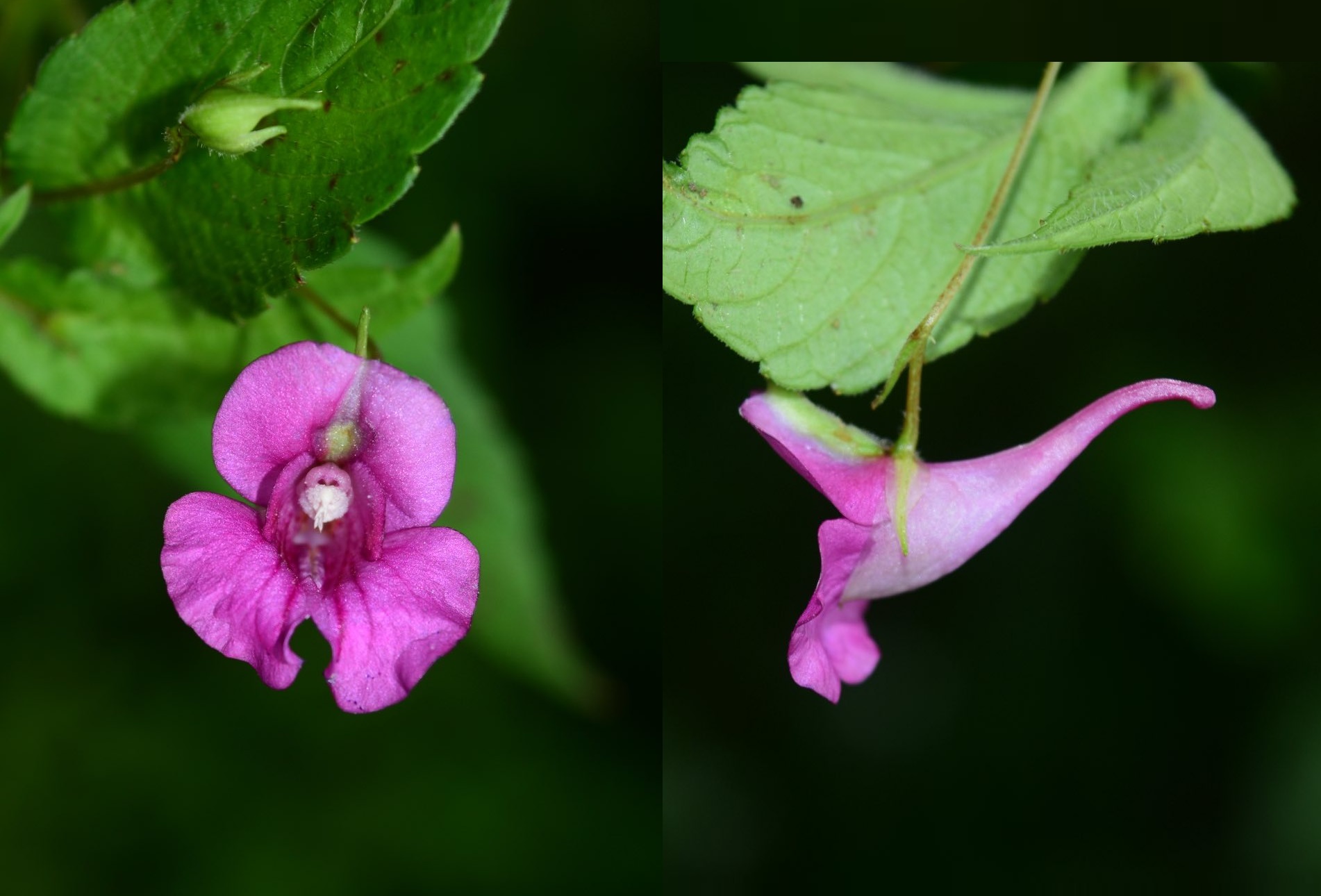
- 16 Oct 2025
In News:
A team from the Botanical Survey of India (BSI) has identified a new species of balsam flower named Impatiens rajibiana in Arunachal Pradesh. The discovery was made in the natural forest areas of Shergaon, West Kameng district, highlighting the region’s rich floral biodiversity.
Key Details and Ecological Significance
- Impatiens rajibiana belongs to the Balsaminaceae family, commonly known as balsams.
- The species was located in moist, shaded habitats at an elevation of over 2,000 metres, indicating its preference for cool, humid, high-altitude forest ecosystems.
- Balsams are known for their delicate flowers and high levels of endemism, often restricted to narrow ecological zones.
- India currently hosts around 230 species of balsams, including the widely known Impatiens balsamina (garden balsam or touch-me-not).
- Arunachal Pradesh has emerged as a hotspot for balsam diversity. Between 2013 and 2017, more than 16 new species of Impatiens were documented from the state, such as Impatiens godfreyi and Impatiens sashinborthakurii, reinforcing the Eastern Himalayas’ status as a key centre of plant discovery.
Conservation Relevance
- The discovery of Impatiens rajibiana underlines the ecological value of the Eastern Himalayan region and the need for continued field surveys and conservation.
- As many balsam species have restricted distribution and small populations, they may be vulnerable to habitat disturbances, climate change, and anthropogenic pressures.
- Protecting fragile mountain ecosystems and promoting biodiversity research remain critical for safeguarding endemic plant species like Impatiens rajibiana.
Astra Mark 2 Missile
- 16 Oct 2025
In News:
- India is set to make a major leap in its air-to-air weapon capability with the Defence Research and Development Organisation (DRDO) upgrading the Astra Mk-2 air-to-air missile.
- The missile’s range is being extended to beyond 200 kilometres, marking a significant improvement over earlier versions and positioning India among the few nations with such long-range Beyond Visual Range (BVR) missile technology.
- This upgrade is part of India’s broader push towards defenceindigenisation under the Aatmanirbhar Bharat vision.
Importance and Context
- The Astra programme reflects India's commitment to reducing dependence on foreign defence systems, strengthening self-reliance, and enhancing air superiority capabilities.
- The Astra Mk-1, with a range of around 90–110 km, has already been successfully inducted by the Indian Air Force (IAF) and proven operationally, including during Operation Sindoor.
- The Mk-2 variant, now under advanced development, will boost India's long-range interception capability, enabling IAF aircraft to engage enemy targets from well outside hostile air defence zones—an essential capability in modern aerial combat.
Key Features and Technological Advancements
- The Astra Mk-2 will be an extended-range, next-generation BVR missile capable of striking targets over 200 km away.
- It will employ a dual-pulse solid rocket motor, which provides an initial burst of acceleration followed by a second ignition phase for enhanced end-game manoeuvrability and precision. This propulsion design ensures higher terminal speed and greater accuracy compared to single-pulse missiles.
- The missile is expected to fly at speeds close to Mach 4.5 and will be equipped with a fully indigenous Radio Frequency (RF) seeker, fibre-optic gyroscopes, and advanced electronic countermeasure (ECM) resistance, making it highly effective in electronic warfare environments.
- Physically, the missile will be larger and heavier than its predecessor, with an estimated diameter of around 190 mm and a weight of approximately 175 kg. Its enhanced aerodynamic design will allow superior range and altitude engagement.
Operational Deployment and Strategic Impact
- Following successful development and testing, the Astra Mk-2 will be integrated with frontline fighter jets such as the Sukhoi-30MKI and LCA Tejas. The IAF plans to procure an initial stock of nearly 700 missiles, ensuring high operational availability.
- The missile’s extended range capability will serve as a key deterrent against regional adversaries. It is viewed as a counter to China’s PL-15, and it significantly surpasses Pakistan’s PL-15E, which has a maximum range of around 145 km. This enhancement will allow Indian pilots to neutralise hostile aircraft long before they pose a threat.
Live Cases Dashboard of the Legal Information Management and Briefing System (LIMBS)

- 16 Oct 2025
In News:
The Union Minister of State (Independent Charge) for Law and Justice recently inaugurated the Live Cases Dashboard under the Legal Information Management and Briefing System (LIMBS) at Shastri Bhawan, New Delhi. This marks a key advancement in the government's efforts to enhance transparency, efficiency, and coordination in legal case management.
About the Live Cases Dashboard
- A digital interface providing real-time visualisation of court cases involving the Government of India.
- Displays upcoming hearings — particularly cases scheduled within the next seven days — across the Supreme Court, High Courts, and other judicial bodies.
- Enables proactive decision-making and inter-ministerial coordination, helping departments prepare timely responses.
About LIMBS
- Web-based application designed to monitor litigation where the Union of India is a party.
- Launched for central ministries, departments, CPSUs and autonomous bodies in 2016, with a major upgrade in January 2020.
- Operates under the Department of Legal Affairs, Ministry of Law & Justice.
- Allows 24x7 access to government officials, advocates, arbitrators, nodal officers, and ministry users to upload and track case information.
- Offers a dashboard-based system providing a snapshot of legal matters to each stakeholder institution.
Significance
- The Government of India remains one of the largest litigants.
- LIMBS and its Live Cases Dashboard aim to reduce litigation burden in line with the vision of “Minimum Litigation, Maximum Governance”.
- Enhances transparency, accountability, and judicial efficiency.
- Promotes data-driven governance, timely legal response, and improved public resource management.
Blue Flag Certification
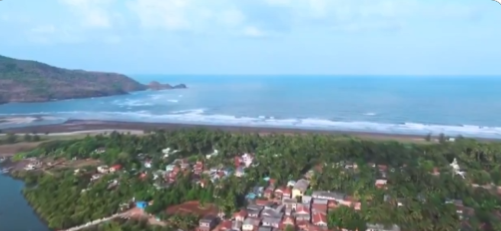
- 15 Oct 2025
In News:
- Five beaches in Maharashtra have recently been awarded the prestigious Blue Flag certification, a global eco-label that recognises high standards in environmental management, cleanliness, and sustainable tourism.
- The certified beaches include Shrivardhan and Nagaon (Raigad district), Parnaka (Palghar), and Guhagar and Ladghar (Ratnagiri district). The announcement was made by the state government, marking a significant achievement in coastal conservation and eco-tourism promotion.
About Blue Flag Certification
The Blue Flag is an internationally recognised eco-label awarded by the Foundation for Environment Education (FEE), Denmark. Established in France in 1985 and expanded globally in 2001, it is regarded as one of the world's most prestigious voluntary awards for beaches, marinas, and sustainable tourism boats.
Criteria and Objectives
To receive the Blue Flag, sites must meet 33 stringent criteria across key focus areas:
- Water quality
- Environmental management
- Environmental education and awareness
- Safety and essential services
The certification aims to promote sustainable development in coastal and freshwater ecosystems by ensuring high cleanliness standards, protecting natural habitats, and encouraging responsible tourism practices. Its mission centers on environmental education, conservation, and sustainable tourism development.
Blue Flag Beaches in India
With the addition of the five Maharashtra beaches, India continues to expand its presence on the global sustainable tourism map. Previously recognised Indian Blue Flag beaches include:
- Shivrajpur (Gujarat)
- Ghoghla (Diu)
- Kasarkod and Padubidri (Karnataka)
- Kappad (Kerala)
- Rushikonda (Andhra Pradesh)
- Golden Beach (Odisha)
- Radhanagar (Andaman & Nicobar)
- Kovalam (Tamil Nadu)
- Eden (Puducherry)
- Minicoy Thundi and Kadmat (Lakshadweep)
Significance
This recognition underscores India's ongoing efforts to align coastal tourism with global environmental standards, enhance beach amenities, and promote eco-friendly tourism models. It also strengthens India's initiative to improve coastal governance under programmes like the Integrated Coastal Zone Management Project and the government's broader sustainability mission.
NATO’s ‘Steadfast Noon’ Exercise
- 15 Oct 2025
In News:
NATO is set to conduct its annual nuclear deterrence drill, ‘Steadfast Noon’, with the 2025 edition hosted by the Netherlands. The exercise, a key component of NATO’s nuclear defence strategy, underscores the alliance’s commitment to maintaining credible deterrence capabilities amid evolving global security challenges.
About Steadfast Noon
Steadfast Noon is a long-standing annual nuclear readiness exercise conducted by the North Atlantic Treaty Organization (NATO). It serves as a crucial test of the alliance’s nuclear deterrence procedures, operational coordination, and preparedness to defend member states against strategic threats.
Key Features
- Host Country (2025): Netherlands
- Main Operating Base:Volkel Air Base, Netherlands
- Additional Bases:KleineBrogel (Belgium), Lakenheath (UK), Skrydstrup (Denmark)
- Participants: 14 NATO nations including the U.S., Germany, Poland, Finland, Belgium, the UK, the Netherlands, and Denmark
- Aircraft Involved: ~70–71 aircraft, including dual-capable fighter jets like the German Tornado and U.S./Dutch F-35s
- Nature of Exercise: Training for nuclear-mission capable aircraft — no live nuclear weapons are carried or flown
Dual-capable aircraft are equipped to deliver both conventional and nuclear payloads, making this exercise significant for testing operational flexibility and readiness.
Purpose and Strategic Context
The exercise is intended to:
- Validate operational procedures for NATO’s nuclear deterrent
- Strengthen coordination among allied air forces
- Signal commitment to collective defence under Article 5 of the NATO Treaty
- Deter adversaries by demonstrating credible nuclear readiness
Non-Participation of France
France does not take part in Steadfast Noon as it maintains an independent nuclear command and does not integrate its nuclear forces into NATO’s command-and-control system.
Armenia Joins IUCN
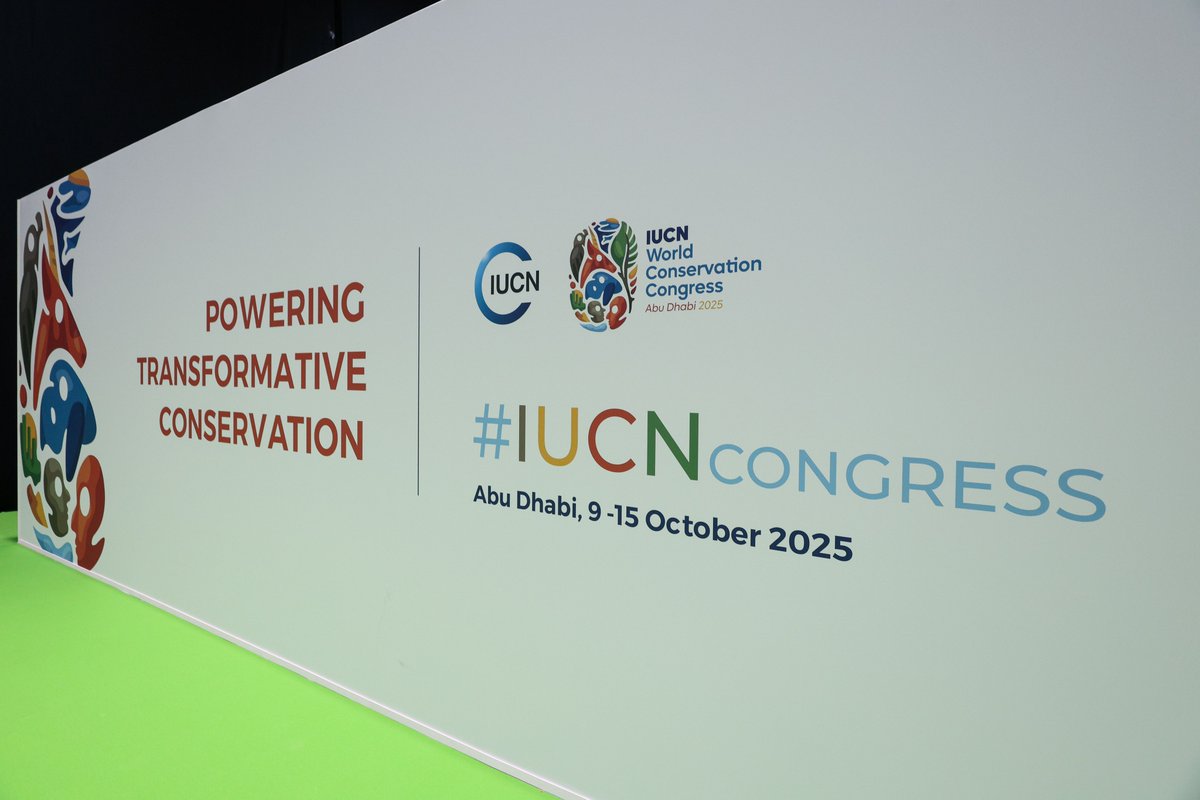
- 15 Oct 2025
In News:
Armenia has recently become the newest State Member of the International Union for Conservation of Nature (IUCN), marking a key milestone in its environmental policy direction. The announcement was made at the IUCN World Conservation Congress in Abu Dhabi, reflecting Armenia’s growing commitment to global biodiversity protection, sustainable development, and alignment with international conservation frameworks.
Significance of Membership
By joining IUCN, Armenia gains access to global research, conservation tools, and international collaborations. This step also supports its preparations to host COP17 of the Convention on Biological Diversity in 2026, signalling its intent to play a leadership role in global biodiversity discussions.
IUCN leadership has welcomed Armenia’s membership, noting that it aligns with the country’s efforts to expand protected areas, restore degraded ecosystems, and bring its environmental laws in line with international standards.
Armenia’s Biodiversity and Conservation Efforts
Situated at the crossroads of Europe and Asia, Armenia hosts varied ecosystems—from alpine meadows and mountain forests to semi-deserts and freshwater bodies. These habitats support several threatened and endemic species, including:
- Caucasian leopard (Critically Endangered)
- Bezoar goat
- Sevan trout, native to Lake Sevan
The country has made progress in environmental governance through initiatives such as its National Biodiversity Strategy and Action Plan and the Red Book of Armenia. Its conservation agenda includes forest restoration across 12.9% of its territory by 2030, strengthening biodiversity monitoring, and expanding protected areas.
Geographical and Environmental Profile of Armenia
- Location: Southern Caucasus; landlocked
- Borders: Georgia (north), Azerbaijan (east), Iran (southeast), Turkey (west)
- Terrain: Dominated by the Lesser Caucasus Mountains; volcanic soils rich in nitrogen, potash, phosphates
- Highest Peak:Mount Aragats (4,090 m)
- Climate: Highland continental — hot summers, cold winters
- Rivers: Aras, Hrazdan, Arpa, Vorotan — key for irrigation and hydropower
- Major Lake:Lake Sevan, Armenia’s largest freshwater body
- Resources: Small deposits of copper, gold, molybdenum, zinc, bauxite
- Capital & Language: Yerevan; Armenian
LEAPS 2025
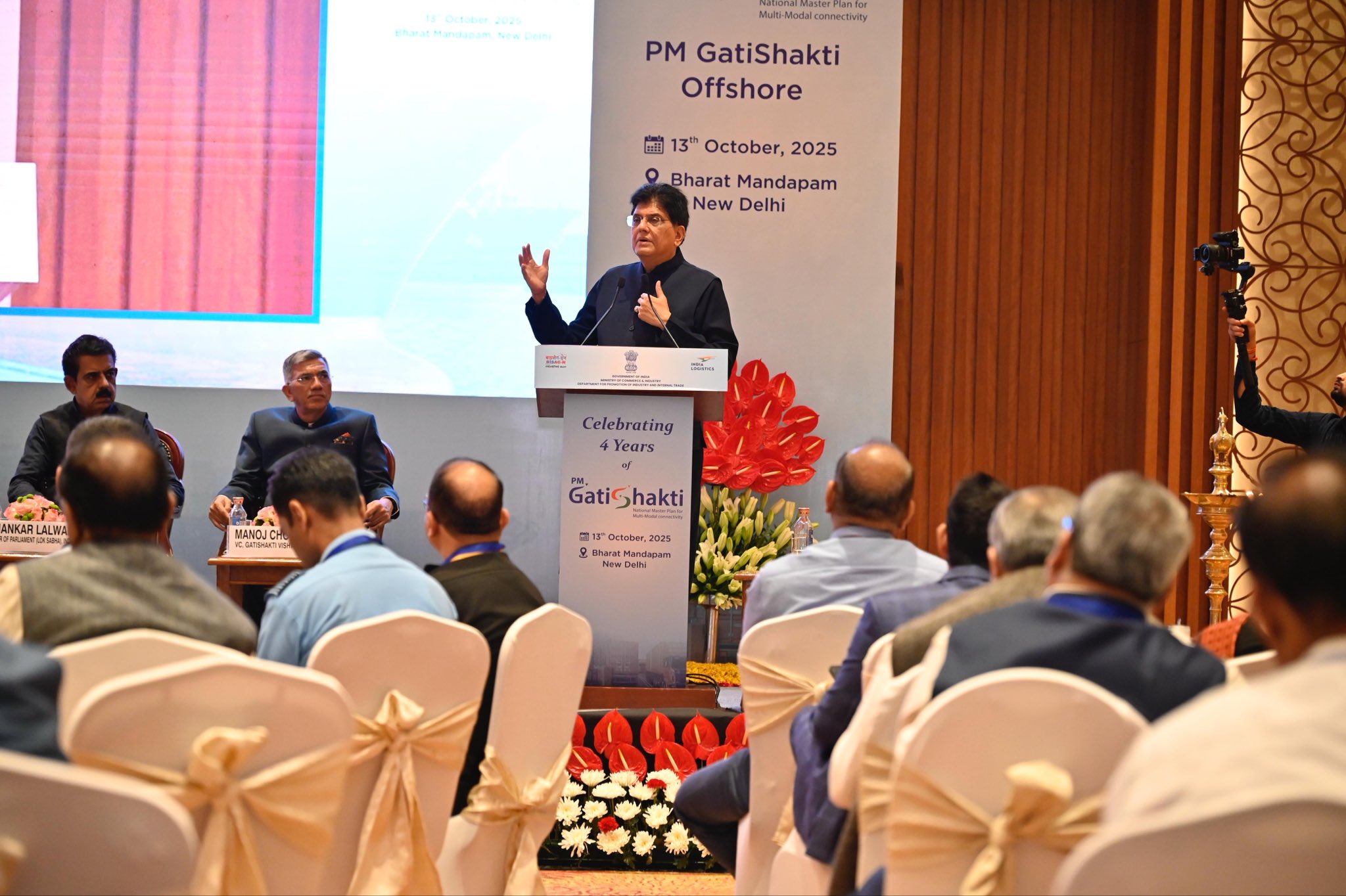
- 15 Oct 2025
In News:
The Union Minister for Commerce and Industry recently launched the Logistics Excellence, Advancement, and Performance Shield (LEAPS) 2025 in New Delhi, marking a major initiative to accelerate reforms and innovation in India’s logistics ecosystem. The launch also coincided with the 4th anniversary of the PM GatiShakti initiative, reaffirming the government’s commitment to building an efficient, integrated, and future-ready logistics network.
About LEAPS 2025
LEAPS 2025 is a flagship programme of the Department for Promotion of Industry and Internal Trade (DPIIT) under the Ministry of Commerce and Industry. It seeks to benchmark logistics excellence across the country by recognising outstanding performance, leadership, and innovative practices within the logistics sector.
Objectives
- Promote global-standard logistics performance and efficiency
- Strengthen competitiveness in line with the National Logistics Policy (NLP)
- Encourage sustainability and ESG-centric logistics models
- Foster collaboration among Government, Industry, and Academia
- Support Make in India, Atmanirbhar Bharat, and the vision of Viksit Bharat 2047
Key Focus Areas
- Logistics innovation and technology adoption
- Green logistics and sustainable supply chain practices
- Ease of movement through multimodal connectivity
- Capacity building and skilling in logistics and supply chain management
Coverage and Award Categories
The initiative spans a wide spectrum of logistics stakeholders, including:
- Freight operators (air, road, maritime, and rail)
- Multimodal transport operators
- Industrial, consumer, and agricultural warehousing firms
- MSMEs and logistics start-ups
- Academic and training institutions
- E-commerce logistics service providers
- Third-party and freight forwarding operators
A total of 13 award categories have been introduced, targeting core logistics, MSMEs, start-ups, institutions, and special service providers. Registrations are open on the RashtriyaPuraskar Portal until 15 November 2025.
Alignment with National Logistics Vision
LEAPS 2025 builds on the strategic framework of the National Logistics Policy (2022) and PM GatiShakti, which aims to integrate road, rail, air, and waterways to reduce logistics costs and improve last-mile connectivity. PM GatiShakti—backed by a ?100-trillion multi-modal infrastructure development vision—addresses infrastructure gaps, optimises multimodal movement, and strengthens India’s position in global supply chains.
Significance
- Boosts logistics efficiency and transparency
- Encourages innovation and technology in supply chain operations
- Strengthens export readiness and reduces logistics costs
- Promotes sustainable logistics and environmental stewardship
- Enhances India's competitiveness in global trade
Virtual Museum of Stolen Cultural Objects

- 15 Oct 2025
In News:
Recently, UNESCO launched the world’s first Virtual Museum of Stolen Cultural Objects during the MONDIACULT 2025 Conference. This global digital initiative marks a vital step in protecting cultural heritage, raising awareness about illicit trafficking, and facilitating the return of stolen artefacts to their countries of origin.
Key Features and Objectives
The virtual museum serves as an immersive digital platform reconnecting community with cultural treasures lost to theft, smuggling, and colonial-era plundering. Unlike traditional museums, its purpose is not to accumulate artefacts but to systematically empty itself by aiding restitution efforts. Visitors can explore high-resolution 2D and 3D reconstructions of objects, along with contextual history and cultural significance.
The project contributes to the goals of UNESCO’s 1970 Convention on preventing illicit trafficking of cultural property and aligns with a recent UN General Assembly resolution urging stronger international cooperation to restore stolen heritage.
Institutional Framework
- Developed by UNESCO in collaboration with INTERPOL
- Financially supported by Saudi Arabia; additional contribution from the United States
- Announced earlier at MONDIACULT 2022 and launched in September 2025
- Currently displays ~240 missing cultural objects from 46 countries
- Represents diverse cultural forms: manuscripts, sculptures, ritual objects, architectural fragments, artworks, coins, and archaeological finds
The digital experience is designed like a baobab tree, symbolizing resilience and interconnectedness, created by renowned Burkinabe architect Francis Kéré. The platform includes:
- Gallery of Stolen Objects
- Auditorium
- Return & Restitution Room, highlighting successful repatriation stories
India’s Contribution and Significance
Three culturally significant Indian artefacts are showcased:
- 9th-century sandstone sculptures of Nataraja and Brahma from Mahadev Temple, Pali (Chhattisgarh)
- Stone sculpture of Bhairava (undated)
These items reflect India’s rich temple heritage and spiritual aesthetic. Their listing reinforces India’s continuing struggle against antiquities smuggling.
India has intensified its efforts to recover stolen heritage in recent years. Since 2014, over 600 antiquities have been brought back to India. The leadership has repeatedly emphasized ethical cultural restitution, with an official stance that “no museum should hold artefacts acquired unethically.”
Global and Youth Focus
The platform especially targets youth and digital natives, using interactive storytelling to:
- Promote cultural sensitivity
- Highlight community identities tied to artefacts
- Encourage global cooperation on heritage protection
Mission for Aatmanirbharta in Pulses (2025–26 to 2030–31)
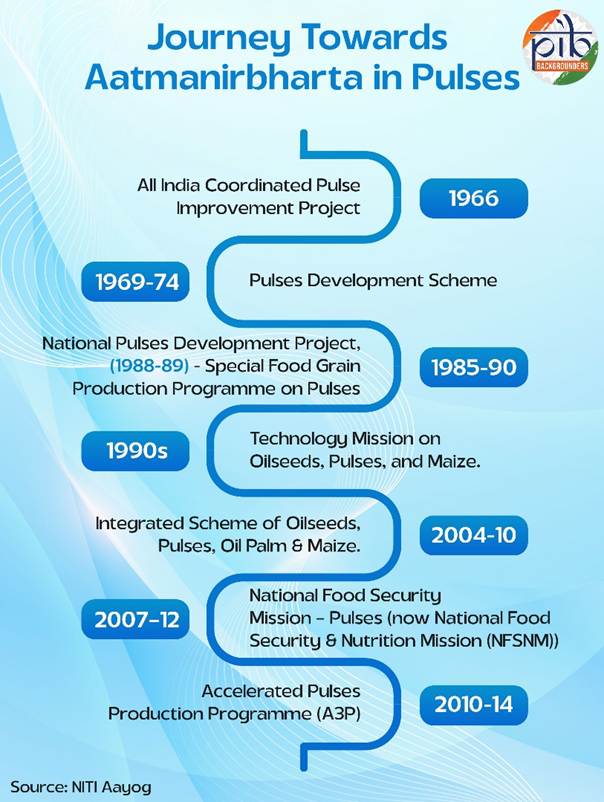
- 14 Oct 2025
In News:
- India has launched an ambitious Mission for Aatmanirbharta in Pulses (2025–26 to 2030–31),signalling a major push toward self-sufficiency in pulses and farmer-centric agricultural transformation.
- Announced during a special programme at the Indian Agricultural Research Institute (IARI), the Mission carries an outlay of ?11,440 crore and aims to meet India’s pulses requirement entirely through domestic production by December 2027.
- Pulses hold strategic importance for India as they ensure nutritional security, enrich soil through nitrogen fixation, support rural livelihoods, and reduce import bills. Despite being the world’s largest producer and consumer, India's demand-supply gap has led to significant imports—47.38 lakh tonnes in 2023-24. The Mission seeks to eliminate this dependence and strengthen farmer income security.
Key Targets (by 2030–31)
- Total production:350 lakh tonnes
- Cultivation area:310 lakh hectares (including 35 lakh ha rice fallows)
- Yield target:1,130 kg/ha
- Beneficiaries: Nearly 2 crore farmers
- Import elimination by Dec 2027
Core Components of the Mission
Seed & Technology Push
- 126 lakh quintals of certified seeds
- 88 lakh free seed kits
- Deployment of high-yielding, pest-resistant, climate-resilient varieties
- Launch of SATHI Portal (Seed Authentication, Traceability & Holistic Inventory) for seed lifecycle transparency
Assured MSP & Farmer Security
- 100% procurement of Tur, Urad, and Masoor for four years
- Procurement support via NAFED & NCCF
- Linked to PM-AASHA for guaranteed price support and reduced market risk
Cluster-Based Integrated Approach
- "One Block – One Seed Village" model
- FPO-driven clusters to streamline seed production & marketing
- Mechanization, soil health management, and balanced fertilization
- Agronomy support from ICAR, KVKs & state agriculture departments
Value Chain Strengthening
- 1,000 processing & packaging unitsincentive: up to ?25 lakh per unit
- Focus on storage, processing, branding, and market linkages
Social and Nutrition Focus
- Inclusion of pulses in PDS, ICDS, Mid-Day Meal schemes
- Strengthening food-based welfare with protein security
NITI Aayog Recommendations Integrated
- Expansion into rice fallows
- Cluster-based cultivation & seed hubs
- “One Block–One Seed Village”
- Data-driven monitoring through SATHI
- Public procurement strengthening at grassroots
- Climate-resilient, short-duration pest-resistant varieties
Strategic Significance
- Supports Vision 2047&Viksit Bharat
- Strengthens food sovereignty & rural employment
- Saves foreign exchange by cutting pulse imports
- Enhances soil fertility & climate resilience
- Boosts farmer incomes and reduces agrarian vulnerability
IUCN Kenton Miller Award 2025
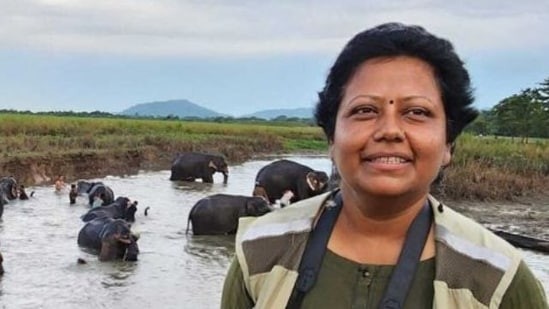
- 14 Oct 2025
In News:
India has achieved a landmark moment in global conservation as Dr. Sonali Ghosh, Field Director of Kaziranga National Park and Tiger Reserve (Assam), became the first Indian to receive the prestigious IUCN WCPA Kenton Miller Award 2025. The honour was announced at the IUCN World Conservation Congress in Abu Dhabi, highlighting India’s rising leadership in biodiversity governance and protected-area innovation.
About the IUCN Kenton Miller Award
- Instituted: 1999
- Presented by:IUCN World Commission on Protected Areas (WCPA)
- Named after: Dr. Kenton R. Miller, eminent conservationist & former IUCN Director-General
- Purpose:Recognisesoutstanding innovation and excellence in the sustainability and governance of protected areas
- Eligibility: Protected-area managers, researchers, community/indigenous conservation practitioners
- Award Components:
- USD 5,000 grant
- Global citation
- Sponsored participation at the IUCN Congress
Significance of Dr. Ghosh’s Contribution
Dr. Ghosh has been awarded for pioneering inclusive and sustainable protected-area management across the Kaziranga-Orang-Manas landscape. Key initiatives include:
- Community-centric conservation: Empowering local and indigenous communities as co-stewards
- Eco-tourism models: Ensuring livelihood security while safeguarding biodiversity
- Anti-poaching and habitat security: Strengthening surveillance and ecological connectivity
- Gender inclusion: Promoting women’s participation in frontline conservation forces
Her leadership reflects India’s approach to biodiversity protection through grassroots participation, science-based governance, and livelihood integration.
Broader Context: India at the IUCN Congress
At the Congress, India reiterated its commitment to global environmental cooperation. Union Minister Kirti Vardhan Singh engaged with international delegates and IUCN leadership on advancing shared conservation goals, reinforcing India's stance as a proactive global environmental actor.
About IUCN and the World Conservation Congress
- Founded: 1948
- HQ: Switzerland
- Global network of governments, NGOs, and experts from 160+ countries
- World Conservation Congress: Held every four years to set global biodiversity priorities
Previous Winner (2023)
- Maria del Carmen Garcia Rivas (Mexico) – Honoured for community-led management of marine protected areas.
International Purple Fest 2025
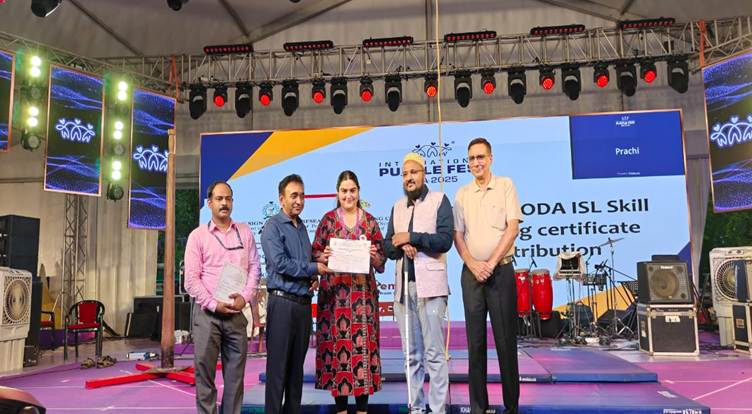
- 14 Oct 2025
In News:
- The International Purple Fest 2025, held in Goa reaffirmed India’s commitment to disability inclusion, accessibility, and empowerment.
- Organized by the Department for Empowerment of Persons with Disabilities (DEPwD) in partnership with the State Commissioner for Persons with Disabilities, Government of Goa, the Ministry of Social Justice & Empowerment, and United Nations India, the Fest promoted the vision of “Inclusion as a Movement.”
- The event positioned inclusive thinking and universal design as the foundation for education, skilling, and social participation of persons with disabilities (PwDs).
Key Initiatives Launched
1. IELTS Training Handbook for Persons with Disabilities
- Developed by Believe in the Invisible (BITI) with DEPwD support
- Authored by Anjali Vyas, British Council-certified trainer
- India’s first comprehensive accessible IELTS guide for candidates with visual, hearing, locomotor, and other disabilities
- Features:
- Step-by-step learning modules, skill-building tools, and lesson plans
- Accessible practice exercises, time-management support, grammar and vocabulary tips
- Integrated Indian Sign Language (ISL) video links
- Objective: Promote equitable access to global education and skill mobility
2. RPL Certification in ISL Interpretation
- Conducted by Indian Sign Language Research and Training Centre (ISLRTC) under the Skill Training Initiative of DEPwD
- Trained and evaluated SODA (Siblings of Deaf Adults) and CODA (Children of Deaf Adults) from across India
- First batch completed in August 2025, certificates to be awarded on 3 December 2025 (International Day of PwDs)
- Significance: Expands India’s certified ISL interpreter pool and formalizes community-based linguistic skills
3. Specialized Training in American & British Sign Languages
- One-month programme by ISLRTC commencing 3 December 2025
- Focus: Fundamentals of American Sign Language (ASL) and British Sign Language (BSL) — grammar, syntax, vocabulary
- Aim: Provide international exposure to Indian ISL professionals and enhance global employment opportunities
Significance
- Strengthens the National Education Policy’s inclusion mandate
- Builds skilled interpreters to meet growing demand in education, healthcare, public services, and courts
- Promotes disability-inclusive skilling aligned with the Rights of Persons with Disabilities Act, 2016
- Enhances India’s visibility in global disability rights discourse
Operation Golden Sweep

- 14 Oct 2025
In News:
The Directorate of Revenue Intelligence (DRI) has successfully dismantled a sophisticated international gold smuggling syndicate through “Operation Golden Sweep” at Mumbai’s Chhatrapati Shivaji Maharaj International Airport. The enforcement action, based on precise intelligence inputs, reflects India’s strengthened efforts to curb illicit financial flows and protect economic security.
Key Highlights
- Gold Seized: 10.488 kg of 24-carat gold
- Estimated Value: ?12.58 crore
- Arrests: 13 individuals — including foreign nationals (Bangladesh & Sri Lanka), airport staff, handlers, and the key mastermind
- Objective: Disrupt organised smuggling networks that erode foreign exchange reserves and threaten national security
Modus Operandi
The syndicate used an advanced and covert smuggling technique:
- Transit passengers flying from Dubai to Singapore, Bangkok, and Dhaka, routing via Mumbai, served as carriers
- Gold was concealed in egg-shaped wax capsules internally
- On arrival, gold was discreetly handed to complicit airport personnel within the international departure zone
- Airport insiders then smuggled the gold out and delivered it to handlers, who coordinated with the mastermind based in Mumbai and Dubai
This exposure underscores a rising insider threat in critical aviation infrastructure, where organised networks exploit privileged access.
Significance of the Operation
- Demonstrates DRI’s intelligence-driven enforcement, rapid execution, and inter-agency coordination
- Highlights evolving trade-based and route-based smuggling tactics
- Reinforces India's commitment to financial integrity, supply-chain security, and national economic interests
IUCN World Heritage Outlook 2025
- 14 Oct 2025
In News:
- The IUCN World Heritage Outlook 4, to be launched at the IUCN World Conservation Congress 2025 in Abu Dhabi, represents the world’s most comprehensive periodic evaluation of the conservation status of UNESCO natural and mixed World Heritage Sites.
- Conducted every 3–5 years by the International Union for Conservation of Nature (IUCN) and the World Commission on Protected Areas (WCPA), it provides an independent, transparent assessment of protection efforts, threats, and future prospects for these globally significant ecosystems.
Purpose and Significance
The Outlook functions as a global conservation barometer designed to:
- Monitor the state of conservation of natural World Heritage Sites
- Highlight exemplary site management and transfer of best practices
- Provide early warnings for ecological degradation and governance failures
- Bridge data gaps through expert-led evaluation and advanced monitoring tools
- Showcase the societal and ecological benefits of natural heritage, including livelihoods, disaster resilience, and carbon storage
This mechanism complements UNESCO’s statutory monitoring under the 1972 World Heritage Convention, strengthening global efforts to realize the Kunming–Montreal Global Biodiversity Framework (KM-GBF) targets by 2030.
Global Conservation Outlook: Key Findings (2025)
- ~65% of sites show stable or improving health since 2020, reflecting enhanced governance and restoration actions. Example: Galápagos Islands, Yellowstone National Park
- Over 80% of sites face direct climate threats—coral bleaching, glacier retreat, wildfires. Example: Great Barrier Reef
- ≈60% experience pressures from invasive species, habitat loss, and unsustainable resource use
- Marine sites like Komodo National Park (Indonesia) and Aldabra Atoll (Seychelles) show progress through sustainable tourism and science-based management
- Technology integration (AI, satellite mapping, eDNA) is improving real-time monitoring. Example: AI-enabled wildlife tracking in Okavango Delta
- Around 15 sites have moved into the Danger List due to conflict, pollution, and climate impacts
- Natural World Heritage sites hold ~10% of global terrestrial carbon, underlining their climate role
Natural World Heritage: Global Profile (2024)
- 271 sites with natural Outstanding Universal Value
- 231 natural, 40 mixed
- 22% of all World Heritage properties (1,223 total)
- Over 470 million hectares protected across land and sea
- Represent ~8% of global protected area coverage
- Spread across 115 countries
- Africa: 47
- Asia-Pacific: 85
- Europe & North America: 83
- Latin America & Caribbean: 47
- Arab region: 9
- 18 transboundary sites; 15 in Danger List
India: Trends and Insights
India hosts 7 natural and mixed World Heritage Sites, spanning the Himalayas to coastal wetlands, constituting ~1.5% of global natural WH coverage.
Positive developments
- Kaziranga&Manas: Improved biodiversity and anti-poaching success through community stewardship and regulated ecotourism
Sites of concern
- Sundarbans: Declining mangroves due to salinity rise, cyclones, and sea-level change
- Western Ghats: Pressures from mining, infrastructure, and land-use conflicts
- Nanda Devi & Great Himalayan National Park: Glacial melt and invasive species affecting Himalayan watersheds
Policy support
- Wildlife (Protection) Amendment Act, 2022
- LiFE Mission for sustainable lifestyles aligned with KM-GBF
- Funding gaps: ~30–40% higher financial allocation needed, especially for marine and transboundary sites
Major Challenges
|
Challenge |
Impact |
|
Climate change |
Coral bleaching, glacial retreat, desertification |
|
Unsustainable development |
Habitat fragmentation, tourism pressure |
|
Funding shortfalls |
Inadequate staffing, weak surveillance |
|
Governance issues |
Overlapping mandates, weak enforcement |
|
Biodiversity data gaps |
Limits adaptive and real-time conservation |
Recommendations
- Climate-resilient planning: Integrate heritage into national climate strategies. Example: Aligning LiFE and National Adaptation Fund with site targets
- Green financing: Carbon credits, biodiversity funds, CSR, eco-investment
UNDP–GEF BIOFIN as model - Local and Indigenous partnership: Community co-management and benefit-sharing. Example: Eco-Development Committees in Manas and Periyar
- Tech-enabled conservation: AI surveillance, remote sensing, eDNA, drones. Example: IUCN Global Ecosystem Atlas initiative
- Transboundary cooperation: Joint research and ecological corridors. Example: India–Nepal Terai Arc Landscape
Viksit Bharat Buildathon 2025
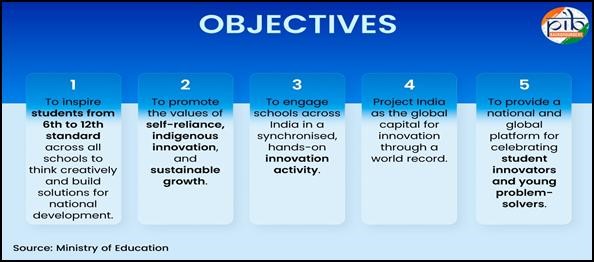
- 13 Oct 2025
In News:
The Viksit Bharat Buildathon 2025 is a nationwide innovation movement being organised by the Department of School Education & Literacy (DoSEL), Ministry of Education, in collaboration with Atal Innovation Mission, NITI Aayog.
- This largest-ever school hackathon aims to strengthen the culture of innovation at the school level by encouraging students to ideate or build prototypes on four themes: Atmanirbhar Bharat, Swadeshi, Vocal for Local, and Samriddh Bharat.
- The Buildathon aims to foster innovation, creativity, and problem-solving among our youth so that they become key drivers of a prosperous, developed, and self-reliant India.
The Buildathon will provide hands-on, experiential learning in line with the National Education Policy (NEP) 2020. Participation is inclusive with special focus on Aspirational Districts, Tribal and Remote Regions.
Key Features
- Dedicated Portal: There is a national portal for registration and submission of final entries (ideas or prototypes)
- Mode of Participation: A team of 3-5 students will participate in the Buildathon and submit entries (ideas/prototypes) in the form of videos. There will be no limit on the number of teams from a school.
- Mentorship Support: Dedicated support will be provided by volunteers and mentors from Incubation Centres, Mentor of Change Network, Higher Education Institutions, and Corporates to help students build their projects at the school level.
- National Live Event: National level virtual live streaming session will be organised, which shall be joined by all schools (6th to 12th standard).
- Global Streaming: The event will be streamed on nationwide news and media channels.
- Inclusive Spotlight: A Special spotlight will be given to schools from Aspirational Blocks, Tribal Regions, Frontier Villages, and Remote Areas.
- District & State-Level Events: Schools will conduct Innovation activities. States are encouraged to organise community level innovation events inviting multiple schools and dignitaries.
- Submission of Entries: Post-event, schools will submit videos of their innovation entries (Ideas or Prototypes).
How to Participate
- Eligibility: Participation is open to all school students from class 6-12, across India. Students must form a team of 3-5 members from same schools. Students can register with the help of their teachers. There is no restriction on the number of teams per school.
- Registration of Team: Schools/teachers have to encourage students to form teams and then register their teams on the official Buildathon portal after which a unique registration ID will be generated for each team. The Registration Link for schools for Viksit Bharat Buildathon is - vbb.mic.gov.in
- Selection of Theme: Each team will need to choose one out of the four Buildathon themes and identify any problem statement.
- Brainstorm & Build: The team will ideate to solve community problems.
- Prepare for Submission: Teams will be required to create a 2–5 minute video explaining the problem it is solving, the innovative solution/prototype they have created, how it works and its possible impact.
- Submission: The project video/ summaries have to be submitted on the Portal within the submission window of Oct. 13 to Oct. 31, 2025
Awards
- A panel of experts will evaluate the entries, and the top student teams will be awarded prizes. These schools and students will receive long-term support through corporate adoption, mentorship, and resources to further strengthen their innovations.
- There will be an Awards Pool of Rs. 1 Crore, with 10 National Level winners, 100 State level winners and 1000 District level winners.
AI for Inclusive Societal Development
- 13 Oct 2025
In News:
- NITI Aayog has released a landmark study titled “AI for Inclusive Societal Development”, shifting India’s artificial intelligence discourse toward the informal workforce, which constitutes the backbone of the national economy. This first-of-its-kind framework seeks to harness AI and frontier technologies to formalise and uplift nearly 490 million informal workers, who contribute around 45% of India’s GDP but remain largely excluded from institutional protections and productivity systems.
- At the core of this initiative is the proposed National Mission “Digital ShramSetu”, conceptualised as a technology-enabled bridge connecting informal workers to formal systems of work, finance, skilling, and social protection — a critical step for achieving the Viksit Bharat 2047 vision.
Mission Digital ShramSetu: Vision & Framework
Objective:To drive large-scale socio-economic inclusion by integrating AI, blockchain, robotics, IoT, AR/VR, and immersive learning into workforce development.
Key Components
|
Pillar |
Purpose |
|
Digital Identity & Trust |
Verifiable worker IDs and credentials for payments, loans, and welfare access |
|
Tech-Enabled Skilling |
Multilingual, adaptive, offline-enabled training for real-world tasks |
|
Blockchain-Based Smart Contracts |
Automated, transparent, dispute-free wage payments |
|
Federated Credentialing |
Real-time validation of skills by government, employers, institutions |
|
Grassroots Outreach |
Collaboration with state bodies and civil society to improve digital literacy and adoption |
|
Apex Governance |
Mission chaired at PM-level with sectoral task forces (agri, healthcare, retail, construction) and state units |
India’s Informal Workforce: Current Realities
- Size: ~490 million workers (≈85% of labour force)
- GDP Share: ~45%
- Productivity: ~USD 5/hour vs national avg. USD 11/hour
- Annual Per Capita Income: ~USD 1,800 (projected USD 6,000 by 2047 if status quo continues; target ≈ USD 14,500)
- Women’s Informal Sector Participation: ~15% (ex-agriculture) vs 37% national avg & 47% global avg
- Social Security Access: ~48%
- Formalisation Vision: Reduce informal sector to 40% by 2047; formalise73.2% of current informal enterprises
Existing Support Tools:e-Shram Portal, PM-JJBY, PM-SYM, Atal Pension Yojana, Micro-lending schemes, Skill India programmes
Challenges Confronting Informal Workers
- Income Instability & Wage Delays: No contracts; reliance on informal credit
- Limited Market Access: Fragmented, unorganised demand; lack of digital presence
- Low Skilling & Tech Adoption: Traditional workflows; language & literacy barriers
- Poor Social Security Coverage: Non-portable records and scheme awareness gaps
- Migrant Vulnerability: No portable credentials or employment networks
- Safety Risks: Hazardous work environments without monitoring support
Institutional & Policy Architecture
- Apex Mission Leadership: PM-level council for policy, funding & coordination
- Sector-Specific Task Forces: Agriculture, construction, healthcare, retail etc.
- State Coordination Units: Local deployment, innovation hubs, adoption drives
- Partnership Ecosystem: Government, industry coalitions (CII, NASSCOM), World Bank, global philanthropies & academia
Why It Matters
The roadmap stresses that technology alone is insufficient; success depends on human-centric deployment, affordability, and multi-stakeholder collaboration. With proactive adoption, India can multiply informal productivity, enhance incomes, reduce vulnerability, and transition toward a high-productivity, high-trust labour economy. Delay, however, could lock millions into low-income traps, weakening India's development trajectory.
Saksham Counter-Unmanned Aerial Threat Grid System
- 13 Oct 2025
In News:
- The Indian Army has initiated induction and fast-track procurement of “SAKSHAM” (Situational Awareness for Kinetic Soft and Hard Kill Assets Management), an indigenously developed, AI-enabled Counter-Unmanned Aerial System (C-UAS) grid created with Bharat Electronics Limited (BEL).
- Designed as a modular Command & Control (C2) backbone, SAKSHAM provides real-time detection, tracking, identification and neutralisation of hostile drones and other low-altitude aerial threats across the specially defined Tactical Battlefield Space (TBS) or Air Littoral — the airspace up to 3,000 metres (≈10,000 ft) above the ground.
What SAKSHAM is — technical outline
- Purpose: A unified C2 grid to secure ground formations by controlling low-altitude airspace, countering drone surveillance, weaponised UAS and swarms.
- Developer & partners: Designed and developed indigenously by Bharat Electronics Limited (BEL) in collaboration with the Indian Army’s Corps of Air Defence.
- Architecture & connectivity: Operates over the encrypted Army Data Network (ADN) and presents a GIS-based, common recognised air picture that fuses data from C-UAS sensors, friendly and hostile UAS feeds, and both soft- and hard-kill effectors.
- AI & fusion capabilities: Uses AI/ML-driven fusion to automate threat classification (friendly / neutral / hostile), prioritise responses, and support automated or semi-automated soft-kill (jamming/spoofing) and hard-kill (kinetic) decisions.
- Interoperability: Integrates inputs from India’s automated air-defence network Akashteer and is designed for plug-and-play addition of sensors, jammers, lasers/EMP and future upgrades.
Why SAKSHAM was conceptualised
The Army’s operational experience during Operation Sindoor (2025) — where hostile drone activity exposed detection and response gaps — accelerated the need for a comprehensive C-UAS framework and a shift from traditional Tactical Battle Area concepts to the more inclusive Tactical Battlefield Space (TBS) that explicitly includes the Air Littoral. SAKSHAM is a direct response to those operational lessons.
Operational and strategic impact
- Enhanced situational awareness: A common, real-time air picture shortens decision loops and reduces fratricide risk while allowing freedom of manoeuvre for friendly aerial assets.
- Force protection & deterrence: Rapid detection and neutralisation of drone threats protects troops, logistics nodes and infrastructure from ISR (intelligence, surveillance, reconnaissance) and weaponised UAS attacks.
- Atmanirbhar capability: Indigenous design and BEL partnership strengthen defence manufacturing and upgradeability—key to the Army’s Decade of Transformation (2023–2032) and wider strategic autonomy.
- Scalability & integration: FTP approval and modular design aim for rapid rollout across field formations, enabling layered C-UAS coverage and future networked integration with other services and civil air-safety systems.
DRAVYA Portal

- 13 Oct 2025
In News:
The Ministry of Ayush has launched the DRAVYA (Digitised Retrieval Application for Versatile Yardstick of Ayush) portal, developed by the Central Council for Research in Ayurvedic Sciences (CCRAS), marking a major step towards the digital transformation of traditional medicine systems in India. Announced during the 10th Ayurveda Day celebrations in Goa (23 September 2025), the initiative aligns with India's vision of integrating ancient medical wisdom with contemporary scientific tools.
Objective and Vision
DRAVYA aims to create a scientifically validated, AI-enabled knowledge repository that consolidates data on medicinal substances used across Ayush systems. In its first phase, the platform will document 100 key medicinal substances, with scope for continuous expansion.
The portal seeks to:
- Digitise and unify classical and modern knowledge on medicinal substances
- Enable evidence-based research and innovation
- Support cross-disciplinary collaboration across Ayurveda, botany, chemistry, and pharmacology
- Standardise and globally disseminate authentic Ayush data
Key Features
|
Feature |
Details |
|
AI-ready architecture |
Supports advanced analytics, research mapping, future tech integration |
|
Open-access platform |
Makes verified data globally accessible |
|
QR-code integration |
Enables standardised medicinal plant identification in gardens and repositories |
|
Comprehensive dataset |
Pharmacotherapeutics, botany, chemistry, pharmacy, pharmacology & safety profiles |
|
User-friendly design |
Intuitive search system covering classical texts and modern scientific references |
|
Ayush Grid linkage |
Facilitates interoperability with other digital health systems and policy platforms |
Impact and Significance
- Knowledge Modernisation:DRAVYA bridges traditional Ayurvedic knowledge with contemporary scientific validation, enhancing credibility and global acceptance of Indian medical systems.
- Research Advancement:Supports scholars, practitioners, and policymakers with standardised, authentic, real-time updated data, strengthening evidence-based drug development and pharmacopoeialstandardisation.
- Global Accessibility & Innovation:By making curated research internationally accessible, DRAVYA promotes collaborative innovation, pharmaceutical research, and knowledge-driven growth of the Ayush sector.
Nobel Prize in Literature 2025
- 13 Oct 2025
In News:
- The 2025 Nobel Prize in Literature has been conferred on László Krasznahorkai, the Hungarian novelist celebrated for his profoundly philosophical and apocalyptic prose.
- The Swedish Academy recognized him for his ability to capture the “tension between ruin and redemption” and for reaffirming the enduring power of art in an age of crisis.
About the Nobel Prize in Literature
- Established under Alfred Nobel’s will (1895), the Nobel Prize in Literature is awarded annually by the Swedish Academy to an author who has produced “the most outstanding work in an ideal direction.”
- The award, accompanied by a cash prize of 11 million Swedish crowns (≈ USD 1.2 million), represents the highest global recognition in the literary world.
Life and Background
- Born in 1954 in Gyula, Hungary, near the Romanian border, Krasznahorkai grew up amid the tensions of post-war socialism.
- Educated in law and literature in Budapest, his early life in a repressive political climate shaped his preoccupation with decay, faith, and endurance. His Jewish and rural background deepened his sensitivity to questions of identity and moral collapse.
Literary Career and Major Works
Krasznahorkai made his literary debut with Sátántangó (1985), a dark, surreal portrayal of a disintegrating collective farm that has since become a modern classic. Its cinematic adaptation by Béla Tarr as a seven-hour film further cemented its cult status.
His subsequent works expanded his thematic range:
- The Melancholy of Resistance (1989): Explores moral and social decay under authoritarianism in a small Hungarian town.
- War and War (1999): A meditation on history, violence, and transcendence through the story of an archivist.
- Seiobo There Below (2008): Reflects his deep engagement with Asian philosophies and aesthetics, particularly from Japan and China.
- Herscht 07769 (2018): A study of German social unrest and the search for order amid chaos.
Themes and Literary Style
- Krasznahorkai’s fiction fuses metaphysical inquiry with social critique. His narratives depict societies on the brink of collapse, where individuals confront spiritual drift, institutional decay, and existential dread.
- Stylistically, his long, recursive sentences and dense, rhythmic prose challenge readers to engage deeply with the text. His influences range from Franz Kafka and Samuel Beckett to Thomas Bernhard, yet his vision remains uniquely his own — a fusion of absurdism, grotesque realism, and mystical introspection.
International Recognition and Legacy
- Over four decades, Krasznahorkai has emerged as one of Europe’s most formidable literary voices. His earlier accolades include the Kossuth Prize (2004), Hungary’s highest cultural honor, and the Man Booker International Prize (2015).
- His global reach reflects a bridge between Central European existentialism and Eastern contemplative traditions, making his work both regionally grounded and universally resonant.
Supreme Court on Retrospective Application of the Surrogacy (Regulation) Act 2021
- 12 Oct 2025
In News:
In a landmark ruling, the Supreme Court of India held that the age restrictions prescribed under the Surrogacy (Regulation) Act, 2021 cannot be applied retrospectively to couples who had already initiated the surrogacy process or had frozen embryos prior to the law’s enforcement. The judgment marks a critical reaffirmation of reproductive autonomy, fairness, and the right to privacy under the Constitution.
Background
Several couples who had preserved embryos before the Surrogacy (Regulation) Act, 2021 came into force approached the Supreme Court after being denied permission to proceed with surrogacy due to the Act’s upper age limit clause.The Act, effective January 25, 2022, mandates that:
- The woman must be between 23 and 50 years, and
- The man must be between 26 and 55 years.
These couples contended that applying such limits retroactively violated their vested reproductive rights and their right to parenthood under Article 21 of the Constitution.
Supreme Court’s Judgment
A Bench comprising Justice B.V. Nagarathna and Justice K.V. Viswanathan ruled in favour of the petitioners, stating that the rights of intending parents crystallised at the time they froze embryos, when no statutory age bar existed. Therefore, the new restrictions cannot invalidate actions undertaken under the previous legal regime.
Key Observations
- Doctrine of Fairness:The Court held that retrospective laws that impair vested rights or impose new burdens violate the principle of fairness and legal certainty, forming part of India’s constitutional jurisprudence.
- Right to Privacy and Bodily Autonomy:Drawing from K.S. Puttaswamy v. Union of India (2017), the bench affirmed that reproductive decisions — including the choice to conceive through surrogacy — are protected under Article 21, which guarantees the right to life and personal liberty.
- Gender and Equality Lens:The Court noted that a restrictive interpretation disproportionately impacts women, who already face biological and societal limitations in reproduction, and cannot be penalised for delays beyond their control.
- Right to Parenthood:Justice Nagarathna emphasised that parenthood is a matter of personal autonomy and that the State cannot judge the parenting capabilities of couples merely based on age.
She observed:
“Before 2021, there were no binding laws on age restrictions for intending couples. Hence, their right to proceed with surrogacy remains valid.”
- Rebuttal to Government’s Argument:The Centre had argued that age limits were meant to protect the welfare of children born through surrogacy, assuming older parents might not meet long-term responsibilities.
The Court rejected this view, pointing out that no such limits exist for couples conceiving naturally, making the argument inconsistent.
About the Surrogacy (Regulation) Act, 2021
Objective: To regulate surrogacy procedures in India by allowing only altruistic surrogacy and prohibiting commercial surrogacy, with an emphasis on protecting surrogate mothers and children from exploitation.
Key Provisions
|
Category |
Provisions |
|
Intending Couple Eligibility |
Indian citizens, married for at least 5 years; Woman aged 23–50, Man aged 26–55; must prove medical infertility. |
|
Surrogate Mother Eligibility |
A married woman aged 25–35 years, with at least one biological child. |
|
Institutional Mechanism |
National and State Surrogacy Boards and Appropriate Authorities to regulate licensing, ethics, and compliance. |
|
Penalties |
Commercial surrogacy, or sale of gametes/embryos, punishable by up to 10 years imprisonment and fines up to ?10 lakh. |
Significance of the Judgment
- Upholds Constitutional Morality:Reaffirms that legislative intent must align with constitutional values of fairness, equality, and liberty.
- Protects Reproductive Autonomy:Strengthens the legal recognition of reproductive choices as an intrinsic part of individual dignity and privacy.
- Ensures Legal Certainty:Prevents retrospective penalisation of couples who acted in good faith under the pre-existing legal framework.
- Gender Justice and Inclusivity:Acknowledges women’s agency and safeguards them from arbitrary restrictions that could hinder their reproductive timelines.
- Balances Regulation and Rights:While the State’s intent to regulate surrogacy is legitimate, the ruling ensures such regulation does not override fundamental rights or vested personal decisions.
Foreign Currency Settlement System
- 12 Oct 2025
In News:
In October 2025, Union Finance Minister Nirmala Sitharaman launched the Foreign Currency Settlement System (FCSS) at the International Financial Services Centre (IFSC) in GIFT City, Gujarat. This marks a transformative step in India’s financial ecosystem, placing GIFT City among leading global financial hubs such as Hong Kong, Tokyo, and Singapore.
What is the Foreign Currency Settlement System (FCSS)?
The FCSS is a real-time payment and settlement mechanism that enables entities operating within GIFT IFSC to conduct and settle foreign currency transactions (initially in USD) locally — eliminating the dependence on foreign correspondent banks.
Key Highlights
- Real-Time Settlements: Transactions that earlier took 36–48 hours through correspondent banking now settle in 4–5 seconds.
- Regulatory Framework: Operates under the Payment and Settlement Systems (PSS) Act, 2007, authorised by the International Financial Services Centres Authority (IFSCA).
- System Operator:CCIL IFSC Ltd, a subsidiary of the Clearing Corporation of India Ltd (CCIL).
- Technology Partner:Indian Financial Technology & Allied Services (IFTAS), a wholly-owned subsidiary of the Reserve Bank of India (RBI).
- Settlement Bank:Standard Chartered Bank serves as the initial settlement partner.
How Does It Work?
Under the FCSS framework:
- Each participating bank’s IFSC Banking Unit (IBU) maintains an account with a designated local settlement bank.
- Inter-bank foreign currency transactions are cleared and settled within GIFT City, avoiding the complex multi-leg Nostro account chains used abroad.
- The system ensures secure, transparent, and regulated processing of global transactions under the IFSCA’s oversight.
Why It Matters – Strategic Significance
- Reduces Dependence on Overseas Systems: Earlier, entities in GIFT IFSC relied on foreign banks for USD, euro, or yen settlements, leading to delays, higher costs, and exposure to external risks. FCSS eliminates this dependence by localising global settlements within India.
- Enhances Liquidity and Efficiency: The system allows near-instant settlement, improving liquidity management for banks and financial institutions. It reduces counterparty and settlement risks while enabling smoother cross-border trade and investment.
- Boosts India’s Global Financial Standing: By offering a robust settlement mechanism, GIFT City now joins an elite league of financial centres with domestic forex settlement capabilities, strengthening India’s position as an emerging global financial hub.
- Promotes Financial Inclusion for Indian Entities: With lower transaction costs, faster settlement times, and reduced reliance on foreign intermediaries, Indian corporates and banks can manage international transactions more efficiently within domestic jurisdiction.
- Supports Multi-Currency Expansion: While the system currently supports the US Dollar, it is designed to incorporate other major currencies such as the Euro, Pound Sterling, and Japanese Yen, ensuring scalability and global integration.
About GIFT City: India’s Global Financial Gateway
- Full Form: Gujarat International Finance Tec-City (GIFT City).
- Location: Between Ahmedabad and Gandhinagar, Gujarat.
- Regulator: International Financial Services Centres Authority (IFSCA) — established in 2020 as a unified regulator for all financial services within the IFSC.
- Nature: A Special Economic Zone (SEZ) that operates as a liberalised financial jurisdiction under Indian sovereignty, with tax incentives, global regulations, and ease-of-doing-business provisions.
Achievements So Far
- Hosts over 1,000 registered entities, including global banks, insurance firms, fintechs, and asset managers.
- Houses India INX and NSE IX, offering 22-hour trading in global securities.
- Developed India’s first aircraft and ship leasing ecosystem, attracting global lessors and fund managers.
- Emerging hub for offshore derivative instruments, green bonds, and ESG investments.
Economic Rationale Behind GIFT City
- Before GIFT City, many Indian companies preferred offshore hubs such as Singapore or Mauritius for fund-raising and financial operations due to friendlier regulatory environments. This resulted in capital outflow and revenue loss for India.
- GIFT City’s creation aimed to repatriate offshore financial activities, foster global competitiveness, and position India as a financial intermediary for international capital flows.
India’s National Red List Roadmap
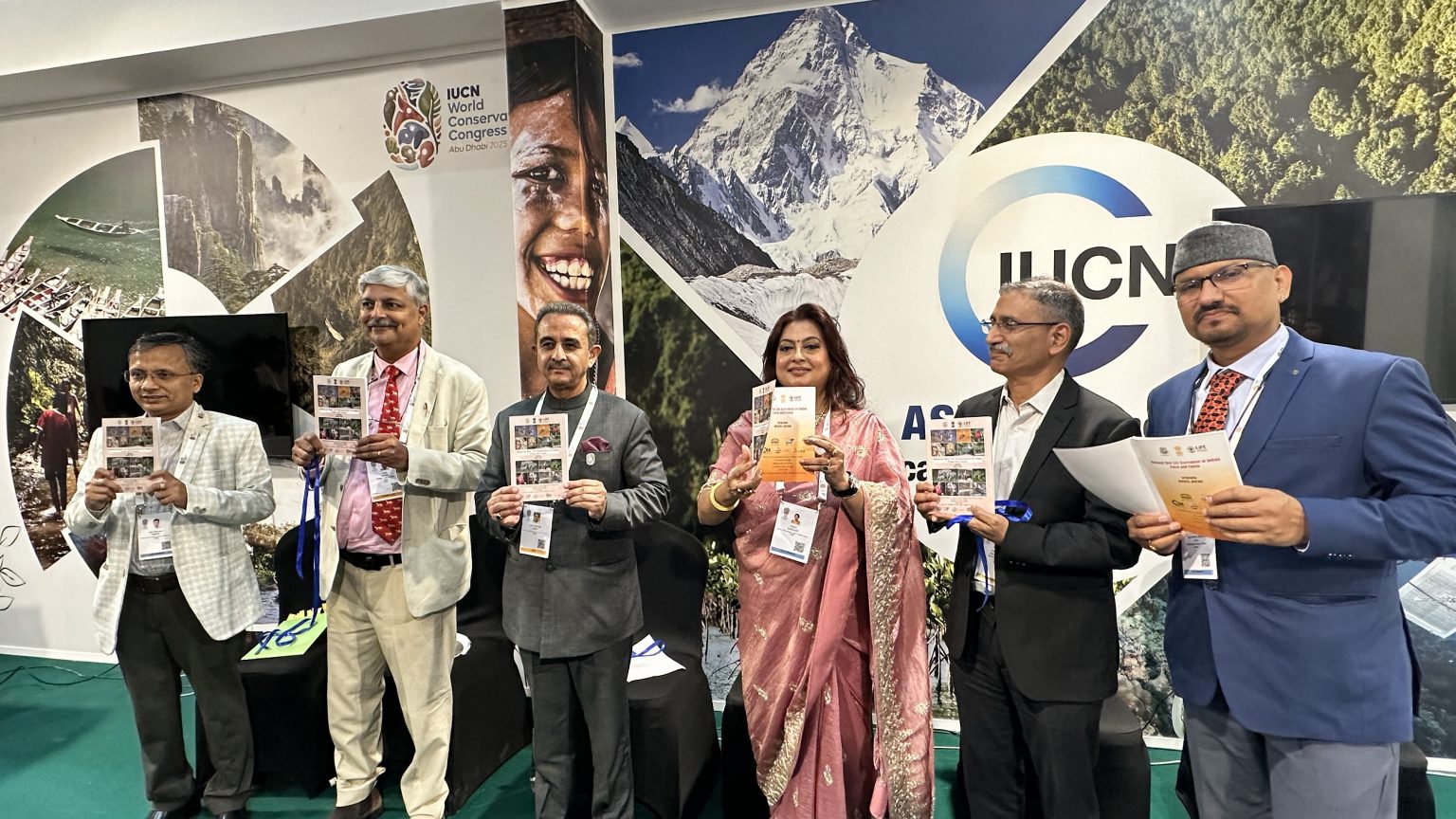
- 12 Oct 2025
In News:
At the IUCN World Conservation Congress 2025 in Abu Dhabi, India launched its National Red List Roadmap and Vision 2025–2030, marking a significant milestone in national biodiversity documentation and conservation policy. The initiativerepresents India’s commitment to establishing a comprehensive, science-based framework for assessing species and shaping long-term conservation priorities.
The National Red List Roadmap: Overview and Objectives
The National Red List Roadmap is India’s first integrated national initiative to identify, classify, and conserve threatened species across ecosystems — terrestrial, freshwater, and marine — in alignment with IUCN global standards.
It seeks to:
- Develop a nationally coordinated and inclusive red-listing system for flora and fauna.
- Generate baseline data and threat assessments to guide evidence-based policymaking.
- Strengthen India’s obligations under the Convention on Biological Diversity (CBD) and the Kunming–Montreal Global Biodiversity Framework (KMGBF).
- Foster collaboration among scientists, conservationists, and local communities to ensure equitable biodiversity protection.
The programme will culminate in the publication of India’s National Red Data Books for flora and fauna by 2030, creating an authoritative reference for conservation planning.
Institutional Collaboration
The roadmap is jointly prepared by:
- Zoological Survey of India (ZSI)
- Botanical Survey of India (BSI)
- IUCN-India, and
- Centre for Species Survival (CSS), India
This inter-agency collaboration ensures a unified system that combines scientific taxonomy, digital technology, and local knowledge systems to monitor and protect India’s biological diversity.
Vision 2025–2030: India’s Strategic Conservation Blueprint
The Vision 2025–2030 document provides a forward-looking framework to guide biodiversity governance over the next decade. It focuses on data-driven conservation, institutional synergy, and community participation, aligning with the UN Sustainable Development Goals (SDGs) and KMGBF targets.
Key Objectives:
- Establish a centralised biodiversity database for national-level coordination.
- Enhance species identification and taxonomy through expert collaboration.
- Integrate digital tools, GIS mapping, and field surveys for real-time species monitoring.
- Build a network connecting scientific institutions, local communities, and policymakers.
- Promote inclusive and equitable participation of indigenous and local communities in conservation processes.
By 2030, India aims to complete comprehensive species assessments, update threat categories, and integrate the results into national wildlife action plans and climate strategies.
India’s Biodiversity Profile
India is recognised as one of the 17 megadiverse countries in the world and hosts four of the 36 global biodiversity hotspots — the Himalayas, Western Ghats, Indo-Burma, and Sundaland.
Key Statistics:
- Covers 2.4% of global land area but supports nearly 8% of global flora and 7.5% of global fauna.
- Houses over 104,000 faunal species, 18,000 species of flowering plants, and around 20,000 marine species.
- Approximately 28% of plant species and 30% of animal species are endemic to India.
These figures underscore India’s ecological richness and the urgency for systematic monitoring and protection.
Legal and Policy Backing
- The initiative aligns with India’s robust legal framework for biodiversity conservation, anchored in the Wild Life (Protection) Act, 1972, which was amended in 2022 to extend protection to species listed under the CITES Appendices.
- The National Red List Roadmap will complement existing programmes like the National Biodiversity Mission, National Wildlife Action Plan, and Integrated Development of Wildlife Habitats, ensuring that conservation decisions are guided by scientific evidence and threat analysis.
Significance for Conservation Policy
- Evidence-Based Decision-Making: The roadmap institutionalises data-backed conservation planning.
- National Accountability: Regular species assessments will help monitor progress under national and global biodiversity targets.
- Scientific Collaboration: Encourages coordination among researchers, policymakers, and conservation agencies.
- Public Engagement: Integrates traditional ecological knowledge and community-driven documentation.
- Global Alignment: Reinforces India’s commitment to the Kunming–Montreal Global Biodiversity Framework and CBD Aichi Targets.
India–Afghanistan Relations Amid Taliban Diplomacy
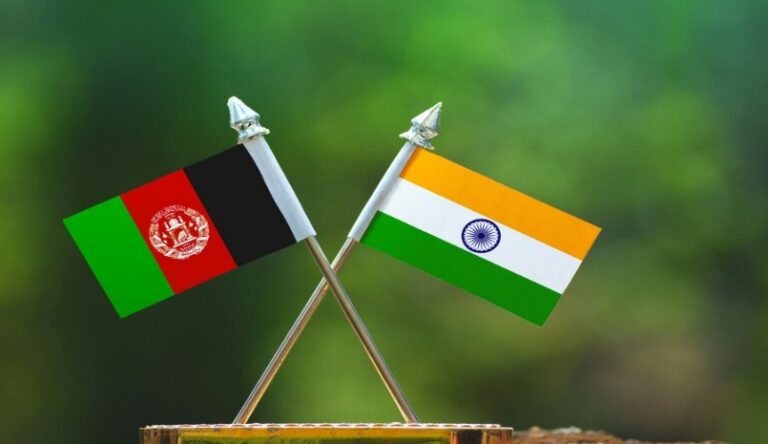
- 12 Oct 2025
In News:
Afghanistan’s Foreign Minister Amir Khan Muttaqi’s six-day visit to India marks the first high-level interaction between New Delhi and the Taliban government since 2021. The visit reflects India’s cautious yet pragmatic attempt to re-engage diplomatically with Kabul amid evolving regional dynamics.
Historical Foundations of India–Afghanistan Relations
The relationship between India and Afghanistan is rooted in civilisational, cultural, and strategic linkages that predate modern statehood.
- Civilisational Bonds: The ancient Kabul–Gandhara–Taxila corridor served as a conduit for trade and Buddhist exchanges, shaping a shared heritage.
- Political Affinity: After 1947, Afghanistan stood apart by opposing Pakistan’s admission to the UN, signalling early alignment with India.
- Developmental Partnership: Since 2001, India has invested over $3 billion in Afghanistan’s reconstruction, building major projects like the Salma Dam, Afghan Parliament, and the Zaranj–Delaram Highway, solidifying India’s goodwill.
- Humanitarian Outreach: Even after the Taliban takeover in 2021, India sustained “people-centric engagement” by supplying 50,000 tonnes of wheat, medicines, vaccines, and scholarships — reflecting its long-term commitment to the Afghan people.
India’s Strategic Calculus Behind Engagement
India’s current approach combines realism and restraint, shaped by five key strategic considerations:
a. Regional Stability and Connectivity
- Afghanistan remains crucial to India’s access to Central Asian energy markets.
- Projects like Chabahar Port and the International North–South Transport Corridor (INSTC) rely on Afghan stability for viability.
b. Countering Pakistan and China
- Taliban-led Afghanistan has seen strained ties with Pakistan while engaging with China’s BRI framework.
- India’s outreach seeks to dilute Pakistan’s strategic depth and limit China’s westward expansion through CPEC.
c. Counterterrorism and Security Cooperation
- Groups such as Lashkar-e-Taiba (LeT), Jaish-e-Mohammed (JeM), and Islamic State–Khorasan Province (ISKP) operate from Afghan soil.
- Diplomatic engagement allows for intelligence sharing, counterterror coordination, and crisis management.
d. Preventing Radicalisation Spillover
- Instability in Afghanistan could intensify cross-border militancy, narcotics trade, and extremist radicalisation, impacting India’s internal security.
e. Humanitarian and Soft-Power Diplomacy
- India’s assistance in education, health, and food security continues to build moral legitimacy and strengthen its image as a responsible regional power.
Policy Dilemmas and Diplomatic Constraints
Despite its engagement, India faces significant diplomatic challenges:
- Non-Recognition vs. Realpolitik: India has not formally recognised the Taliban regime but follows a de facto engagement policy to protect its strategic interests.
- Symbolic Diplomacy: Meetings in Dubai (2024) and New Delhi (2025) have carefully excluded Taliban flags and formal protocol to maintain a balance between engagement and legitimacy.
- Connectivity Challenges: The withdrawal of the Chabahar sanctions waiver constrains India’s access to Afghanistan and Central Asia.
- External Pressures: The US–Pakistan rapprochement, Russia–China engagement with Kabul, and Iran’s growing influence complicate India’s regional calculus.
- Human Rights Concerns: India must balance pragmatic engagement with its principled support for inclusive governance, women’s rights, and democratic values in Afghanistan.
Regional Implications of the Muttaqi Visit
|
Dimension |
Implications for India |
|
Strategic |
Strengthens dialogue on counterterrorism and connectivity; reduces Pakistan’s leverage. |
|
Economic |
Opens prospects for trade corridors via Chabahar and access to Afghanistan’s $1–3 trillion mineral reserves. |
|
Diplomatic |
Reinforces India’s position as a regional stabiliser engaging multiple stakeholders — Russia, Iran, and Central Asia. |
|
Security |
Enables real-time intelligence cooperation against extremist networks. |
|
Symbolic |
Projects India’s Strategic Autonomy Doctrine — engagement without endorsement. |
Way Forward
- Adopt a Dual-Track Policy: Continue humanitarian and developmental assistance while maintaining calibrated diplomatic engagement with the Taliban.
- Enhance Regional Coordination: Work through Moscow Format, SCO, and Heart of Asia platforms alongside Russia, Iran, and Central Asian partners.
- Revive Chabahar Connectivity: Explore limited sanctions relief through multilateral mechanisms to ensure sustained India–Afghanistan trade access.
- Institutionalise Counterterror Cooperation: Establish an India–Afghanistan Security Contact Group to share intelligence and monitor cross-border threats.
- Invest in Human Capital: Expand scholarships, online education, and women-focused programmes to strengthen long-term societal goodwill.
Conclusion
Amir Khan Muttaqi’s visit marks a diplomatic turning point — signalling India’s shift from cautious observation to strategic pragmatism in its Afghan policy. Balancing values with realism, New Delhi aims to secure its geopolitical and economic interests while upholding humanitarian principles.
India’s nuanced engagement — without formal recognition — positions it as a potential stabilising anchor in South–Central Asia, where constructive diplomacy rather than confrontation remains the key to regional peace and security.
Port of Pasni
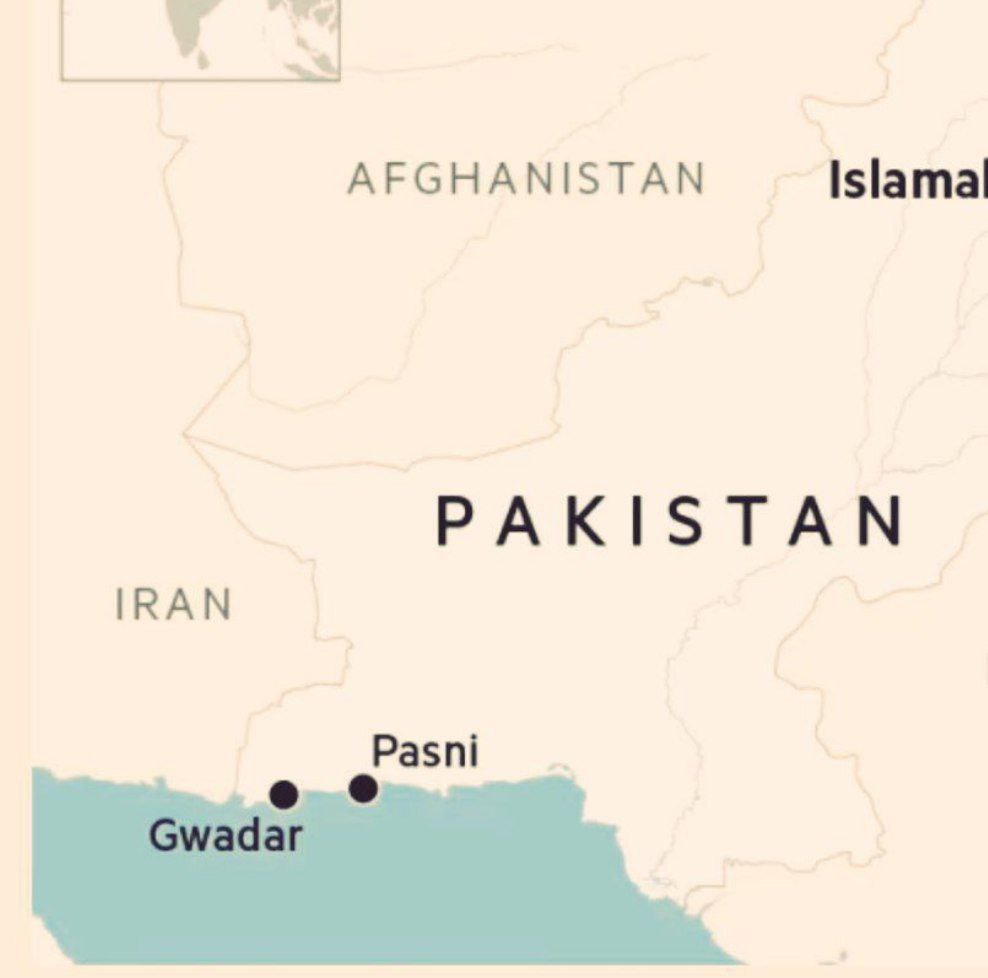
- 12 Oct 2025
In News:
Pakistan’s recent diplomatic engagements indicate a marked shift in its foreign policy priorities. The country, traditionally aligned with China under the China–Pakistan Economic Corridor (CPEC) framework, is now attempting to re-engage with the United States. Central to this emerging realignment is Islamabad’s reported proposal to allow the US to develop a new port at Pasni in Balochistan — a move that carries significant geopolitical and strategic ramifications.
The Pasni Port Proposal: Redefining Strategic Partnerships
Pakistan has reportedly offered the United States the opportunity to build and operate a port at Pasni, a deep-water harbour located on the Arabian Sea in Balochistan’s Gwadar district.
- The proposed port is around 70 miles east of China-operated Gwadar Port and approximately 100 miles from Iran’s border.
- The initiative aims to reduce Pakistan’s dependence on China’s Belt and Road Initiative (BRI), attract American investment, and open access to critical mineral exports from Balochistan.
- Plans for a railway linkage between Pasni and the hinterland have also been discussed to enhance trade connectivity.
If realised, this project would grant Washington a strategic maritime foothold in the region — an area of growing competition among global powers.
The Emerging Maritime Triangle: Pasni–Gwadar–Chabahar
Pasni’s location gives rise to a new maritime triangle involving:
- Gwadar Port – a China–Pakistan venture central to the CPEC framework;
- Chabahar Port – a joint India–Iran initiative providing access to Afghanistan and Central Asia; and
- Pasni Port – potentially linked to US–Pakistan cooperation.
This triad places China, the US, and India in close operational proximity, turning the northern Arabian Sea into a strategic hotspot where economic corridors overlap with geopolitical rivalries.
Economic Drivers: The Mineral Dimension
Balochistan is rich in rare earth elements and critical minerals, crucial for high-tech manufacturing and green technologies.
- During recent engagements in Washington, Pakistan’s leadership reportedly showcased samples of these minerals to US officials in an attempt to secure American investment.
- The proposal reflects a shift in Pakistan’s economic diplomacy — reoffering projects once promised to China now to the United States.
This “resource diplomacy” underlines Islamabad’s efforts to diversify partnerships amid economic distress and debt dependence on China.
Domestic Political Motivations
The overtures toward Washington also have domestic political undertones.
- The civil–military establishment, led by Prime Minister Shehbaz Sharif and Army Chief General Asim Munir, faces questions of legitimacy and stability at home.
- Closer ties with the US are seen as a way to gain international backing and financial relief.
- However, the leadership’s willingness to reconsider Pakistan’s stance on issues like recognition of Israel under the Abraham Accords has invited domestic criticism for allegedly compromising national principles and Palestinian solidarity without parliamentary approval.
Regional Reactions and Strategic Fallout
China’s Concerns
- Beijing views the Pasni initiative as undermining CPEC and encroaching upon its sphere of influence.
- A potential US presence near Gwadar and close to Xinjiang’s western frontier could be perceived as a strategic encirclement.
Iran’s Apprehensions
- Pasni’s proximity to the Iranian border raises concerns in Tehran, which already faces tensions with the US.
- The project could alter the regional balance and complicate Iran’s trade interests via Chabahar.
India’s Calculations
- India’s Chabahar Port project could lose strategic relevance if the Pasni initiative attracts significant US investment and attention.
- The US’s ambiguous stance on the Chabahar sanctions waiver further limits India’s operational space in the region.
Afghanistan’s Position
- The Taliban government may cautiously welcome US economic engagement but will resist any renewed American military presence, such as at Bagram Airbase.
Security Implications: Risk of Regional Instability
Balochistan already faces persistent challenges, including:
- Baloch insurgency,
- Militant violence in Khyber Pakhtunkhwa, and
- Ethnic and sectarian tensions.
Introducing American infrastructure and personnel into this volatile setting could exacerbate local grievances and trigger a new phase of proxy competition between the US and China.
Such dynamics risk turning Balochistan into a geostrategic flashpoint and further destabilising Pakistan’s internal security landscape
IAF to Receive First Tejas Mk1A Fighter Jet

- 11 Oct 2025
In News:
The Indian Air Force (IAF) is set to receive its first Light Combat Aircraft (LCA) Tejas Mk1A by the end of October 2025, marking a major milestone in India’s indigenous defence manufacturing journey under the ‘Atmanirbhar Bharat’ initiative.
Background
- The Tejasprogramme, initiated in 1984 and managed by the Aeronautical Development Agency (ADA) under the Defence Research and Development Organisation (DRDO), was conceived to replace India’s ageing MiG-21 fighter fleet with an indigenously designed and developed multi-role combat aircraft.
- The delivery of the Tejas Mk1A comes under a ?48,000 crore contract signed in 2021 between the Indian Air Force and HAL for 83 aircraft (73 single-seaters and 10 twin-seaters). The production had been delayed primarily due to slow engine deliveries and global supply chain disruptions.
About Tejas Mk1A
The Tejas Mk1A is an upgraded and advanced variant of the baseline Tejas Mk1, designed to enhance combat capability, survivability, and operational maintainability.
Key Upgrades and Capabilities
- Active Electronically Scanned Array (AESA) Radar:Provides superior target detection, tracking, and engagement capability, improving situational awareness and strike precision.
- Electronic Warfare Suite (EWS):Equipped with radar-warning receivers and self-protection jammers, enhancing survivability against enemy radar and missile threats.
- Digital Flight Control Computer (DFCC Mk1A):Improves flight stability, agility, and maneuverability during high-G operations.
- Weapon Compatibility:Supports a wide range of weapons including:
- Beyond Visual Range (BVR) missiles,
- Air-to-Air and Air-to-Ground missiles, and
- Advanced Short-Range Air-to-Air Missiles (ASRAAM).
- Enhanced Avionics and Network Systems:Planned integration of Combined Interrogator and Transponder (CIT), Software Defined Radio (SDR), and Operational Data Link (ODL) for real-time communication and network-centric warfare.
LCA Tejas: Core Features
- Design: Lightest, smallest, and tailless multi-role supersonic fighter in its class.
- Speed: Capable of reaching Mach 1.8.
- Range: Up to 3,000 km.
- Payload Capacity:4,000 kg, supporting precision-guided and conventional munitions.
- Roles: Capable of air superiority, ground attack, and reconnaissance missions.
Variants of the Tejas Family
- Tejas Mk1: Baseline version currently operational with the IAF.
- Tejas Trainer: Twin-seat variant for advanced pilot training and operational conversion.
- LCA Navy: Carrier-capable single- and twin-seat variants for deck operations.
- Tejas Navy Mk2: Phase-II version with enhanced endurance and payload for naval missions.
- Tejas Mk1A: Improved variant with advanced avionics, weapon systems, and network capabilities.
India–Qatar Relations
- 11 Oct 2025
In News:
- The Union Minister of Commerce and Industry, Piyush Goyal, recently visited Doha, Qatar, to co-chair the India–Qatar Joint Commission on Economic and Commercial Cooperation with H.E. Sheikh Faisal bin Thani bin Faisal Al Thani, Qatar’s Minister of Commerce and Industry.
- The visit marked a significant step toward strengthening bilateral economic engagement, deepening energy cooperation, and advancing a future-ready partnership between the two nations.
India–Qatar Joint Commission Meeting: Key Outcomes
- Ambitious Trade Target:Both sides recognised the untapped potential in their economic relationship and set an ambitious goal to double bilateral trade by 2030. Currently, trade between the two nations stands at around USD 14 billion.
- India–Qatar Comprehensive Economic Partnership Agreement (CEPA):The countries reaffirmed their commitment to pursue an ambitious CEPA, a free-trade pact aimed at deepening market access, investment flows, and trade facilitation.
- Digital Integration:A major milestone was the launch of India’s Unified Payments Interface (UPI) in Qatar, enabling seamless digital payments for both the Indian diaspora and Qatari consumers—symbolising the growing digital and fintech cooperation between the two nations.
- Sectoral Cooperation:
The ministers identified multiple sectors for expansion of trade and investment:- Traditional sectors: Pharmaceuticals, textiles, gems &jewellery.
- Manufacturing & technology: Electronics, automobiles, processed foods.
- Future-focused areas: IT, high-tech industries, and renewable energy (especially solar).
- Energy Partnership:India appreciated Qatar’s long-term LNG supply agreement of 7.5 million tonnes per year from 2028, underscoring the centrality of energy security in the bilateral relationship.
Bilateral Trade and Economic Ties
- Trade Profile (FY 2024–25):Bilateral trade stood at USD 14.15 billion, with India facing a trade deficit of about USD 10.78 billion, primarily due to hydrocarbon imports.
- Qatar’s exports to India comprise petroleum and LNG (89% of total trade), while India exports food products, textiles, machinery, and chemicals.
- Investment Linkages:Over 20,000 Indian companies (wholly owned and joint ventures) operate in Qatar, while Qatar’s FDI in India is valued at around USD 1.5 billion, spread across sectors like energy, infrastructure, and technology.
- The Qatar Investment Authority (QIA) has also invested heavily in India’s National Infrastructure Pipeline (NIP), technology start-ups, and real estate.
- Digital and Fintech Cooperation:The introduction of UPI in Qatar represents India’s expanding digital public infrastructure diplomacy, strengthening financial inclusion for over 800,000 Indian residents in Qatar.
Strategic Cooperation Beyond Trade
Energy Security
- Qatar as a Key Supplier:Qatar is India’s largest LNG and LPG supplier, accounting for 26% of India’s LPG imports and over three-fourths of total bilateral trade through hydrocarbons.
- Stability and Clean Transition:Long-term LNG contracts ensure price stability and support India’s clean energy transition under its net-zero goals.
Defence and Security
- The India–Qatar Defence Cooperation Agreement (2008, renewed in 2018) provides a framework for training, naval visits, and joint maritime exercises such as Za’ir-Al-Bahr (Roar of the Sea).
- Regular participation in events like DIMDEX (Doha International Maritime Defence Exhibition) reflects deepening maritime security ties in the Indian Ocean Region.
Cultural and People-to-People Ties
- The 2012 Cultural Cooperation Agreement and the 2019 India–Qatar Year of Culture have promoted cultural exchange through festivals like ‘Passage to India’ (2024).
- The Indian diaspora in Qatar, numbering over 830,000, forms a vital bridge between the two nations, contributing to Qatar’s development and remitting billions annually to India.
Mutual Significance
For India
- Energy Security: Ensures steady LNG supplies and shields India from global price volatility.
- Strategic Investments: QIA’s long-term investments aid infrastructure and industrial growth.
- Diaspora Strength: Provides remittances and strengthens cultural linkages.
- Strategic Depth in West Asia: Qatar’s regional diplomacy and ties with global powers enhance India’s strategic outreach in the Gulf.
For Qatar
- Stable Energy Market: India provides a reliable and growing market for LNG exports, critical for Qatar’s fiscal stability.
- Economic Diversification: India offers investment opportunities beyond hydrocarbons, particularly in fintech, renewables, healthcare, and education.
- Food and Supply Chain Security: India’s exports ensure Qatar’s access to essential commodities and pharmaceuticals.
- Knowledge Partnership: India’s IT, education, and skill development sectors support Qatar’s shift toward a knowledge-based economy under Qatar National Vision 2030.
Broader Vision: Strategic Partnership and Future Outlook
- The visit underscored the elevation of India–Qatar ties to a Strategic Partnership, aligning with India’s vision of becoming a Viksit Bharat by 2047.
Minister Goyal emphasised India’s macroeconomic resilience, robust startup ecosystem, and inclusive growth model, encouraging greater Qatari investments and joint ventures in India’s high-growth sectors. - Both nations agreed to strengthen institutional dialogues, deepen cooperative federalism, and promote business-to-business engagements through platforms such as the India–Qatar Joint Business Council (JBC).
Shram Shakti Niti 2025
- 11 Oct 2025
In News:
The Ministry of Labour and Employment has released the Draft National Labour& Employment Policy – Shram Shakti Niti 2025 for public consultation. This marks India’s first integrated national labour and employment policy, aiming to build a fair, inclusive, and future-ready workforce aligned with the vision of Viksit Bharat @2047.
Objective
- Shram Shakti Niti 2025 seeks to modernise India’s labour ecosystem by ensuring dignity, protection, and opportunity for every worker while responding to emerging challenges such as digital transformation, climate change, and global value chain integration.
- It signals a shift from regulation to facilitation, positioning the Ministry as a proactive employment enabler rather than merely a regulatory authority.
Core Vision and Pillars
The policy is guided by four overarching pillars:
- Dignity of Labour – Ensuring fairness, safety, and equal opportunity.
- Universal Inclusion – Extending benefits to all categories of workers, including informal and gig sectors.
- Cooperative Federalism – Promoting Centre–State coordination and tripartite dialogue among government, employers, and workers.
- Data-Driven Governance – Leveraging digital tools for evidence-based policymaking and transparency.
Seven Strategic Priorities
Shram Shakti Niti 2025 defines seven key focus areas that together shape India’s future of work:
- Universal and Portable Social Security:
- Introduction of a Universal Social Security Account integrating EPFO, ESIC, e-Shram, and PM-JAY, ensuring lifelong and portable coverage.
- Aims to enhance income security and protection for both formal and informal sector workers.
- Occupational Safety and Health:
- Promotes AI-enabled workplace safety systems and health monitoring frameworks.
- Strengthens compliance through digital inspections and risk-based certifications.
- Employment and Future Readiness:
- Builds a resilient, skilled workforce ready for automation, AI, and green transitions.
- Expands digital and vocational skill training to meet the demands of Industry 4.0.
- Women and Youth Empowerment:
- Targets 35% female labour force participation by 2030.
- Encourages flexible work models, childcare support, entrepreneurship, and skill pathways for youth.
- Ease of Compliance and Formalisation:
- Launch of a single-window digital compliance portal with risk-based self-certification to simplify regulations and enhance trust-based governance.
- Technology and Green Transitions:
- Promotes green jobs, sustainable enterprises, and AI-driven workforce management.
- Aligns labour policy with India’s climate and sustainability goals.
- Convergence and Good Governance:
- Establishes a three-tier institutional structure — National, State, and District Labour Missions.
- Introduces a Labour& Employment Policy Evaluation Index (LEPEI) for performance tracking.
- Integrates worker identities, enterprise data, and social security benefits into a unified Labour& Employment Stack.
Digital Public Infrastructure for Employment
A key innovation under Shram Shakti Niti 2025 is the transformation of the National Career Service (NCS) into India’s Employment Digital Public Infrastructure (DPI).
This platform will provide:
- AI-based job matching and credential verification,
- Skill alignment and career guidance, and
- Inclusive access to opportunities across Tier-II and Tier-III cities.
This approach aims to bridge the gap between job seekers, employers, and training institutions through trusted, interoperable digital systems.
Alignment with Labour Reforms
The draft policy complements the consolidation of 29 central labour laws into four Labour Codes:
- Code on Wages, 2019
- Industrial Relations Code, 2020
- Occupational Safety, Health and Working Conditions Code, 2020
- Social Security Code, 2020
Together, these aim to enhance ease of doing business while safeguarding workers’ rights.
Implementation Framework
The policy outlines a phased roadmap (2025–2047):
- Phase I (2025–27): Institutional setup, pilot projects, and digital integration of social security systems.
- Phase II (2027–30): Nationwide rollout of Universal Social Security and AI-driven employment services.
- Phase III (Beyond 2030): Full digital convergence and predictive, data-based labour governance.
Significance
- First comprehensive national labour policy integrating employment, social protection, and technology.
- Enhances labour market efficiency and reduces regulatory fragmentation.
- Ensures inclusive growth by bridging formal–informal divides and empowering women and youth.
- Strengthens cooperative federalism and participatory governance in the world of work.
Nobel Prize in Chemistry 2025

- 11 Oct 2025
In News:
The 2025 Nobel Prize in Chemistry has been awarded to Susumu Kitagawa (Japan), Richard Robson (Australia), and Omar Yaghi (Jordan–USA) for their pioneering work in developing Metal–Organic Frameworks (MOFs) — a novel class of crystalline materials with exceptional porosity and tunable chemical properties. Their innovation has transformed the field of materials chemistry, enabling new solutions for energy, environment, and sustainability.
About the Nobel Prize in Chemistry
Instituted under the 1895 will of Alfred Nobel, the Nobel Prize in Chemistry honours individuals whose discoveries have profoundly advanced the chemical sciences and benefitted humanity. The 2025 award acknowledges a transformative leap in reticular chemistry — the design and synthesis of porous networks using metal ions and organic linkers.
Genesis of Metal–Organic Frameworks (MOFs)
In most materials, atoms are tightly packed, leaving little internal space. The Nobel laureates devised a way to link metal atoms with organic molecules in an open, lattice-like structure that leaves large, orderly cavities — creating materials capable of trapping, storing, or releasing other molecules with precision.
- Richard Robson, in the 1970s at the University of Melbourne, first envisioned connecting atoms through molecular linkers to create spacious molecular architectures.
- Susumu Kitagawa in the 1990s demonstrated that such frameworks could be flexible, “breathing” materials capable of absorbing and releasing gases.
- Omar Yaghi, from the 2000s onwards, stabilised these frameworks and founded reticular chemistry, systematically designing MOFs for targeted purposes such as carbon capture, water harvesting, and gas storage.
What are MOFs?
Metal–Organic Frameworks (MOFs) are hybrid crystalline materials formed by coordinating metal ions or clusters (e.g., copper, zinc, aluminium) with organic ligands to produce rigid, porous 3D networks.
These frameworks function like atomic sponges, capable of holding, filtering, or releasing molecules with high selectivity. Each gram of a MOF can offer a surface area equivalent to several football fields, allowing immense storage capacity.
Key Properties of MOFs
- Super Porosity:Exceptionally high internal surface area, enabling efficient molecular capture and storage.
- Customisability:The pore size, shape, and chemical affinity can be precisely engineered to trap specific molecules — for example, CO? or methane.
- Breathing Flexibility:Some MOFs expand or contract in response to absorbed gases, similar to a lung inhaling and exhaling.
- Chemical Stability:MOFs are robust, reusable, and resistant to heat and chemical degradation.
- Eco-Friendly Synthesis:They can be produced via low-cost, green methods, enhancing scalability and industrial applicability.
Applications and Global Relevance
- Climate Action – Carbon Capture:MOFs can selectively absorb carbon dioxide (CO?) from industrial emissions or the atmosphere, aiding climate mitigation strategies.
- Water Harvesting:Certain MOFs extract water vapour from arid air — a potential lifeline for water-scarce regions.
- Clean Energy Transition:Their ability to store hydrogen or methane makes MOFs promising materials for next-generation, lightweight, and safe fuel systems.
- Environmental Remediation:MOFs can trap and remove pollutants such as PFAS, heavy metals, and toxic gases, supporting cleaner air and water.
- Biomedical and Catalytic Uses:In pharmaceuticals and industrial chemistry, MOFs act as catalysts or as carriers for targeted drug delivery.
NITI Aayog report “Roadmap on AI for Inclusive Societal Development”

- 11 Oct 2025
In News:
NITI Aayog has unveiled its strategic report “Roadmap on AI for Inclusive Societal Development”, which presents a comprehensive vision for leveraging Artificial Intelligence (AI) to strengthen India’s vast informal economy through enhanced digital inclusion, skilling, and social protection systems.
Status of India’s Informal Workforce
- Scale and Economic Role: Approximately 490 million Indians—about 90% of the national workforce—are engaged in informal employment spanning agriculture, construction, and services, together contributing nearly half of India’s GDP (MoLE, 2024).
- Rural Dominance: Over 80% of rural labourers operate without written contracts or social security coverage, especially in construction, handicrafts, and retail sectors.
- Gendered Vulnerability: Women constitute around 55% of the informal workforce, with significant representation in home-based and agricultural activities (ILO, 2023).
- Low Productivity and Earnings: Informal sector productivity remains roughly one-fourth that of the formal economy, perpetuating low wages and economic insecurity.
- Emergence of Urban Informality: The gig and platform economy has created a new informal class, with nearly 7.5 million platform workers (NITI Aayog, 2022) still outside formal labour protections.
Core Challenges
- Financial Instability: Over three-fourths of informal workers earn below ?10,000 per month and face limited access to affordable credit or insurance (PLFS, 2024).
- Market Inefficiencies: Only about 12% of small producers or artisans access digital or organized markets directly, remaining dependent on intermediaries.
- Digital and Skill Divide: Around 70% of informal workers lack basic digital literacy, impeding their participation in AI-integrated economies.
- Weak Social Protection: Just one-third of eligible informal workers are registered under welfare schemes such as e-Shram or PM-SYM.
- Policy Fragmentation: Overlapping databases and weak institutional coordination hinder effective benefit delivery and erode worker trust.
Transformative Potential of AI
- Financial Empowerment: AI-based credit assessment tools (e.g., SBI YONO, Setu.ai) can facilitate microloans for workers lacking traditional financial records.
- Digital Public Infrastructure (DPI): Platforms such as Aadhaar, UPI, and e-Shram can establish verifiable worker identities, improving transparency in wage payments and welfare targeting.
- Smart Contracts and Blockchain: Use of blockchain for wage traceability and supply chain verification (e.g., Tata Steel Foundation’s pilot in Jharkhand) can curb exploitation.
- AI-driven Skilling: Adaptive learning ecosystems like Skill India Digital can deliver personalized, voice-enabled vernacular micro-courses for re-skilling informal workers.
- Predictive Governance: AI-based data analytics can enhance targeting and timeliness of welfare delivery (e.g., integration with PM-Kisan data systems).
Major Recommendations
- Launch of ‘Digital ShramSetu Mission’: Create an AI-enabled national platform integrating social security, skilling, and livelihood databases for informal workers.
- Sector-specific AI Models: Focus on high-impact areas—agriculture, construction, logistics, and retail—for productivity enhancement.
- Inclusive Design: Develop voice-first, multilingual AI interfaces to ensure accessibility for low-literacy populations.
- Public–Private Collaboration: Promote partnerships among government agencies, startups, and tech firms for scalable innovation in informal ecosystems.
- Responsible AI Charter: Establish a framework ensuring transparency, privacy, and inclusivity in AI deployment for social sectors.
- AI-based Skilling Framework: Institutionalize micro-credential courses and continuous re-skilling under Skill India 2.0.
- Impact Evaluation Mechanism: Implement real-time data-driven monitoring to assess inclusion, income enhancement, and service delivery outcomes.
UNESCO’s New Director-General

- 10 Oct 2025
In News:
The Executive Board of UNESCO (United Nations Educational, Scientific and Cultural Organization) has elected Egypt’s Khaled El-Enany as its new Director-General for a four-year term (2025–2029), succeeding Audrey Azoulay of France. His election marks a significant moment for African and Arab representation within the United Nations system.
About the Election Process
- Nomination: Candidates are nominated by member states and evaluated by UNESCO’s 58-member Executive Board.
- Voting: The Board conducts a secret ballot, requiring an absolute majority to select a nominee.
- Approval: The selected candidate’s name is then forwarded to the General Conference—comprising 194 member states—for formal confirmation.
About the Director-General’s Role
The Director-General serves as the chief executive officer and spokesperson of UNESCO, responsible for implementing the policies and decisions of the General Conference and Executive Board.
Key Functions
- Leadership & Administration:
- Oversees UNESCO’s global programmes across education, culture, science, and communication.
- Manages the World Heritage Sites framework and educational cooperation initiatives.
- Policy Implementation:Translates strategic resolutions of the General Conference into operational programmes.
- Global Representation:Acts as the face of UNESCO in international diplomacy, fostering partnerships for cultural and educational cooperation.
- Financial Stewardship:Mobilizes funding, particularly important after the U.S. withdrawal, which caused an 8% cut in UNESCO’s annual budget.
About UNESCO
- Founded: 1945
- Headquarters: Paris, France
- Membership: 194 member states
- Mandate: To promote peace, education, science, and cultural understanding through international collaboration.
UNESCO’s global initiatives include:
- The World Heritage Convention (1972)
- The Education for Sustainable Development (ESD) framework
- The Man and the Biosphere (MAB)Programme
- Promotion of freedom of expression and media pluralism
Tigers Outside Tiger Reserves (TOTR) Project
- 10 Oct 2025
In News:
During Wildlife Week 2025 (October 2–8), the Union Minister for Environment, Forest and Climate Change, Bhupender Yadav, launched five major species conservation and conflict management initiatives at the Forest Research Institute (FRI), Dehradun. The initiatives aim to reinforce India’s commitment to biodiversity conservation while addressing the growing challenge of human–wildlife conflict amid rapid development.
The Five Initiatives
- Project Dolphin (Phase II)
- Project Sloth Bear
- Project Gharial
- Centre of Excellence for Human–Wildlife Conflict Management (CoE–HWC)
- Tigers Outside Tiger Reserves (TOTR)
In addition, four national-level action plans and field guides were unveiled to support species monitoring and population assessment of river dolphins, tigers, snow leopards, Great Indian Bustard, and Lesser Florican.
1. Tigers Outside Tiger Reserves (TOTR) Project
Overview
- A new national-level initiative by the MoEFCC and National Tiger Conservation Authority (NTCA).
- Implementation period: 2025–2028
- Budget: ?88.7 crore
- Coordination: Centrally by NTCA; executed by State Forest Departments.
Objectives
- Reduce human–tiger conflict in non-reserve areas.
- Ensure safe coexistence between communities and tigers dispersing beyond reserves due to population recovery and habitat fragmentation.
- Promote a landscape-level conservation approach integrating ecological, social, and livelihood priorities.
Geographical Coverage
- Encompasses 80 forest divisions across 17 tiger-range states, including Madhya Pradesh, Maharashtra, Karnataka, Uttarakhand, Assam, Kerala, Tamil Nadu, West Bengal, andArunachal Pradesh.
- Focuses on corridors and buffer areas adjoining major tiger reserves.
Key Features
- Technology & Monitoring:Use of AI-based early warning systems, drones, camera traps, GPS-enabled patrolling, andMSTrIPES app for real-time tracking.
- Community Participation:
- Establishment of Rapid Response Teams (RRTs) equipped with tranquilization gear, rescue tools, and vehicles.
- Launch of “Bagh Mitra” (Tiger Friends)programmes and student jungle camps to foster coexistence.
- Institutional Framework:
- NTCA to oversee implementation; Chief Wildlife Wardens and State CAMPA authorities to manage funds and on-ground execution.
Significance
- India hosts 70% of the global tiger population — 3,682 as of 2022.
- Around 35–40% (1,325 tigers) now live outside protected areas, increasing the frequency of human–tiger encounters.
- The TOTR project seeks to balance conservation with human safety through modern technology, community outreach, and continuous monitoring.
Project Dolphin (Phase II)
- Focuses on conserving river and marine cetaceans, including the endangered Ganga River Dolphin and Indus Dolphin.
- Aims to enhance habitat protection, improve water quality in river ecosystems, and strengthen anti-poaching measures.
- Encourages local community participation and awareness through riverine eco-tourism and citizen science initiatives.
Project Sloth Bear
- India’s first national framework for the conservation of sloth bears, a species threatened by habitat loss, poaching, and human conflict.
- Focus areas include:
- Habitat restoration and connectivity,
- Mitigation of bear–human conflict,
- Establishment of rescue and rehabilitation centres, and
- Awareness campaigns for community coexistence.
Project Gharial
- Aims to revive populations of the critically endangered gharial in Indian rivers like the Chambal and Gandak.
- Measures include nest protection, captive breeding, river habitat restoration, and monitoring through telemetry.
- Seeks to strengthen coordination among state wildlife departments, river authorities, andlocal communities.
Centre of Excellence for Human–Wildlife Conflict Management (CoE–HWC)
- Location:Sálim Ali Centre for Ornithology and Natural History (SACON), Coimbatore.
- Purpose:
- To serve as a national research and policy hub for addressing human–wildlife conflicts.
- Develop AI-based conflict prediction models, design field-level mitigation tools, and train forest officials and local communities.
Trade Watch Quarterly Report
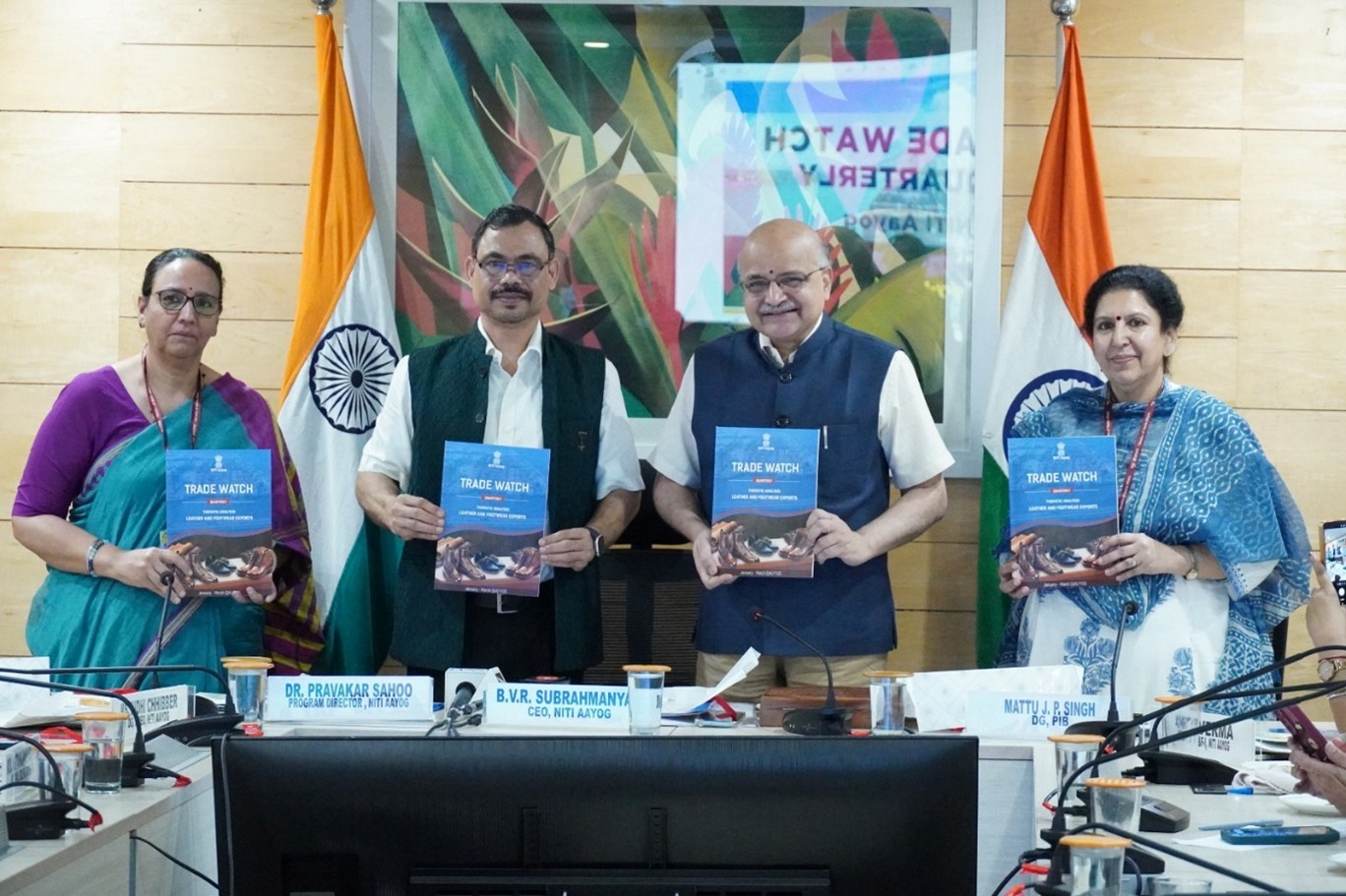
- 10 Oct 2025
In News:
NITI Aayog released the fourth edition of the “Trade Watch Quarterly” report for Q4 of FY 2024–25 (January–March 2025) in New Delhi. The report, unveiled by B.V.R. Subrahmanyam, CEO of NITI Aayog, provides a detailed evaluation of India’s trade performance, identifies emerging opportunities, and suggests policy directions for enhancing export competitiveness.
About the “Trade Watch Quarterly”
- Publisher: NITI Aayog
- Nature: Flagship analytical publication assessing India’s quarterly trade trends across merchandise and services.
- Objectives:
- To offer evidence-based insights into trade patterns, export competitiveness, and sectoral challenges.
- To guide policy interventions for strengthening India’s manufacturing ecosystem and expanding participation in global value chains (GVCs).
Key Highlights of Q4 FY 2024–25
- Total Trade: USD $441 billion, registering a 2.2% year-on-year increase.
- Annual Trade (FY25):
- Total: USD $1.73 trillion (+6% YoY)
- Exports: USD $823 billion
- Imports: USD $908 billion
Merchandise and Services Trends
- Merchandise Exports: Witnessed a modest contraction, primarily due to lower shipments of mineral fuels and organic chemicals.
- Growth Sectors: Electrical machinery, pharmaceuticals, and cereals.
- Services Exports: Reached an all-time high of $387.5 billion, led by IT, aviation, and financial services, reflecting India’s growing strength in high-value services.
Regional Trade Patterns
- Top Export Market:North America, accounting for 25% of India’s exports and growing 25% YoY.
- Moderate Growth Regions:EU, GCC, and ASEAN, showing a slowdown in demand.
- Import Trends:
- UAE became India’s second-largest supplier, driven by gold inflows under the CEPA agreement.
- China’s imports surged due to strong demand for electronics and machinery.
Sectoral Focus: Leather and Footwear Industry
- Employs 4.4 million people, contributing significantly to export earnings.
- India’s share in the $296 billion global market remains modest at 1.8%.
- Strengths: Competitive in processed leathers and niche apparel.
- Challenges & Opportunities:
- Global demand shifting towards non-leather and sustainable products.
- India must invest in R&D, MSME strengthening, green manufacturing, anddesign-led innovation to boost competitiveness and diversify exports.
Policy Insights and Way Forward
- India must:
- Diversify its export basket to align with evolving global demand patterns.
- Leverage trade agreements (like CEPA with UAE) to expand market access.
- Enhance manufacturing competitiveness through innovation and integration withGVCs.
- Strengthen non-leather footwear and sustainable sectors to tap into emerging global trends.
International Stabilization Force for Gaza (ISF)

- 10 Oct 2025
In News:
In September 2025, U.S. President Donald Trump unveiled a 20-point “Comprehensive Plan to End the Gaza Conflict”, proposing an International Stabilization Force (ISF) to manage post-war Gaza. While both Israel and Hamas accepted the ceasefire and hostage-release obligations, deep divergences persist over Gaza’s future governance, Hamas’s fate, and the legitimacy of the ISF.
What Is the ISF?
The International Stabilization Force for Gaza is a proposed multinational security mission aimed at maintaining internal stability, enabling phased Israeli withdrawal, and overseeing Gaza’s demilitarization.
- Nature: A temporary but long-term security component of a technocratic, apolitical Palestinian Transitional Committee, which will govern Gaza during the interim period.
- Oversight: The ISF will operate under a “Board of Peace” chaired by the U.S. President, rather than the United Nations (UN).
- Composition: To be formed with “Arab and international partners,” but without a UN Security Council (UNSC) mandate—limiting its neutrality and legal legitimacy.
Objectives and Core Functions
- Demilitarization of Gaza:
- Confiscate and destroy Hamas weaponry.
- Prevent smuggling and block the inflow of arms.
- Security and Law Enforcement:
- Maintain order in “terror-free zones” vacated by the Israeli Defense Forces (IDF).
- Set milestones and timelines linked to Israel’s phased withdrawal.
- Capacity Building:Train and professionalize Palestinian law enforcement under international supervision.
- Governance Transition:Facilitate the formation of a reformed Palestinian security apparatus aligned with the transitional governance framework.
- Monitoring and Compliance:Track progress on demilitarization and withdrawal to prevent relapse into conflict.
Absence of a UN Mandate and Legitimacy Concerns
Unlike traditional UN peacekeeping or stabilization missions, which derive legitimacy from UNSC authorization under Chapter VII of the UN Charter, the ISF is designed to operate outside the UN framework.
- The UN’s role in Trump’s plan is restricted to aid distribution, not peacekeeping.
- Arab states have historically resisted deploying troops in Palestine under non-UN command, citing concerns about political bias and lack of legal accountability.
- Consequently, the ISF’s perceived alignment with American and Israeli objectives could undermine its credibility among Palestinians and regional actors.
Precedents and Lessons from Past Stabilization Missions
Previous stabilization forces outside or alongside the UN framework reveal the complexity and risks of such interventions:
- Afghanistan (ISAF, 2001–2021): Initially authorized by the UN and later led by NATO, the mission expanded into combat operations against the Taliban but failed to establish durable peace.
- Lebanon (MNF, 1982–1983): A U.S.-led multinational force, created outside the UN, withdrew after facing intense violence from militias, highlighting the dangers of intervention without broad legitimacy or consent.
These experiences underscore that stabilization without political resolution often leads to mission failure and regional backlash.
Challenges in the Palestinian Context
- Lack of Political Resolution:
- The two-state solution remains unrealized; Israeli occupation continues in parts of Gaza and the West Bank.
- Without a clear political settlement, any international force risks being drawn into hostilities.
- Israeli and Hamas Positions:
- Israel has refused a full withdrawal from Gaza, citing security concerns.
- Hamas has not agreed to complete disarmament or exclusion from the Palestinian political framework.
- These contradictory stances create operational uncertainty for the ISF.
- Arab States’ Reservations:
- Arab governments have called for aUN-mandated protection force, not a U.S.-led stabilization mission.
- An eight-nation Arab-Islamic statement (Sept 30, 2025) demanded Israel’s complete withdrawal, diverging sharply from Washington’s version of the plan.
- Risk of Renewed Armed Resistance:Partial Israeli withdrawal and continued occupation zones could fuel militant activity, increasing the risk of direct confrontation with the ISF.
- Limited Accountability:Absence of UN oversight and clear reporting mechanisms raises concerns over the ISF’s command structure, rules of engagement, and human rights compliance.
Geopolitical and Strategic Implications
- For the U.S.: The ISF signifies Washington’s intent to maintain strategic control over Gaza’s post-conflict order, reducing UN influence.
- For Israel: The arrangement allows for partial demilitarization without ceding full security control—aligning with its domestic political compulsions.
- For Arab States: It poses a dilemma between supporting stability and avoiding association with a potentially occupation-legitimizing force.
- For Palestine: The lack of a fully sovereign and representative governance framework risks perpetuating disenfranchisement and renewed cycles of violence.
State of Social Justice 2025
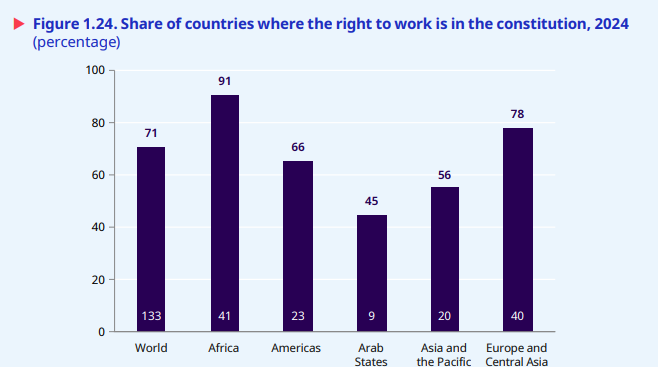
- 10 Oct 2025
In News:
The International Labour Organization (ILO) released its landmark report, “The State of Social Justice: A Work in Progress (2025)”, ahead of the Second World Summit for Social Development. The report marks three decades since the historic 1995 Copenhagen Summit and evaluates global efforts towards achieving justice, equality, and inclusion in a rapidly transforming world.
I. Purpose and Framework
The report assesses progress over 30 years in advancing social justice—defined as fair and equitable access to opportunities, rights, and resources—through four foundational pillars:
- Fundamental Human Rights and Capabilities – promoting freedom, equality, and universal social protection.
- Equal Access to Opportunities – removing barriers to education, employment, and fair wages.
- Fair Distribution – ensuring equitable sharing of the gains from economic growth.
- Fair Transitions – managing environmental, digital, and demographic shifts inclusively.
II. Global Progress: Achievements and Trends
1. Poverty and Labour Improvements
- Extreme Poverty fell sharply from 39% (1995) to 10% (2023).
- Working Poverty declined from 27.9% (2000) to 6.9% (2024).
- Labour Productivity per worker increased by 78% globally and by 215% in upper-middle-income countries, indicating narrowing productivity gaps between nations.
- Child Labour dropped from 20.6% (1995) to 7.8% (2024), driven by education access and monitoring systems.
2. Education and Skills
- Secondary school completion rates rose by 22 percentage points since 2000, underscoring significant human capital development.
3. Social Protection Expansion
- Over half of the global population is now covered by at least one form of social protection—pensions, healthcare, or income support—up from a marginal share in 1995.
III. Persistent Challenges
Despite these gains, the report warns that social justice remains “a work in progress,” with stark inequalities continuing to undermine inclusive growth.
1. Inequality and Wealth Concentration
- The top 1% of the global population controls 20% of income and 38% of total wealth.
- 800 million people still survive on less than US$3 per day, and one in four lacks access to safely managed drinking water.
2. Gender and Birth Inequalities
- Women earn 78% of men’s wages, and gender parity in labour participation has improved by only three percentage points since 1995.
- Nearly 71% of income outcomes globally are influenced by birth circumstances, reflecting entrenched structural inequities.
3. Informality and Job Quality
- 58% of workers remain in the informal economy, with limited access to labour rights and social protection.
- Collective bargaining rights have weakened globally, as reflected in declining compliance scores across income groups.
4. Declining Trust in Institutions
Confidence in governments, corporations, and unions has steadily eroded since the 1980s due to perceptions of unfair reward systems, corruption, and widening wealth gaps—posing risks to democratic stability.
IV. India in the Global Context
India mirrors many global patterns highlighted by the ILO but also shows unique progress in certain areas:
1. Poverty and Human Development
- Multidimensional poverty reduced from 29% (2013–14) to 11% (2022–23).
- Education: Secondary school completion rate reached 79% (2024), and female literacy stands at 77%.
- Digital Empowerment: The JAM trinity (Jan Dhan–Aadhaar–Mobile) enhanced direct benefit delivery and reduced leakages.
2. Social Protection and Welfare
Schemes such as PM-KISAN, Ayushman Bharat, and e-Shram have significantly extended coverage to over 55 crore unorganised workers. The Social Security Code (2020) further streamlined pension and maternity benefits.
3. Labour Market and Gender Gaps
- Informality remains high—over 80% of India’s workforce operates outside formal contracts.
- Female labour force participation has improved to 37% (PLFS 2024–25) but remains below the global average.
V. Managing Emerging Transitions
The ILO identifies three ongoing societal transitions that must be managed fairly to sustain progress:
- Climate Transition – Ensuring green jobs and protecting workers displaced by decarbonisation.
- Technological Transition – Bridging the digital divide through skills, reskilling, and inclusive access.
- Demographic Transition – Addressing challenges of ageing populations while leveraging youth dividends in developing countries.
To navigate these, the ILO recommends:
- Applying existing labour institutions to emerging contexts.
- Adapting them to specific transition challenges.
- Amplifying them by integrating labour concerns into climate, digital, and fiscal policies.
VI. ILO’s Key Recommendations
- Embed Social Justice Across Policies – Integrate equity into finance, trade, climate, and healthcare governance.
- Rebuild Trust in Institutions – Enhance transparency, accountability, and participatory policymaking.
- Invest in People – Expand education, skills, and lifelong learning to bridge gender and digital gaps.
- Strengthen Social Protection Systems – Aim for universal and portable coverage, backed by fair minimum wages.
- Promote Fair Transitions – Ensure environmental and technological shifts generate decent work.
- Enhance Global Cooperation – Reinforce multilateralism to manage migration, inequality, and global shocks.
WHO Global Report on Trends in Tobacco Use (2000–2024) and Projections (2025–2030)

- 09 Oct 2025
In News:
The World Health Organization (WHO) released its latest report on global tobacco use, covering trends from 2000 to 2024 and projecting patterns through 2030. The report provides insights into the prevalence of tobacco consumption among individuals aged 15 years and above and assesses progress toward global reduction targets.
Global Tobacco Trends
- Declining Prevalence: Adult tobacco use worldwide decreased from 26.2% in 2010 to 19.5% in 2024.
- Continued Burden: Despite progress, approximately 1 in 5 adults still consumes tobacco.
- Rise of E-Cigarettes: Over 100 million people use e-cigarettes globally, introducing new regulatory and public health challenges.
India’s Tobacco Landscape
- Users (2024): Around 243.48 million Indians aged 15 and above consume tobacco.
- Global Ranking: India is the 2nd largest producer (after China) and 2nd largest exporter (after Brazil) of tobacco.
- Progress: India is projected to achieve a 43% reduction in prevalence between 2010–2025, surpassing the WHO’s NCD target of 30% reduction.
Measures to Control Tobacco Use in India
- Cigarettes and Other Tobacco Products Act (COTPA), 2003:
- Prohibits smoking in public areas.
- Bans tobacco advertising.
- Restricts sales to minors.
- Mandates packaging and labeling standards.
- Prohibition of Electronic Cigarettes Act, 2019:Outlaws theproduction, import, sale, and promotion of e-cigarettes and similar devices.
- National Tobacco Control Programme (NTCP, 2007–08):
- Promotes awareness of health risks associated with tobacco.
- Aligns with the WHO Framework Convention on Tobacco Control (FCTC).
- Tobacco-Free Film Rules, 2024:Enforces restrictions on tobacco depiction in films and television content.
- Yellow Line Campaign:Marks 100-yard boundaries around schools to enforce tobacco sales bans.
- Taxation and Pricing:Incremental hikes in excise and GST duties on tobacco products, though experts suggest further increases to maximize impact.
About Tobacco (Nicotiana tabacum)
- Botanical Profile: An annual herbaceous plant, native to tropical/subtropical South America, widely cultivated globally.
- Cultivation Requirements:
- Frost-free period of 90–120 days.
- Optimal temperature: 20–30°C.
- Rainfall: Minimum 500 mm; thrives in well-drained sandy loam or alluvial soils.
- Nicotine Content: All parts (except seeds) contain nicotine (2–8%), predominantly concentrated in the leaves (~64% of total plant nicotine).
Significance
The WHO report highlights that while tobacco use is declining globally, substantial public health efforts are still needed, particularly in regulating emerging products like e-cigarettes. India’s multi-pronged approach—legal frameworks, awareness campaigns, taxation, and innovative interventions—demonstrates a strong commitment to achieving tobacco-free goals by 2025.
Nobel Prize in Physiology or Medicine 2025

- 09 Oct 2025
In News:
The 2025 Nobel Prize in Physiology or Medicine was awarded jointly to Mary Brunkow, Fred Ramsdell, and Shimon Sakaguchi for their pioneering work on peripheral immune tolerance. Their research identified the critical role of regulatory T-cells (Tregs) in preventing the immune system from attacking the body’s own tissues.
The Human Immune System
The immune system protects the body against harmful pathogens, including bacteria, viruses, fungi, and parasites. It is composed of:
- Organs: Bone marrow, thymus, spleen, lymph nodes, and tonsils.
- Cells: White blood cells (leukocytes), including lymphocytes, macrophages, and neutrophils.
- Molecules: Antibodies, cytokines, and complement proteins.
Its central challenge is distinguishing between harmful invaders and the body’s own healthy cells, including those altered by mutation or cancer.
B-Cells and T-Cells
Lymphocytes, including B-cells and T-cells, are key players in immune defense.
- B-cells: Produce antibodies to neutralize antigens. Main types include plasma cells and memory cells.
- T-cells: Originate in the bone marrow, mature in the thymus, and migrate to lymphoid tissues and the bloodstream. Types include:
- Cytotoxic T-cells: Destroy virus-infected and tumor cells.
- Helper T-cells: Coordinate immune responses by signaling other immune cells.
- Regulatory T-cells (Tregs): Suppress excessive immune activity, preventing autoimmune reactions and maintaining self-tolerance.
Discovery and Significance
The laureates’ research revealed regulatory T-cells as the immune system’s “security guards,” preventing it from attacking the body.
Key implications:
- Advanced understanding of peripheral tolerance, the mechanism by which the immune system avoids self-damage.
- Informed the development of therapies for autoimmune diseases, cancer, transplantation, and chronic inflammatory conditions.
- Highlighted that tumors may recruit Tregs to evade immune destruction, providing insights for cancer immunotherapy.
The discovery reshaped immunology by showing that the immune system is not solely attack-oriented, but also self-regulating.
About the Nobel Prize
- Established: 1901, through Alfred Nobel’s will (largest share of his fortune dedicated).
- Fields: Physics, Chemistry, Physiology or Medicine, Literature, Peace; Economics added in 1968.
- Awarding Institutions:
- Karolinska Institute: Physiology or Medicine
- Royal Swedish Academy of Sciences: Physics, Chemistry, Economics
- Swedish Academy: Literature
- Norwegian Nobel Committee: Peace Prize
- Award Venues: Stockholm (all except Peace), Oslo (Peace Prize)
- Administration: Managed by the Nobel Foundation, independent of prize selection.
Selection Process:
- Nominations are invited from qualified individuals (scientists, professors, former laureates).
- Expert committees evaluate candidates and recommend winners.
- Final decisions rest with the respective Nobel institutions.
Mig La Pass
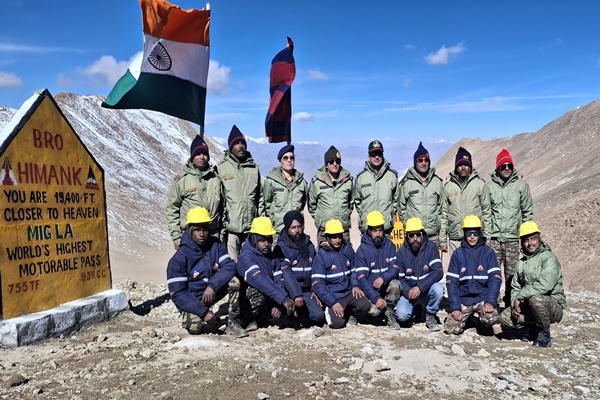
- 09 Oct 2025
In News:
The Border Roads Organisation (BRO), through Project Himank, has constructed the world’s highest motorable road at Mig La Pass in Ladakh, situated at 19,400 feet above sea level, surpassing the previous record held by Umling La (19,024 ft) in 2021. This achievement highlights India’s engineering capability and strategic preparedness in high-altitude border areas.
About Mig La Pass
- Location: Changthang Plateau, Ladakh.
- Altitude: 19,400 ft, making it the highest motorable road in the world.
- Strategic Significance:
- Connects Likaru–Mig La–Fukche, forming a third vital corridor from Hanle to Fukche, near the Indo-China border.
- Enhances logistical and military mobility, strengthening access to forward areas close to the Line of Actual Control (LAC).
- Engineering Features:
- All-weather road capable of withstanding harsh winters, shifting glaciers, and low oxygen conditions.
- Designed for continuous vehicular movement, critical for both military and civilian access.
- Tourism Potential: Provides panoramic views of the Indus Valley, potentially boosting local tourism.
Project Himank
- Established: 4 December 1985 at Leh, to develop road communication in Ladakh’s challenging terrain.
- Operational Scope: Works in high-altitude regions with short working seasons and extreme climatic conditions.
- Contributions:
- Supports the Indian Army in operations, logistics, and connectivity.
- Ensures maintenance of key routes, including the Leh-Manali and Zojila axes.
- Executes landslide and avalanche clearance, bridge construction, and snow removal.
- Aids in restoring road communication and opening airfields in remote areas.
- Engineering Excellence: Demonstrates BRO’s capability to construct durable infrastructure under extreme terrain, low oxygen, and sub-zero temperatures.
Coral Larvae Cryobank
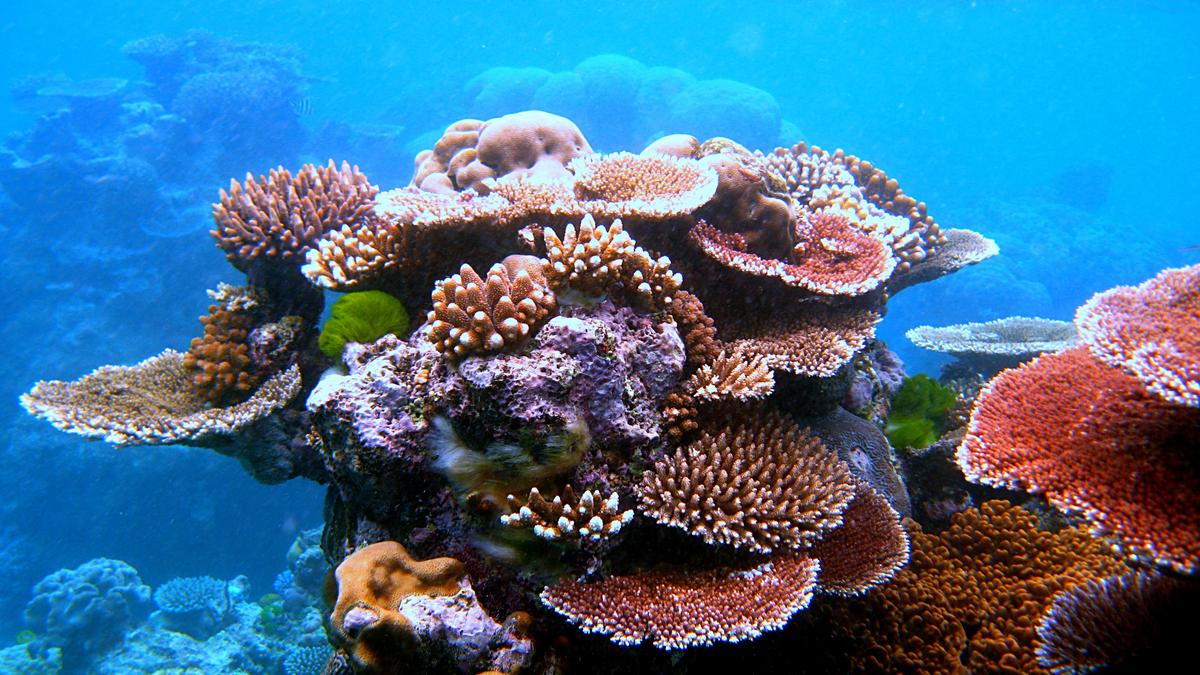
- 09 Oct 2025
In News:
In a significant step toward marine conservation, the Philippines has established Southeast Asia’s first coral larvae cryobank, aimed at safeguarding coral genetic diversity and restoring threatened reef ecosystems. The initiative marks a pioneering regional collaboration among research institutions in the Philippines, Taiwan, Indonesia, Malaysia, and Thailand.
About the Coral Cryobank Initiative
- The Coral Larvae Cryobank is designed to freeze and store coral larvae at ultra-low temperatures, thereby preserving their genetic material for future reef restoration.
- It is part of a regional conservation programme supported by the Coral Research & Development Accelerator Platform, with technical guidance from Dr. Chiahsin Lin and the University of the Philippines Marine Science Institute.
- The cryobank acts as a “genetic insurance policy” to protect coral biodiversity in the face of rising ocean temperatures, pollution, and habitat destruction.
Cryopreservation: The Science Behind It
Cryopreservation is a process of preserving living cells or tissues at –196°C using liquid nitrogen, which halts all biological activity.
- Cryoprotectant solutions (such as glycerol, DMSO, and ethylene glycol) are used to prevent ice crystal formation that can damage cells.
- The process of vitrification converts the larvae into a glass-like state, allowing them to remain intact indefinitely.
- Laser-assisted thawing enables rapid revival of viable coral larvae, which can later be used for reef restoration and rehabilitation.
This technique ensures that coral genetic material remains preserved even if wild populations are damaged by bleaching events or ocean warming.
The Coral Triangle: The ‘Amazon of the Seas’
- The Coral Triangle, often termed the “Amazon of the Seas”, spans about 6 million sq. km across Indonesia, Malaysia, Papua New Guinea, the Philippines, Solomon Islands, and Timor-Leste.
- It covers two major biogeographic regions — the Indonesian–Philippines Region and the Far Southwestern Pacific Region — and represents the richest marine biodiversity hotspot on Earth.
Key Features
- Home to over 75% of global coral species and one-third of all reef fish.
- Supports six of the world’s seven marine turtle species.
- Sustains the livelihoods and food security of over 120 million people.
- Hosts vast mangrove forests and seagrass ecosystems, critical for carbon sequestration and coastal protection.
Threats to Coral Ecosystems
The Coral Triangle faces escalating threats due to climate change and anthropogenic pressures.
- Rising sea temperatures trigger coral bleaching, where corals expel symbiotic algae (zooxanthellae), turning white and losing energy sources.
- The Status of Coral Reefs of the World 2020 report found that 14% of the world’s corals were lost between 2009 and 2018.
- Projections indicate that 70–90% of live corals could vanish by 2050 without effective conservation.
- Destructive fishing, coastal pollution, and unregulated tourism further degrade reef habitats.
Understanding Corals
- Corals are marine invertebrates belonging to the Cnidaria phylum.
- They consist of tiny organisms called polyps, which secrete calcium carbonate skeletons that form coral reefs.
- The color of corals arises from symbiotic algae within their tissues, essential for nutrient exchange.
- Types of coral reefs:
- Fringing reefs – develop along shorelines
- Barrier reefs – found in open water separated from land by lagoons
- Atolls – circular reefs surrounding submerged volcanoes
- Coral reefs act as nurseries for one-fourth of all marine life, providing food, shelter, and breeding grounds.
Significance of Coral Cryobanking
The cryobank serves as a long-term safeguard for coral biodiversity by ensuring viable genetic material remains preserved even in the event of large-scale reef degradation.
Key benefits include:
- Conservation of genetic diversity for future breeding and research.
- Restoration of degraded reefs through reintroduction of cryopreserved larvae.
- Strengthening regional resilience against climate-induced coral loss.
- Promotion of scientific cooperation across Southeast Asian nations.
Paramparagat Krishi Vikas Yojana (PKVY)
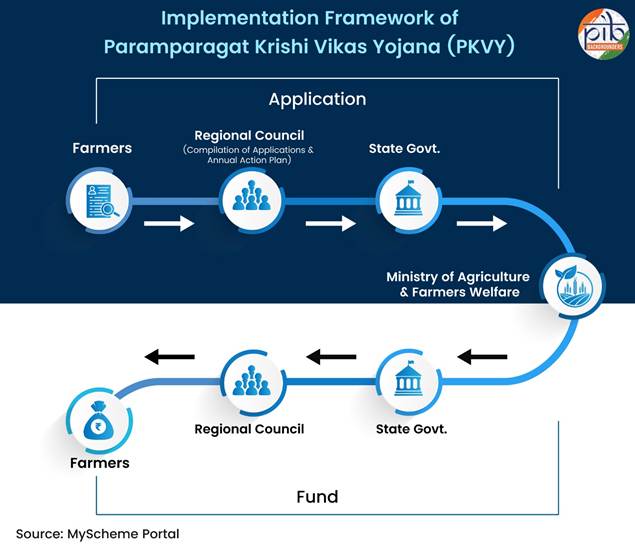
- 09 Oct 2025
In News:
The Paramparagat Krishi Vikas Yojana (PKVY), launched in 2015 under the National Mission for Sustainable Agriculture (NMSA), is India’s flagship programme to promote organic farming. Over the past decade, it has become central to the country’s efforts to shift from input-intensive agriculture toward sustainable, eco-friendly, and farmer-led models of food production.
Rationale and Need
Indian agriculture, though rooted in traditional knowledge, has witnessed increasing soil degradation, declining biodiversity, and rising chemical dependence. PKVY aims to restore ecological balance, ensure food safety, and enhance farmer incomes through a structured transition to organic farming.
Key Objectives
- Promote chemical-free, eco-agriculture and improve soil health.
- Support farmer collectives in production, certification, and marketing.
- Ensure sustainable income generation through premium pricing and reduced input costs.
- Build domestic and export markets for certified organic products.
- Foster climate-resilient agriculture and biodiversity conservation.
Implementation Framework
PKVY operates on a cluster-based model, where farmers are mobilized in groups of 20 hectares to adopt organic practices collectively.
Each participating farmer receives ?31,500 per hectare for three years, distributed as:
- ?15,000 for on-farm/off-farm organic inputs (via DBT)
- ?4,500 for marketing, packaging & branding
- ?3,000 for certification and residue analysis
- ?9,000 for training & capacity building
Implementation follows a bottom-up approach:
- Farmers approach Regional Councils, which compile and submit Annual Action Plans to the Ministry of Agriculture & Farmers Welfare.
- Funds are released by the Centre to States, and then to farmers through Direct Benefit Transfer (DBT), ensuring transparency and timely assistance.
Eligibility is open to all farmers and institutions, with a landholding limit of two hectares per beneficiary.
Organic Certification Framework
To ensure market credibility, PKVY integrates two certification systems:
- National Programme for Organic Production (NPOP):
- Administered by the Ministry of Commerce & Industry.
- A third-party certification ensuring compliance with global organic standards for production, processing, and exports.
- Participatory Guarantee System (PGS-India):
- Operated by the Ministry of Agriculture & Farmers Welfare.
- A community-based, peer-review system allowing small and marginal farmers to self-certify through mutual verification.
- Recognized for the domestic market under the Jaivik Bharat logo.
To accelerate certification, the Large Area Certification (LAC) programme was launched in 2020–21 for areas where chemical farming was never practiced—such as tribal belts, islands, and eco-preserved zones. The LAC model reduces the conversion period from 2–3 years to a few months.
Associated Initiatives
- Mission Organic Value Chain Development for North Eastern Region (MOVCDNER): Supports organic farming in the NE states through value-chain and market linkages.
- Jaivik Kheti Portal: A digital marketplace connecting farmers, buyers, and input suppliers for direct sale of organic produce.
- Formation of 10,000 Farmer Producer Organizations (FPOs): Strengthening collective marketing and input access for organic producers.
India’s Organic Landscape
- India ranks 4th globally in certified organic area (IFOAM, 2022) and 1st in the number of organic farmers.
- Madhya Pradesh has the largest certified area, followed by Maharashtra, Rajasthan, Gujarat, and Karnataka.
- Organic exports: valued at $708 million (2022–23), with global market potential exceeding $138 billion.
Ortolan Bunting
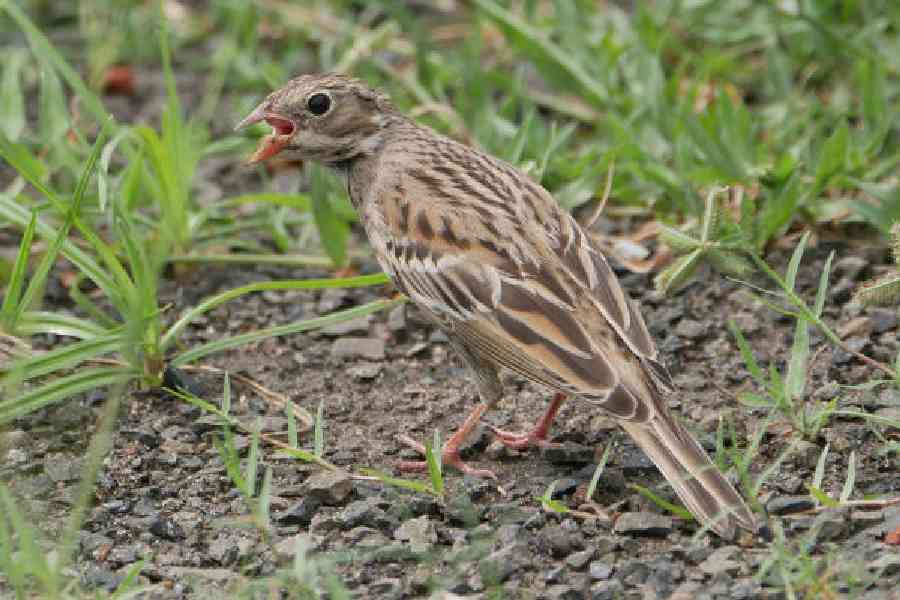
- 08 Oct 2025
In News:
A rare European migratory bird, the Ortolan Bunting (Emberizahortulana), was recently spotted in Baruipur, on the southern outskirts of Kolkata, West Bengal. This marks only the second recorded sighting of the species in the state, with the last being in the Sundarbans in 2014.
About Ortolan Bunting:
- Scientific Name:Emberizahortulana
- Type: Small Palearctic migratory songbird
- Distribution: Native to Europe and parts of Central Asia, extending east to Mongolia and north to the Arctic Circle.
- Migration: The species typically migrates to sub-Saharan Africa during the winter months.
Habitat and Characteristics:
- Preferred Habitat: Open or semi-open agricultural lands, slopes, and grasslands with scattered shrubs; generally avoids dense forests and oceanic climates.
- Altitude Range: Found up to 2,500 metres in suitable habitats.
- Physical Features:
- Length: 16–17 cm; Wingspan: about 25 cm.
- Males have a greenish-grey head, yellow throat, and brown-streaked body.
- Females and juveniles are smaller and duller, with spotted underparts.
- Possess a conical beak suited for cracking seeds.
Conservation Status:
- IUCN Red List: Least Concern
Despite its status, the Ortolan Bunting faces population decline in parts of Europe due to habitat loss and illegal hunting — particularly in France, where it was once considered a delicacy.
Significance of the Sighting:
- Highlights the importance of citizen-led biodiversity monitoring through platforms like eBird and BirdForum.
- Suggests potential changes in migratory routes, possibly influenced by climatic shifts.
- Reinforces West Bengal’s ecological diversity, which continues to attract rare and migratory bird species.
PM-SETU Scheme
- 08 Oct 2025
In News:
- Prime Minister Narendra Modi launched a series of youth-focused initiatives worth over ?62,000 crore, aimed at empowering India’s young population through education, skill development, and entrepreneurship.
- The announcements were made during the Kaushal DeekshantSamaroh held at Vigyan Bhawan, New Delhi, marking a significant step toward building a future-ready workforce aligned with global skill demands.
Pradhan Mantri Skilling and Employability Transformation through Upgraded ITIs (PM–SETU)
The centrepiece of the event was the launch of the PM–SETU scheme — a centrally sponsored initiative with an investment of ?60,000 crore. The scheme seeks to revitalize Industrial Training Institutes (ITIs) across India, transforming them into modern, industry-linked centers of skill excellence.
Key Features of PM–SETU
- Coverage: Transformation of 1,000 Government ITIs into modern, technology-driven institutes.
- Implementation Model:
- Based on a Hub-and-Spoke structure, comprising 200 hub ITIs connected to 800 spoke ITIs.
- Hub ITIs will host innovation centers, incubation units, production facilities, and training-of-trainers setups.
- Spoke ITIs will extend outreach, ensuring skill accessibility to smaller towns and semi-urban regions.
- Curriculum and Industry Linkage:
- Introduction of new demand-driven courses and modernization of existing ones in collaboration with industry partners.
- Establishment of Special Purpose Vehicles (SPVs) with anchor industries to ensure cluster-based training and employability outcomes.
- Academic Integration: Creation of pathways for short-term training, executive programs, and long-term diploma courses to align with higher education and employment opportunities.
- Centres of Excellence: Strengthening of five National Skill Training Institutes—
- Bhubaneswar (Odisha)
- Chennai (Tamil Nadu)
- Hyderabad (Telangana)
- Kanpur (Uttar Pradesh)
- Ludhiana (Punjab)
These will serve as global-level Centres of Excellence through partnerships with leading international institutions.
- Global Collaboration: The initiative is co-financed by the World Bank and the Asian Development Bank (ADB), with the first phase focusing on Patna and Darbhanga ITIs in Bihar.
Other Youth-Focused Announcements
- Vocational Skill Labs: Inauguration of 1,200 vocational skill labs across 400 Jawahar Navodaya Vidyalayas (JNVs) and 200 Eklavya Model Residential Schools spread across 34 States and Union Territories, to integrate skill education at the school level.
- Bihar’s Revamped MukhyamantriNishchay Swayam Sahayata Bhatta Yojana:
- Under the revamped scheme, five lakh graduate youth in Bihar will receive a monthly allowance of ?1,000 for two years, along with free skill training.
- The scheme aims to enhance youth employability and entrepreneurship readiness.
- Karpoori Thakur Skill University: A Skill University named after Bharat RatnaKarpoori Thakur will be established to honor his contribution to social empowerment and education.
- Recognition of Excellence: The Prime Minister also felicitated 46 All India Toppers from Industrial Training Institutes (ITIs) under the Ministry of Skill Development and Entrepreneurship (MSDE).
MeerKAT Radio Telescope

- 08 Oct 2025
In News:
An international team of astronomers has recently used South Africa’s MeerKAT Radio Telescope to identify a new giant radio galaxy (GRG) within the COSMOS field, as part of the MeerKAT International GHz Tiered Extragalactic Exploration (MIGHTEE) survey. The discovery, published on November 11, offers valuable insights into the formation and evolution of radio galaxies and the large-scale structure of the universe.
About the MeerKAT Radio Telescope
- Location: Situated in the Northern Cape province of South Africa, MeerKAT is a world-class radio interferometer operated by the South African Radio Astronomy Observatory (SARAO).
- Origin: Initially conceptualized as the Karoo Array Telescope (KAT) with 20 dishes, its scope was later expanded to 64 dishes, leading to its renaming as “MeerKAT” (meaning “more of KAT”).
- Specifications: Each dish measures 13.5 meters in diameter, spread across a maximum distance of 8 km.
- Technology: Signals received by individual dishes are transmitted to a central processor, allowing them to function collectively as a single, high-resolution telescope.
- Purpose:MeerKAT is a precursor instrument for the Square Kilometre Array (SKA) — the world’s largest and most sensitive radio telescope project, aimed at exploring the origin and evolution of the universe.
- Significance: Currently, MeerKAT is among the most powerful radio interferometers operating at centimetre wavelengths, enabling detailed observations of distant cosmic structures.
About Radio Galaxies
A radio galaxy is a type of galaxy that emits intense radio waves extending far beyond its visible boundaries. These emissions typically arise from jets and lobes of plasma produced by the galaxy’s active galactic nucleus (AGN), which is powered by a supermassive black hole.
The interaction of these jets with surrounding matter generates synchrotron radiation, making such galaxies prominent sources of radio emissions in the cosmos.
The Discovery: MGTC J100022.85+031520.4
Using MeerKAT’s advanced capabilities, astronomers identified a new giant radio galaxy (designated MGTC J100022.85+031520.4) within the COSMOS field.
Key Characteristics:
- Host Galaxy: Elliptical galaxy SDSS J100022.85+031520
- Redshift: Approximately 0.1034
- Size: About 4.2 million light years in projected length — qualifying it as a Giant Radio Galaxy (GRG)
- Mass: Nearly 93 trillion solar masses
- Radio Power:597 ZW/Hz at 1,284 MHz
- Age: Estimated 1 billion years
- Jet Power: Around 1 million QW
- Location: Identified as the Brightest Cluster Galaxy (BCG) within the galaxy cluster WHL J100022.9+031521
This makes it one of the few (around 4%) known GRGs that exist within a cluster environment rather than in isolated regions.
Baratang Island
- 08 Oct 2025
In News:
India’s only mud volcano, located at Baratang Island in the Andaman and Nicobar Islands, has erupted again after more than two decades.
About Baratang Island
- Location:Baratang Island lies in the North and Middle Andaman district, approximately 150 km from Port Blair.
- Geological Uniqueness: It is home to India’s only known mud volcanoes, making it a prominent site for geological study and eco-tourism.
- Tribal Presence: The region is also inhabited by the Jarawa tribe, one of the indigenous groups of the Andaman and Nicobar Islands.
- Previous Activity: The last major eruption occurred in 2005, which was attributed to seismic activity and oceanic tectonic movements in the region.
What are Mud Volcanoes?
- Definition: Mud volcanoes, also known as “mud domes,” are geological structures formed by the eruption of mud slurries, gases, and water rather than molten rock.
- Formation Process:
- They occur when gases (mainly methane, with traces of carbon dioxide or nitrogen), generated from the decay of organic matter deep underground, force a mixture of mud and water to the surface.
- This process creates cone-shaped mounds or domes resembling typical volcanoes, but without lava.
- Characteristics:
- Their temperature is much lower than that of igneous volcanoes.
- They can range from a few meters to several hundred meters in height and up to 10 km in width.
- Some mud volcanoes also exist underwater, influencing seabed topography and occasionally forming new landforms or islands.
Comparison with Barren Island Volcano
- Barren Island, another volcanic site in the Andaman region, witnessed minor eruptions in September 2025—on the 13th and 20th.
- It is located about 140 km northeast of Port Blair and is India’s only active volcanic island, lying at the junction of the Indian and Burmese tectonic plates.
- Historical records show eruptions at Barren Island in 1787, 1991, 2005, 2017, and 2022.
- Officials have clarified that the Baratang mud volcano and the Barren Island volcano are distinct geological entities—the former being sedimentary and gas-driven, while the latter is igneous and magma-driven.
Significance and Precautions
- The Baratang eruption underscores the geological dynamism of the Andaman and Nicobar region, which lies in a seismically active zone due to the subduction of the Indian Plate beneath the Burmese Plate.
- Tourism and Safety: The site is a popular tourist attraction, but safety protocols have been enforced to prevent accidents.
- Scientific Importance: Such eruptions provide valuable insights into subsurface gas activity, tectonic movement, and geothermal processes in the region.
Stable Coins
- 08 Oct 2025
In News:
The Union Finance Minister recently emphasized that countries must be prepared to engage with stablecoins, noting that rapid innovations in the cryptocurrency space are reshaping the global monetary order.
What are Stablecoins?
- Stablecoins are a category of cryptocurrencies designed to maintain a steady value by being linked to a reference asset—most often a fiat currency like the U.S. dollar, though they may also be tied to commodities or a basket of currencies.
- Unlike volatile digital assets such as Bitcoin or Ethereum, stablecoins are meant to minimize price fluctuations, making them more practical for payments, remittances, and everyday transactions within blockchain-based systems.
Types of Stablecoins
1. Fully-Backed (Collateralized) Stablecoins
- Definition: These stablecoins are backed one-to-one by tangible, high-quality assets held in reserve—typically cash, government securities, or other liquid instruments.
- Mechanism: For every coin issued, there is an equivalent amount of the pegged asset held in custody. This ensures that users can redeem their tokens for fiat currency at a fixed rate, maintaining stability and user trust.
2. Algorithmic Stablecoins
- Definition: These coins are not supported by actual reserves but rely on pre-programmed algorithms to keep their value stable.
- Mechanism:
- When the coin’s price rises above its target value, the algorithm issues more tokens to increase supply.
- When the price falls below the peg, the system removes tokens from circulation to reduce supply.
This self-adjusting mechanism helps maintain price equilibrium without physical collateral.
Key Features and Advantages
- Price Stability: Designed to minimize volatility, stablecoins are suitable for trade, payments, and as a safe asset within the crypto ecosystem.
- Transaction Efficiency: They enable instant and low-cost transfers, particularly across borders, reducing reliance on traditional intermediaries.
- Programmability: Being digital and blockchain-based, stablecoins can be easily integrated into smart contracts and decentralized finance (DeFi) systems, automating financial operations.
- Digital Representation of Fiat: They serve as a blockchain version of national currencies, facilitating real-time settlements and bridging traditional and digital finance.
Snow Leopard
- 07 Oct 2025
In News:
- A recent survey by the Wildlife Wing of the Himachal Pradesh Forest Department has revealed that the state now hosts 83 adult snow leopards, a notable increase from the 51 recorded in 2021.
- Conducted over one year with strong community participation, the assessment marks Himachal Pradesh as the first state in India to carry out a second state-wide snow leopard survey, providing a robust baseline for future conservation efforts.
About Snow Leopards (Panthera uncia):
- Known as the “ghost of the mountains”, snow leopards are large, elusive wild cats and serve as important indicator species for fragile high-altitude ecosystems.
- State Animal: Himachal Pradesh
- Distribution: Native to high mountains across 12 countries in Central and South Asia, including Afghanistan, China, India, Nepal, and Mongolia. In India, found in Western Himalayas (J&K, Ladakh, Himachal Pradesh, Uttarakhand) and Eastern Himalayas (Sikkim, Arunachal Pradesh).
- IUCN Status: Vulnerable (VU)
Key Characteristics:
- Physical Traits: Thick white-grey fur with dark rosettes for camouflage; powerful hind legs for leaping across rugged terrain.
- Diet: Carnivorous—feeds on blue sheep, Himalayan ibex, marmots, pikas, hares, and other high-altitude prey.
- Habitat & Territory: Prefers cold deserts and rocky slopes above 3,000 m, sometimes reaching 5,500 m; requires large territories (5–190 sq miles) due to low prey density.
- Behavior: Solitary and territorial, mostly nocturnal and elusive.
Survey Highlights:
- Conducted across six sites covering Himachal’s 26,000 sq km snow leopard habitat using camera traps.
- Snow leopards recorded in core areas such as Lahaul-Spiti, Kinnaur, and Pangi Valley, and also beyond protected areas like Kibber Wildlife Sanctuary, Great Himalayan National Park, Sechu Tuan Nala, and Asrang Wildlife Sanctuary.
- Prey and Biodiversity: Updated distribution maps for blue sheep, Himalayan ibex, musk deer, Himalayan wolves, brown bears, red foxes, leopards, and martens. First official sighting of Pallas’s cat in Kinnaur and rediscovery of the woolly flying squirrel in Lahaul.
Cyclone Shakhti
- 07 Oct 2025
In News:
Recently, the India Meteorological Department (IMD) confirmed the formation of Cyclone Shakhti over the northeast Arabian Sea. Named by Sri Lanka under the World Meteorological Organisation’s regional naming system, Shakhti is a tropical cyclonic storm forming approximately 340 km west of Dwarka, Gujarat.
Formation and Track:
The cyclone developed due to low-pressure systems over the warm Arabian Sea waters in early October 2025. IMD reports indicate:
- Shakhti intensified into a Cyclonic Storm (CS) on 3 October and was forecasted to become a Severe Cyclonic Storm (SCS) by 4 October.
- Initially moving west-northwest, it is likely to track west-southwest, reaching central parts of the north and adjoining central Arabian Sea by 5 October.
- A subsequent recurvature is expected, moving east-northeastward from 6 October.
Significance:
The occurrence of Cyclone Shakhti highlights the increasing cyclonic activity in the Arabian Sea, historically less active than the Bay of Bengal. Warmer sea surface temperatures have led to the rapid intensification of recent cyclones, including Tauktae (2021) and Biparjoy (2023), off India’s west coast.
Comparative Context:
- The Bay of Bengal experiences more cyclones due to semi-enclosed waters retaining warmth (29–30°C), abundant moisture from rivers and monsoon flows, and low-pressure pulses from Pacific typhoons.
- In contrast, the Arabian Sea is cooler, influenced by dry winds from Oman and Yemen, and lacks such external triggers, which traditionally limited cyclone intensity.
- Rising temperatures, however, are changing this pattern, making the Arabian Sea increasingly prone to severe cyclones.
Dhvani Missile
- 07 Oct 2025
In News:
India is on the verge of a historic breakthrough with the upcoming test of Dhvani, a cutting-edge hypersonic missile developed by the Defence Research and Development Organisation (DRDO). This missile positions India among an elite group of nations with hypersonic capabilities, including the United States, Russia, and China.
About Dhvani:
- Dhvani is being developed as a Hypersonic Glide Vehicle (HGV), capable of speeds exceeding Mach 5 (over 7,400 km/h).
- Unlike conventional missiles that follow predictable trajectories, Dhvani is launched to extreme altitudes and then glides toward its target with high maneuverability, making detection and interception extremely difficult. It is designed to strike both land-based and maritime targets with precision.
- Estimated ranges are 6,000 to 10,000 kilometers, potentially doubling the reach of India’s current Agni-V intercontinental ballistic missile.
Design and Technology:
- Dimensions: Approximately 9 meters long and 2.5 meters wide with a blended wing-body configuration.
- Heat Protection: Uses ultra-high-temperature ceramic composites to withstand 2,000–3,000°C during atmospheric reentry.
- Stealth Features: Angled surfaces and smooth contours reduce radar visibility.
- Indigenous Development: Built on technologies demonstrated by the Hypersonic Technology Demonstrator Vehicle (HSTDV), including scramjet propulsion and thermal shielding.
Strategic Implications:
The Dhvani missile significantly enhances India’s strategic deterrence, creating a technological edge in South Asia. Its ability to perform unpredictable maneuvers during the terminal phase renders most current missile defense systems ineffective, thereby deterring adversaries.
Global Context:
Dhvani is comparable to China’s DF-ZF, Russia’s Avangard, and U.S. programs such as Dark Eagle and HACM, which face developmental delays. India’s achievement demonstrates self-reliance in critical defense technologies and strengthens its capability for both regional security and global power projection.
Compressive Asphyxia

- 07 Oct 2025
In News:
The recent tragic stampede at a rally of TamilagaVetriKazhagam (TVK) in Velusamypuram, Tamil Nadu, resulted in 41 deaths, including nine children. Doctors have attributed most fatalities to compressive asphyxia, highlighting the dangers of overcrowded events in India.
What is Asphyxia?
Asphyxia, or asphyxiation, occurs when the body does not receive sufficient oxygen. Normally, respiration allows oxygen to circulate via blood to all cells while removing carbon dioxide. In asphyxia, inadequate oxygen can lead to unconsciousness, organ failure, or death.
Types of Asphyxia:
Medical literature classifies asphyxia into several types:
- Mechanical Asphyxia: Physical obstruction preventing normal breathing.
- Traumatic Asphyxia: Strong external force on the thoracic cavity causes blood to backflow to the brain.
- Perinatal Asphyxia: Insufficient oxygen before, during, or shortly after birth.
- Compressive Asphyxia: External pressure on the chest or abdomen prevents expansion of the lungs.
- Other Types: Include suffocation, chemical asphyxia, strangulation, and drowning.
Compressive Asphyxia in Crowds:
In large gatherings or stampedes, people can be pressed tightly against each other. The diaphragm, a key muscle for breathing, cannot contract effectively, preventing inhalation and exhalation. This leads to oxygen deprivation (hypoxia) and carbon dioxide buildup (hypercapnia), which can cause organ failure and death.
Crowd Density and Risk:
- Safe crowd density: up to 5 persons per square metre.
- Densities above 6–7 per square metre significantly increase the risk of compressive asphyxia.
- The UK’s Green Guide suggests a maximum of 4.7 persons per square metre for standing areas in public venues.
Preventive Measures:
To stay safe in crowds:
- Assess venue layout and crowd capacity.
- Be aware of weather conditions.
- Move with a partner and identify safe meeting points.
- Wear bright clothing and note all exit routes.
- Move diagonally or sideways to reach open spaces.
- Exit early if the situation feels unsafe.
Dark Stars

- 07 Oct 2025
In News:
Recent astronomical observations have provided evidence for the existence of “dark stars,” a hypothesized class of the earliest stars in the universe. Unlike conventional stars powered by nuclear fusion, dark stars are thought to derive their energy from dark matter annihilation.
What Are Dark Stars?
- Dark stars are believed to have existed in the early universe and may represent the first phase of stellar evolution. These stars are immense, potentially 400 to 200,000 times larger and 500 to 1,000 times more massive than the Sun. Despite their size, they are not very hot because their energy source is dark matter heating rather than nuclear fusion.
- Unlike ordinary stars, dark stars are giant, puffy clouds rather than compact objects. They could shine as brightly as an entire early galaxy, emitting gamma rays, neutrinos, and possibly antimatter, but remain largely invisible in visible light. This explains why they have remained undetected until recent observations.
Recent Discoveries:
Data from the James Webb Space Telescope (JWST) has identified four candidate dark stars whose light profiles align with theoretical predictions for supermassive dark stars. If confirmed, these findings could:
- Explain the presence of unusually bright objects in the early universe.
- Offer insights into the formation of the first supermassive black holes, a longstanding puzzle in cosmology.
Significance for Cosmology:
Understanding dark stars provides crucial insights into:
- The role of dark matter in early stellar evolution.
- The transition from the first stars to the formation of galaxies and black holes.
- The evolution of the universe’s luminous structure in its formative stages.
Akshar Fast Patrol Vessel

- 06 Oct 2025
In News:
The Indian Coast Guard Ship (ICGS) Akshar, the second vessel in a series of eight Adamya-class Fast Patrol Vessels (FPVs), was commissioned at Karaikal, Puducherry. Built by Goa Shipyard Limited (GSL), this indigenously designed vessel represents a major stride in India’s maritime self-reliance under the ‘Aatmanirbhar Bharat’ and ‘Make in India’ initiatives.
About ICGS Akshar
- Class and Type:Adamya-class Fast Patrol Vessel (FPV)
- Shipbuilder: Goa Shipyard Limited (GSL)
- Indigenous Content: Over 60%
- Length: 51 metres
- Displacement: Approximately 320 tonnes
- Name Significance: ‘Akshar’, meaning imperishable, signifies the Indian Coast Guard’s unwavering resolve to ensure safe, secure, and clean seas.
Key Technical and Operational Features
- Propulsion System:Equipped with two 3,000 kW diesel engines driving indigenously developed Controllable Pitch Propellers (CPP) and gearboxes, the vessel can achieve a maximum speed of 27 knots.
- Endurance:Capable of operating up to 1,500 nautical miles at an economical cruising speed, enabling extended surveillance missions.
- Weapons and Defence Systems:Armed with a 30 mm CRN 91 gun and two 12.7 mm Stabilised Remote-Controlled Guns (SRCG), integrated with an advanced Fire Control System, enhancing accuracy and combat effectiveness.
- Automation and Navigation Systems:Features an Integrated Bridge System (IBS), Integrated Platform Management System (IPMS), and Automated Power Management System (APMS) for high operational efficiency, reduced human intervention, and seamless information integration.
- Deployment:The vessel will be based at Karaikal, Puducherry, under the administrative and operational control of the Commander, Coast Guard Region (East) through District Headquarters No. 13.
Strategic Role and Functions
ICGS Akshar will be deployed for:
- Maritime surveillance and coastal security operations in India’s Exclusive Economic Zone (EEZ).
- Anti-smuggling, anti-poaching, and anti-piracy operations.
- Search and Rescue (SAR) missions, pollution control, and law enforcement duties in the maritime domain.
Its operational flexibility and advanced systems make it a multi-role platform capable of responding swiftly to emerging maritime threats and humanitarian contingencies.
India–Russia at 25

- 06 Oct 2025
In News:
- India and Russia marked 25 years of their Strategic Partnership in 2025, reaffirming their time-tested friendship and multifaceted cooperation amid a shifting global order.
- The partnership, first formalised in October 2000 through a declaration signed by President Vladimir Putin and Prime Minister Atal Bihari Vajpayee, was upgraded in 2010 to a “Special and Privileged Strategic Partnership.” This milestone underscores the enduring relevance of bilateral ties grounded in mutual trust, strategic autonomy, and converging global outlooks.
Evolution of the Partnership
- Over the last quarter-century, the India–Russia relationship has transitioned from a Cold War–era friendship to a broad-based strategic partnership encompassing defence, nuclear energy, science and technology, hydrocarbons, and space cooperation.
- Institutional mechanisms like the Intergovernmental Commission (IRIGC) and the 2+2 Dialogue framework have ensured sustained policy coordination across political, economic, and defence domains.
- At the 22nd Annual Summit held in Moscow in July 2024, both nations adopted joint statements on partnership and economic cooperation till 2030, alongside signing nine MoUs across critical sectors. Prime Minister Narendra Modi was also conferred Russia’s highest civilian honour, the Order of Saint Andrew, in recognition of his contribution to strengthening bilateral relations.
Multilateral and Global Engagement
- India and Russia continue to coordinate closely in multilateral platforms such as the United Nations (UN), G20, BRICS, and Shanghai Cooperation Organisation (SCO).
- During India’s G20 and SCO presidencies in 2023, the two nations held multiple high-level engagements, reaffirming commitment to a multipolar, rules-based international order.
- Russia has consistently supported India’s bid for a permanent seat in the UN Security Council, underscoring its trust in India’s global leadership role.
- Russia’s BRICS chairmanship in 2024 further strengthened this cooperation, with India actively participating in the Leaders’ Summit in Kazan, reflecting mutual alignment on global economic and security issues.
Economic and Trade Relations
- Economic engagement has become the new anchor of India–Russia relations. Bilateral trade reached a record USD 65.7 billion in FY 2023–24, driven by India’s rising imports of crude oil, fertilizers, and minerals, and exports of pharmaceuticals, machinery, and engineering goods.
- Both nations aim to elevate bilateral trade to USD 100 billion by 2030 and mutual investments to USD 50 billion by 2025.
- Negotiations for a Free Trade Agreement (FTA) between India and the Eurasian Economic Union (EAEU) are underway, expected to further liberalise trade flows and enhance connectivity through initiatives like the International North–South Transport Corridor (INSTC) and Arctic route cooperation.
- Emerging areas such as shipbuilding, railways, aircraft construction, and small modular nuclear reactors reflect the partnership’s adaptation to new technological and developmental priorities.
Defence and Security Cooperation
Defence remains the cornerstone of the India–Russia partnership. The collaboration has evolved from a buyer–seller relationship to joint production and technology co-development.
Key projects include:
- S-400 Triumf missile systems
- Su-30MKI and MiG-29 fighter jets
- T-90 tanks and AK-203 rifles
- INS Vikramaditya aircraft carrier
- BrahMos missile joint venture, a symbol of high-end defence collaboration
Joint military exercises such as INDRA and Vostok enhance interoperability and strategic trust. The cooperation under IRIGC–Military and Military Technical Cooperation (M&MTC) ensures continuous modernization of India’s armed forces with Russian collaboration.
Science, Technology, and Space Cooperation
- Science and technology have emerged as vital pillars of bilateral engagement. A 2021 roadmap guides collaboration in nanotechnology, quantum computing, artificial intelligence, and space exploration.
- The Kudankulam Nuclear Power Plant remains a flagship project, with plans for future units under discussion.
- New initiatives are fostering innovation and youth cooperation through institutions like the Sirius Educational Foundation and Atal Innovation Mission, encouraging joint research and startup linkages.
- Both sides are exploring joint lunar and spaceflight missions, expanding beyond traditional sectors to future-ready technologies.
People-to-People and Educational Exchanges
Beyond strategic sectors, cultural, educational, and academic exchanges have deepened mutual understanding. Student exchanges, scholarships, and Russian language learning in Indian institutions have strengthened grassroots connections. Tourism and labour mobility are emerging as new frontiers of bilateral engagement.
Outlook and Way Forward
Marking 25 years of partnership, India and Russia are renewing their cooperation to align with the demands of a multipolar and technology-driven world. The relationship is now expanding into innovation-led, climate-conscious, and connectivity-focused domains, while retaining its traditional strengths in defence and energy.
The upcoming 2025 bilateral summit in New Delhi—coinciding with the 15th anniversary of the “Special and Privileged” status—is expected to chart a roadmap for the next phase, prioritising:
- Concluding the India–EAEU Free Trade Agreement,
- Enhancing energy security and Arctic cooperation,
- Promoting defenceindigenisation, and
- Strengthening regional stability in Eurasia and the Indo-Pacific.
India’s Dairy Sector
- 06 Oct 2025
In News:
India’s dairy sector has witnessed a transformative expansion over the past decade, emerging as the world’s fastest-growing dairy producer. Milk production has surged by nearly 70% in 11 years, rising from 146 million tonnes in 2014–15 to 239 million tonnes in 2023–24, positioning India as a global dairy powerhouse.
India’s Global Dairy Leadership
- India contributes 24.76% of global milk output, maintaining its status as the world’s largest milk producer.
- The sector contributes around 5% to the national GDP and provides livelihoods to over 8 crore farmers, symbolising inclusive and sustainable rural development.
- The per capita milk availability has increased dramatically from 124 grams/day in 2014–15 to 471 grams/day in 2023–24, significantly exceeding the global average of 322 grams/day.
- Leading milk-producing states include Uttar Pradesh, Rajasthan, and Madhya Pradesh, with Haryana consistently ranking among the top three in per capita milk availability.
Institutional Backbone and Cooperative Revolution
- The National Dairy Development Board (NDDB), established in 1965, and the Operation Floodprogramme (1970) laid the foundation for India’s dairy success by replicating the Amul cooperative model across the country. These initiatives transformed India from a milk-deficient nation into the largest producer globally.
- Today, the cooperative network includes 22 milk federations, 241 district cooperative unions, 28 marketing dairies, and 25 Milk Producer Organisations (MPOs).
- Nearly 70% of the dairy workforce comprises women, with 35% actively participating in cooperatives, reinforcing the sector’s role in women’s empowerment.
- The government’s focus on strengthening cooperatives was reiterated by the Union Ministry of Cooperation, established in 2021. Union Home and Cooperation Minister Amit Shah announced that by 2029, every panchayat will have a cooperative society, fostering local economic resilience.
Modernisation and Expansion: Sabar Dairy as a Model
- The inauguration of the Sabar Dairy Plant in Rohtak, Haryana, marks a milestone in dairy modernisation. Built at a cost of ?350 crore, it is India’s largest integrated plant for curd, buttermilk, and sweets, producing 150 metric tonnes of curd, 10 metric tonnes of yogurt, 3 lakh litres of buttermilk, and 10,000 kg of sweets daily.
- The plant not only caters to the Delhi–NCR region but also benefits farmers across nine states, showcasing the potential of cooperative-led growth.
- This expansion aligns with India’s goal to increase its milk processing capacity from 66 million litres per day to 100 million litres per day by 2028–29, under White Revolution 2.0.
Government Schemes and Technological Advancements
The government has launched several initiatives to enhance dairy productivity and sustainability:
- National Gokul Mission – for conservation and genetic improvement of indigenous breeds.
- National Artificial Insemination Programme – to improve livestock productivity.
- Animal Husbandry Infrastructure Development Fund (AHIDF) – to support dairy processing and cold-chain facilities.
- National Animal Disease Control Programme (NADCP) – to ensure animal health security.
Additionally, national cooperative societies for animal feed production, organic manure, and circular economy utilisation of animal by-products have been established.
Advanced technologies such as embryo transfer and sex-sorted semen are being promoted for improved breeding efficiency. Research and development in dairy plant design and automation are being accelerated to make India self-reliant in dairy infrastructure.
NITI Aayog’s Tax Policy Working Paper
- 06 Oct 2025
In News:
In October 2025, NITI Aayog released the first paper under the NITI Tax Policy Working Paper Series–I, titled “Enhancing Tax Certainty in Permanent Establishment and Profit Attribution for Foreign Investors in India.” The paper seeks to enhance transparency, predictability, and fairness in India’s international taxation framework—key to attracting and sustaining foreign investment in the journey towards Viksit Bharat@2047.
Background and Rationale
- Foreign Direct Investment (FDI) has been a cornerstone of India’s economic growth, rising from USD 6 billion in 2005–06 to nearly USD 50 billion in 2024–25. Despite this growth, foreign investors have long faced tax-related uncertainties—particularly concerning the definitions of Permanent Establishment (PE) and Profit Attribution. Ambiguities in these areas have led to prolonged litigation (often lasting 10–12 years), raising compliance costs and discouraging potential investors.
- To address these challenges, NITI Aayog’s Consultative Group on Tax Policy (CGTP)—comprising representatives from the CBDT, DPIIT, ICAI, industry experts, and major consultancy firms—developed this working paper through extensive stakeholder consultations.
Key Concepts
- Permanent Establishment (PE): Refers to a fixed place of business (like a branch, office, or digital presence) through which a foreign enterprise conducts business in India. If a PE exists, the enterprise is liable to pay tax on its income arising in India.
- Profit Attribution: Determines the portion of a multinational’s profits that can be taxed in India, particularly when business activities are spread across jurisdictions.
Major Recommendations
- Optional Presumptive Taxation Scheme:
- Allows foreign companies to opt for a fixed tax rate on India-sourced revenue, based on industry norms.
- Aims to minimize litigation and enhance predictability.
- Legislative Clarity:
- Codification of PE definitions and profit attribution rules in line with OECD and UN models.
- Avoidance of retrospective taxation and inclusion of due process safeguards.
- Strengthened Dispute Resolution:
- Expansion of Advance Pricing Agreements (APAs) and Mutual Agreement Procedures (MAPs).
- Exploration of mandatory arbitration for unresolved international tax disputes.
- Administrative and Institutional Efficiency:
- Introduction of safe harbour rules to simplify compliance.
- Adoption of the OECD’s TRACE system to streamline withholding tax relief.
- Continuous training of tax officials in complex cross-border taxation matters.
- Stakeholder Engagement and Transparency:
- Mandatory public consultations before major tax law amendments.
- Enforcement of a Taxpayer Charter to uphold fairness and transparency.
Judicial Context
The Supreme Court has played a pivotal role in interpreting India’s international tax framework:
- Formula One Case (2017): Held that even temporary use of infrastructure (like a race track) could constitute a PE, emphasizing substance over form.
- Hyatt International Case (2025): Clarified that even global losses do not exempt Indian operations from taxation, reinforcing the “separate enterprise” principle.
Alignment with Global Tax Reforms
India’s approach aligns with the OECD–G20 Base Erosion and Profit Shifting (BEPS) initiative, especially Action 7, which curbs tax avoidance through agency arrangements.
- Pillar One: Ensures digital giants like Google or Amazon pay taxes where consumers are located, even without a physical presence.
- Pillar Two: Introduces a global minimum corporate tax rate of 15%, deterring profit shifting to tax havens.
Significance:
The working paper provides a comprehensive framework for reforming India’s cross-border tax regime—balancing investor confidence with national revenue interests. By enhancing certainty, reducing litigation, and aligning with international standards, it aims to:
- Strengthen India’s Ease of Doing Business environment.
- Attract high-quality, sustainable FDI and FPI.
- Bolster administrative efficiency and taxpayer trust.
Ultimately, these reforms are expected to create afair, transparent, and globally competitive tax system, reinforcing India’s trajectory toward a future-ready economy and the vision of Viksit Bharat@2047.
Draft Rules for Online Gaming

- 06 Oct 2025
In News:
The Ministry of Electronics and Information Technology (MeitY) has released the draft Promotion and Regulation of Online Gaming Rules, 2025, intended to operationalise the Promotion and Regulation of Online Gaming (PROG) Act, 2025. The government has also invited public feedback on the draft rules till the end of this month via email submission.
Objective
The draft rules aim to establish a comprehensive national framework for regulating the online gaming ecosystem in India. They seek to differentiate legitimate e-sports and social gaming from real money gaming (RMG) platforms, thereby ensuring user protection, transparency, and responsible innovation.
Key Provisions
1. Ban on Real Money Gaming: The Act prohibits real money gaming (RMG) — including online poker, rummy, fantasy sports, and betting — where players wager or stake money for potential returns. Only social games and e-sports, meant for recreation, education, or skill development, are permitted.
2. Establishment of the Online Gaming Authority of India (OGAI): A dedicated regulatory body, the Online Gaming Authority of India (OGAI), will be set up to oversee the sector.
- Composition: A Chairperson and five members representing different ministries.
- Powers: Quasi-judicial authority to summon individuals, examine evidence, and issue binding directions.
- Functions:
- Determine whether a game qualifies as an “online money game.”
- Register and certify online social games and e-sports.
- Impose penalties, suspend or cancel registrations for violations.
- Ensure compliance with ethical and revenue guidelines.
3. Registration Framework
- Mandatory Registration: All social and e-sports games must register with OGAI.
- Validity: Registration certificates will remain valid for up to five years.
- Disclosure Requirements: Companies must declare revenue sources and user protection measures.
- Revenue must originate from advertising, subscriptions, or access fees, not wagers or stakes.
4. Penalties and Offences
- Offering or operating an online money gaming service: up to 3 years’ imprisonment and ?1 crore fine.
- Advertising such platforms: up to 2 years’ imprisonment and ?50 lakh fine.
- Offences are non-bailable, and company officials can be held personally liable.
- Penalty quantum will depend on extent of gain, user loss, and frequency of violation.
5. Grievance Redressal Mechanism (Three-Tiered)
- Internal redressal unit of the gaming company.
- Grievance Appellate Committee (GAC) under the IT Rules, 2021.
- Online Gaming Authority of India (OGAI) as the final appellate body.
6. Role of Various Ministries
- Ministry of Electronics & IT (MeitY): Nodal authority for overall regulation.
- Ministry of Youth Affairs: Oversight of e-sports.
- Ministry of Information & Broadcasting (I&B): Regulation of social games, including issuing codes of practice and classification guidelines.
PM E-Drive Scheme
- 05 Oct 2025
In News:
- The Government of India has issued comprehensive guidelines for establishing 72,300 public electric vehicle (EV) charging stations across the country, backed by a ?2,000 crore support package under the ?10,900 crore PM E-DRIVE Scheme.
- The initiative, launched by the Ministry of Heavy Industries (MHI), is a major step toward strengthening India’s EV ecosystem, promoting sustainable transportation, and advancing the nation’s net-zero emissions goals.
About the PM E-DRIVE Scheme
The PM E-DRIVE (Electric Vehicle Development, Revolution, Innovation, Vision, and Empowerment)scheme is a flagship government initiative aimed at accelerating EV adoption through infrastructure development and fiscal incentives. The scheme aligns with India’s broader vision of Aatmanirbhar Bharat, energy security, and climate action.
- Nodal Ministry: Ministry of Heavy Industries
- Project Implementation Agency:Bharat Heavy Electricals Limited (BHEL)
- Financial Outlay: ?10,900 crore
- Support for EV Charging Infrastructure: ?2,000 crore
Objectives
- To create an accessible, reliable, and affordable public EV charging network.
- To reduce range anxiety among EV users and accelerate adoption.
- To decarbonize transport, thereby contributing to India’s net-zero by 2070 target.
- To promote domestic manufacturing of EV components and charging equipment under Make in India.
Key Features of the Guidelines
1. Subsidy Framework
The new guidelines introduce a tiered subsidy structure to ensure equitable deployment across varied locations:
- 100% Subsidy - Applicable for installations in government premises, educational institutions, residential colonies,hospitals, and public buildings, provided free public access is ensured.
- 80% Subsidy on Infrastructure + 70% on Equipment - Applicable to high-traffic areas such as railway stations, airports, bus depots, metro stations, municipal parking lots, oil PSU retail outlets, and toll plazas managed by NHAI or state agencies.
- 80% Subsidy - Extended to shopping malls, markets, highway outlets, and battery-swapping stations.
This financial assistance aims to minimize the initial investment barrier for operators and encourage private sector participation.
2. Priority Deployment Areas
The rollout prioritizes:
- Urban Centres: Cities with population above one million, state capitals, andsmart cities.
- Transit and Commercial Hubs:Airports, railway stations, bus terminals, and fuel stations.
- Transport Corridors:Highways and expressways with high vehicular density.
- Metro-linked Satellite Towns: To support inter-city EV travel and logistics operations.
3. Implementation Mechanism
- Nodal Agencies: State governments and designated agencies will aggregate demand, identify sites, and submit proposals through a dedicated online portal.
- Two-Phase Subsidy Release: Financial assistance will be provided in two tranches, linked to compliance, operational readiness, and performance metrics.
- Monitoring and Evaluation: BHEL, as the Project Implementation Agency (PIA), will oversee site selection, infrastructure rollout, and ensure timely completion in coordination with state bodies.
BSNL’s Swadeshi 4G Network Stack
- 05 Oct 2025
In News:
- In a significant step toward technological self-reliance, the Prime Minister of India launched Bharat Sanchar Nigam Limited’s (BSNL)fully indigenous 4G network stack and commissioned around 98,000 mobile towers nationwide.
- With this, India becomes the fifth country globally—after Denmark, Sweden, South Korea, and China—to design and deploy its own telecom stack, strengthening the Aatmanirbhar Bharat and Digital India missions.
About BSNL’s Swadeshi 4G Network Stack
The Swadeshi 4G network stack is India’s first fully indigenous end-to-end telecom system, integrating both hardware and software components. It is a cloud-native, software-driven, and 5G-ready architecture developed under the government’s Aatmanirbhar Bharat initiative.
Institutions Involved
- Core Network: Developed by the Centre for Development of Telematics (C-DOT).
- Radio Access Network (RAN): Designed by Tejas Networks.
- Integration & Deployment: Managed by Tata Consultancy Services (TCS).
- Implementation: Carried out by BSNL, with government support through the Digital Bharat Nidhi programme.
Key Features
- Fully Indigenous: Entirely built with Indian technology and manufacturing.
- Cloud-Native & Software-Driven: Enables seamless upgrades and efficient resource use.
- Future-Ready: Designed for smooth transition to 5G and later 6G without hardware overhauls.
- Green Infrastructure: Towers are solar-powered, making it India’s largest cluster of sustainable telecom sites.
- Applications Supported: Digital payments, e-governance, telemedicine, online education, precision farming, and more.
Implementation Highlights
- Infrastructure Rollout:
- Commissioned ~98,000 mobile towers, including 92,600 4G-enabled sites, built at a cost of approximately ?37,000 crore.
- Deployed across multiple states — Odisha, Andhra Pradesh, Uttar Pradesh, Maharashtra, Rajasthan, Assam, Gujarat, and Bihar.
- Connectivity Expansion:
- Around 29,000 villages have already been connected under the 4G Saturation Project.
- The next phase will connect 26,700 unserved villages, including 2,472 in Odisha, covering border, tribal, and left-wing extremism-affected regions.
- Expected to serve over 2 million new subscribers.
Significance
1. Strategic Autonomy & National Security: The project enhances India’s strategic independence in critical digital infrastructure by reducing reliance on foreign telecom vendors. This bolsters cybersecurity and ensures data sovereignty—a crucial factor for national security.
2. Economic Growth & Job Creation: The indigenous 4G rollout boosts domestic manufacturing, R&D investment, and employment across the telecom and electronics sectors. It supports Make in India and promotes export competitiveness in telecom technology.
3. Digital Inclusion: By connecting remote, border, and tribal areas, the project narrows the digital divide, empowering rural communities with e-governance services, online education, digital payments, and telehealth access.
4. Green and Sustainable Infrastructure: With the inclusion of solar-powered telecom sites, the initiative promotes environmentally sustainable growth, aligning with India’s Net Zero ambitions.
5. Future-Ready Ecosystem: The indigenous stack’s 5G-ready architecture provides a foundation for next-generation connectivity, supporting AI, IoT, smart agriculture, autonomous mobility, and industrial automation applications.
Two New Ramsar Sites in Bihar
- 05 Oct 2025
In News:
India has recently added two wetlands from Bihar — Gokul Jalashay (Buxar district) and Udaipur Jheel (West Champaran district) — to the List of Wetlands of International Importance under the Ramsar Convention.
With these inclusions, India now has 93 Ramsar sites, covering a total area of 13,60,719 hectares, consolidating its position as Asia’s leading country in terms of Ramsar designations and third globally, after the United Kingdom (176) and Mexico (144).
About the New Ramsar Sites
1. Gokul Jalashay (Buxar District)
- Type: Oxbow lake, situated on the southern edge of the River Ganga.
- Ecological Role: Acts as a natural flood buffer, reducing inundation risk for nearby settlements.
- Biodiversity: Supports over 50 species of resident and migratory birds and provides fish breeding grounds.
- Socio-economic Importance: Local communities depend on the lake for fishing, agriculture, and irrigation, integrating ecological sustainability with livelihoods.
- Cultural Practice: Villagers collectively clean and restore the wetland annually during a traditional festival, reflecting community-led conservation.
2. Udaipur Jheel (West Champaran District)
- Type: Oxbow lake located within the Udaipur Wildlife Sanctuary.
- Biodiversity: Hosts 280 plant species, including Alysicarpus roxburghianus, an Indian endemic.
- Avifauna: Serves as a key wintering habitat for over 35 migratory bird species, notably the vulnerable Common Pochard (Aythya ferina).
- Ecological Significance: Functions as a biodiversity hotspot and climate buffer, maintaining the hydrological balance in the region.
Understanding Oxbow Lakes
- An oxbow lake is a crescent-shaped waterbody formed when a meandering river is cut off from its main channel due to erosion and deposition processes. These lakes often evolve into rich wetland ecosystems, supporting diverse aquatic flora and fauna.
About Wetlands
- Wetlands are areas where water saturation—either permanent or seasonal—creates conditions that sustain distinctive plant and animal communities.
- They include marshes, fens, peatlands, floodplains, estuaries, and even shallow marine areas (up to 6 metres deep).
- They serve as ecological ecotones, forming transitions between terrestrial and aquatic systems and offering critical ecosystem services like flood control, groundwater recharge, carbon sequestration, and biodiversity support.
The Ramsar Convention
- Adopted: 1971 at Ramsar, Iran; came into force in 1975.
- Nature: An intergovernmental treaty under the auspices of UNESCO.
- Objective: To promote the conservation and wise use of wetlands and their resources.
- Criteria: A site must meet at least one of nine criteria, such as supporting 20,000 or more waterbirds, or hosting endangered species.
- India’s Participation: Ratified in 1982; currently one of the most active contracting parties.
Montreux Record
The Montreux Record is a register of threatened Ramsar sites where ecological character has degraded due to human interference or pollution.
- Indian sites listed:
- Keoladeo National Park (Rajasthan)– 1990
- Loktak Lake (Manipur) – 1993
- Chilika Lake (Odisha) was earlier listed in 1993 but successfully removed in 2002, becoming Asia’s first site to be delisted after restoration efforts.
Lecanemab Drug
- 05 Oct 2025
In News:
Australia has recently approved Lecanemab, a groundbreaking drug for the treatment of early-stage Alzheimer’s disease. Marketed under the brand name Leqembi, it represents a significant scientific advancement in tackling the root causes of Alzheimer’s, rather than merely alleviating its symptoms. However, concerns about its cost, accessibility, and safety continue to temper global enthusiasm.
About Lecanemab
- Lecanemab is a monoclonal antibody drug developed by the Japanese pharmaceutical company Eisai, in collaboration with Biogen.
- It belongs to a new generation of Alzheimer’s drugs designed to slow disease progression by targeting amyloid-beta proteins—abnormal clumps in the brain believed to cause neuronal damage and memory loss.
- Unlike traditional Alzheimer’s medications that address symptoms, Lecanemab acts on the underlying pathological process of the disease.
- It is administered intravenously (IV) through a drip, typically on a fortnightly basis for the initial 18 months, followed by monthly maintenance doses.
Mechanism of Action
- Lecanemab works by using lab-engineered antibodies that bind to amyloid-beta plaques in the brain. Once bound, the antibodies trigger the body’s immune system—particularly microglial cells—to clear these toxic protein deposits.
- This helps reduce amyloid build-up, thereby slowing neuronal damage and cognitive decline. Clinical imaging, such as PET scans, has shown significant reductions in amyloid levels among treated patients.
Efficacy and Clinical Evidence
The approval of Lecanemab followed a large phase 3 clinical trial involving 1,734 participants with early-stage Alzheimer’s or mild cognitive impairment.
- Over an 18-month period, patients receiving Lecanemab showed a 27% reduction in disease progression compared to those given a placebo.
- This translated to roughly five months of slower cognitive decline.
- Long-term follow-up data suggest continued benefit for up to four years of treatment.
However, the drug does not reverse existing symptoms, and its benefit is limited to the early stages of the disease.
Safety Concerns and Side Effects
Despite its promise, Lecanemab poses significant safety risks.
- About 12.6% of trial participants developed brain swelling (ARIA-E), while those carrying two copies of the ApoE4 gene—linked to higher Alzheimer’s risk—had a 32.6% incidence.
- 22% of those affected reported symptoms such as headache, dizziness, or vision problems, and a few cases of fatal brain hemorrhage were reported, particularly in patients also taking blood thinners.
- Regular MRI scans every three months are required to monitor these side effects.
Cost and Accessibility
- Lecanemab remains prohibitively expensive, costing around A$40,000 per year in Australia. It is not yet subsidised under the Pharmaceutical Benefits Scheme (PBS), and associated costs such as MRI and PET scans further limit access.
- The Pharmaceutical Benefits Advisory Committee (PBAC) has also raised concerns about whether the modest benefits justify the financial and healthcare burden.
Comparison with Similar Drugs
- Lecanemab follows Donanemab, another monoclonal antibody drug approved earlier in 2024. Both operate on similar mechanisms, with comparable efficacy and risk profiles.
- PBAC previously rejected Donanemab’s inclusion under the PBS, citing uncertain benefits relative to cost and patient safety—concerns that now shadow Lecanemab as well.
Understanding Alzheimer’s Disease
Alzheimer’s disease is a progressive neurodegenerative disorder and the most common cause of dementia, accounting for 60–80% of all cases. It damages brain areas responsible for memory, thinking, and language, leading to cognitive decline and loss of independence.
While age is the main risk factor (most cases occur after 65 years), genetic and environmental influences also play a role.
Wassenaar Arrangement

- 05 Oct 2025
In News:
- The Wassenaar Arrangement (WA), established in 1996, is a key multilateral export control regime that promotes transparency and responsibility in transfers of conventional arms and dual-use goods and technologies.
- It succeeded the Cold War-era Coordinating Committee for Multilateral Export Controls (COCOM). The name originates from Wassenaar, a suburb of The Hague (Netherlands), where the agreement was finalized in 1995.
Objectives and Structure
The primary goal of the WA is to prevent destabilizing accumulations of arms and sensitive technologies by ensuring that exports do not contribute to the development or enhancement of military capabilities that threaten international security. It seeks to achieve this through:
- Transparency and information exchange among member states on sensitive technology transfers.
- Control lists that detail conventional weapons, dual-use items, and technologies of military significance.
The Arrangement currently has 42 member countries, including major arms exporters. India became a member in 2017, enhancing its credentials as a responsible nuclear power and gaining access to advanced technologies. The Secretariat is located in Vienna, Austria.
Mechanism of Operation
- Member states voluntarily exchange information regarding exports and denials of items on the WA control lists. These include chemicals, materials, software, and production technologies that can have both civilian and military applications. Through this exchange, the Arrangement aims to ensure that exports do not reach entities or nations that could undermine global or regional security.
- India has aligned the WA’s control lists with its SCOMET (Special Chemicals, Organisms, Materials, Equipment, and Technologies) export framework, strengthening its export control system in line with international standards.
Emerging Challenges in the Digital Era
While the WA has evolved over time—such as by including controls on ‘intrusion software’—its framework largely focuses on physical exports like hardware, chips, and devices. However, modern technology increasingly operates through cloud-based services, data transfers, and software-as-a-service (SaaS) models, which do not always involve physical movement of goods.
This shift has created grey areas in export control enforcement. For example, when major tech infrastructure providers like Microsoft offer cloud computing or AI tools that could be misused for surveillance or repression, existing WA rules struggle to regulate such virtual exports. These challenges highlight the Arrangement’s limitations in addressing non-tangible, digital transfers of dual-use technologies.
The Need for Reform
To remain relevant, the Wassenaar Arrangement must modernize its control lists and definitions to address technologies such as:
- Cloud computing and virtualized infrastructure,
- Artificial intelligence and machine learning algorithms,
- Big data analytics and cybersecurity tools.
Strengthening coordination among member states to govern cross-border data flows and digital exports is crucial. The Arrangement should also explore mechanisms for real-time information sharing, capacity-building for developing members, and greater inclusivity in decision-making.
NCRB Data on Road Accidents
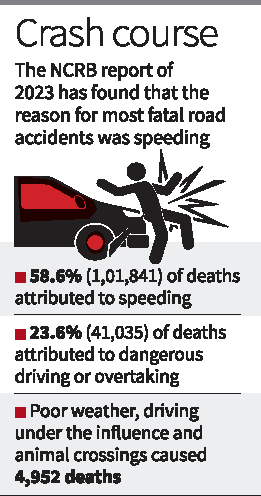
- 04 Oct 2025
In News:
According to the National Crime Records Bureau (NCRB) 2023 report, India recorded 4,64,029 road accidents, resulting in 1,73,826 deaths and 4,47,000 injuries. This marks a 1.6% rise in fatalities compared to 2022 (1,71,100 deaths) and highlights the continuing challenge of road safety in the country.
Key Trends and Statistics
- Total Accidents: 4,64,029 (17,261 more than in 2022).
- Fatalities: 1,73,826 people killed.
- Injuries: 4,47,000 people injured.
- Peak Accident Hours: 6 p.m. to 9 p.m. accounted for 20.7% of total accidents, followed by 3–6 p.m. (17.3%) and 12 noon–3 p.m. (15%).
Vehicle-Wise Analysis
Two-wheelers continued to be the most vulnerable category, responsible for nearly 46% of all road deaths.
- Two-wheelers: 79,533 deaths (45.8%)
- Pedestrians: 27,586 deaths (15.9%)
- SUVs/Cars/Jeep: 24,776 deaths (14.3%)
Tamil Nadu (11,490) and Uttar Pradesh (8,370) recorded the highest two-wheeler fatalities. Uttar Pradesh also reported the largest number of deaths due to car/SUV/jeep (19.2%) and truck/lorry (29.9%) accidents, reflecting both heavy traffic volumes and enforcement gaps.
Interestingly, while road accidents generally cause more injuries than deaths nationwide, states such as Andaman & Nicobar Islands, Jharkhand, Punjab, Bihar, and Uttar Pradesh reported higher fatalities relative to injuries.
Cause-Wise Distribution
The NCRB data highlights that speeding and careless driving remain the leading causes of fatalities:
- Speeding: 58.6% of deaths (1,01,841 fatalities)
- Dangerous or Careless Driving/Overtaking: 23.6% (41,035 fatalities)
- Other Causes: 4,952 deaths due to poor weather, intoxicated driving, or animal crossings.
Highway Fatalities
Roads designed for faster travel remain the deadliest:
- National Highways: Accounted for 34.6% of total deaths.
- State Highways: Accounted for 23.4%.
Uttar Pradesh, Tamil Nadu, Maharashtra, Karnataka, and Madhya Pradesh reported the highest fatalities on national highways.
Urban Accident Patterns
Among metropolitan areas, Delhi recorded 5,715 accidents (8.2% of total in megacities) — the highest number — followed by Bengaluru (4,980) and Chennai (3,653). Delhi also reported the highest fatalities (1,457), followed by Bengaluru (915) and Jaipur (848).
Interpretation and Policy Implications
The rising toll of road accidents underscores the multi-dimensional nature of India’s road safety crisis, rooted in over-speeding, poor enforcement, unsafe road design, and inadequate emergency response. Despite policy initiatives like the Motor Vehicles (Amendment) Act, 2019, which strengthened penalties and accountability, implementation remains uneven across states.
The dominance of two-wheeler fatalities reveals the need for:
- Stricter helmet and speed regulation enforcement,
- Improved road engineering for vulnerable users,
- Enhanced awareness campaigns, and
- Expansion of trauma care infrastructure along highways.
NCRB Data on Crime Against Children

- 04 Oct 2025
In News:
According to the latest data released by the National Crime Records Bureau (NCRB), India recorded 1,77,335 cases of crimes against children in 2023, marking a 9.2% increase from 1,62,449 cases in 2022. The crime rate rose from 36.6 to 39.9 per lakh child population, reflecting both rising incidents and improved reporting mechanisms.
Major Trends and Patterns
The report reveals that kidnapping and abduction and sexual offences under the POCSO Act dominate crimes against children, together accounting for over 83% of total registered cases.
- Kidnapping and Abduction:
- 79,884 cases (45%) were registered, victimising82,106 children — a rate of 18 per lakh.
- Within this, 58,927 were general abductions, including 37,844 cases of missing children later deemed kidnapped.
- Alarmingly, 14,637 cases involved abduction of minor girls for forced marriage.
- POCSO Act Cases:
- 67,694 cases (38.2%) were filed under the Protection of Children from Sexual Offences (POCSO) Act.
- Of these, 40,434 involved penetrative sexual assault, affecting 40,846 child victims.
- In 39,076 cases, the offender was known to the victim, including 3,224 family members, 15,146 acquaintances, and 20,706 friends, online contacts, or live-in partners who exploited trust or false promises of marriage.
Victim Demographics
Among the 40,846 victims of penetrative assault:
- 762 were below 6 years,
- 3,229 were aged 6–12 years,
- 15,444 were between 12–16 years, and
- 21,411 were aged 16–18 years.
The vast majority of victims were girls, underscoring the gendered nature of sexual crimes against children.
Other Significant Offences
Beyond sexual and abduction-related crimes, the NCRB recorded:
- 1,219 murders, including 89 linked to rape or POCSO violations.
- 3,050 cases of simple hurt and 373 cases of abetment to suicide.
- 6,038 cases under the Prohibition of Child Marriage Act and 1,390 under the Child Labour (Prohibition and Regulation) Act, indicating persistent social and economic vulnerabilities affecting children.
Regional Distribution
Madhya Pradesh reported the highest number of cases (22,393), followed by Maharashtra and Uttar Pradesh.
Among smaller states and Union Territories:
- Assam recorded 10,174 cases, reflecting a sharp rise.
- Bihar followed with 9,906 cases.
- Delhi, despite its smaller population, registered 7,769 cases, among the highest rates nationally.
Law Enforcement and Justice Delivery
- Out of 2,57,756 cases investigated during the year, 1,12,290 were chargesheeted, leading to an overall chargesheeting rate of 64.3%. However, 80,198 cases remained pending at the end of 2023, highlighting systemic backlogs in investigation and prosecution.
- The chargesheeting rate varied considerably: it was higher in Tamil Nadu and Andhra Pradesh, but lower in Delhi and Haryana, reflecting uneven institutional efficiency across states.
Interpretation and Policy Significance
The steady increase in crimes against children underscores the growing vulnerabilities of minors in physical, digital, and domestic spaces. The dominance of offences by known persons reflects a disturbing breach of familial and social trust.
While better reporting and legal awareness may partly explain the rise, the data signals the urgent need for:
- Strengthening child protection systems and POCSO courts;
- Enhancing cyber surveillance to curb online grooming and exploitation;
- Expanding community-based awareness and school safety mechanisms; and
- Ensuring speedy investigation and trial to reinforce deterrence.
Interstellar Mapping and Acceleration Probe
- 04 Oct 2025
In News:
NASA has recently launched the Interstellar Mapping and Acceleration Probe (IMAP) to study how solar particles are energised and how the Sun’s protective bubble — the heliosphere — shields our solar system from harmful cosmic radiation. This mission represents a major step toward understanding the space environment critical for both scientific research and future human space exploration.
Understanding the Heliosphere
- The heliosphere is a vast bubble-like region created by the solar wind — a continuous stream of charged particles emitted by the Sun.
- It envelops the entire solar system and acts as a protective barrier against cosmic rays and interstellar particles. However, the structure, dynamics, and boundary of the heliosphere remain poorly understood.
- Understanding how solar particles are accelerated and how the heliosphere interacts with interstellar space is crucial, as variations in solar wind intensity influence space weather — which can damage satellites, affect communications, and pose health risks to astronauts.
About the IMAP Mission
- The IMAP spacecraft aims to map the boundary of the heliosphere, trace energetic particles, and enhance space weather forecasting.
- It is positioned at the first Earth–Sun Lagrange point (L1), about 1 million miles from Earth toward the Sun, enabling continuous observation of the solar wind in real time.
- IMAP will collect and transmit near real-time data to help scientists monitor solar wind disturbances and particle radiation hazards, improving preparedness for adverse space weather events.
- Its findings will also guide the planning of safer human missions beyond Earth, through improved spacecraft shielding and optimized flight paths.
Scientific Objectives
The IMAP mission will:
- Investigate how solar particles gain energy and how they are distributed throughout the heliosphere.
- Map the heliosphere’s outer boundary to understand its interaction with interstellar space.
- Enhance models of space weather, aiding the prediction of solar storms and radiation risks.
- Explore the fundamental physics governing plasma and particle behavior on both microscopic and galactic scales.
- Determine the composition of interstellar material and improve understanding of the cosmic building blocks of the universe.
Scientific Instruments
IMAP is equipped with 10 advanced instruments, each targeting specific phenomena in space.
Key instruments include:
- Energetic Neutral Atom Detectors — IMAP-Lo, IMAP-Hi, and IMAP-Ultra — which capture neutral atoms that were once charged ions and later gained electrons.
- Instruments to measure charged particles, magnetic fields, interstellar dust, and solar wind structures.
Together, these instruments will provide a comprehensive picture of particle behavior and energy flow within and beyond the heliosphere.
Significance
The IMAP mission bridges the gap between heliophysics, astrophysics, and planetary science. Its insights will:
- Advance our understanding of how the Sun’s magnetic and particle activity influences the solar system.
- Improve space weather forecasting, ensuring the safety of satellites, astronauts, and communication networks.
- Deepen scientific knowledge of how the heliosphere shields Earth and other planets from cosmic radiation.
- Support future human space missions, contributing to safer interplanetary travel.
By mapping our galactic neighborhood and decoding the physics of space particles, IMAP will transform our understanding of the Sun–Earth connection and the cosmic environment surrounding our solar system.
Red Sanders

- 04 Oct 2025
In News:
- Recently, the National Biodiversity Authority (NBA) sanctioned ?82 lakh to the Andhra Pradesh Biodiversity Board for the conservation of Red Sanders (Pterocarpus santalinus), an endemic and endangered tree species of India.
- The initiative, undertaken under the Access and Benefit Sharing (ABS) mechanism of the Biological Diversity Act, 2002 (amended in 2023), marks a crucial step towards community-based biodiversity conservation.
About Red Sanders
- Red Sanders, also known as Red Sandalwood, is native to the Southern Eastern Ghats, particularly in the Anantapur, Chittoor, Kadapa, and Kurnool districts of Andhra Pradesh.
- The species thrives in rocky, red soil regions with a hot and dry climate, often in degraded or fallow lands.
- Renowned for its deep red wood, which commands high demand in international markets for musical instruments, furniture, and medicinal purposes, Red Sanders faces serious threats from illegal felling and smuggling. Due to its restricted distribution and exploitation, it is listed as:
- IUCN: Endangered
- CITES: Appendix II (regulated international trade)
- Wildlife (Protection) Act, 1972: Schedule IV
Conservation Initiative
- The ?82 lakh grant aims to raise one lakh saplings of Red Sanders, which will be distributed among farmers under the Trees Outside Forests (ToF)programme. This aligns with India’s broader goal of enhancing green cover beyond traditional forest areas.
- The funds are sourced from benefit-sharing amounts collected from users of Red Sanders, ensuring that economic benefits are returned to local stakeholders such as farmers, tribal communities, and Biodiversity Management Committees (BMCs). The initiative exemplifies how the Access and Benefit Sharing mechanism promotes equitable sharing of biological resources and converts conservation into a community-driven effort.
- In addition, the NBA has previously released ?31.55 crore to the Andhra Pradesh Forest Department for similar conservation and protection activities related to Red Sanders. The present funding will further strengthen grassroots conservation, generating local employment, fostering skill development, and enhancing community stewardship of biodiversity resources.
National Biodiversity Authority (NBA)
The National Biodiversity Authority, headquartered in Chennai, is a statutory body established under the Biological Diversity Act, 2002, and became operational in 2003. It works in coordination with:
- State Biodiversity Boards (SBBs): Regulate access to biological resources at the state level.
- Biodiversity Management Committees (BMCs): Function at the local level to document and conserve biodiversity through People’s Biodiversity Registers (PBRs).
Composition:
- Chairperson: An eminent expert in biodiversity conservation and sustainable resource use.
- 10 Ex-officio Members: Senior representatives from various ministries.
- 5 Non-official Members: Experts from relevant fields of biodiversity management.
National Crime Records Bureau

- 04 Oct 2025
In News:
The latest report from the National Crime Records Bureau (NCRB) highlights an alarming surge in crimes against Scheduled Tribes (STs) across India. As per the “Crime in India 2023” data, crimes against STs rose by 28.8%, from 10,064 cases in 2022 to 12,960 cases in 2023, reflecting deepening vulnerabilities of tribal communities in several parts of the country.
NCRB: Mandate and Role
Established in 1986, the NCRB functions under the Ministry of Home Affairs (MHA) as India’s central repository for crime and criminal data. Its creation followed recommendations from the Tandon Committee, the National Police Commission (1977–1981), and the MHA Task Force.
Headquartered in New Delhi, the Bureau is responsible for:
- Collection, analysis, and dissemination of crime data to aid law enforcement and policy formulation.
- Implementing and monitoring the Crime and Criminal Tracking Network and Systems (CCTNS) project, enabling interlinkage of police stations and online citizen services such as e-FIR and complaint filing.
- Maintaining the National Database of Sexual Offenders (NDSO) and managing the Online Cyber-Crime Reporting Portal, through which citizens can report offences like child pornography and cyber sexual violence.
- Hosting CyTrain, a digital training platform for cybercrime investigation and prosecution, and managing the Central Finger Print Bureau, India’s national fingerprint repository.
- Publishing annual statistical reports — Crime in India, Accidental Deaths & Suicides in India, and Prison Statistics India.
Key Findings: NCRB Crime Data 2023
The 2023 data reveals that Manipur witnessed the steepest spike in crimes against STs, registering 3,399 cases — a dramatic increase from just one case in 2022. The rise is closely linked to the ethnic violence between the Meitei and Kuki-Zo communities that erupted in May 2023.
Major offences reported in Manipur included 1,051 cases of arson, 260 cases of dacoity, 203 cases of humiliation or intimidation, and 193 cases of unlawful occupation or disposal of tribal land.
At the national level, the leading categories of offences against STs included:
- Simple hurt (21.3%) – 2,757 cases
- Riots (13.2%) – 1,707 cases
- Rape (9.2%) – 1,189 cases
State-wise, Madhya Pradesh (2,858 cases) and Rajasthan (2,453 cases) followed Manipur as the most affected states.
Crimes against Scheduled Castes (SCs) registered a marginal increase of 0.4% to 57,789 cases, while crimes against women rose 0.7% to 4,48,211 cases in 2023. The report highlighted that most offences against women were related to cruelty by husband or relatives (29.8%), kidnapping (19.8%), and assault to outrage modesty (18.7%).
Crimes against children surged by 9.2%, with 1,77,335 cases registered—predominantly under kidnapping (45%) and the POCSO Act (38.2%). Cases involving juveniles in conflict with law rose by 2.7%, totaling 31,365 cases.
|
Crime / Category |
2022 Count |
2023 Count |
% Change / Rate Info |
Notes |
|
Crimes against Scheduled Tribes (STs) — India total |
10,064 |
12,960 |
+28.8% |
Crime rate rose from 9.6 (2022) to 12.4 (2023) |
|
Manipur — Crimes against STs (state total) |
1 |
3,399 |
Huge increase |
2022 had 1 case; 2023 jumped to 3,399 |
|
Manipur — Dacoity (against STs) |
— |
260 |
— |
260 cases in 2023 |
|
Manipur — Arson (against STs) |
— |
1,051 |
— |
1,051 cases in 2023 |
|
Manipur — Intentional insult / intimidation (humiliation) |
— |
203 |
— |
203 cases in 2023 |
|
Manipur — Occupy / dispose of ST land |
— |
193 |
— |
193 cases in 2023 |
|
Crimes against Scheduled Castes (SCs) — India total |
57,582 |
57,789 |
+0.4% |
Slight increase year-on-year |
|
Crime against women — India total |
445,256 |
448,211 |
+0.7% |
Minor increase |
|
Crime against children — India total |
162,449 |
177,335 |
+9.2% |
Noticeable increase |
|
Juvenile cases (in conflict with law) |
30,555 |
31,365 |
+2.7% |
Cases involving juveniles |
Pallid Fish Eagle
- 03 Oct 2025
In News:
- The Corbett Tiger Reserve (CTR) in Uttarakhand, famed globally for its tigers, has recently emerged as a crucial sanctuary for raptors, with a preliminary survey confirming the presence of 30 species of birds of prey.
- Conducted jointly by the State Forest Department and the World Wide Fund for Nature (WWF), the survey has documented several rare and threatened species, including the Pallid Fish Eagle, whose nesting in the region is extremely rare.
Corbett Tiger Reserve: Overview
- Location: Foothills of the Himalayas, Uttarakhand.
- Established: Originally as Hailey National Park in 1936; first national park in India and the first to be included under Project Tiger.
- Terrain: Undulating with valleys; rivers Ramganga, Pallaen, and Sonanadi traverse the reserve.
- Vegetation: North Indian tropical moist and dry deciduous forests, with sal and mixed forests, interspersed with grasslands and riparian vegetation.
- Ecological Significance: A vital ecological corridor supporting both tiger populations and diverse avian species.
Pallid Fish Eagle (Haliaeetus leucoryphus)
- Common Names: Pallas’s Sea Eagle, Band-Tailed Fish Eagle.
- Size & Appearance: Large, brownish sea eagle.
- Habitat: Near lakes, rivers, and marshes, ranging from lowlands to 5,000 metres elevation.
- Diet: Primarily fish, but also opportunistically hunts other prey.
- Breeding: Builds large nests in tall trees, usually near water bodies.
- Distribution: East Palearctic regions — Kazakhstan, Russia, Tajikistan, Turkmenistan, Uzbekistan, Mongolia, China, India, Nepal, Bangladesh, and Myanmar.
- Conservation Status: Endangered (IUCN Red List).
- Threats: Habitat degradation, pollution, overfishing, and human disturbances.
- Significance in CTR: The discovery of a nesting site indicates active breeding, highlighting the reserve as a safe habitat for this threatened raptor.
Raptor Diversity in CTR
- Total Species Documented: 30 species of raptors, including both resident and migratory birds.
- Nesting Species: Evidence of nests from nine raptor species, including:
- Crested Serpent Eagle
- Hawk Eagle
- Red-Headed Vulture
- Indian Spotted Eagle
- White-Rumped Vulture
- Egyptian Vulture
- Indian Vulture
- Significance: The presence of nests indicates active breeding, confirming CTR as a protected and thriving habitat for raptors.
Conservation and Ecological Implications
- The discovery emphasizes CTR’s dual role as a tiger reserve and a key sanctuary for avian predators.
- Historical declines in vulture populations due to habitat disruption and veterinary drug use underscore the importance of protected habitats like CTR.
- CTR provides a superior ecological corridor, allowing threatened and migratory species to breed and sustain populations.
- Ongoing surveys aim to collect species profiles, population counts, and nesting specifics, forming the basis for targeted conservation strategies.
Swachh Shehar Jodi Initiative

- 03 Oct 2025
In News:
- The Ministry of Housing and Urban Affairs (MoHUA) has launched the Swachh Shehar Jodi (SSJ) initiative, a structured mentorship and collaborative action program under the Swachh Bharat Mission – Urban (SBM-U).
- This initiative pairs top-performing mentor cities with low-performing mentee cities to facilitate knowledge-sharing, peer learning, and replication of best practices in sanitation and waste management.
Objectives
The primary aim of the SSJ initiative is to:
- Support low-performing cities in improving their sanitation outcomes.
- Replicate tested best practices in waste management and urban cleanliness.
- Foster peer learning, experience sharing, and collaborative urban transformation.
- Ensure no city is left behind in the spirit of Antyodaya, promoting inclusive urban development.
Structure of the Initiative
- Mentor Cities: Selected from the Super Swachh League, which comprises cities consistently ranking 1st, 2nd, or 3rd in Swachh Survekshan (SS) 2022, 2023, and 2024 across various population categories. Additional mentors include promising clean cities identified in SS 2024.
- Mentee Cities: Selected from the lowest ranks in their State’s cumulative SS rankings, with preference for geographical proximity to mentor cities.
- Scale: The initiative involves 72 mentor cities paired with around 200 mentee cities. Nearly 300 Memorandums of Understanding (MoUs) were signed simultaneously to formalize these partnerships.
Implementation Approach
- 100-Day Program: Each mentor–mentee pair develops an action plan with clear milestones, focusing on knowledge transfer and implementation of best practices.
- Capacity Building Funds: Both mentor and mentee cities can utilize funds allocated under SBM-U 2.0, supplemented by state contributions or other sources.
- Policy Support: MoHUA provides strategic guidance and monitoring to ensure effective implementation.
- Evaluation: Progress will be assessed through Swachh Survekshan 2026, measuring improvements in sanitation performance.
Significance
- Represents one of the largest time-bound mentorship frameworks in urban sanitation in India.
- Encourages citizen engagement, resilient governance, and operational excellence.
- Promotes scaling of successful urban waste management practices across diverse cities.
- Aligns with the broader vision of Swachh Bharat Mission by building capacity, capabilities, and collaborative urban governance.
Ophiorrhizaechinate
- 03 Oct 2025
In News:
In a remarkable botanical discovery, researchers have identified a new species of coffee plant, Ophiorrhizaechinata, in the biodiversity-rich shola forests of Devikulam, located in the Idukki district of Kerala. The finding underscores the ecological richness of the Western Ghats, a UNESCO World Heritage Site and one of the world’s eight “hottest hotspots” of biological diversity.
About Ophiorrhizaechinata
- Ophiorrhizaechinata is a newly discovered species belonging to the Rubiaceae family, which also includes the well-known coffee plant (Coffea species).
- The discovery was made by botanists from Sacred Heart College, Thevara, St. Teresa’s College, Ernakulam, and St. Thomas College, Thrissur, and has been published in the Nordic Journal of Botany.
- The plant grows in the ecotone region — the transitional zone between evergreen forests and grasslands — at an altitude of about 1,630 metres above sea level.
- So far, the species has been recorded only from its type locality in Devikulam, with an area of occupancy less than 4 sq. km and a population of around 35 plants, indicating its extremely limited distribution.
Biological Characteristics and Significance
- The species is closely related to Ophiorrhizamungos, commonly known as Indian Snake Root, which has long been used in traditional medicine for its anticancer and anti-venom properties.
- Given this close genetic relationship, researchers believe O. echinata may possess valuable medicinal potential, warranting further phytochemical and pharmacological studies.
- Its presence in the shola ecosystem—a habitat known for high endemism and speciation—highlights the ecological uniqueness and evolutionary importance of such forest environments.
Ecological and Conservation Importance
- The discovery reinforces the Western Ghats’ status as a centre of endemism, particularly for the Rubiaceae family, to which over ten coffee-related species are native in India.
- The limited distribution and small population make O. echinatavulnerable to habitat loss and anthropogenic pressures such as deforestation, tourism, and climate change.
- Scientists emphasize the need for urgent habitat conservation measures and in-situ protection to ensure the species’ survival, along with further research on its chemical composition and ecological interactions.
Coffee Diversity in India
- India produced approximately 3.63 lakh metric tonnes of coffee in 2024–25, mainly of Arabica and Robusta varieties.
- However, the discovery of Ophiorrhizaechinata adds to the botanical richness of native coffee-related plants found in the Western Ghats. According to the Coffee Board of India, over 100 coffee plant species are known globally, of which more than ten occur naturally in the Western Ghats region.
Preponderance of Probability

- 03 Oct 2025
In News:
- The Ayodhya title dispute judgment—a landmark decision of the Supreme Court—was founded on the principle of “preponderance of probabilities”, a key evidentiary standard in civil law. Former
- Chief Justice of India D.Y. Chandrachud (part of the 2019 constitutional bench) noted that the verdict was based not on religious sentiment or historical conjecture, but on civil law principles of possession and probability regarding ownership of the inner and outer courtyards of the disputed site.
Understanding the Principle of Preponderance of Probability
- The preponderance of probability is the standard of proof used in civil proceedings to determine whether a fact or claim is more likely to be true than false.
- It represents a balance of likelihoods, where the court weighs the evidence from both sides and accepts the version that appears more probable based on the available proof.
- Unlike the criminal law standard of “beyond a reasonable doubt”, which requires a very high degree of certainty before convicting an accused, the civil standard merely requires showing that a claim is more likely than not.
Key Features
- A fact is considered proved if the court believes it exists on the balance of probabilities, as defined under Section 3 of the Indian Evidence Act, 1872.
- The party bearing the burden of proof (typically the plaintiff) must present evidence that outweighs the opposing party’s version.
- The court does not demand absolute proof but relies on weighing evidence and drawing reasonable inferences.
This principle was elaborated in the case Narayan Ganesh Dastane v. Sucheta Narayan Dastane (1975), where the Supreme Court held that civil cases are determined based on which side’s evidence appears more credible, not necessarily conclusive.
Application in Civil Law
The preponderance of probability is the cornerstone of civil litigation, especially in matters relating to:
- Property and ownership disputes
- Contract enforcement
- Tort claims
- Family law and matrimonial matters
For instance, in a breach of contract case, a plaintiff only needs to establish that it is more likely than not that the contract was violated, rather than proving it beyond all possible doubt.
Ayodhya Judgment: Application of Civil Law Principles
In the Ayodhya title dispute case (2019), the Supreme Court applied the civil law test of possession and preponderance of probabilities to resolve competing claims over the disputed land.
The Court’s approach was rooted in legal reasoning rather than theological or emotive considerations.
Key Legal Reasoning
- The Court examined historical records, revenue documents, and testimonies to determine who had better evidence of possession of the inner and outer courtyards.
- The verdict concluded that while both Hindu and Muslim communities had worshipped at the site, the Hindus had stronger evidence of continued possession of the outer courtyard and belief in the Ram Janmabhoomi.
- The Muslim parties could not sufficiently establish exclusive possession of the inner courtyard before 1857.
- Hence, the balance of probabilities favored the Hindu claimants for ownership and management rights of the site.
Importantly, the judgment relied purely on civil law principles of possession and balance of probabilities, not on any assertion that the mosque’s construction was a desecration—a claim that does not feature in the 2019 verdict, despite later commentary.
Significance of the Principle
- Reinforces the objectivity of civil adjudication, where factual probabilities outweigh moral or religious narratives.
- Demonstrates the distinction between civil and criminal standards of proof in Indian jurisprudence.
- Ensures fairness in property disputes, where ownership is determined by evidence and not sentiment.
- Serves as a model case for the application of the Indian Evidence Act in balancing complex historical and legal claims.
PM E-DRIVE Scheme
- 03 Oct 2025
In News:
The Government of India has issued detailed operational guidelines for setting up around 72,300 public electric vehicle (EV) charging stations across the country, backed by an allocation of ?2,000 crore under the broader ?10,900 crore PM E-DRIVE Scheme. This initiative marks a major step towards achieving sustainable mobility and reducing India’s dependence on fossil fuels.
About the PM E-DRIVE Scheme
- The PM E-DRIVE (Electric Drive Revolution in Innovative Vehicle Enhancement) scheme was launched in October 2024 by the Ministry of Heavy Industries (MHI).
- It is a flagship program designed to accelerate EV adoption, strengthen charging infrastructure, and develop a robust domestic manufacturing ecosystem.
- The scheme is operational from October 1, 2024, to March 31, 2026.
Objectives
- Promote mass mobility through electrified public transport systems.
- Encourage domestic manufacturing of EVs and components under the Phased Manufacturing Programme (PMP).
- Support the creation of a comprehensive network of charging stations.
- Reduce vehicular pollution and enhance urban air quality.
- Facilitate the transition to a self-reliant (Aatmanirbhar) EV ecosystem.
Key Components of the Scheme
- Demand Incentives
- Financial support for purchasing e-2 wheelers, e-3 wheelers, e-ambulances, e-trucks, and electric buses.
- Focus on promoting electric public transport and commercial fleets.
- Grants for Capital Assets
- Funding for electric buses, public charging infrastructure, and testing facilities under MHI.
- States are encouraged to extend additional fiscal and non-fiscal incentives, such as road-tax waivers, permit exemptions, and reduced toll or parking fees.
- Administrative Support: Includes costs for Information, Education & Communication (IEC) activities and Project Management Agency (PMA) fees to ensure smooth implementation.
Implementation Framework
The scheme will be monitored by the Project Implementation and Sanctioning Committee (PISC), chaired by the Secretary, Heavy Industries.
- PISC will oversee progress, address challenges, revise incentives when necessary, and approve technical guidelines.
- Only vehicles registered under the Central Motor Vehicle Rules (CMVR) and equipped with advanced battery technology are eligible for incentives.
Bharat Heavy Electricals Limited (BHEL) serves as the Nodal Agency for:
- Demand aggregation for EV charging infrastructure.
- Development of a Unified EV Super App to provide real-time charger availability, slot booking, payments, and deployment tracking — promoting digital accessibility for users.
Guidelines for EV Charging Infrastructure (2025)
The Ministry of Heavy Industries issued a tiered subsidy framework to promote the establishment of EV charging stations nationwide.
Subsidy Structure
- 100% subsidy on upstream infrastructure and charging equipment for:Government offices, residential colonies, hospitals, and educational institutions (if open for public use).
- 80% subsidy on upstream infrastructure and 70% on equipment for:High-traffic public locations such as railway stations, airports, metro stations, bus terminals, toll plazas, and municipal parking lots.
- 80% subsidy on upstream infrastructure for:Shopping malls, markets, highways, expressways, and battery-swapping stations.
Deployment Priority
The scheme prioritizes:
- Cities with over one million population,
- State capitals, smart cities, metro-linked satellite towns, and
- High-density transport corridors.
Eligible government agencies are to designate nodal bodies to identify sites, aggregate demand, and submit proposals via a dedicated online portal.
BHEL will act as the Project Implementation Agency (PIA), with subsidies released in two tranches linked to performance and compliance milestones.
UNESCO’s World Network of Biosphere Reserves
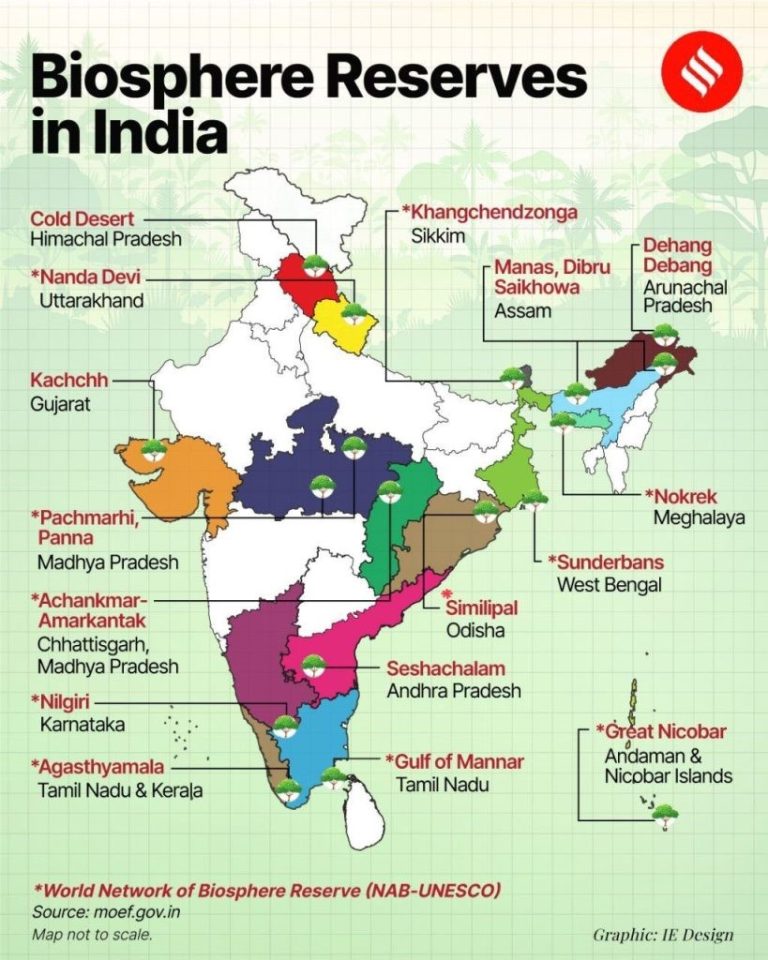
- 02 Oct 2025
In News:
UNESCO has included India’s Cold Desert Biosphere Reserve, located in Lahaul-Spiti district of Himachal Pradesh, in its World Network of Biosphere Reserves (WNBR) during the 37th ICC–MAB session (2025). This recognition makes it India’s first high-altitude cold desert biosphere reserve to join the global network, highlighting the country’s commitment to sustainable mountain ecosystem management.
About the Cold Desert Biosphere Reserve
- Established: 2009
- Location: Western Himalayas, Trans-Himalayan region of Himachal Pradesh
- Area: 7,770 sq. km
- Altitude: 3,300–6,600 m
- Constituent Areas:Pin Valley National Park, Kibber Wildlife Sanctuary, Chandratal Wetland, and adjoining regions.
- Terrain: Windswept plateaus, glacial valleys, alpine lakes, and high-altitude deserts.
- Zonation:
- Core Zone – 2,665 sq. km
- Buffer Zone – 3,977 sq. km
- Transition Zone – 1,128 sq. km
Biodiversity and Communities
- Flora: 655 herbs, 41 shrubs, and 17 tree species, including 14 endemic and 47 medicinal plants vital for the Sowa Rigpa (Amchi) traditional healing system.
- Fauna: 17 mammal and 119 bird species, including Snow Leopard, Tibetan Antelope, Himalayan Wolf, and Himalayan Ibex.
- Communities: Around 12,000 residents dependent on pastoralism, yak/goat herding, and high-altitude farming (barley and peas).
Maitri 2.0 Cross-Incubation Programme
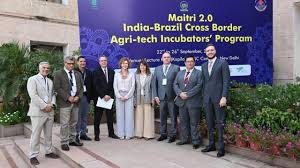
- 02 Oct 2025
In News:
The Indian Council of Agricultural Research (ICAR) recently launched the second edition of the Brazil–India Cross-Incubation Programme in Agritech (Maitri 2.0) in New Delhi. The initiative brings together innovators, startups, and research institutions from both countries to strengthen bilateral cooperation and build a more resilient and inclusive agri-food ecosystem.
About Maitri 2.0:
- Two-Way Learning Platform: Facilitates co-creation between Indian and Brazilian innovators, enabling mutual exchange of knowledge, best practices, and technology solutions.
- Objectives:
- Strengthen incubator linkages between India and Brazil.
- Promote co-incubation models and innovation-driven collaboration.
- Open opportunities in sustainable agriculture, digital technologies, and agri-value chain development.
- Foster inclusive ecosystems that directly benefit farmers and support global food security.
Strategic Significance:
Maitri 2.0 reflects the broader India–Brazil strategic partnership, aligning with their shared vision in agriculture, emerging technologies, and food and nutritional security. It builds on historical collaborations and complements global platforms such as BRICS and G20, highlighting both nations’ roles in addressing food security and climate-resilient agriculture.
Radar-Mounted Drones for Surveillance
- 02 Oct 2025
In News:
The Border Security Force (BSF), India’s first line of defence, is collaborating with the Indian Space Research Organisation (ISRO) to develop radar-mounted drones aimed at enhancing surveillance along India’s western and eastern borders. This initiative seeks to strengthen border security by providing persistent, high-accuracy monitoring of remote and difficult terrains without crossing international boundaries.
About Radar-Mounted Drones:
- Technology: Unmanned aerial systems equipped with compact radars capable of detecting moving targets, vehicles, or intruders.
- All-Weather Capability: Operates effectively in fog, darkness, rain, or adverse weather, unlike visual-only sensors.
- Real-Time Alerts: Provides immediate notifications, enabling rapid deployment of troops and timely response to border threats.
- Integrated Sensor Fusion: Potential to combine radar with infrared, high-resolution cameras, and ground sensors for enhanced detection.
- High Mobility and Scalability: Drones can be rapidly deployed in inaccessible areas, and multiple units can cover larger regions during crises.
Significance:
- The system is designed to overcome limitations of conventional border guarding, which relies on mobile soldiers or fixed towers and is effective only in limited areas.
- Radar-equipped drones can provide continuous day-and-night surveillance, monitor regions where permanent radars or outposts cannot be installed, and assist in controlling smuggling or infiltration attempts.
- The BSF, drawing experience from operations like ‘Operation Sindoor’, has also established a School of Drone Warfare at its Tekanpur Academy in Madhya Pradesh. In the coming months, the force plans to manufacture these radar-equipped drones in-house, further enhancing India’s technological edge in border security.
- This initiative exemplifies the growing role of technological interventions in modern border management, ensuring vigilance, rapid response, and comprehensive monitoring of India’s frontier regions.
Siphon-Powered Desalination
- 02 Oct 2025
In News:
- Researchers at the Indian Institute of Science (IISc), Bengaluru, have developed an innovative siphon-powered thermal desalination system that can transform seawater into potable water faster, cheaper, and more reliably than existing technologies.
- The breakthrough addresses long-standing challenges in solar desalination, such as salt buildup and limited wicking height, offering a scalable solution for water-stressed regions.
How the Siphon-Powered System Works:
- Composite Siphon: A fabric wick paired with a grooved metal surface continuously draws seawater from a reservoir.
- Gravity Flow: Ensures smooth movement and flushes away salt before crystallization occurs.
- Thin-Film Evaporation: Water spreads as a thin layer on heated metal surfaces and evaporates efficiently.
- Ultra-Narrow Air Gap: Vapor condenses just 2 mm away on a cooler surface, enhancing efficiency.
- Multistage Stacking: Multiple evaporator–condenser pairs recycle heat, maximizing water output.
Key Features and Advantages:
- High Efficiency: Produces more than 6 litres of potable water per square metre per hour under sunlight, significantly higher than conventional solar stills.
- Low-Cost Materials: Uses aluminum and fabric, making it affordable and easy to deploy.
- Energy Flexibility: Operates on solar energy or waste heat, enabling off-grid functionality.
- Durability: Can handle highly saline water (up to 20% salt) without clogging.
- Scalability: Suitable for villages, coastal areas, disaster zones, and island nations.
Significance:
- Water Security: Provides a sustainable solution for drinking water scarcity in remote and off-grid regions.
- Innovation Leap: Overcomes technical limits of traditional solar stills, particularly salt scaling and wicking height.
- Sustainable Development: Eco-friendly, low-cost, and aligned with SDG 6 (Clean Water and Sanitation).
Supported by India’s Department of Science and Technology (DST) and published in Desalination, this technology could make the ocean a reliable source of fresh water for millions, emphasizing simplicity, salt resistance, and scalability as its core strengths.
Special and Differential Treatment (SDT)
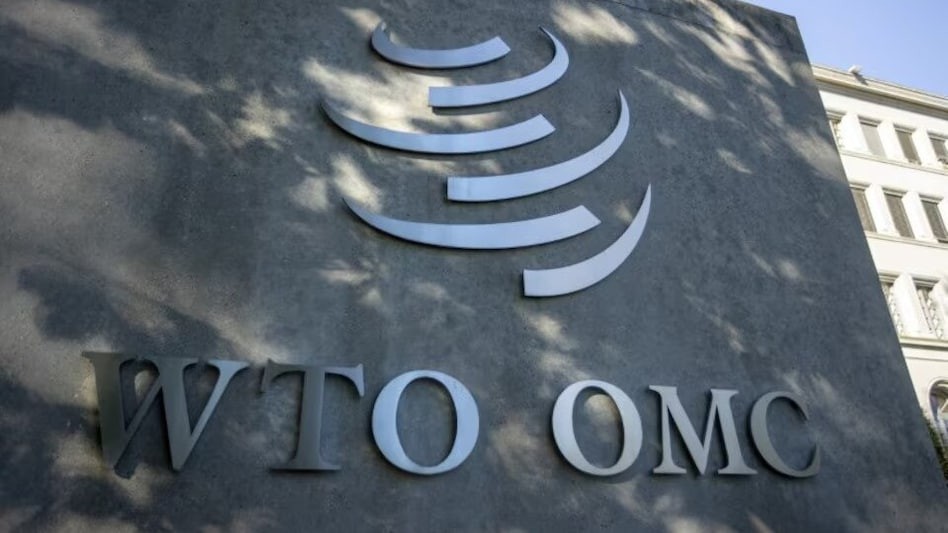
- 02 Oct 2025
In News:
China has announced that it will continue to be classified as a developing country within the World Trade Organization (WTO) but will no longer seek Special and Differential Treatment (S&DT) in future negotiations.
About Special and Differential Treatment (S&DT):
- S&DT grants developing and least-developed countries (LDCs) flexibilities in implementing WTO obligations, including longer deadlines, preferential market access, safeguard measures, and technical assistance.
- Introduced under GATT in the 1960s and formalized in WTO agreements (1995) and the Doha Development Agenda (2001).
- LDCs receive additional automatic benefits; other countries self-declare their status, subject to challenge by WTO members.
Significance of China’s Decision:
- China, historically a major beneficiary of S&DT, will forego such benefits while retaining its developing country status.
- The move signals support for multilateral trade and contributes to WTO reform, addressing concerns raised by the United States and others over selective access to S&DT.
- It highlights the tension between economic capabilities and self-declared developing status, especially among major economies.
Implications:
- Encourages balanced WTO negotiations and strengthens the global trading system.
- Marks a step towards aligning development considerations with global economic realities without relinquishing China’s role in the Global South.
AstroSat

- 01 Oct 2025
In News:
India’s first dedicated Space Astronomy Observatory — AstroSat — has successfully completed a decade of operations since its launch on September 28, 2015. Designed for a mission life of five years, AstroSatcontinues to deliver valuable scientific data, marking a major milestone in India’s advancement in space-based astrophysics research.
About AstroSat
- Launched by: Indian Space Research Organisation (ISRO)
- Launch Vehicle: PSLV-C30 (XL)
- Launch Site: Satish Dhawan Space Centre (SDSC), Sriharikota
- Launch Date: September 28, 2015
- Mission Life: Originally 5 years, extended due to sustained functionality and scientific output
- Managed by:Mission Operations Complex (MOX) of ISTRAC, Bengaluru
AstroSat represents India’s first multi-wavelength space observatory, capable of observing celestial bodies in Visible, Ultraviolet (UV), and low and high-energy X-ray bands of the electromagnetic spectrum simultaneously — a capability possessed by only a handful of space observatories globally.
Scientific Objectives
AstroSat was conceived to advance India’s capability in space-based astronomy and to deepen understanding of high-energy astrophysical phenomena. Its key scientific goals include:
- Investigating high-energy processes in binary star systems containing neutron stars and black holes.
- Estimating magnetic field strengths of neutron stars.
- Studying star formation regions and energetic star systems beyond the Milky Way.
- Detecting and monitoring transient X-ray sources (brief, bright cosmic events).
- Conducting a limited deep-field survey of the universe in the ultraviolet region.
Key Instruments (Payloads)
AstroSat carries five scientific payloads, each contributing to multi-spectral observations:
- Ultra Violet Imaging Telescope (UVIT):Observes celestial objects in near and far ultraviolet as well as visible wavelengths, helping in the study of star formation and evolution.
- Large Area X-ray Proportional Counter (LAXPC):Detects time variability and spectral properties of X-ray sources in the 3–80 keV range.
- Cadmium–Zinc–Telluride Imager (CZTI):Observes hard X-rays (above 20 keV) and helps study gamma-ray bursts and black hole emissions.
- Soft X-ray Telescope (SXT):Provides soft X-ray imaging and spectroscopy to study compact objects like neutron stars and white dwarfs.
- Scanning Sky Monitor (SSM):Continuously scans the sky to detect new transient X-ray sources and track their variability.
Study In India (SII) Portal
- 01 Oct 2025
In News:
The University Grants Commission (UGC) has mandated that all foreign nationals studying in Indian Higher Education Institutions (HEIs) must now register on the newly launched Study in India (SII) portal. The move seeks to centralise data, streamline admission and visa processes, and strengthen compliance monitoring for international students studying in India.
Background and Context
Until now, foreign students seeking admission in Indian universities had to apply directly to individual institutions, which also facilitated their visa processes. However, the absence of a centralised database made it difficult for authorities to track foreign student numbers, monitor visa compliance, and address instances of overstaying or misuse of study visas.
To overcome these challenges, the Ministry of Education (MoE), in collaboration with the UGC, has introduced the Study in India portal as a digital one-stop platform integrating admissions, visa processing, and compliance tracking.
About the Study in India (SII) Portal
- Nodal Ministry: Ministry of Education (MoE), Government of India
- Implementing Agency: University Grants Commission (UGC)
- Objective: To promote India as a global education hub and simplify access for international students seeking to study in Indian higher education institutions.
Key Features
- Single-Window Digital Platform:
- Acts as a unified interface for application submission, admission processing, and student visa facilitation.
- Enables foreign students to explore regular, short-term, and long-term courses across Indian universities and HEIs.
- Comprehensive Academic Directory:
- Lists undergraduate, postgraduate, and doctoral programmes available in participating institutions.
- Includes courses from the Indian Knowledge System (IKS) — such as Yoga, Ayurveda, classical music, and traditional arts — highlighting India’s cultural and intellectual heritage.
- Unique SII-ID Generation:
- Upon registration, each student receives a unique SII-ID, which must be quoted while applying for the student visa.
- The visa process is now directly linked to the SII portal, ensuring authenticity and easier tracking.
- Institutional Accountability:
- HEIs admitting foreign students must appoint a Compliance Officer to oversee adherence to all SII guidelines and data-reporting requirements.
- Institutions are required to update foreign student details regularly on the portal for regulatory oversight.
- Information Gateway:Provides details about academic facilities, research opportunities, campus infrastructure, and student support services to guide prospective applicants.
Agri-Stack Scheme
- 01 Oct 2025
In News:
- The Government of Uttar Pradesh has issued a stern directive to all District Magistrates (DMs), warning of strict action against officials who fail to complete farmer registration under the Agri-Stack scheme within the revised deadline.
- Beginning October 16, 2025, DMs have been allotted one month to ensure 100% registration of farmers, a crucial step in the implementation of this national digital agriculture initiative.
About the Agri-Stack Scheme
- The Agri-Stack is a national digital infrastructure being developed by the Ministry of Agriculture and Farmers Welfare, in collaboration with state governments, to digitally transform Indian agriculture.
- It aims to create a unified database of farmers and farmlands, integrating information on land records, crop patterns, and scheme benefits.
- The system is envisioned to serve as a foundational digital layer for data-driven governance, policy formulation, and targeted service delivery to farmers.
Objectives and Key Features
- Empowerment through Data: Enables the creation of a unique digital identity for every farmer through a Farmer ID linked to Aadhaar, ensuring accurate targeting of benefits.
- Efficiency and Transparency: Digitally connects demographic data, landholdings, and scheme eligibility, minimizing leakages and duplication.
- Customized Services: Facilitates localized advisories, early warning systems for disasters and pest attacks, and timely delivery of inputs and credit.
- Ease of Governance: Provides a single, verified data source for policy planning, monitoring, and feedback management.
- Public–Private Collaboration: Enables authorized access for banks, agri-tech startups, and value-chain companies to offer tailored financial and technical services.
Core Components of the Agri-Stack
- Farmer and Farmland Registries:
- A federated digital registry of all farmers across India, compiled by states and harmonized at the central level.
- Each farmer receives a unique, verifiable Farmer ID, dynamically linked to farmland plot data for non-legal, advisory, and planning purposes.
- Unified Farmer Service Interface (UFSI):
- A technical framework that ensures data interoperability between government and authorized private stakeholders.
- Enables federated data exchange with consent-based access, improving coordination across sectors like finance, insurance, and agri-input supply.
- Crop Sown Registry:
- Digitally records seasonal crop data for every farm using smartphone, drone, and satellite imagery.
- Replaces traditional manual crop surveys with real-time, geo-referenced data for better yield estimation and policy response.
- Agri-Stack Sandbox:A testing environment that allows authorized users (such as agri-tech firms and banks) to safely experiment with sample datasets and digital tools before gaining production-level access.
- Consent Manager:
- Empowers farmers to control the sharing of their personal data.
- Data access is granted only with explicit consent, which can be revoked at any time, ensuring privacy and accountability.
Lachipora Wildlife Sanctuary

- 01 Oct 2025
In News:
The District Magistrate of Baramulla has ordered the immediate closure of 14 gypsum mining units operating within the prohibited 1-km radius of the Lachipora Wildlife Sanctuary in north Kashmir’s Uri subdivision, following directives from the Supreme Court of India.
Background and Legal Context
- The decision is based on the Supreme Court judgment in State of Uttarakhand & Others vs. Nandan Singh Bora & Others, which mandates that no mining or quarrying activity is permissible within 1 km of any protected forest or wildlife sanctuary.
- Furthermore, if the Eco-Sensitive Zone (ESZ) of a sanctuary extends beyond 1 km, the restriction applies to the entire notified ESZ area.
- Subsequent surveys conducted by the Wildlife Warden, North Kashmir Division (Sopore), confirmed that several gypsum mining units were functioning within the restricted buffer zone of Lachipora. Acting on this report, the district authorities ordered the immediate suspension of all mining operations to prevent further ecological degradation.
- Officials emphasized that the move aims to preserve the fragile ecology of the region, which forms a vital part of the North Kashmir forest belt and supports diverse wildlife species. The crackdown also aligns with the Geology and Mining Department’s intensified efforts to curb illegal quarrying across Baramulla district.
About Lachipora Wildlife Sanctuary
- Location: Situated in Baramulla district, Jammu & Kashmir, near the village of Lachipora, on the northern banks of the Jhelum River.
- Established: 1987
- Area: 141 sq. km
- Altitude Range: 1,630–3,300 metres
- Topography: Comprises a varied landscape of alpine meadows, gentle to steep slopes, and rocky cliffs, supporting rich biodiversity.
Ecological Significance
- Flora:The sanctuary hosts extensive coniferous forests of deodar, Himalayan white pine, and blue pine, along with broadleaf species such as birch, horse chestnut, West Himalayan fir, and Persian walnut.
- Fauna:
- Habitat for endangered species like the Hangul (Kashmir stag) and Markhor, a wild goat known for its spiral horns.
- Home to Himalayan black bear, snow leopard, musk deer, and several small mammals.
- Recognized as an Important Bird Area (IBA) for harboring the vulnerable Western Tragopan and other high-altitude avifauna.
Jal Prahar 2025

- 01 Oct 2025
In News:
The Indian Navy has successfully concluded the biannual joint amphibious exercise ‘Jal Prahar 2025’ along the eastern seaboard, in close coordination with the Indian Army. The exercise aimed to enhance joint operational readiness, inter-service synergy, and maritime security preparedness.
About Jal Prahar 2025
- Nature of Exercise:‘Jal Prahar’ is a biannual joint amphibious exercise conducted by the Indian Navy in collaboration with the Indian Army.
- Objective:To strengthen coordination, interoperability, and integration between the two forces for effective amphibious operations and coastal defence.
Exercise Structure and Key Highlights
The 2025 edition of the exercise was conducted in two phases:
- Harbour Phase (Visakhapatnam):
- Focused on the induction and integration of Army troops onboard naval platforms such as INS Gharial.
- Included onboard training sessions, safety briefings, familiarization with naval operations, and interaction activities to foster inter-service camaraderie.
- Sea Phase (Kakinada):
- Involved the execution of full-scale amphibious operations, including hard beaching, launching of Landing Craft Assaults (LCAs) and infantry combat vehicles (BMPs).
- Validated Standard Operating Procedures (SOPs) and Joint Training Protocols, ensuring seamless coordination during real-world operations.
